 Dr. Yvonne Anderson, 1898 Depiction
Dr. Yvonne Anderson, 1898 Depiction

 Ida Bell Wells-Barnett, Slave, Educator, Journalist, Activist, & Hero
Ida Bell Wells-Barnett, Slave, Educator, Journalist, Activist, & Hero
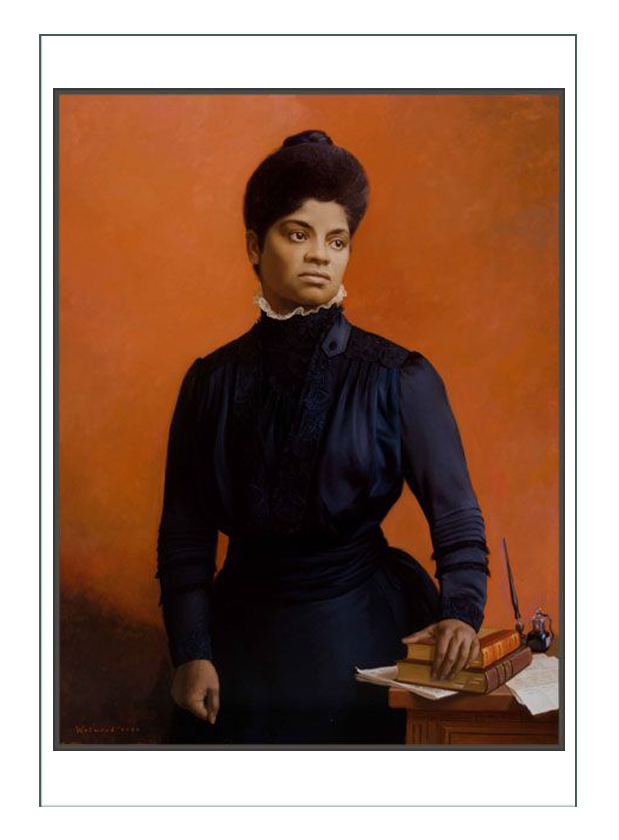 “Ida B. Wells” was born into slavery in Holly Springs, Mississippi in 1862, six months before the Emancipation Proclamation. She was freed, yet lost her parents to yellow fever a few years later. With the help of her grandmother she kept her family intact by moving the family to Tennessee to seek better employment. She died a hero in 1931, noted for her battle against racial injustice. During her life she was a crusading African American journalist who exposed the crime and shame of lynching and fought the battle for women’s suffrage.
“Ida B. Wells” was born into slavery in Holly Springs, Mississippi in 1862, six months before the Emancipation Proclamation. She was freed, yet lost her parents to yellow fever a few years later. With the help of her grandmother she kept her family intact by moving the family to Tennessee to seek better employment. She died a hero in 1931, noted for her battle against racial injustice. During her life she was a crusading African American journalist who exposed the crime and shame of lynching and fought the battle for women’s suffrage.
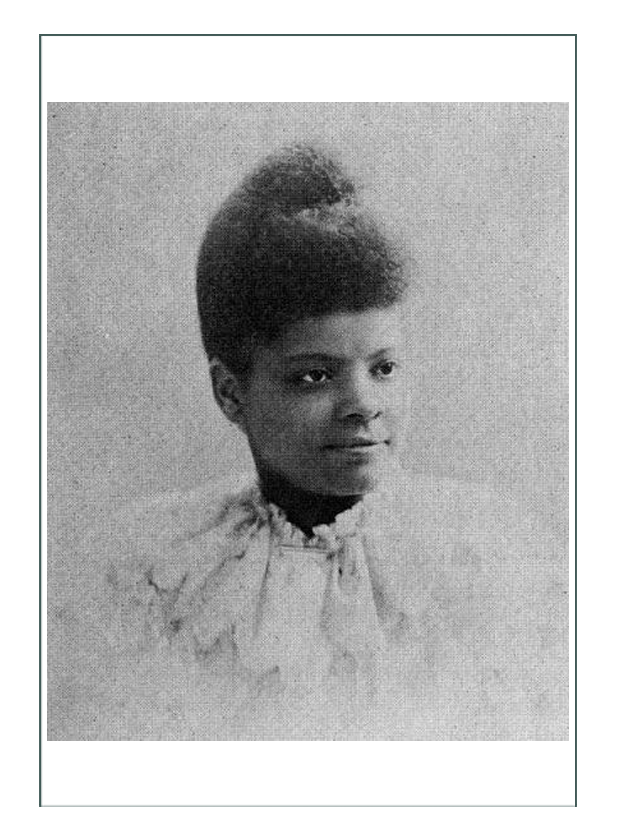
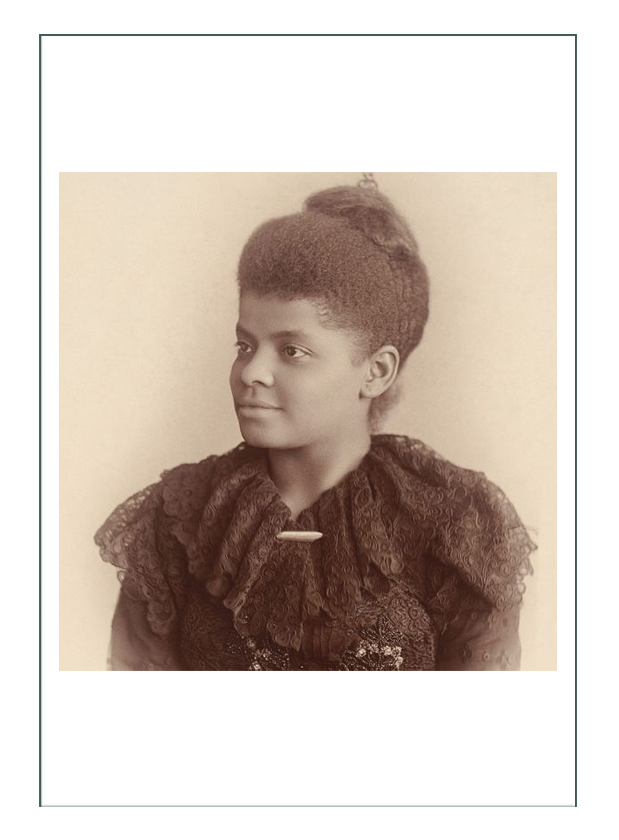

Through a personal investigation of lynching, Wells began to write editorials urging African-Americans to boycott Memphis’ new streetcar line and move westward. She came to realize lynchings were not being used to weed out criminals, but to enforce white supremacy. Blacks began to leave Memphis is great numbers, and those who remained behind, boycotted white businesses. Local papers tried to dissuade blacks from moving west by reporting that the American Indians were hostile and that dangerous diseases awaited them.
To counter the reports, Wells traveled to Oklahoma and returned first hand reports of actual conditions. She continued to investigate lynchings across the south from Texas to Virginia, asking questions no one wanted to know the answers to.
The city of Memphis, she wrote, does not protect and African American “who dares to protect himself against the white man or become his rival.” She was published nationally, but when a mob reacted to one of her anti-lynching editorials in Memphis by destroying the printing presses, her life was threatened. She did a speaking tour of the British Isles and Europe to inspire action to stop the lynchings and was well received.
Upon returning to the US, American papers along with upper class African-Americcans attacked Ms Wells as they feared she would upset their status. She moved to Chicago in the 1890’s to carry on her causes, and lived there until the end of her life. She married lawyer Ferdinand Barnett, had four children, and worked as a probation officer. She supported migrants from the south, and traveled widely to openly oppose racial terror.
Ms. Wells was known for adherence to her principles and values, and was honored for sacrificing herself for those ideals. She was one of the “National Association for the Advancement of Colored People” (NAACP). As an outspoken, activist black woman, at a time when being black or being a woman was often held against someone in public life, Wells often faced disapproval from leaders of the black civil rights movement as well as leaders from the women’s rights movement.
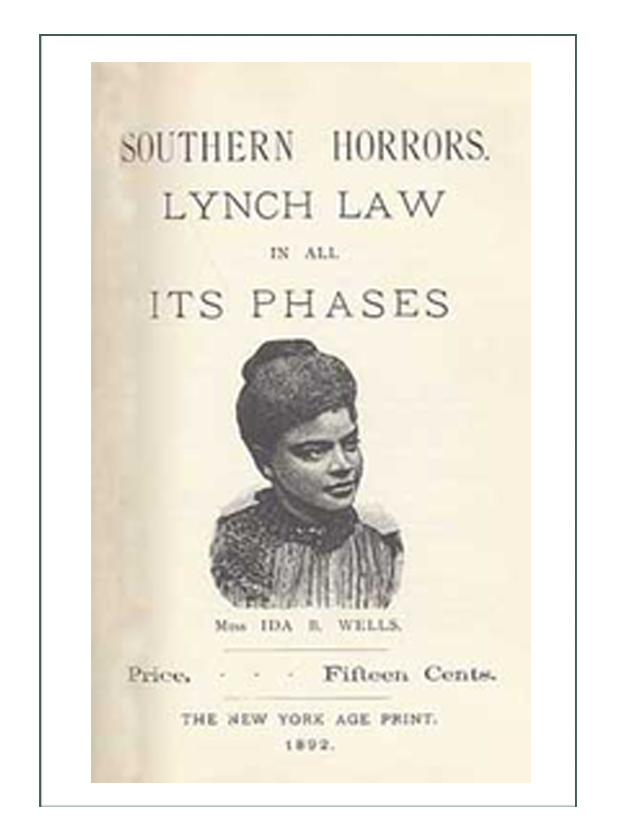
Word & Deed
Ms. Wells was active in establishing notable women’s organizations, and as a skilled a persuasive rhetorician, she traveled internationally on lecture tours. In an effort to raise awareness and opposition to lunching, Wells spoke to groups in New York City where her audiences included leading African-American women. The Women’s Loyal Union of New York an Brooklyn was formed to organize a group that could act politically.

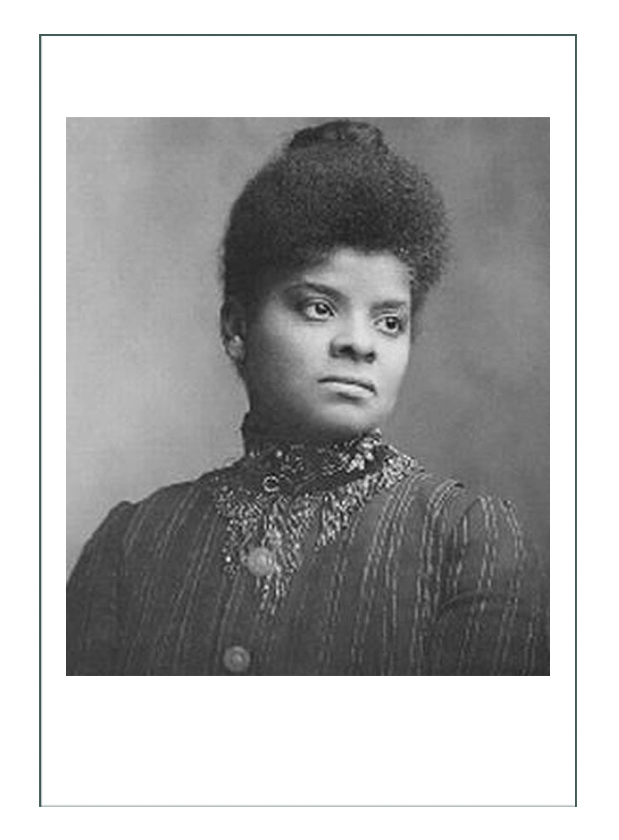

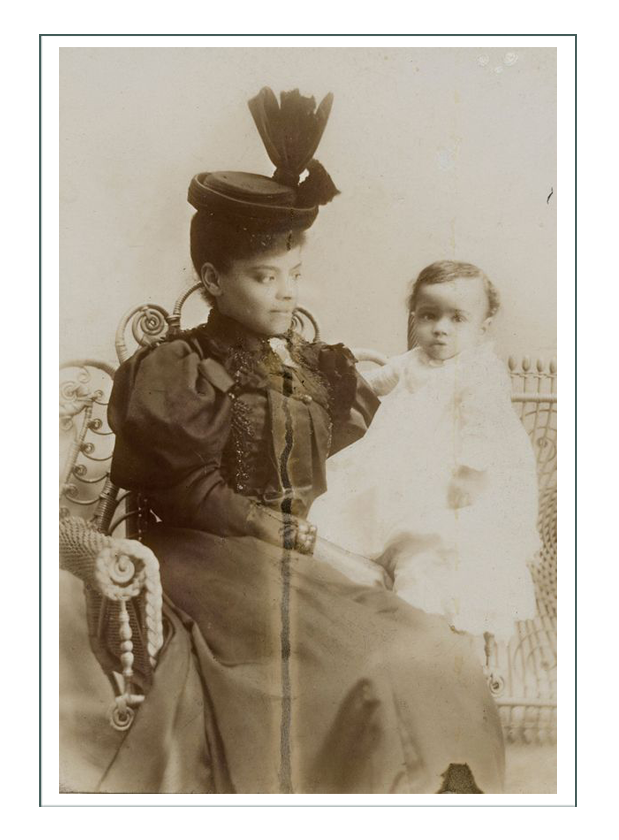
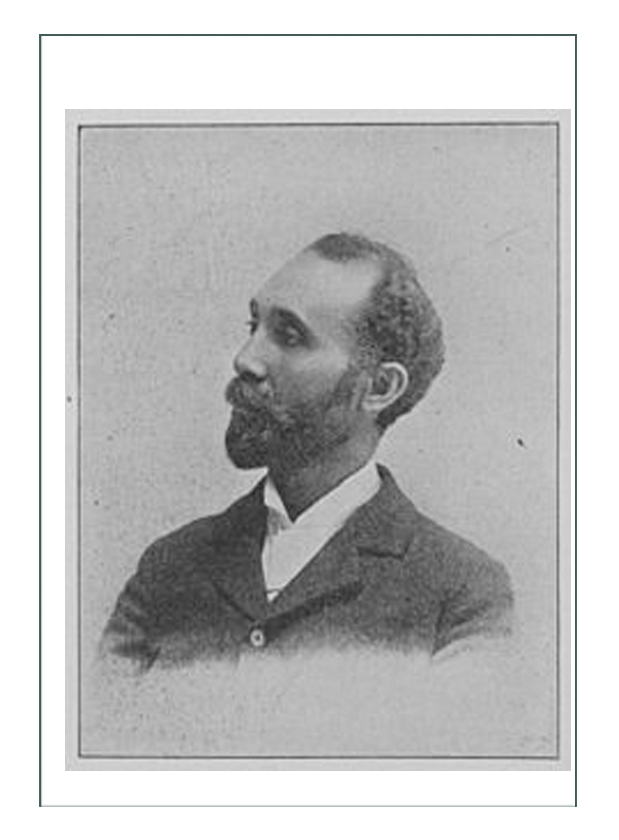
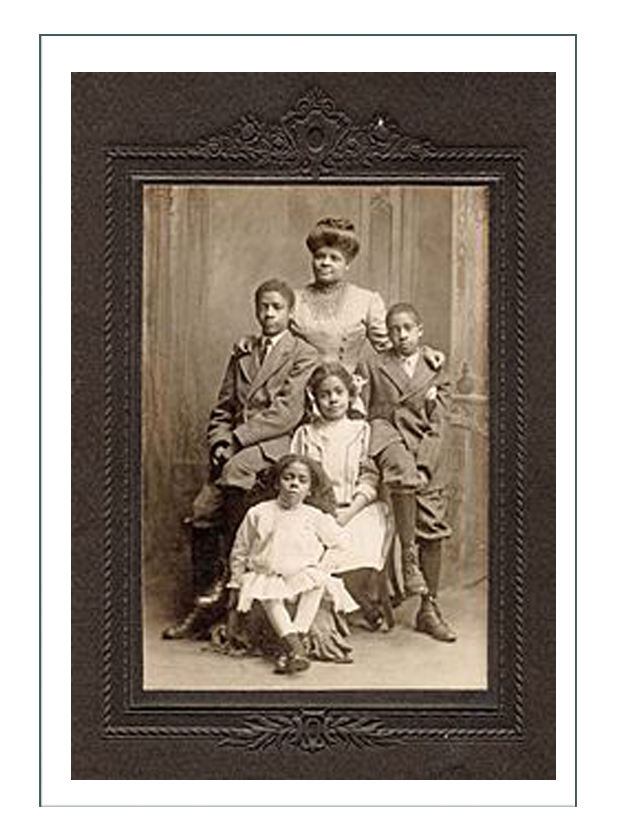
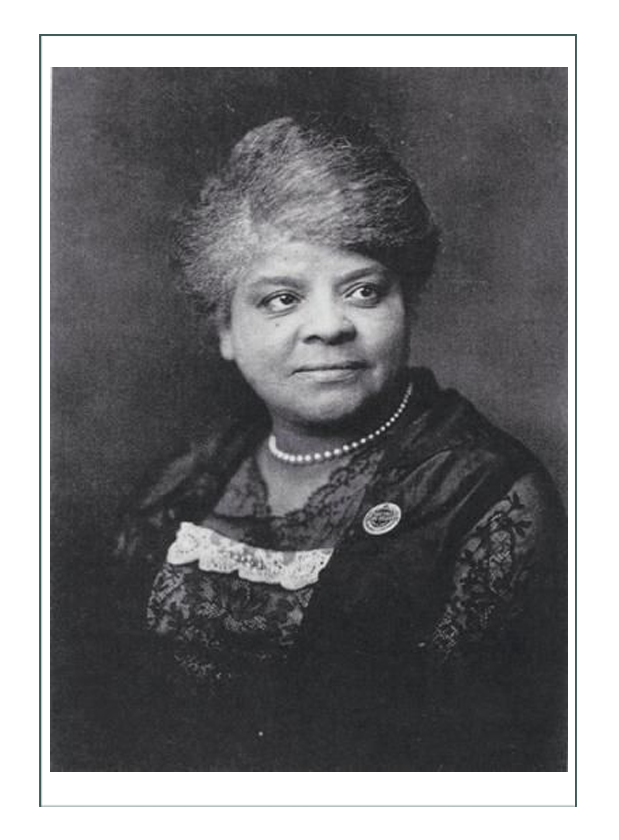

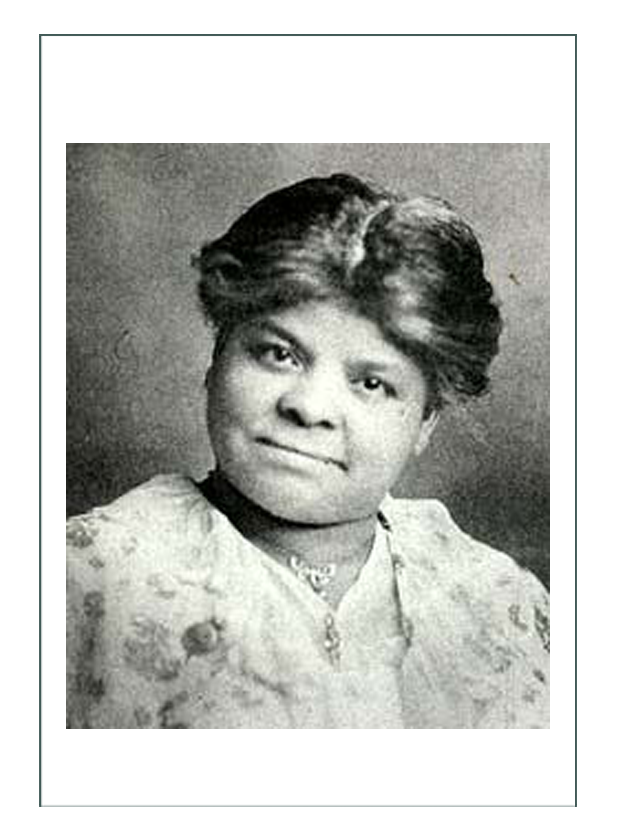

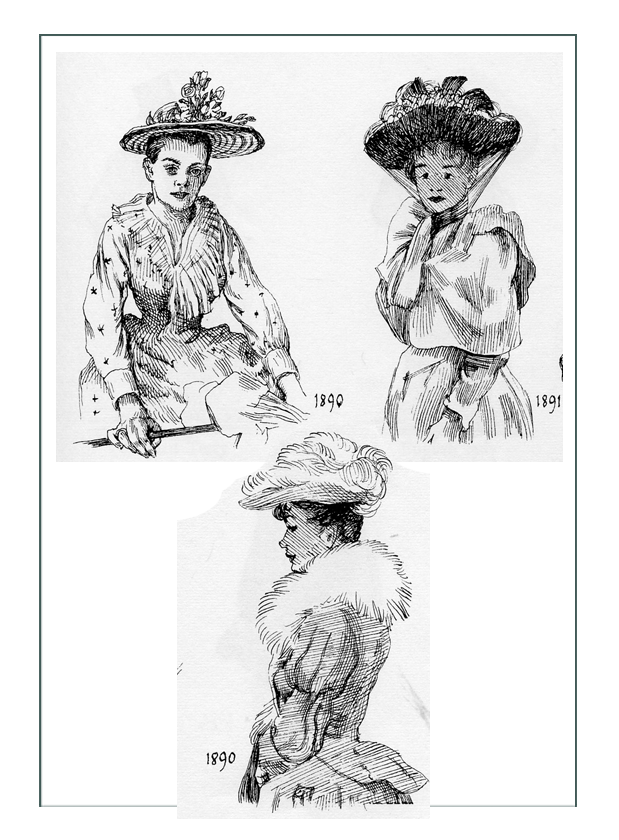
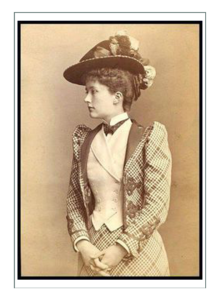
A Different Time Frame 1899-1905
If a later depiction is chosen, the number of pieces will not change much, but the styling will. This era was the height of Edwardian – when fashion split into 5 components (Art Nouveau, Grand Dame , Gibson Girl and Edwardian Classic, Working Girl, and La Belle Epoque).
A quick interpretation from photos and the analysis above, plus her age and stage in life, would have her either in a tailored working ensemble, or that of the Edwardian Classic lace-covered everything.
Depiction at approximately the year 1900 would have Ms. Wells aged about 40 years in the middle of her child bearing and raising years as she married in 1895, late in life for that time. Since we have no photos or real depictions of her, we know that in 1900 an ensemble would include:
- The Edwardian long corset with boning offset; including gussets, gores, and pads for the dropped “S monobosum”
- combination – ornamented
- corset cover
- single petticoat but with frou frou
- proper gored and draped skirt for specific 6 month period chosen
- proper fabric
- 2 section blousewaist and skirt
- possible jacket, Zouave type with dropped belt
- blousewaist with drooping in front; ideally fully laced with stock and stand collar, slight fullness at the shoulders, fullness at the wrist, and integrated cuffs button on
- appropriate shoes and stocks
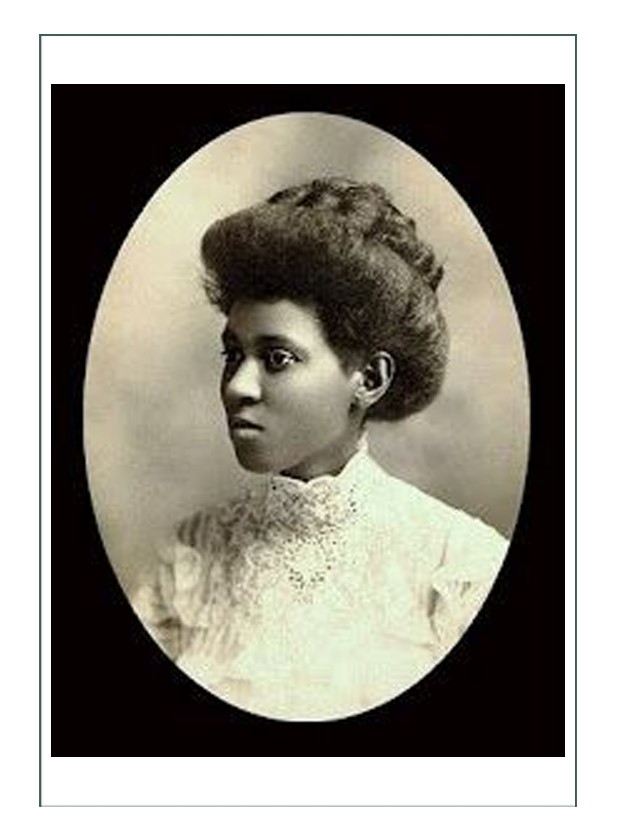
Discussion continued through the next pages and concluded below…
Click here to go to Dr. Anderson’s Historical Context page (next)
Click here to go to Dr. Anderson’s Fashion History page
Click here to go to Dr. Anderson’s Design Development page
Continue below for the Finished Project


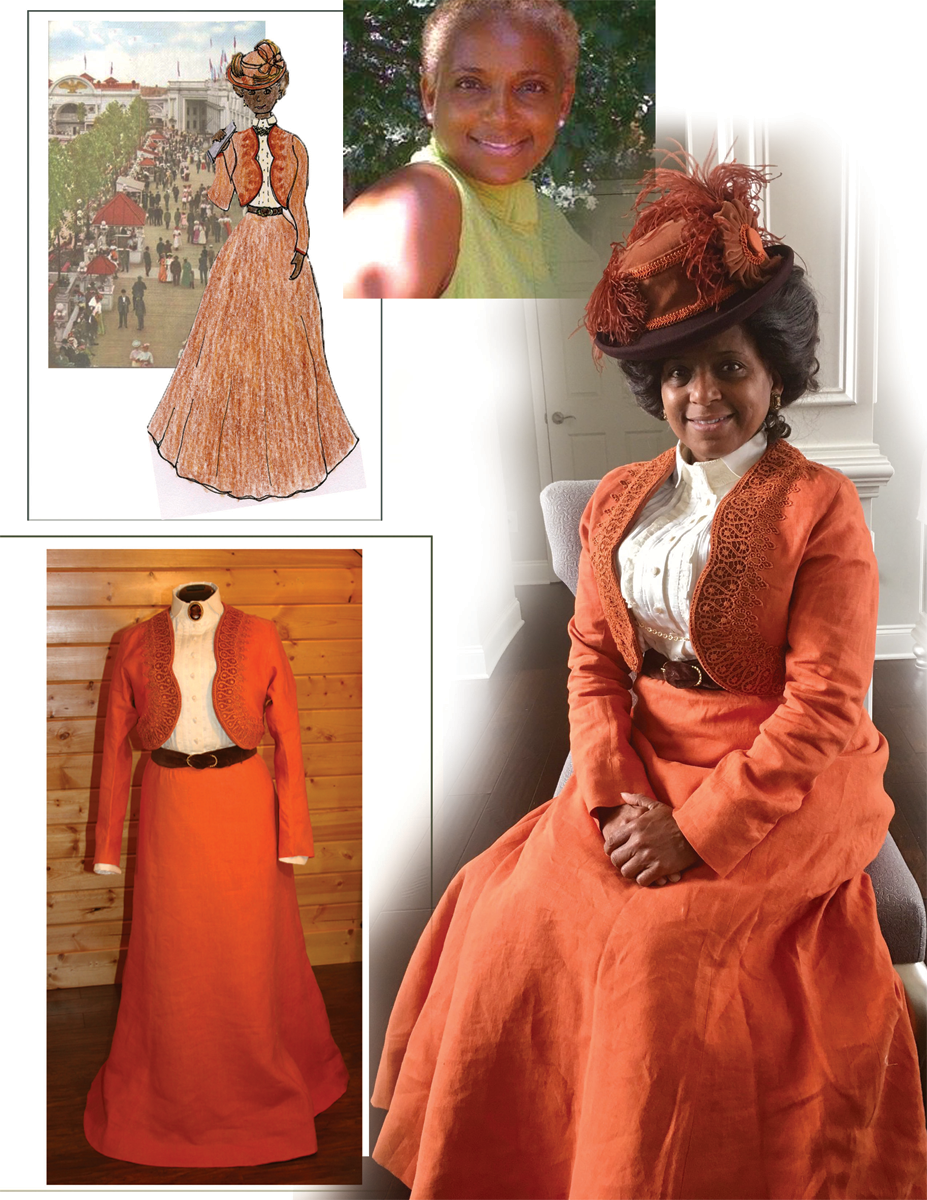
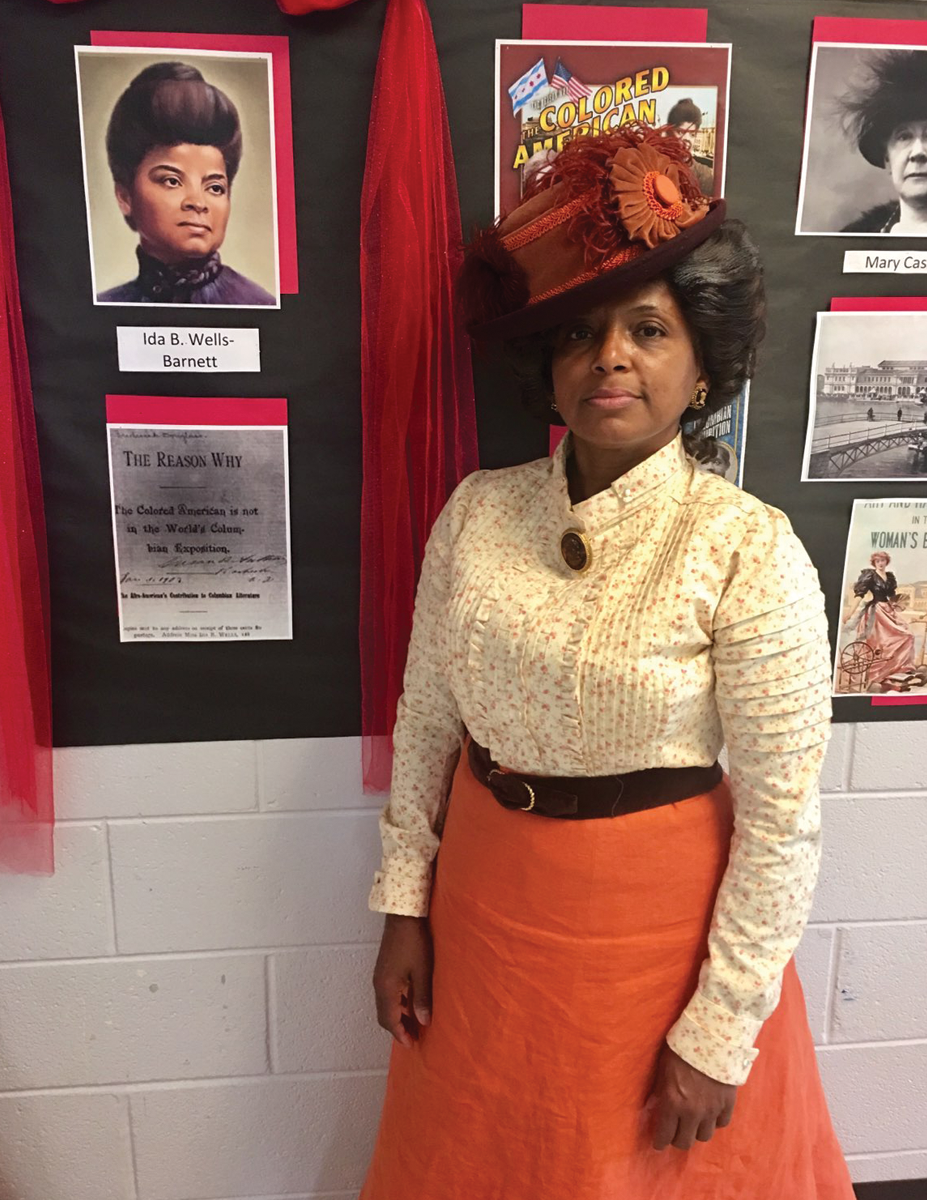
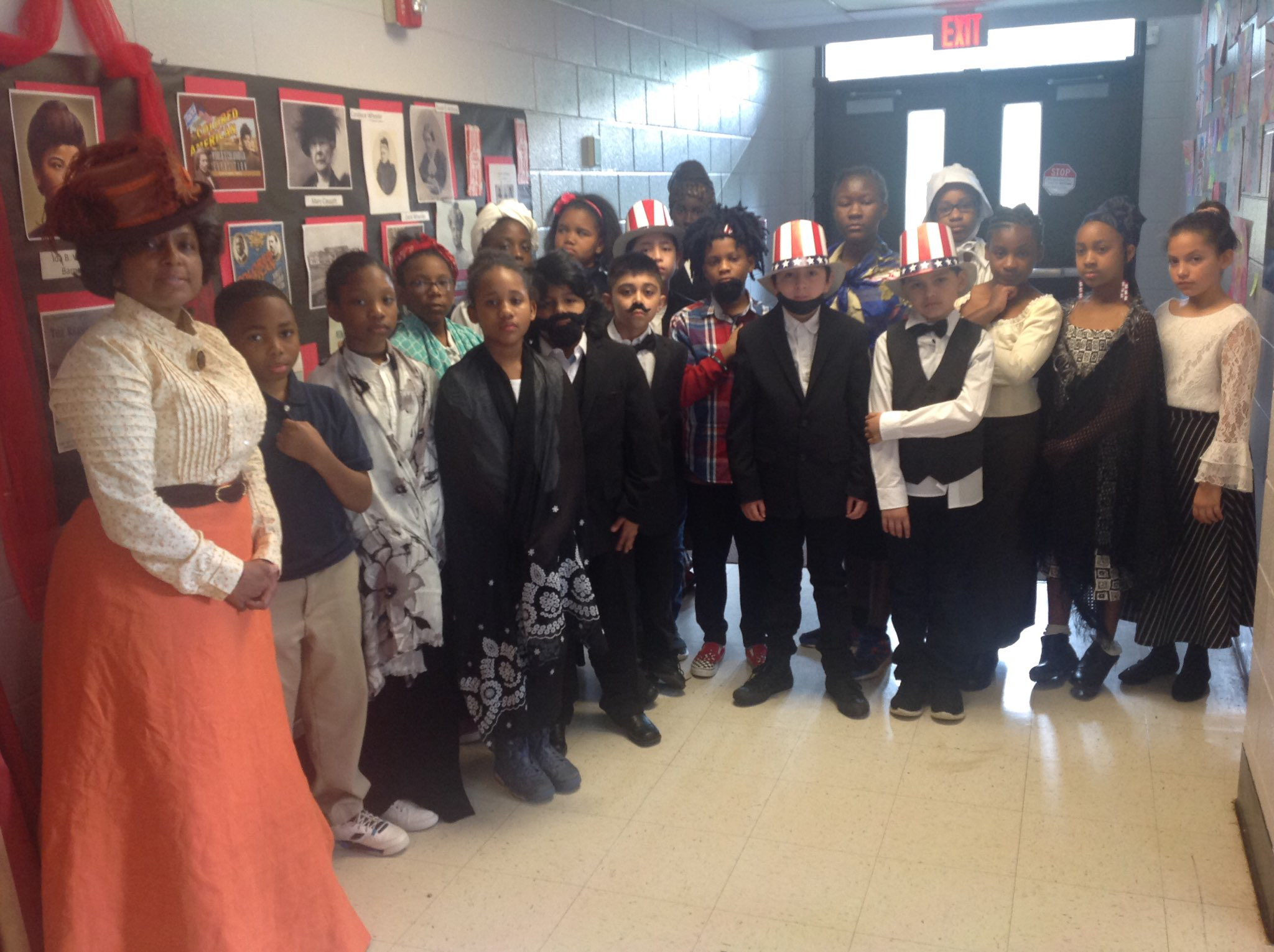
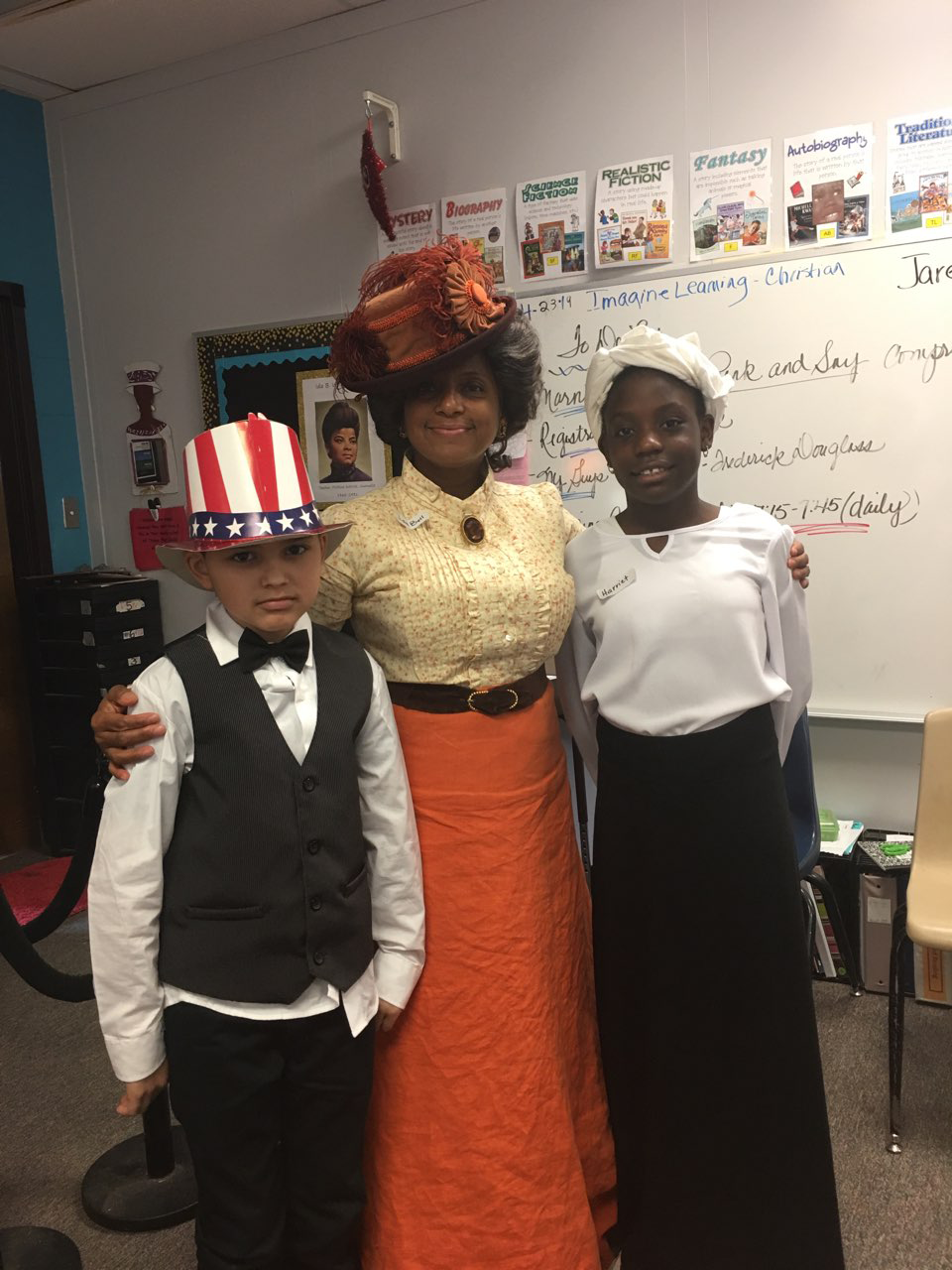
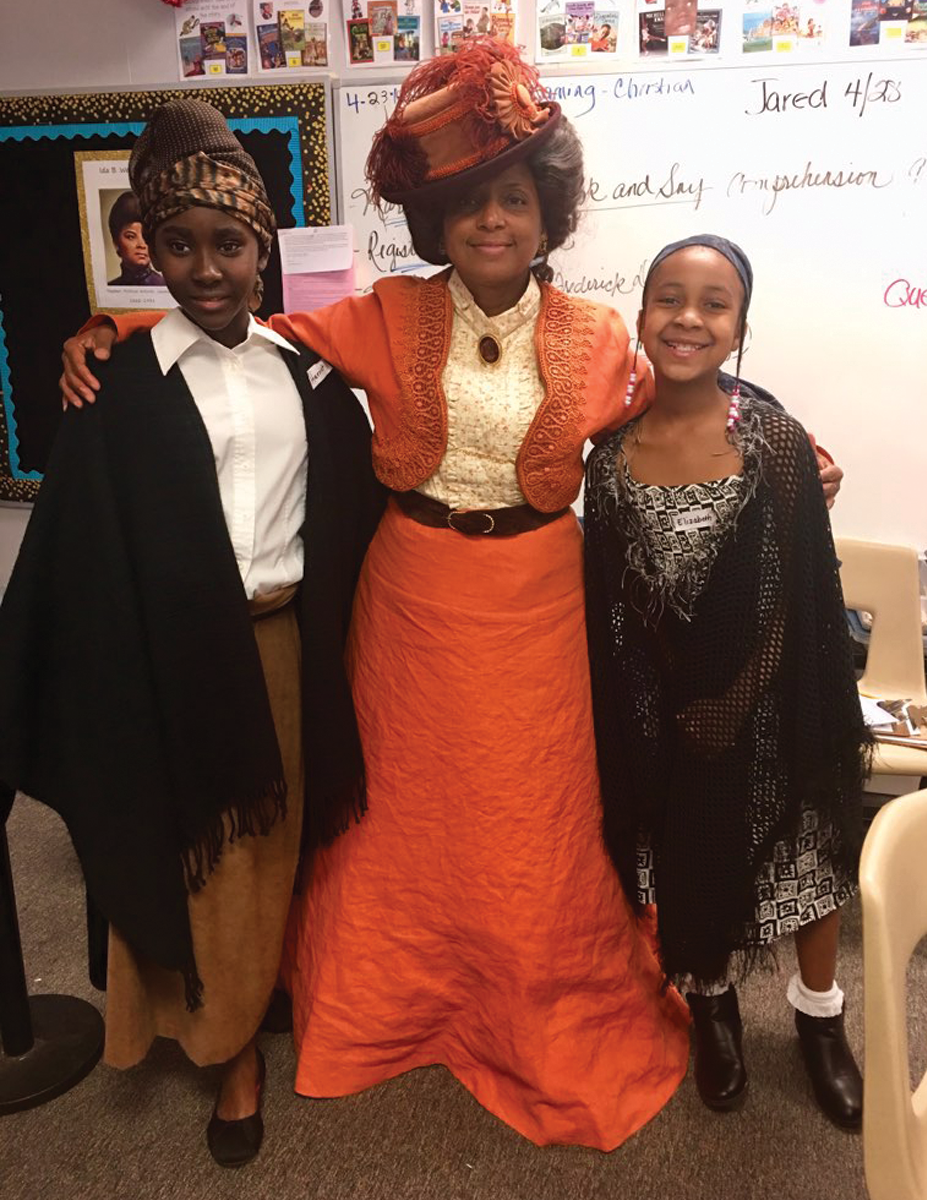
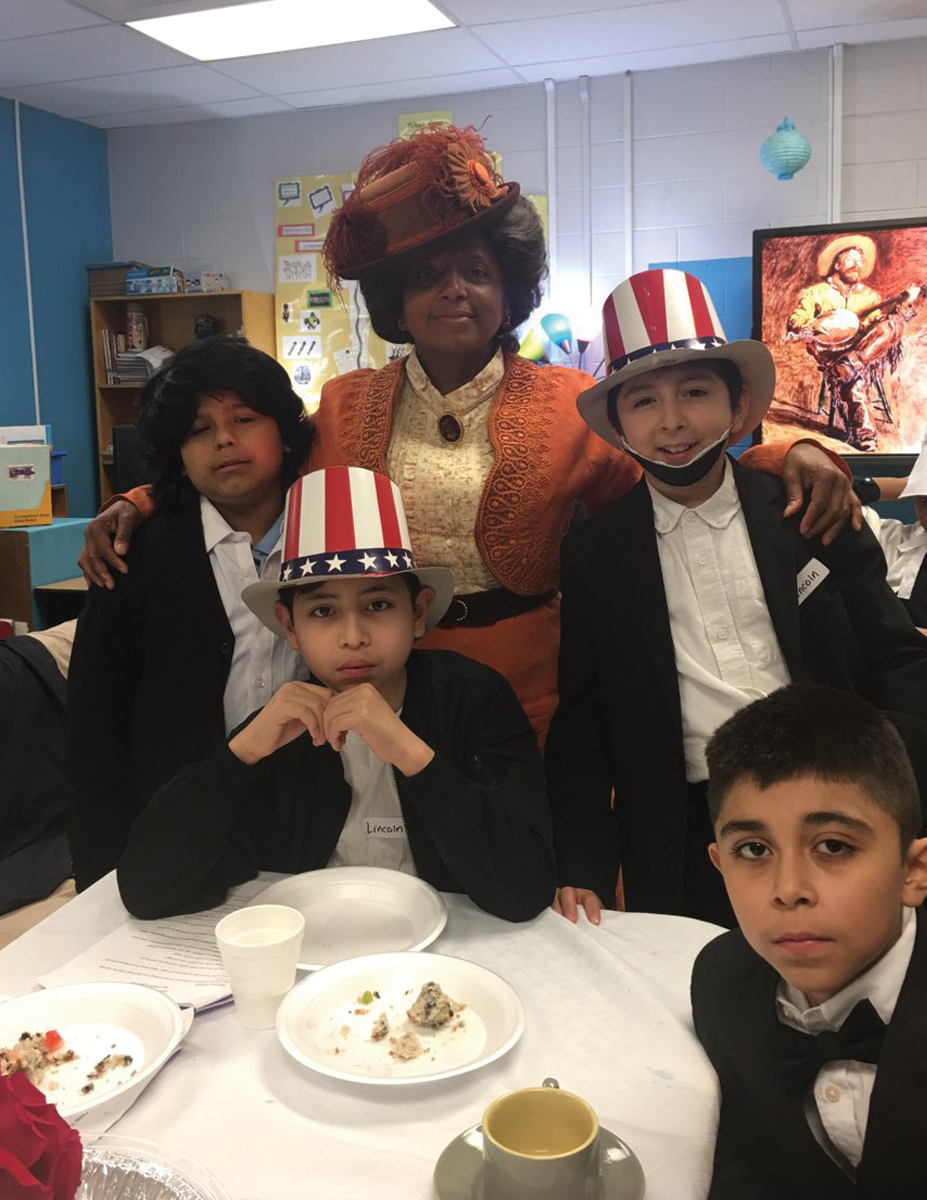
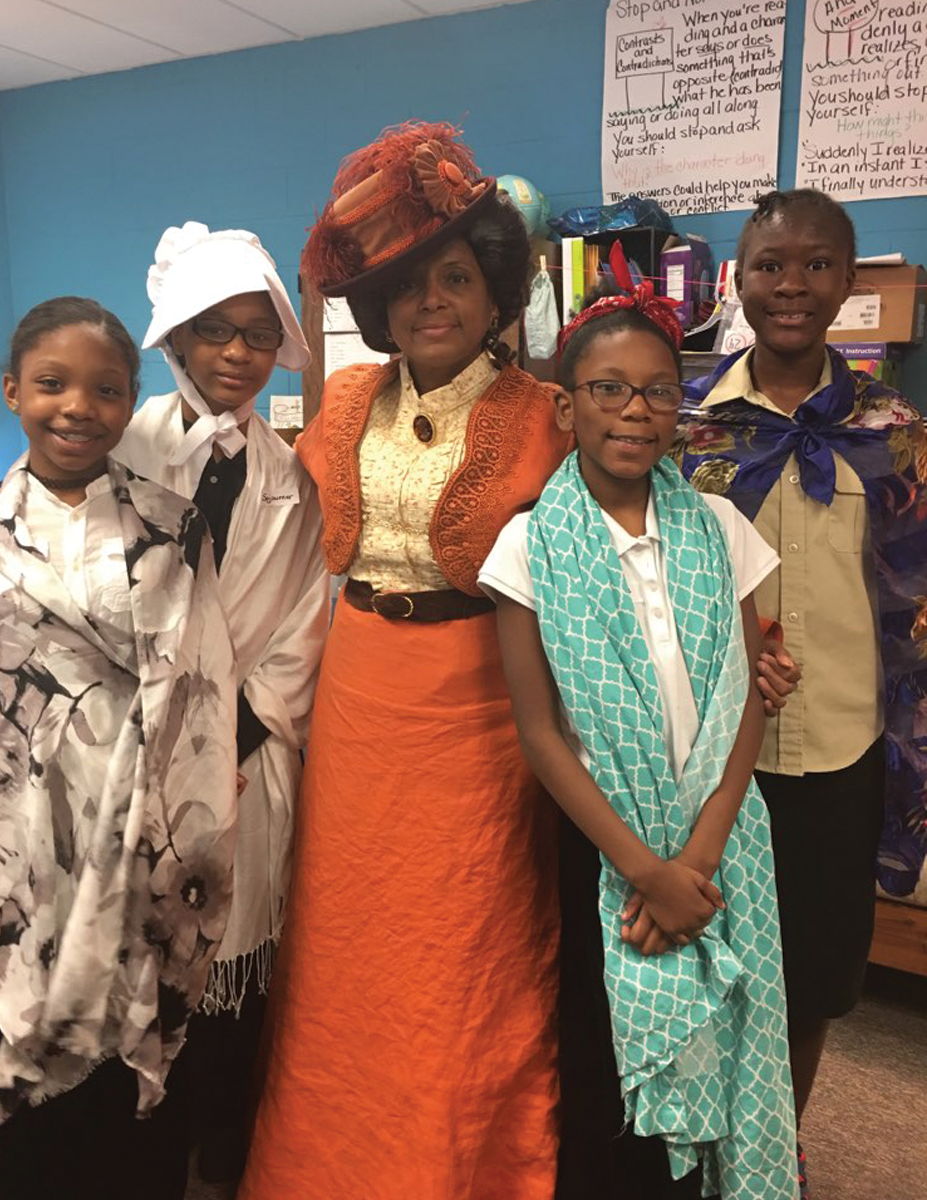
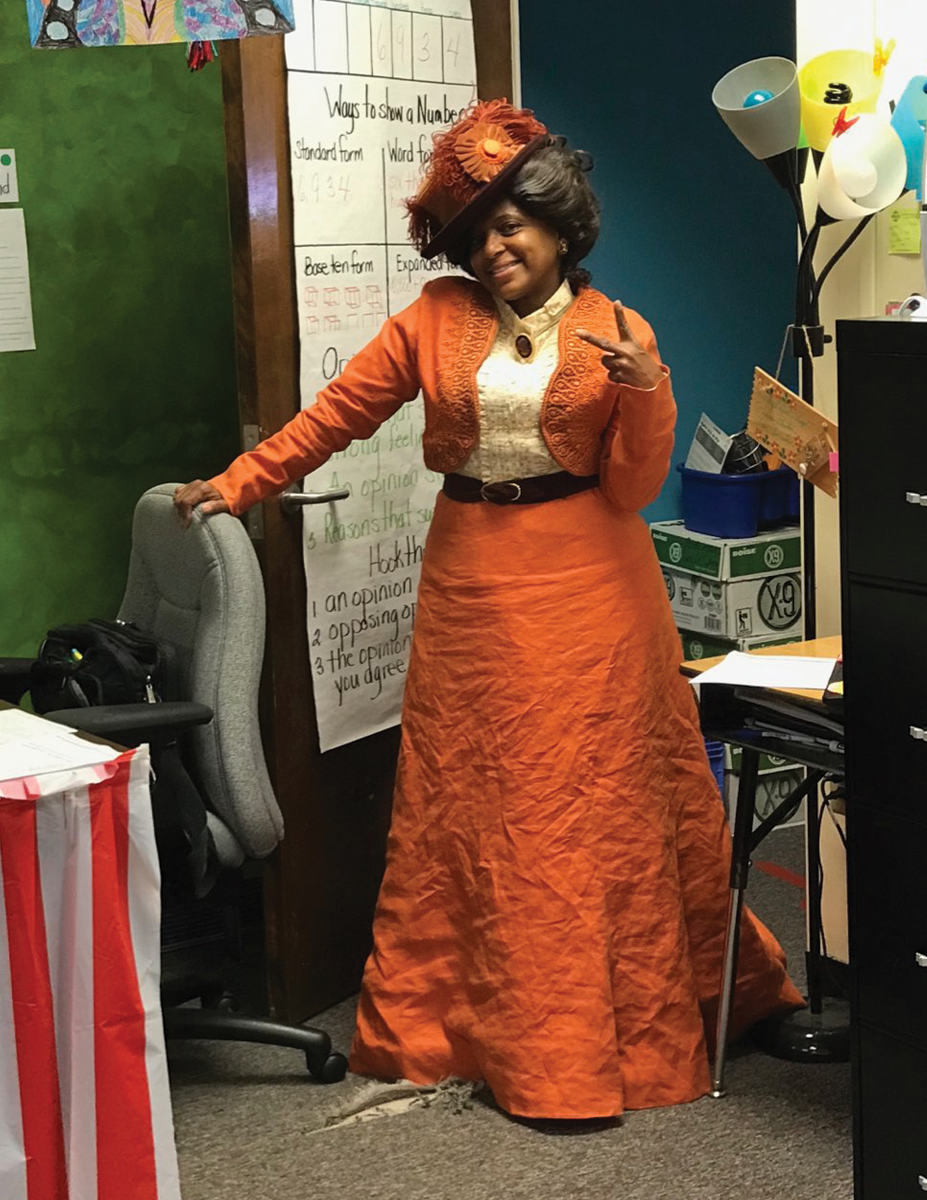
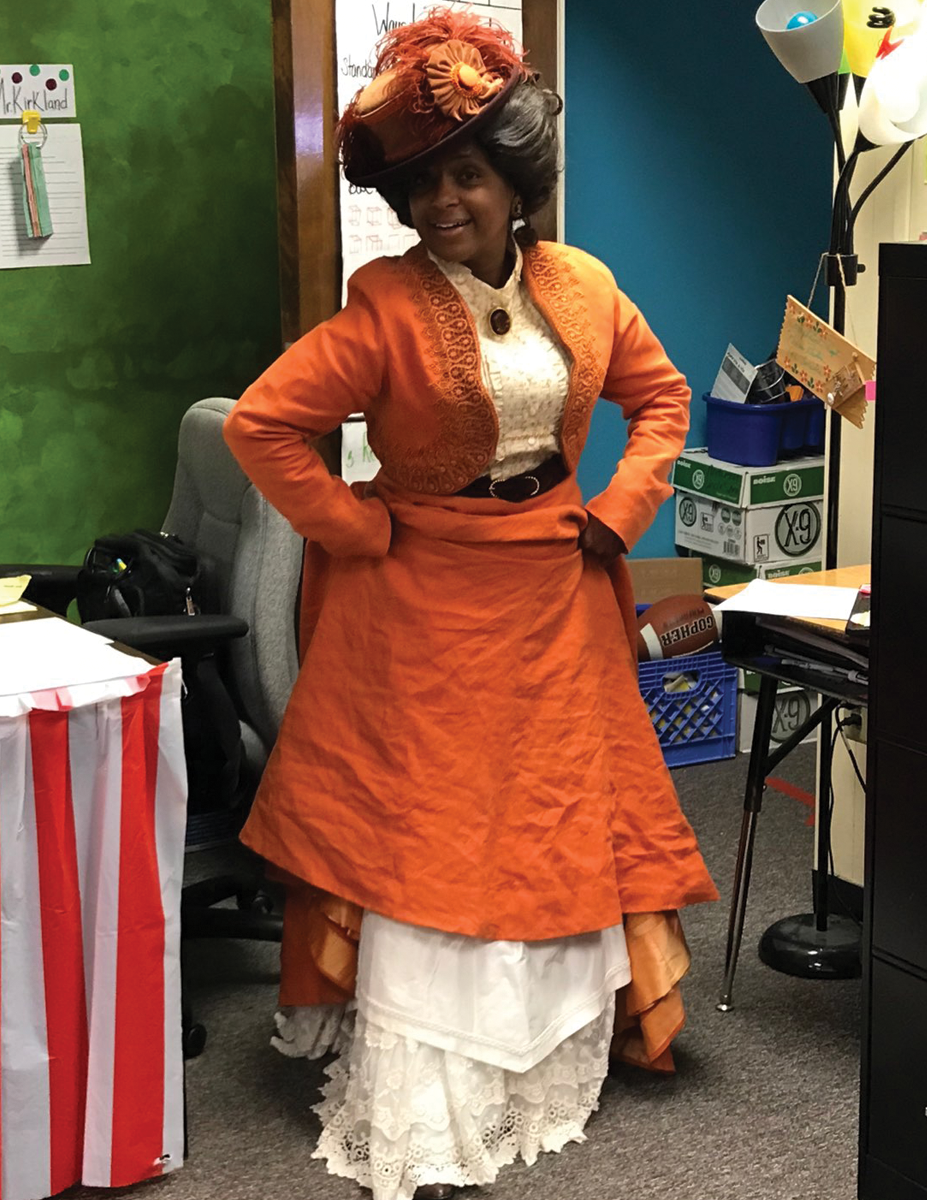
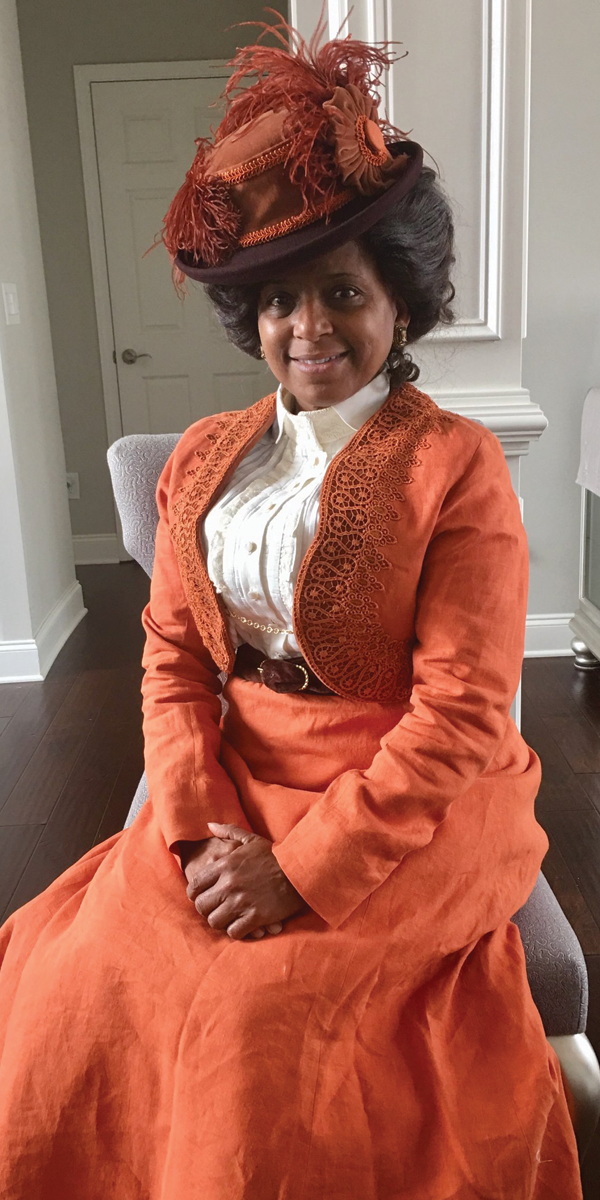

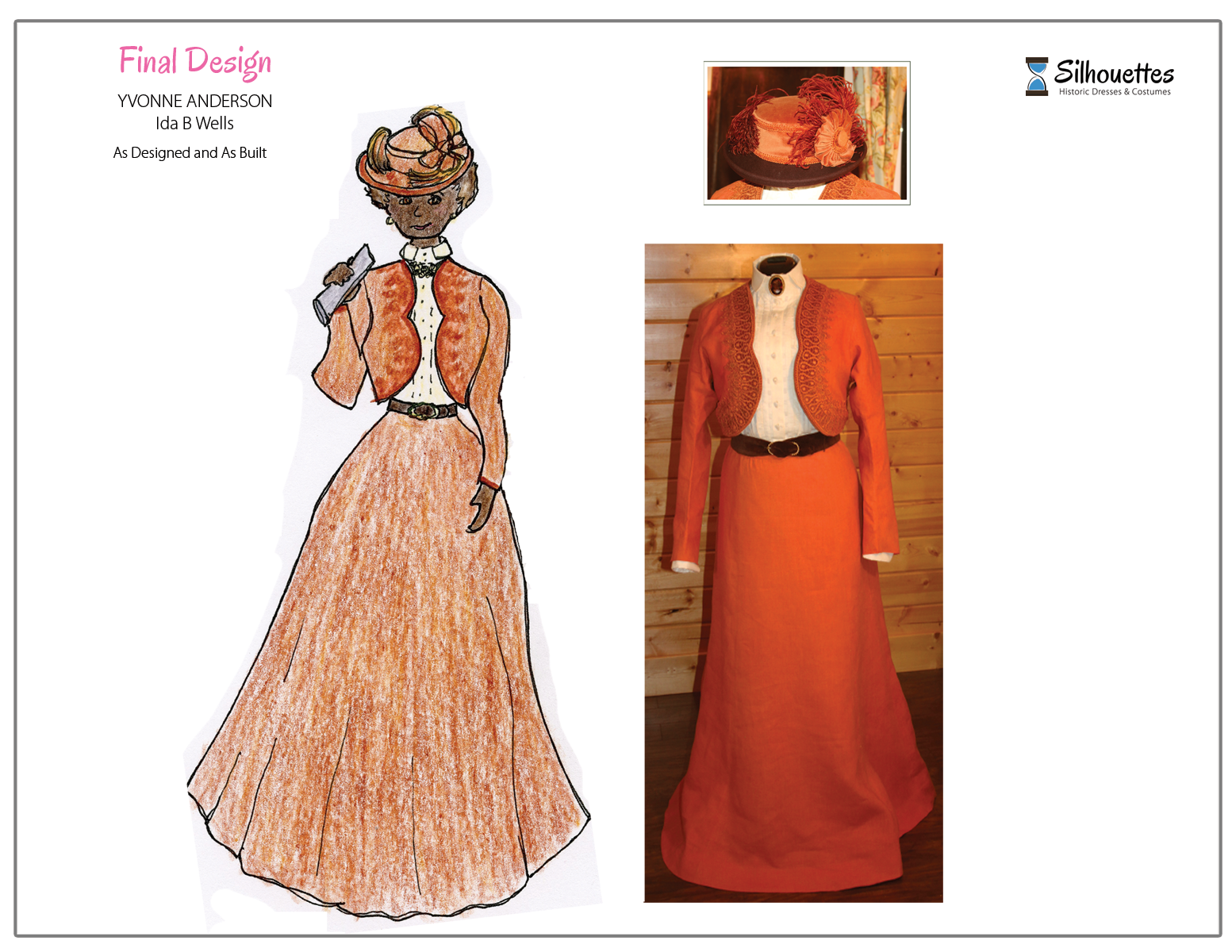

1898-99 is the final choice! The color scheme is based on historic gold, with dark brown accents in trim and accessories. The silhouette is created by a late Victorian symmetrical waist-cinching corset over which the assymmetrical gored petticoat and skirt with flat front and full back bring the lines into the Edwardian era. It’s just what a woman would have done – hung onto her old undergarments, used basics for the “suit”, and dressed it all up with the most current accessories and hat.
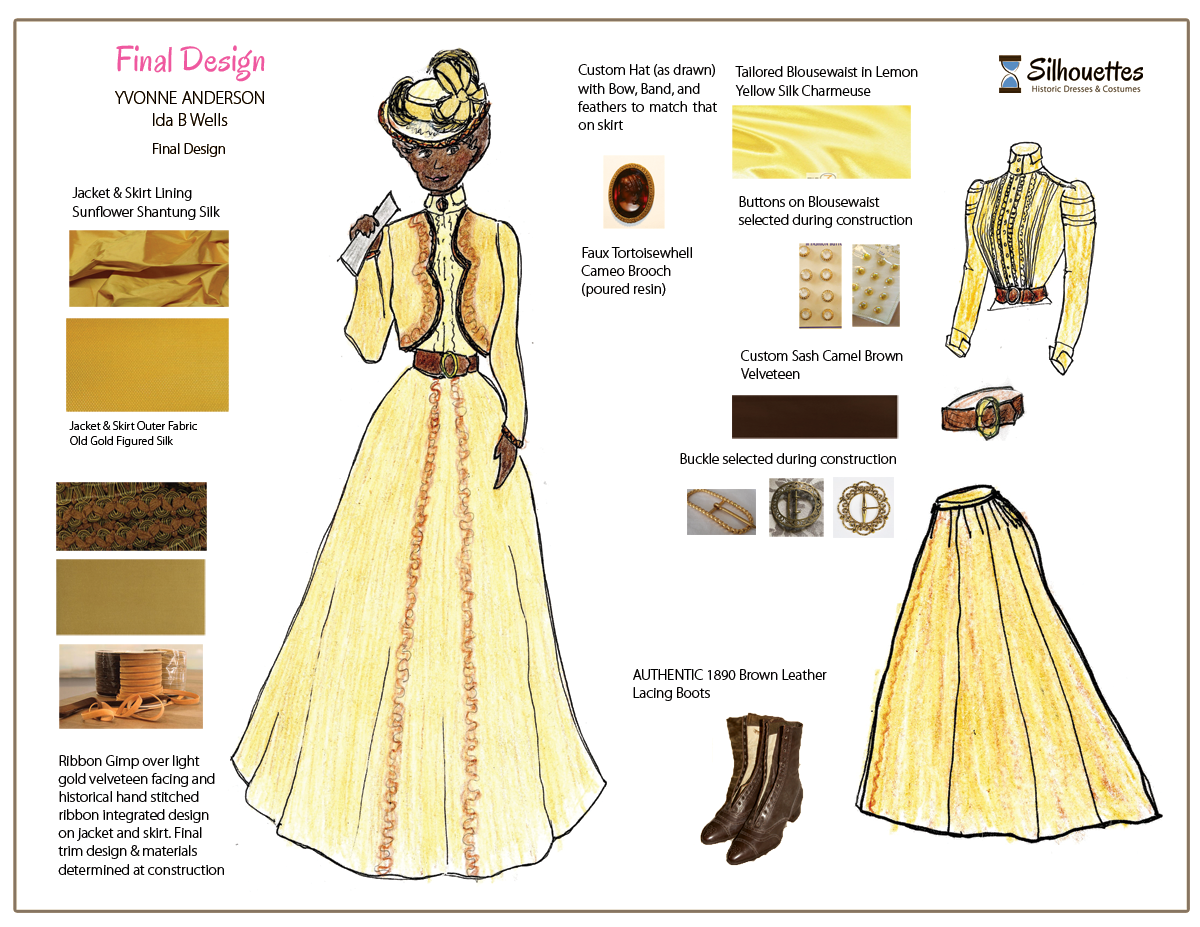
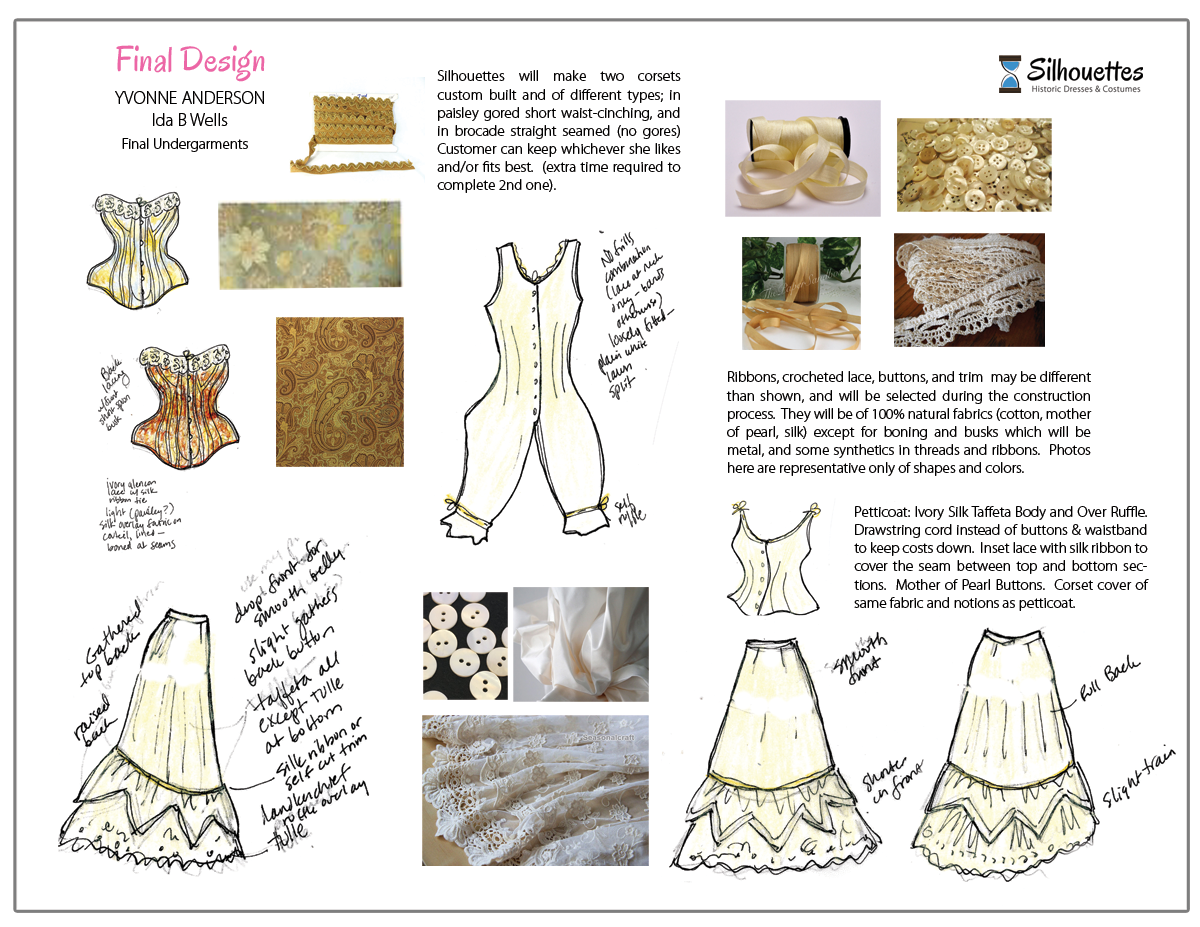
But Wait!
After careful analysis and reconsideration, Dr. Anderson has decided to complete the ensemble in the Rust/Tangelo scheme. We found this amazing photo of the Columbian Exposition (below) that affirms the decision to have a rust “suit” with ivory blousewaist and coordinating hat. We know we are exactly right with this design.
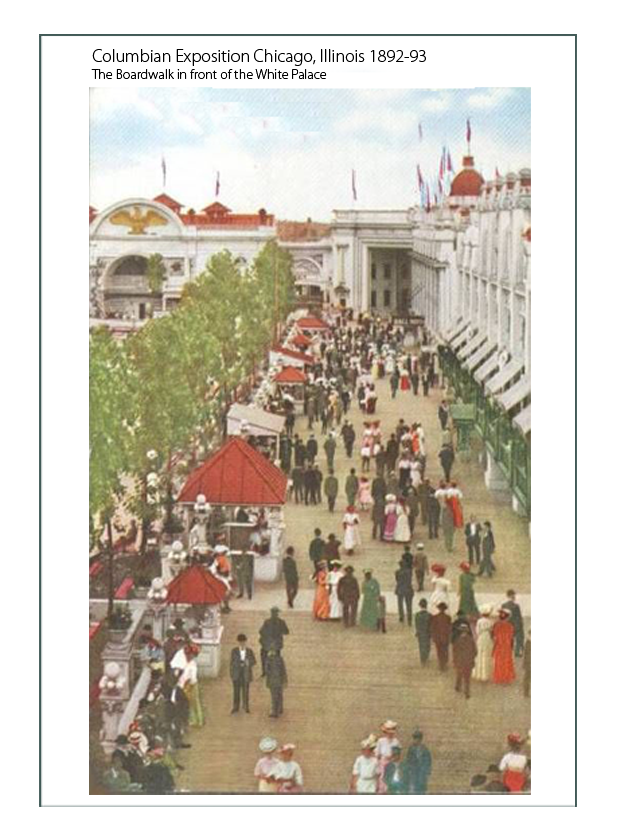
THIS IS IT!!

The Rust/Tangelo scheme with selections made. There will be a few things determined during construction (easier to see laid out on the real fabrics) like buttons, buckles, and laces – but this is the final design being built. Undergarments are the same as above.
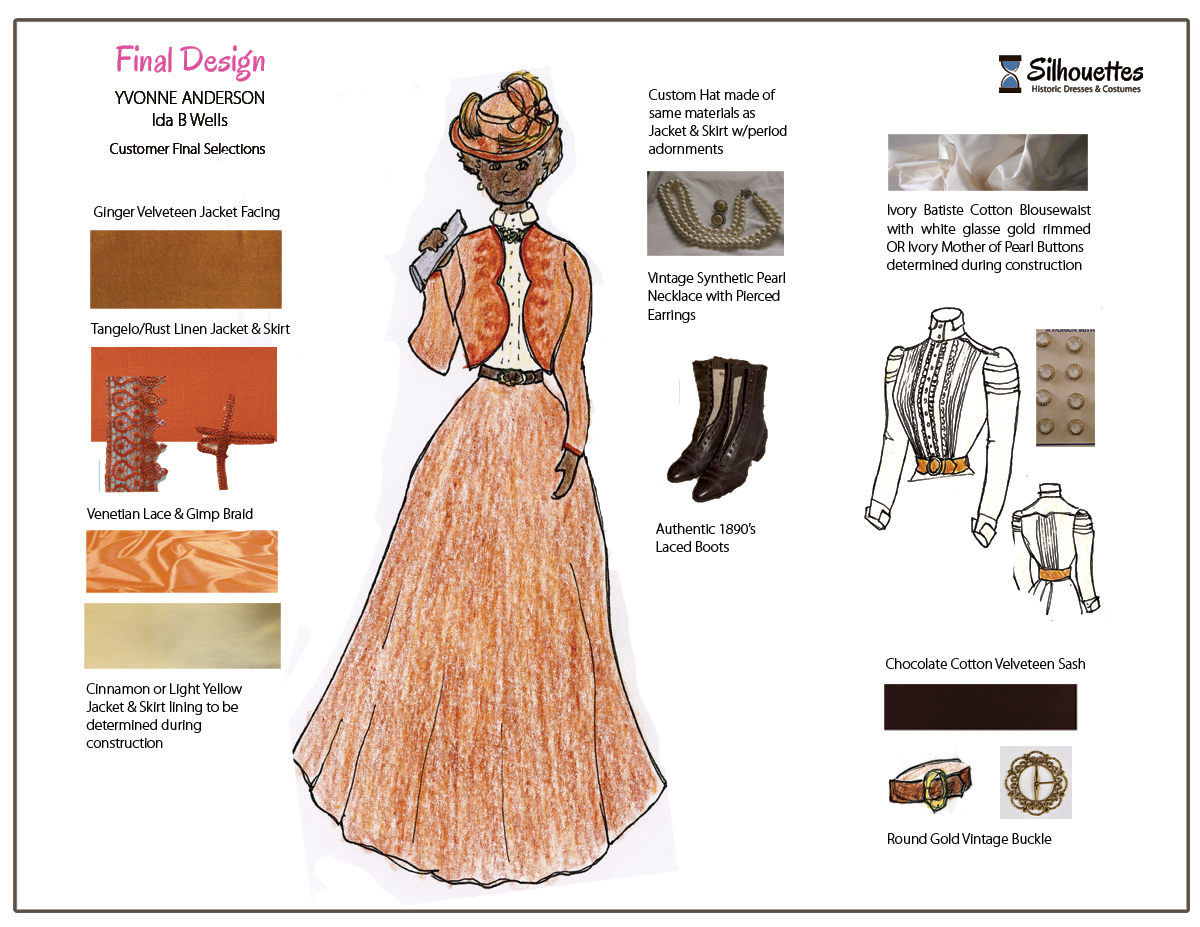
These are the Final Fabric & Notion Selections
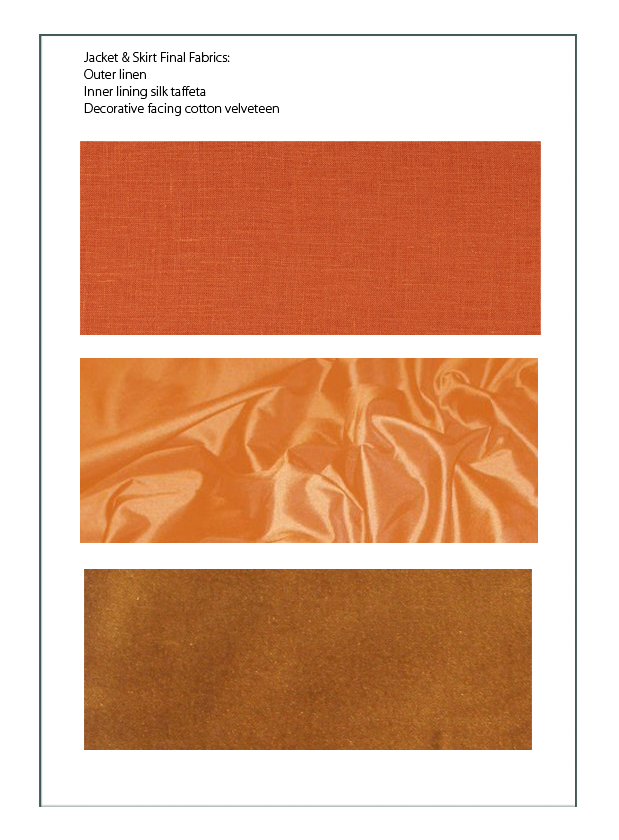
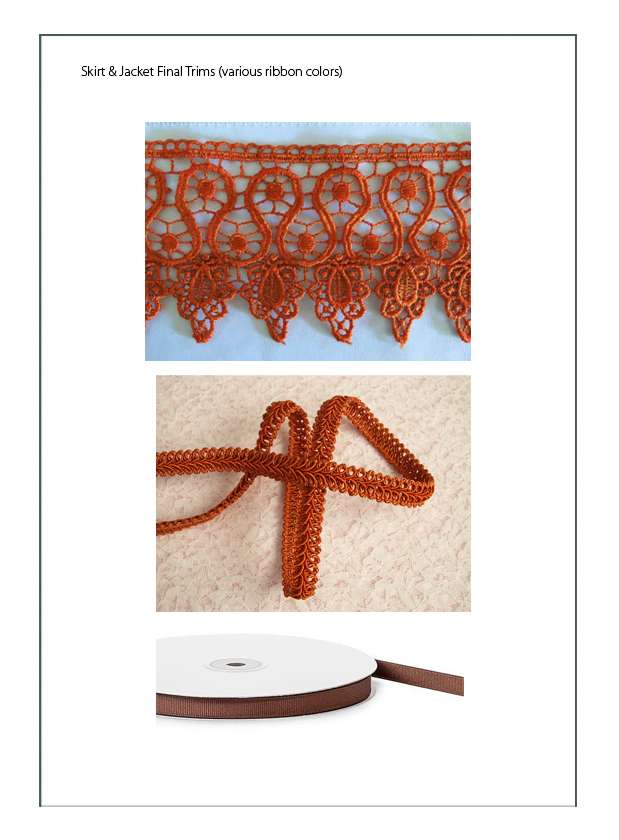
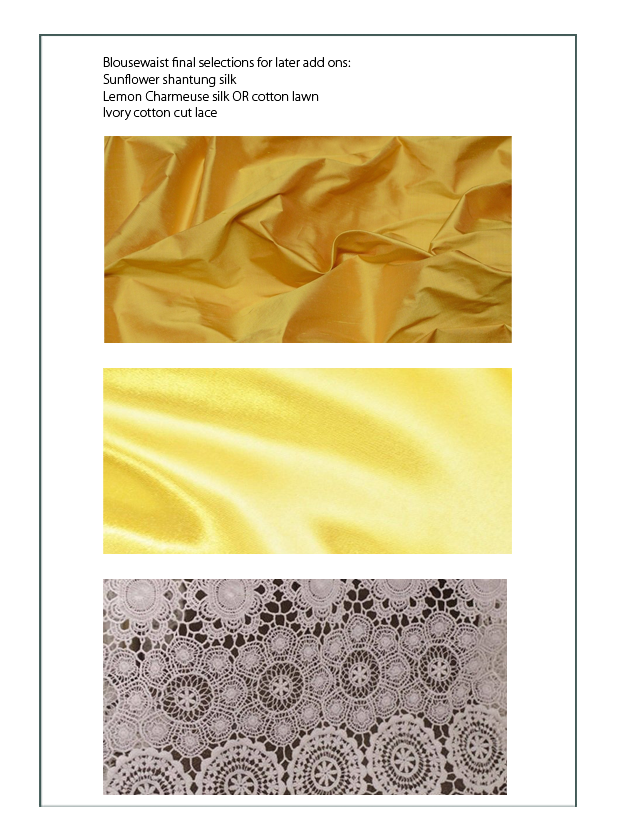
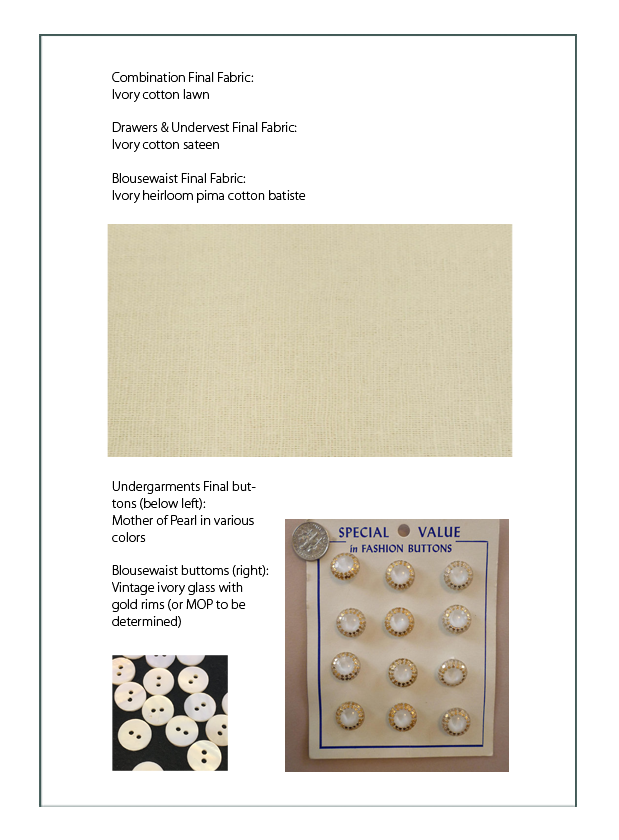
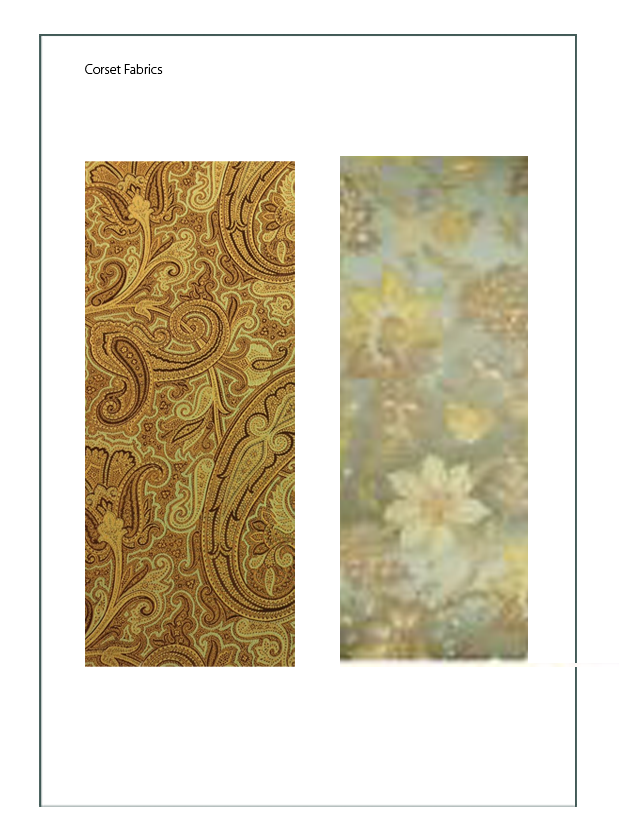
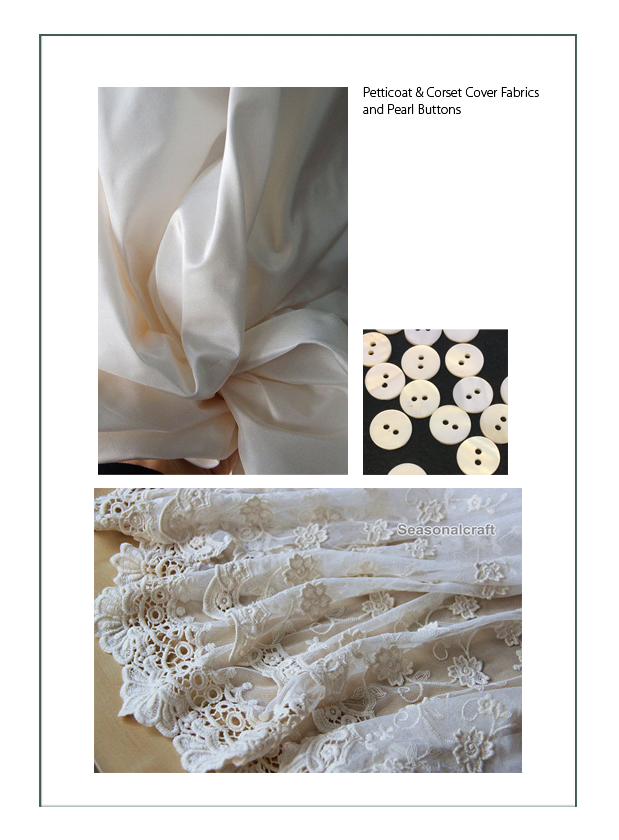
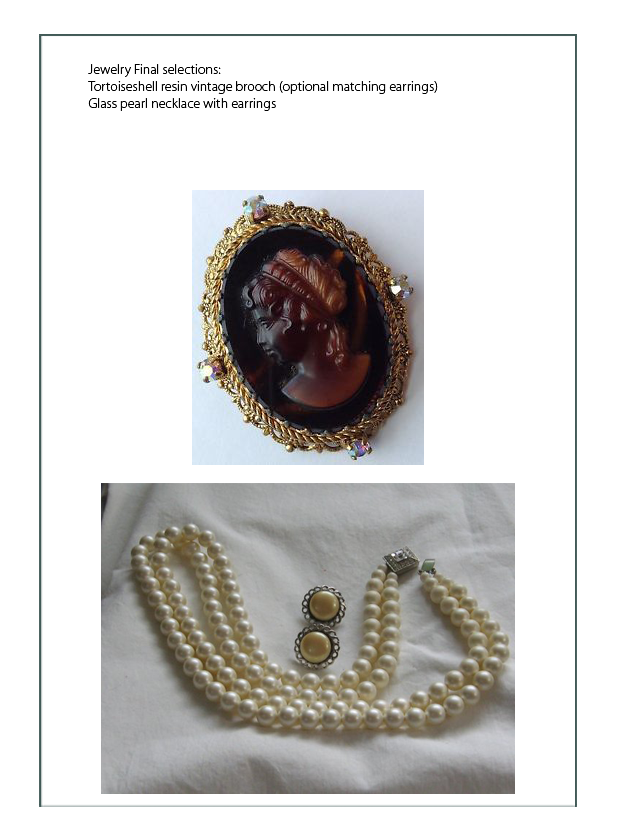 In making final decisions, Dr. Anderson also considered an ivory authentic cameo, so we went on search for matching mother of pearl earrings, and presented a closer view of the tortoiseshell so she would have data to make enlightened comparisons:
In making final decisions, Dr. Anderson also considered an ivory authentic cameo, so we went on search for matching mother of pearl earrings, and presented a closer view of the tortoiseshell so she would have data to make enlightened comparisons:
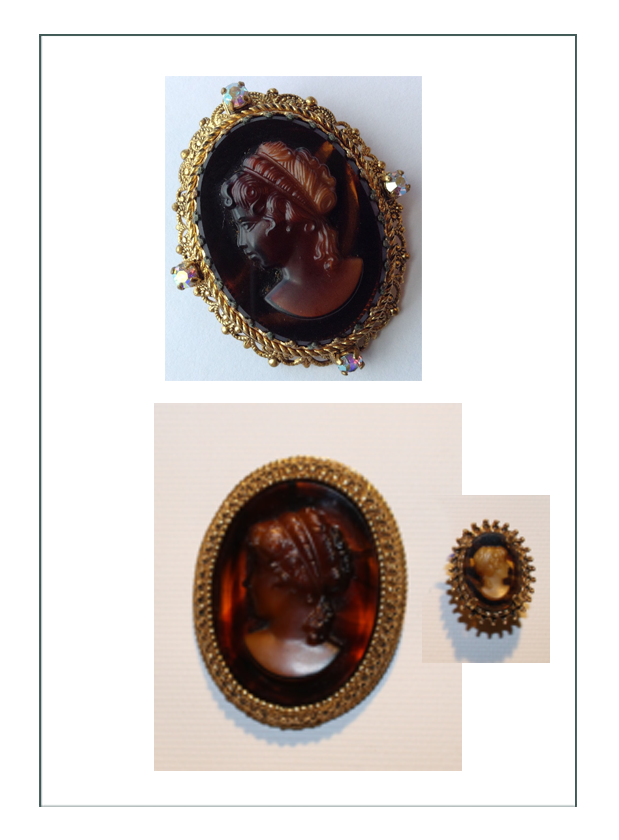
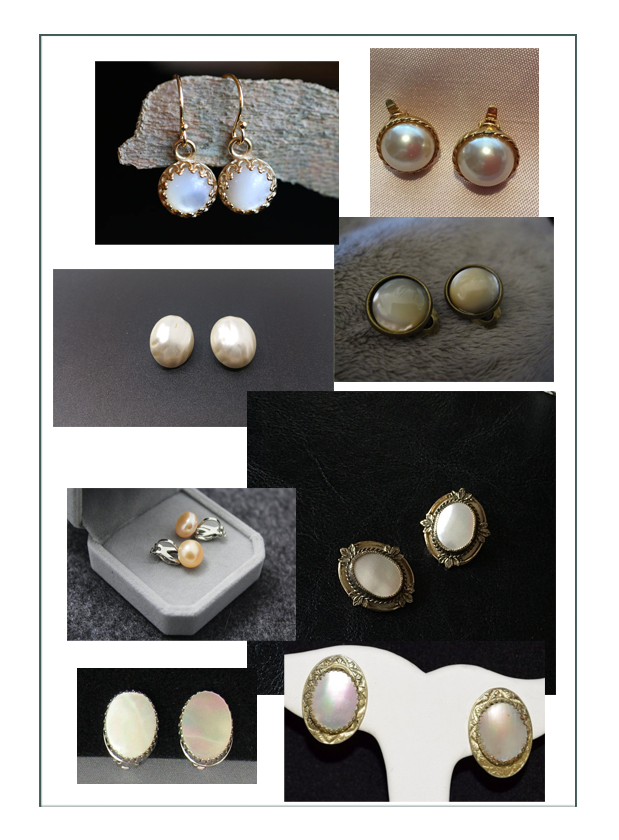
.. and footwear is down to the final two – reproduction Tango pump, or authentic lacing boots in pristine condition: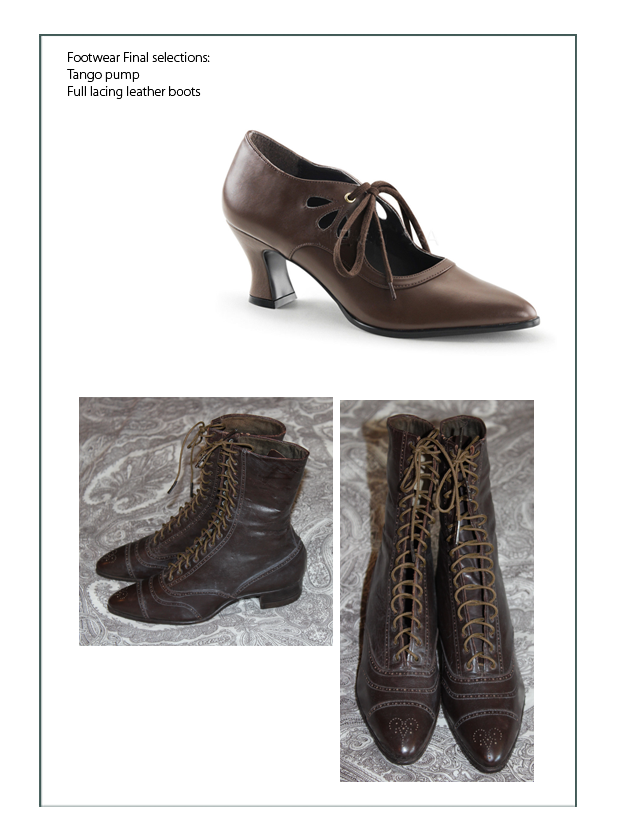

Blousewaist
Mockup First
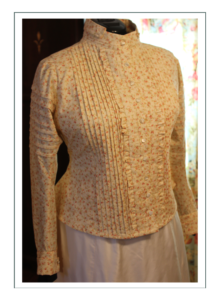
In constructing original design, and with the customer across the country, we have been using a dressmaking dummy to build the ensemble. While this is “pretty good”, a dummy is not “squishy” like a person, and so there are many issues with fitting to the body, especially using corsets and sashes and things that can be loose or tight depending on preference.
The way historical women of the late 1890’s dealt with this was to buy or make outer garments that were a “set” point, and then to adjust the corset and undergarments to that. The extra pound gained or lost would be padded out or cinched in using the corset.
Since we don’t really cinch to restrict the body these days, we have to be more accurate. The blousewaist is designed to be tailored, well fitted, and to minimize bulk through the front, arms, and lower belly. We had to make a test run in a lesser costly fabric to ship it down to Dr. Anderson to try on over her undergarments.
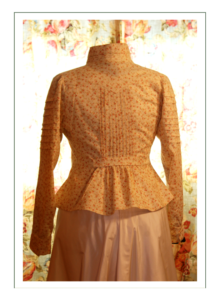
This is the design in a “coarse” look – more like a prairie blousewaist style because it is made out of a heavier, premium printed cotton. It has mother of pearl authentic buttons – teeny ones at the neck, and the same tucks and pleats and detailing as the final one will have – EXCEPT – the final blousewaist will be made of a heritage batiste (very, very fine and tightly woven cotton like lawn but not see-through/sheer) with authentic cotton tatted lace on cuff and collars, and special mother of pearl buttons.
The tucks will be tighter and lighter in appearance (so it doesn’t look “spikey”), and instead of, or possibly over, the ruffle, it will have an edging lace. Overall, it will be much more delicate, less bulky, but still tailored. The inside seams will have better finishes, and it will be a garment for a professional woman of the city of the time.
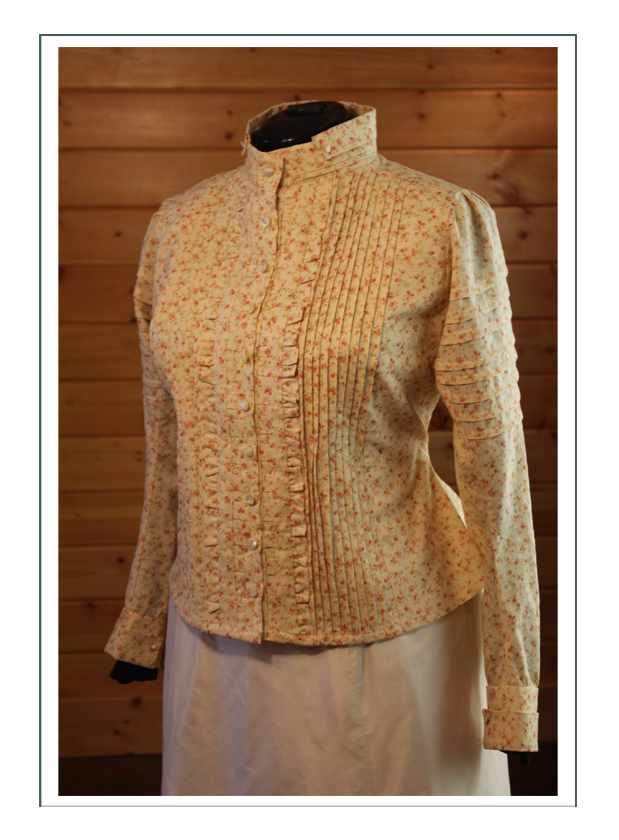
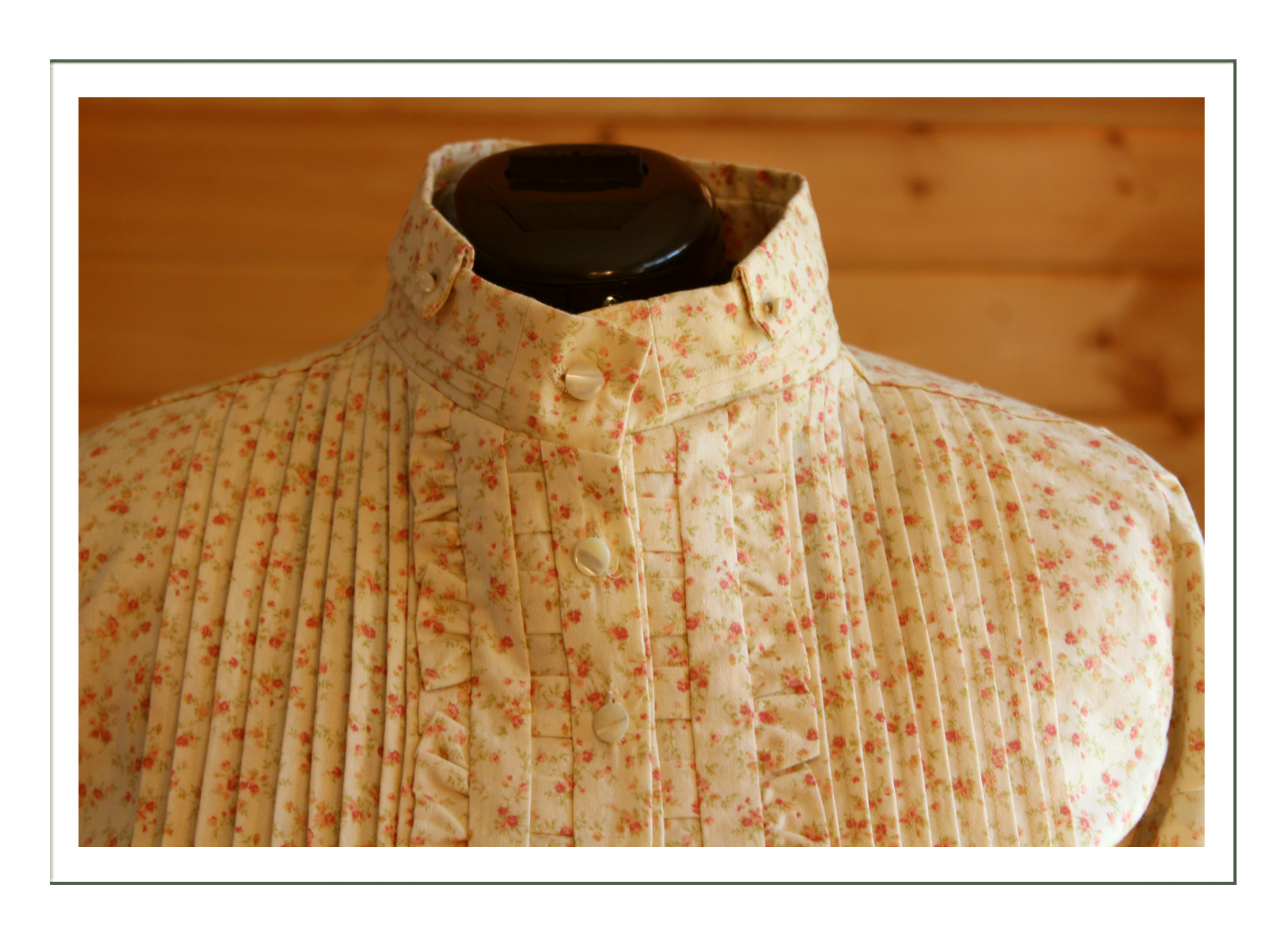
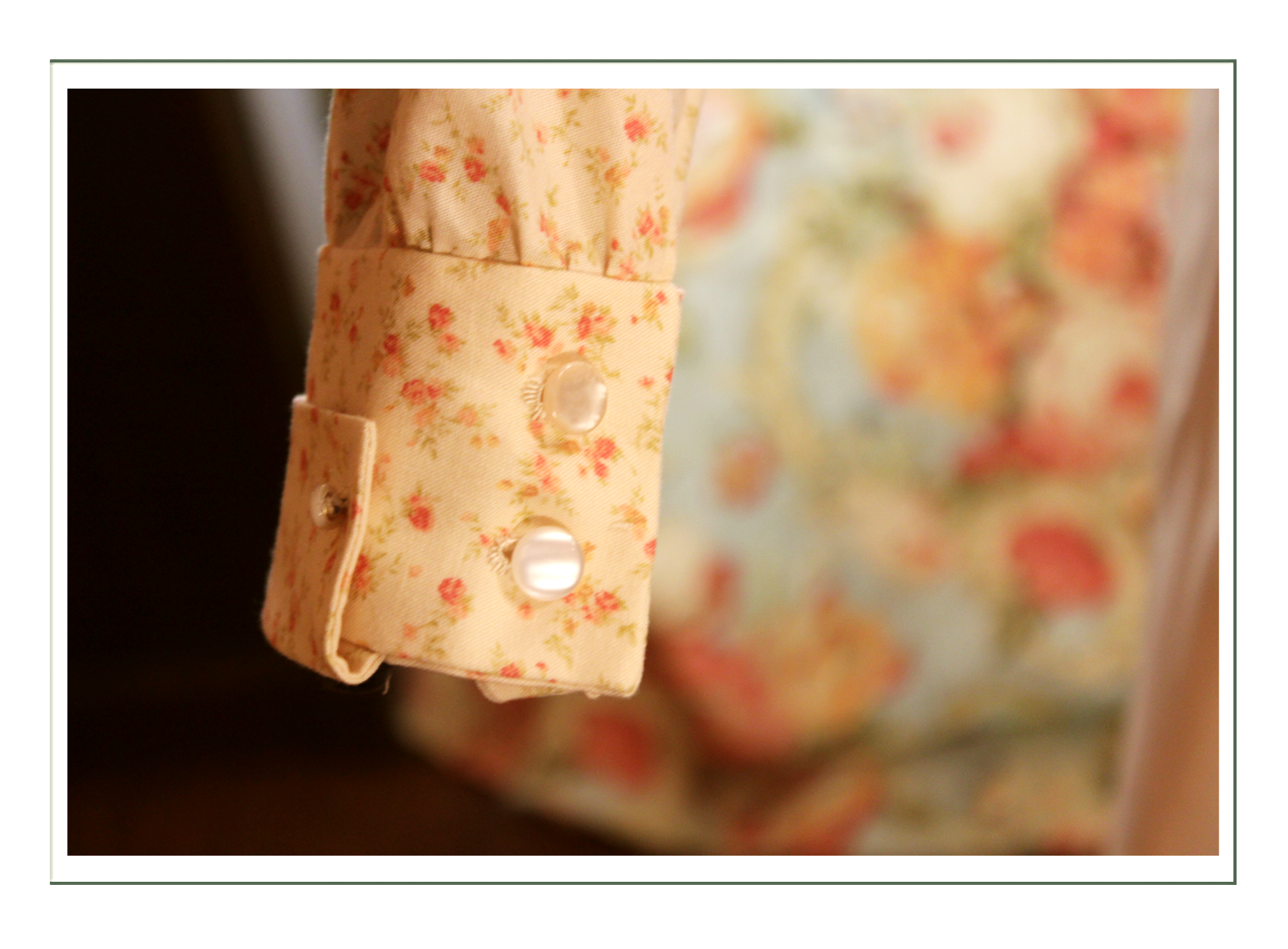
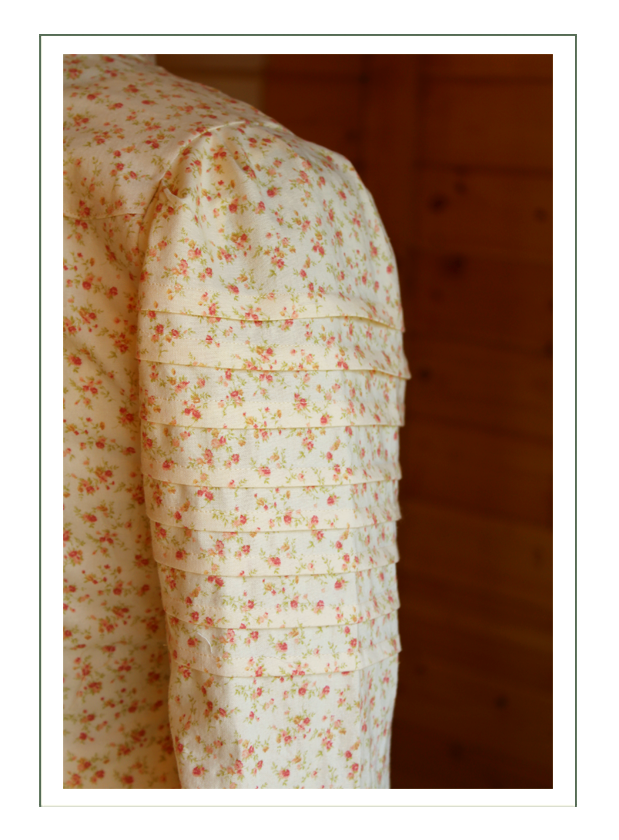
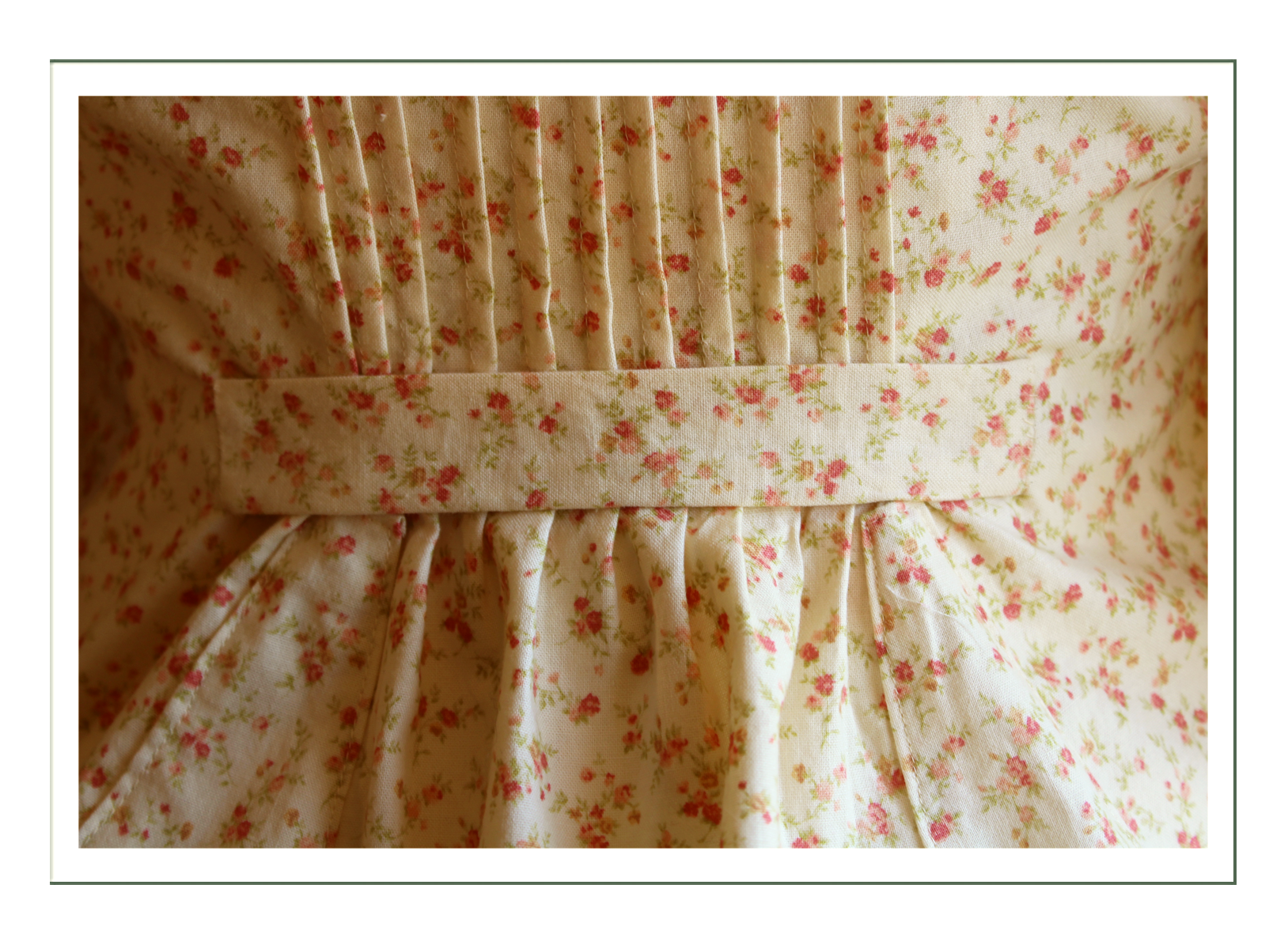
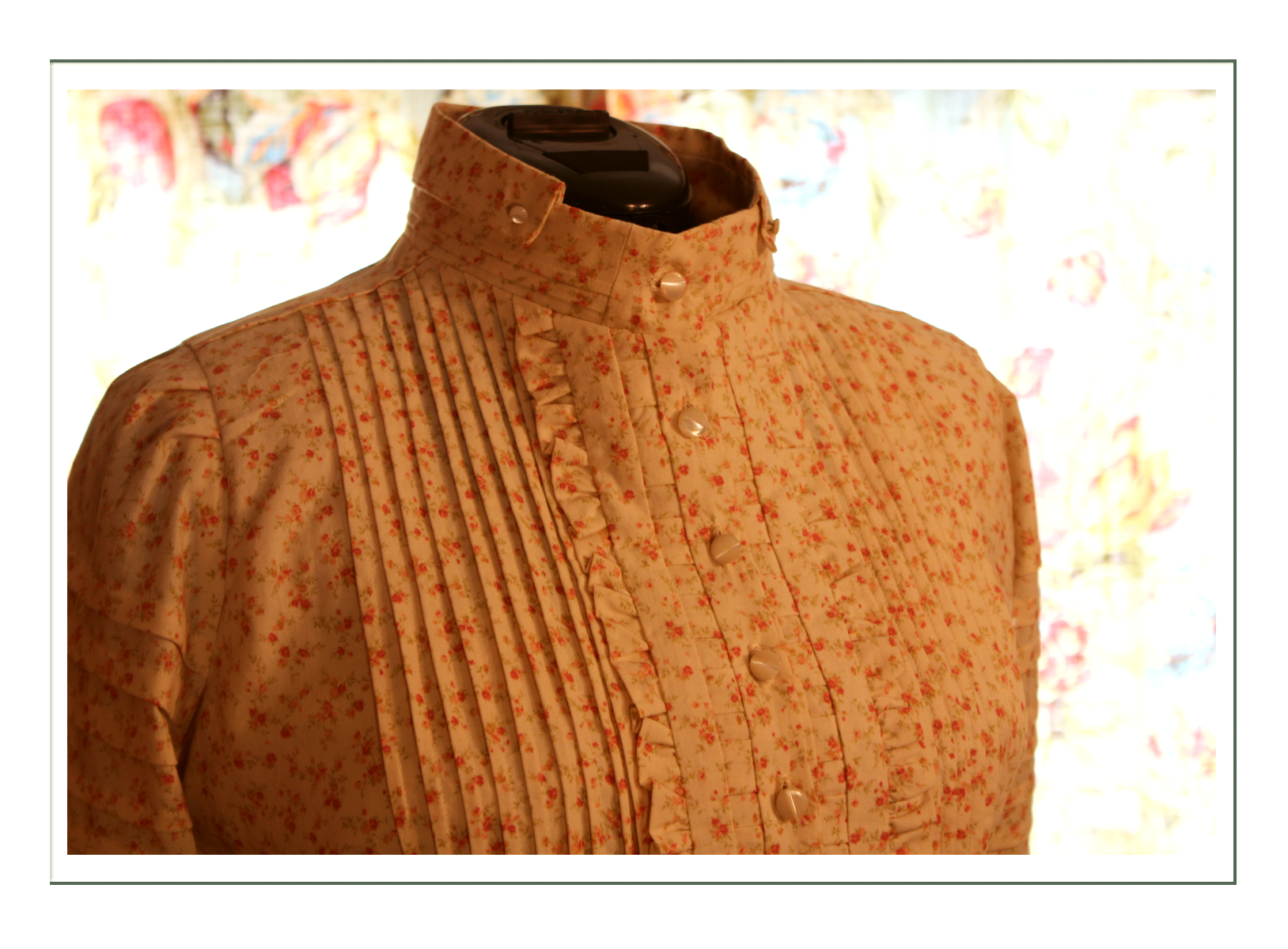
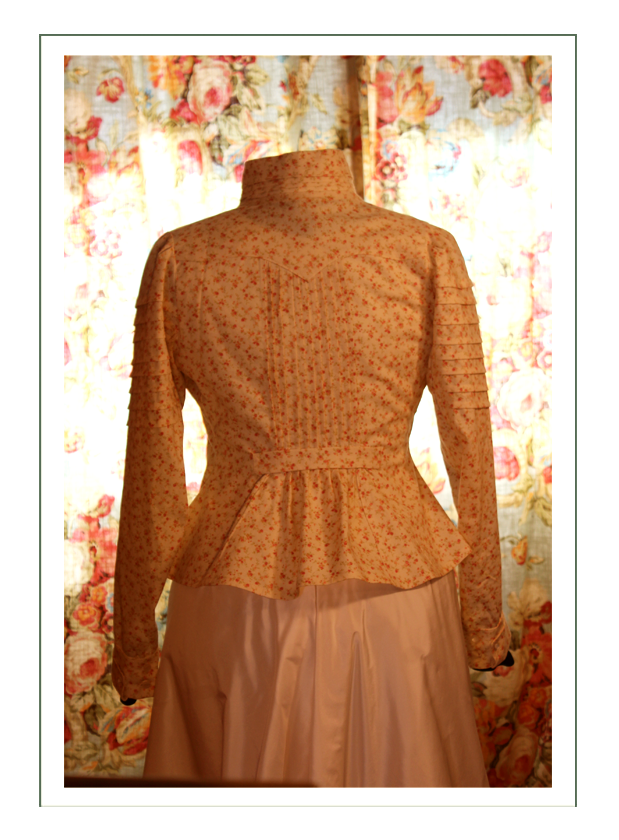
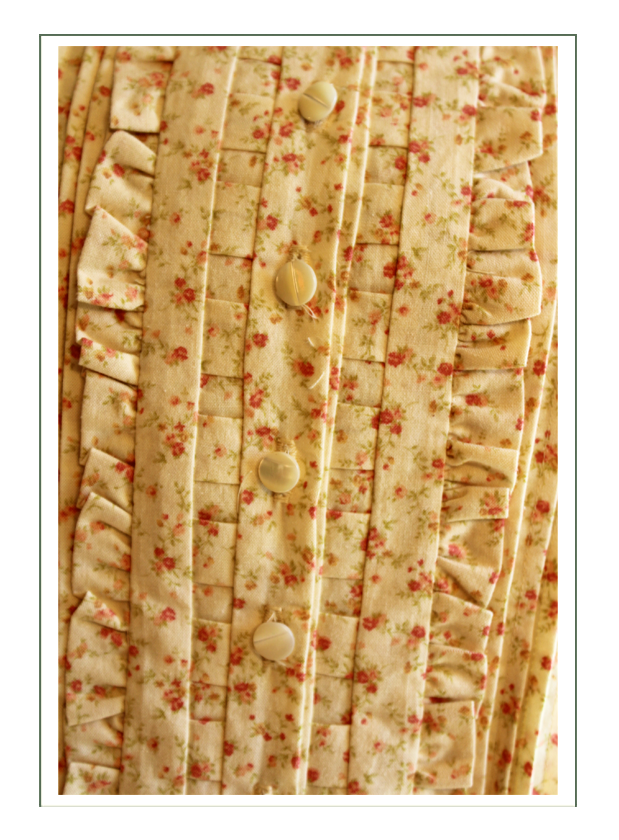
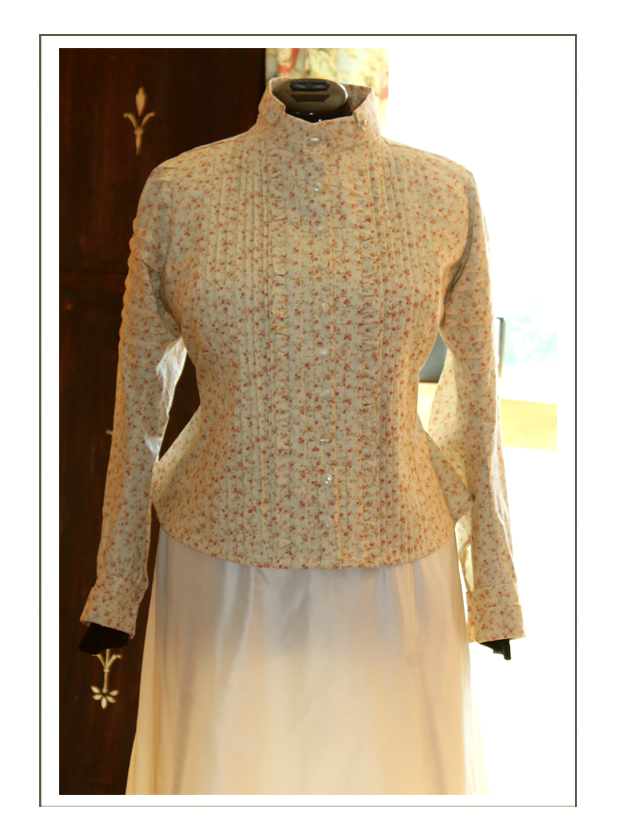
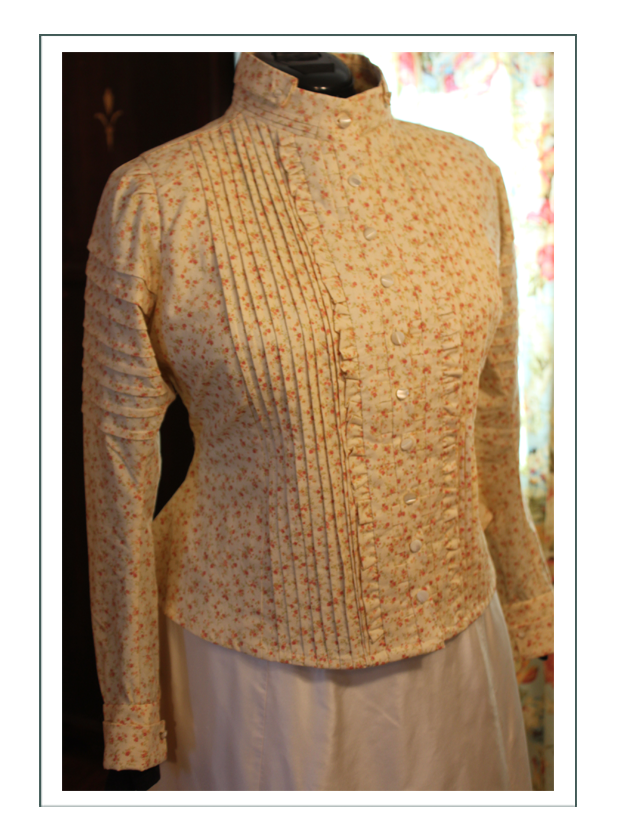
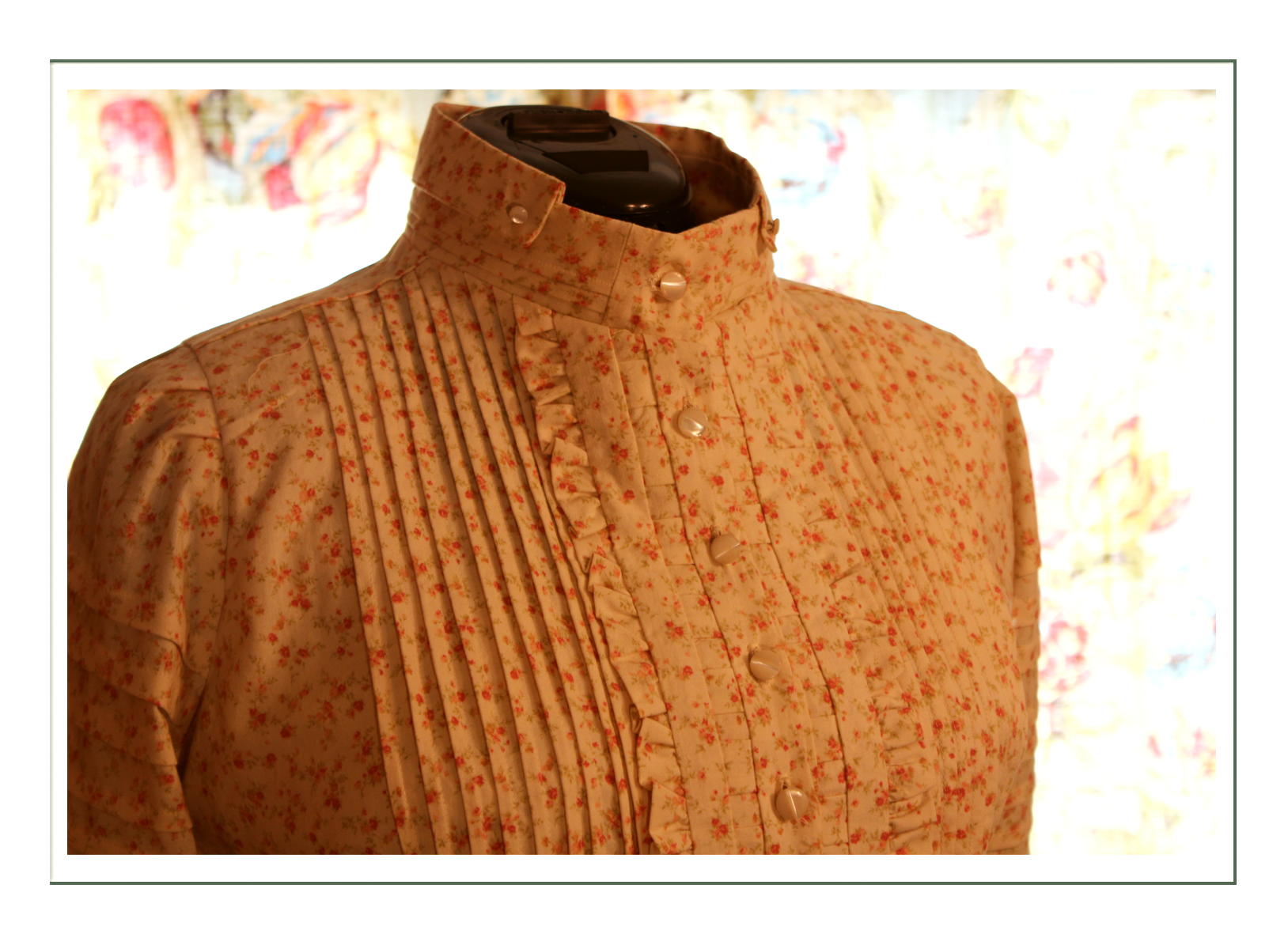
FINAL Blousewaist
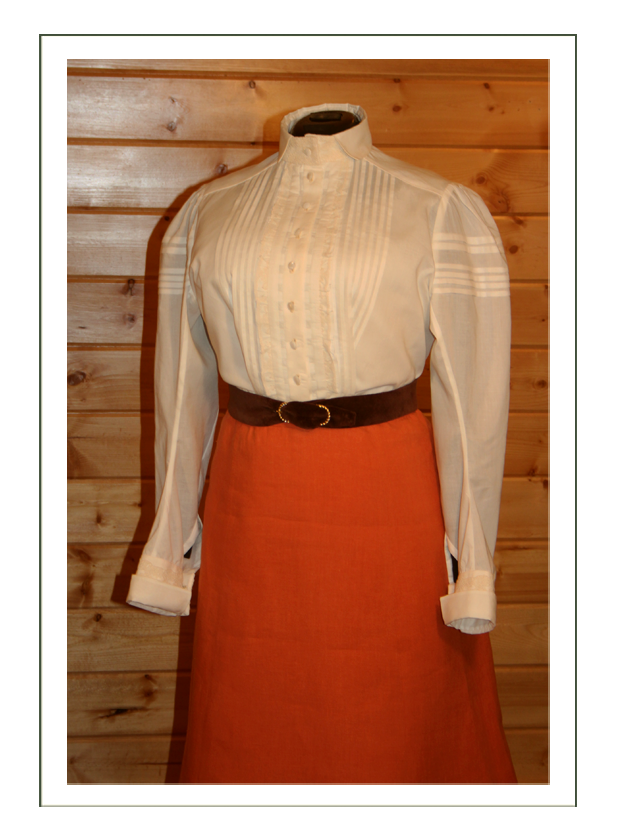
The final design is a bit different than the mockup – predominantly it does not have fitted darts in the bottom front, but depends on getting its shape by tucking it in. The pleating is made to lie very flat in front across the belly to maintain the overall silhouette, and is full in the back.
The pleats are smaller and more delicate, and the center decorative section is narrower too. Tucks are smaller and higher on the arms, and there is more fullness at the top of the sleeve in the final design.
The goal is this to be a perfectly fitted and utility type of blousewaist that acts as a neutral background for the elaborate jacket and skirt, and to show off the jewelry.
In reviewing actual photos of Ida B., we note this pleating tucking, ruching, and kilting is very consistent with her every ensemble. The result we believe overall is a very classy, tailored, and professional “no fuss” ensemble that would have been appropriate for Ida B. to lead a meeting in the US or to travel in Europe. She would have had much fancier clothes for court.
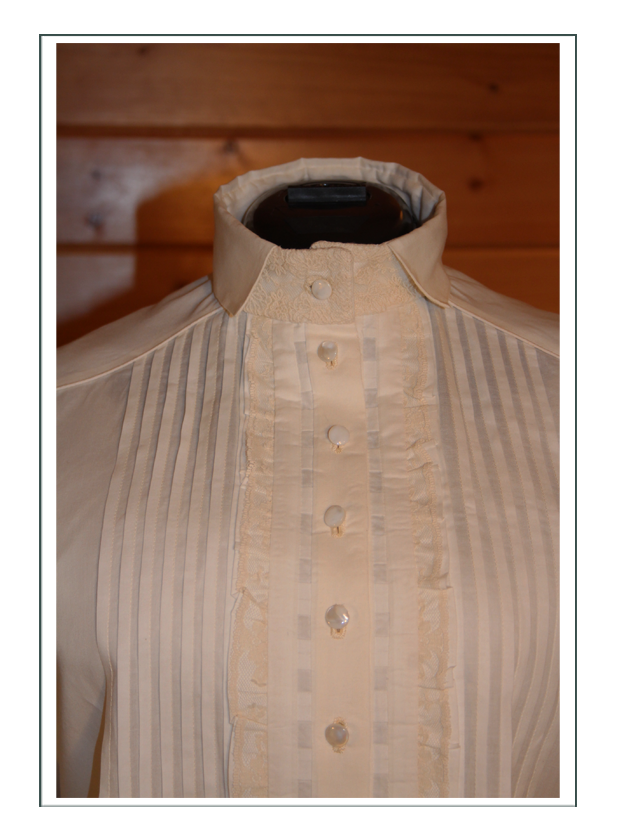
The beautiful mother of pearl buttons are shown off by hand made buttonholes of 100% silk twist. The contrasting ecru of the lace, silk thread, interfacing is designed for a VERY subtle color of ecru and ivory for interest which plays into the depth and the shadows of the many tucks, pleats, and ruffles.
Note especially the detail of alencon lace on wrists and neck – subtle and hidden for discovery when someone looks closely. We take pride in the overall image from a distance appearing natural and normal for its era – while close up intriguing and drawing interest with key details and historic features not found on modern garments such as the double cuff, stand collar, and double collar.
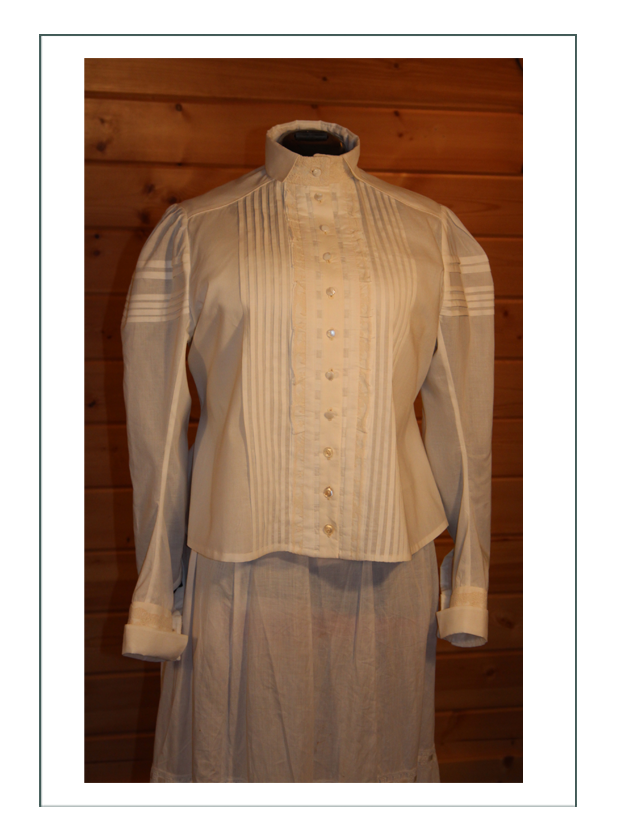
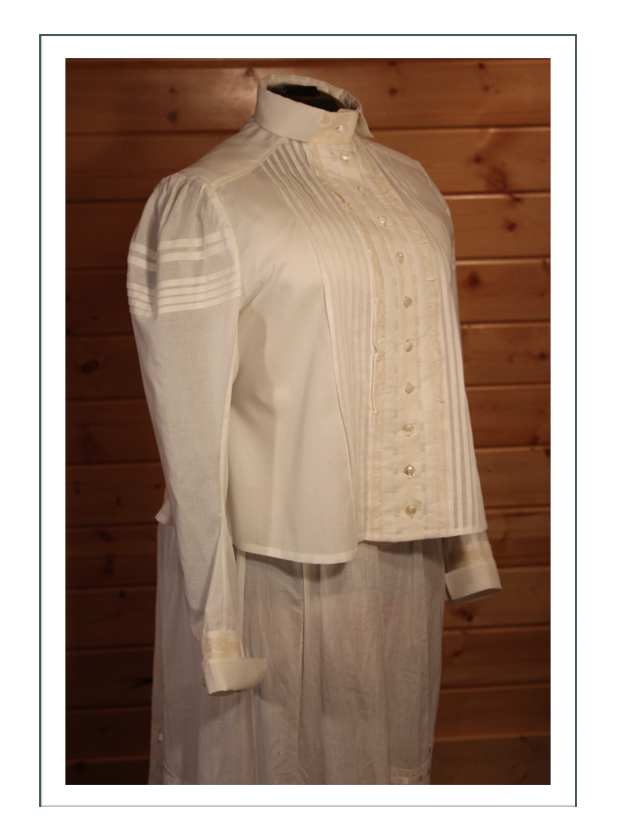
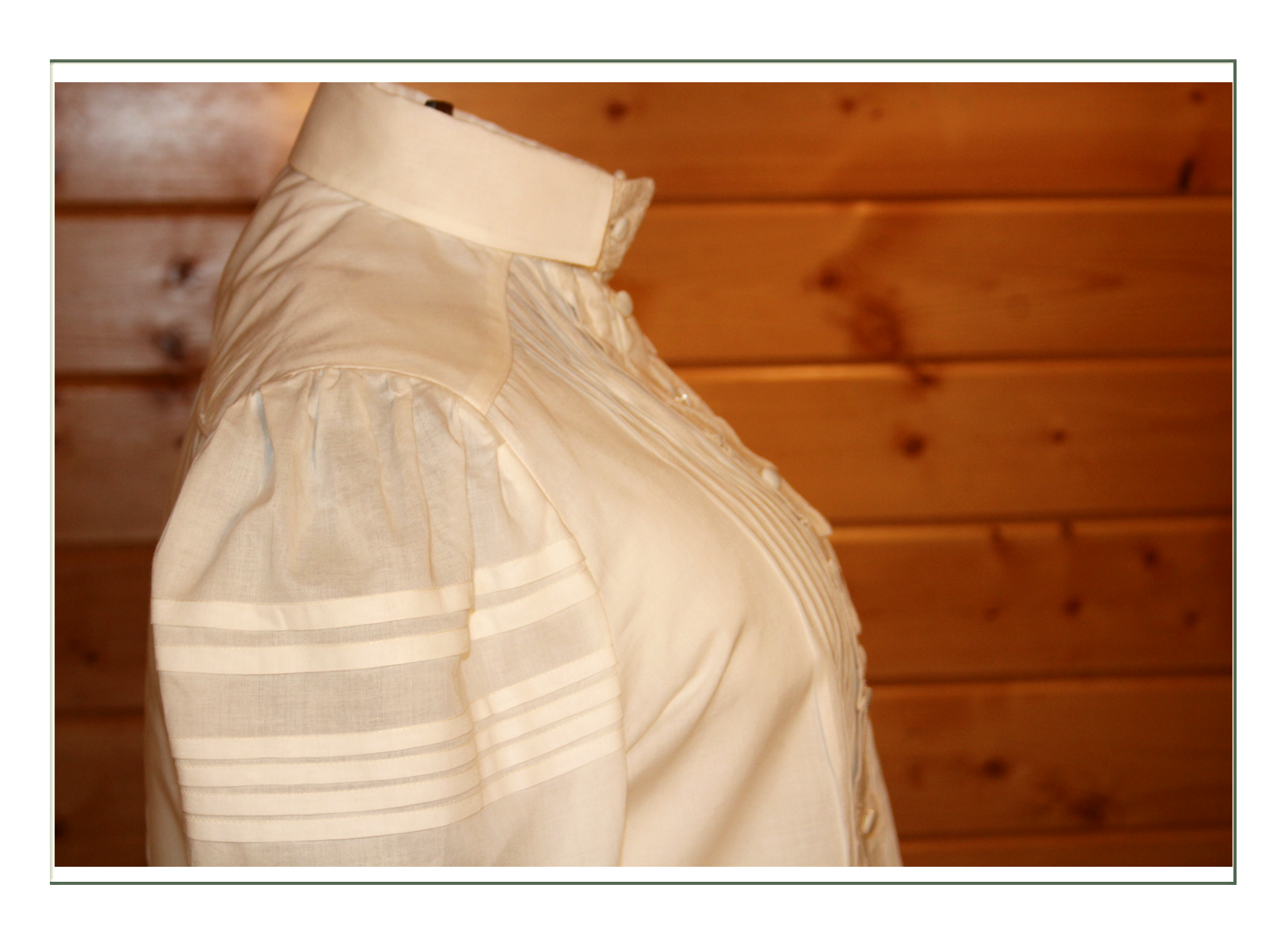
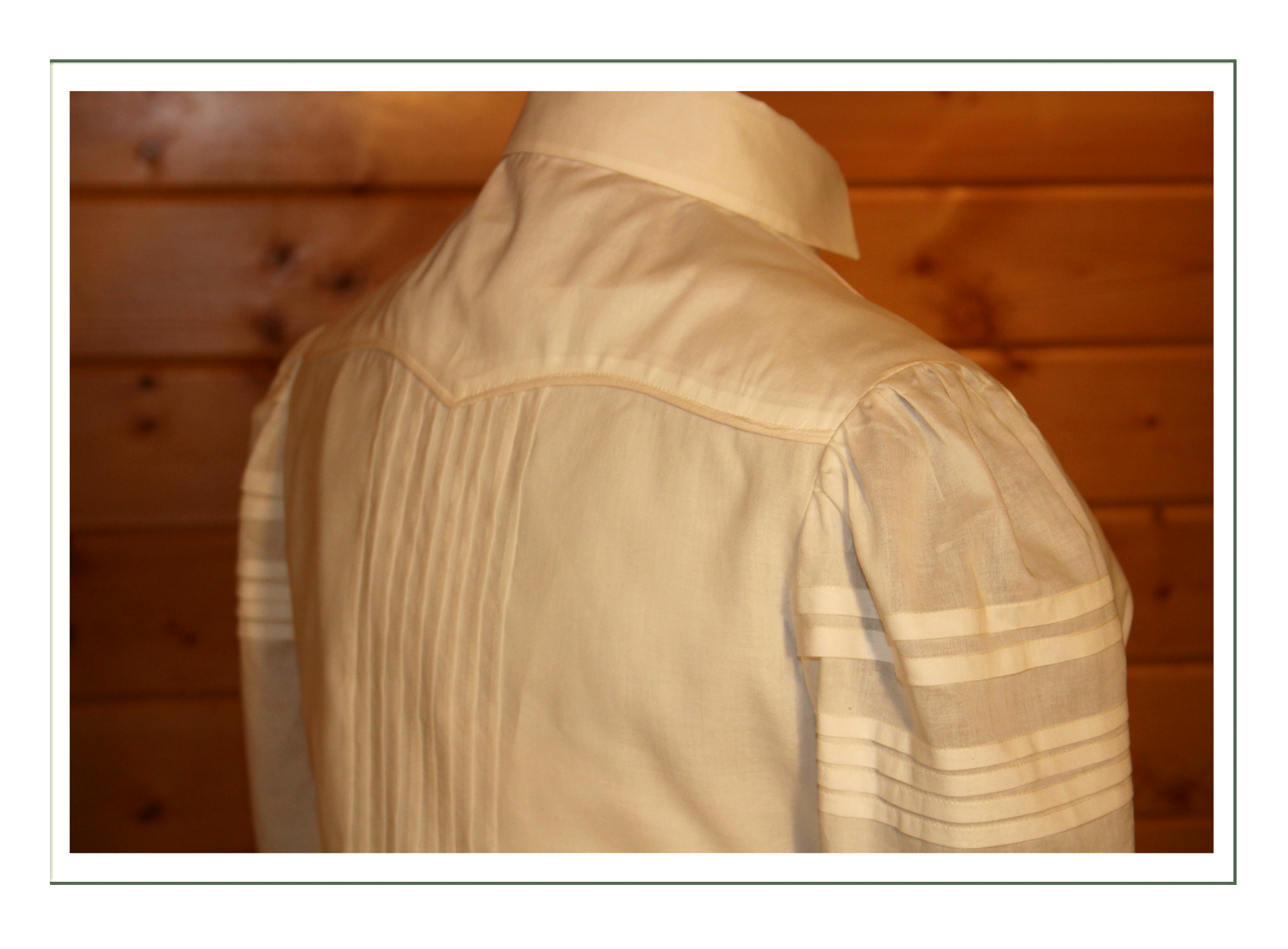
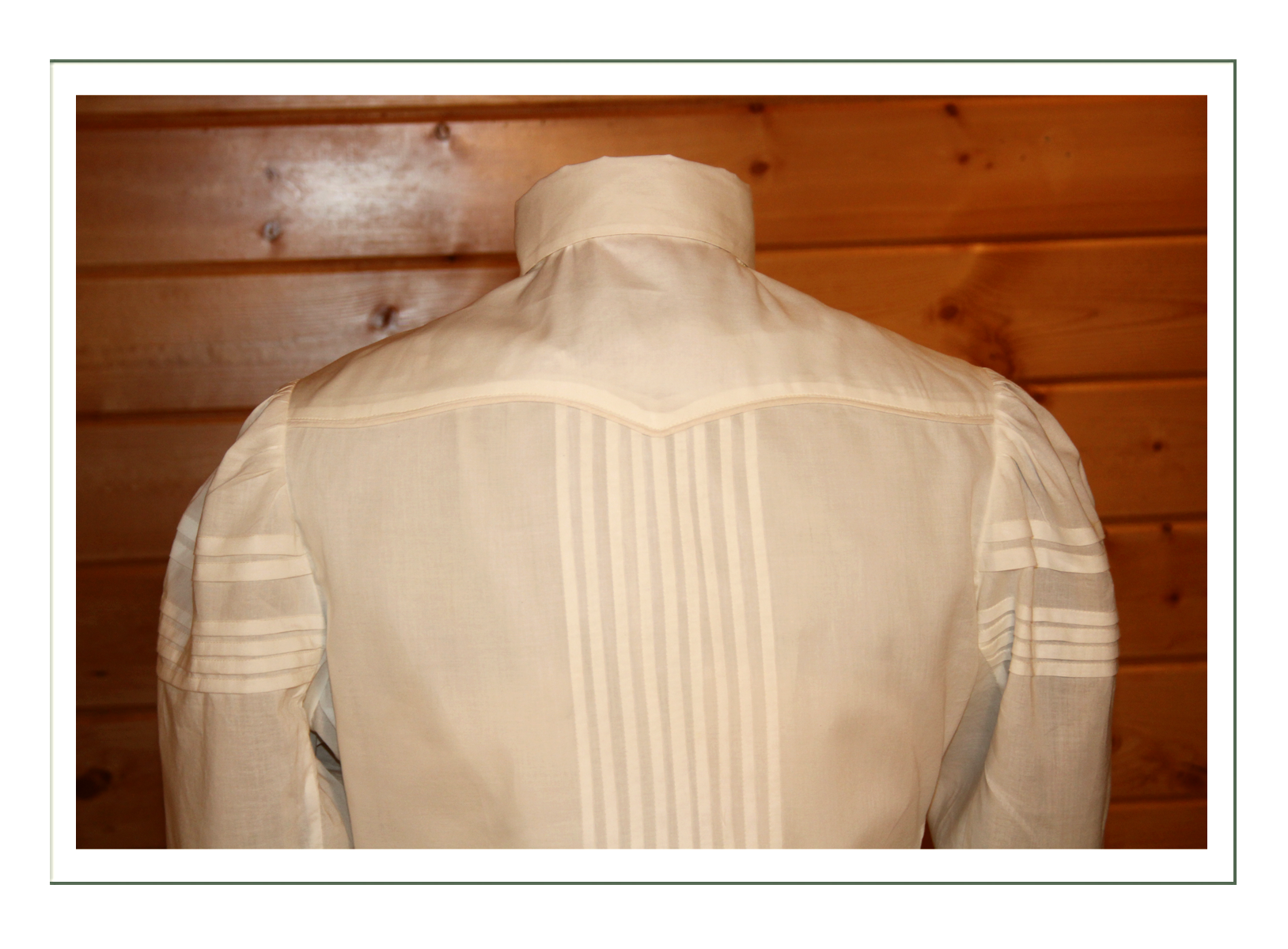
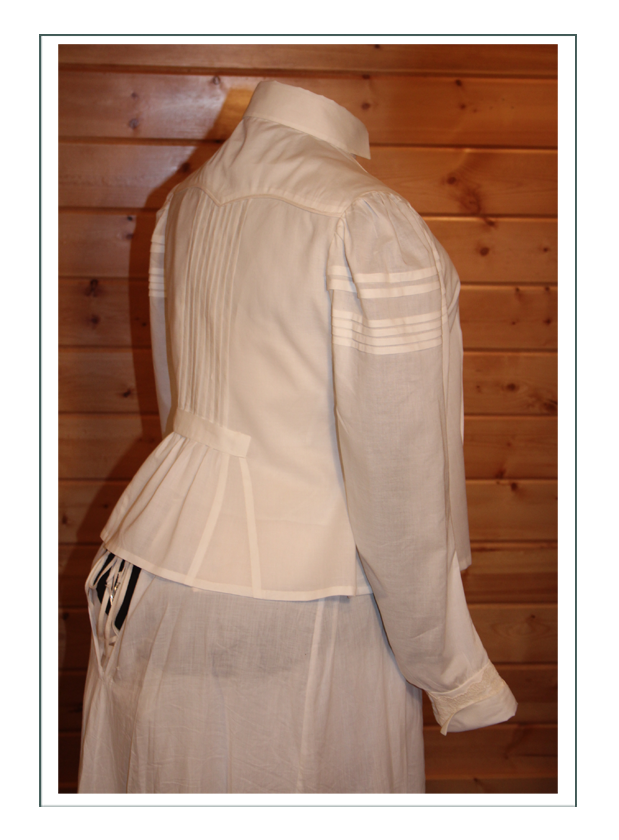
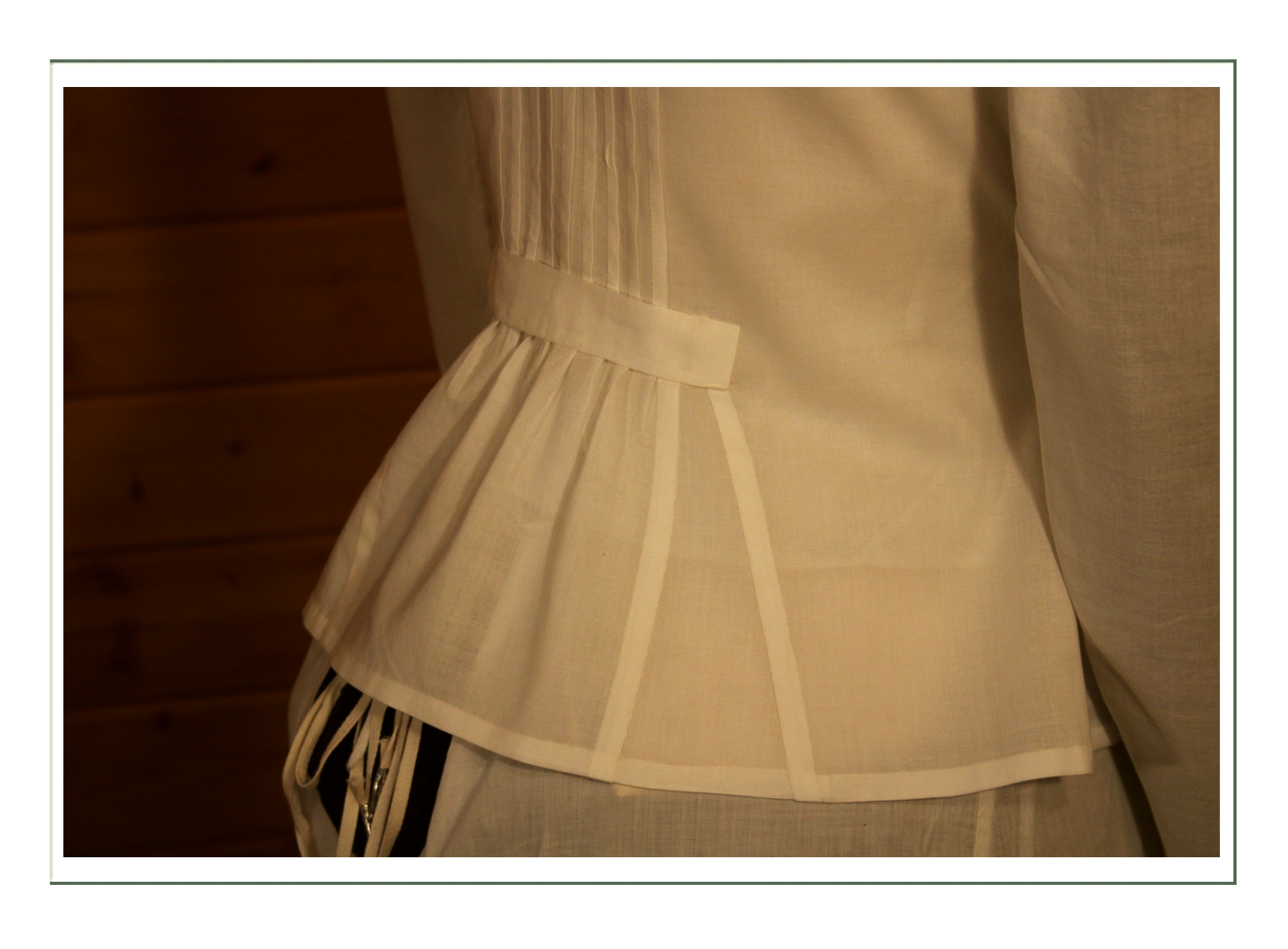
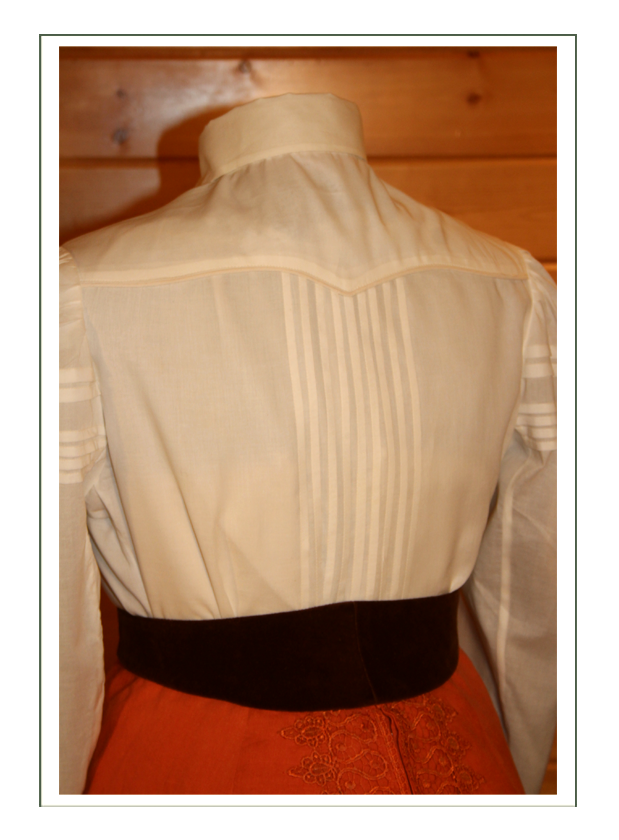

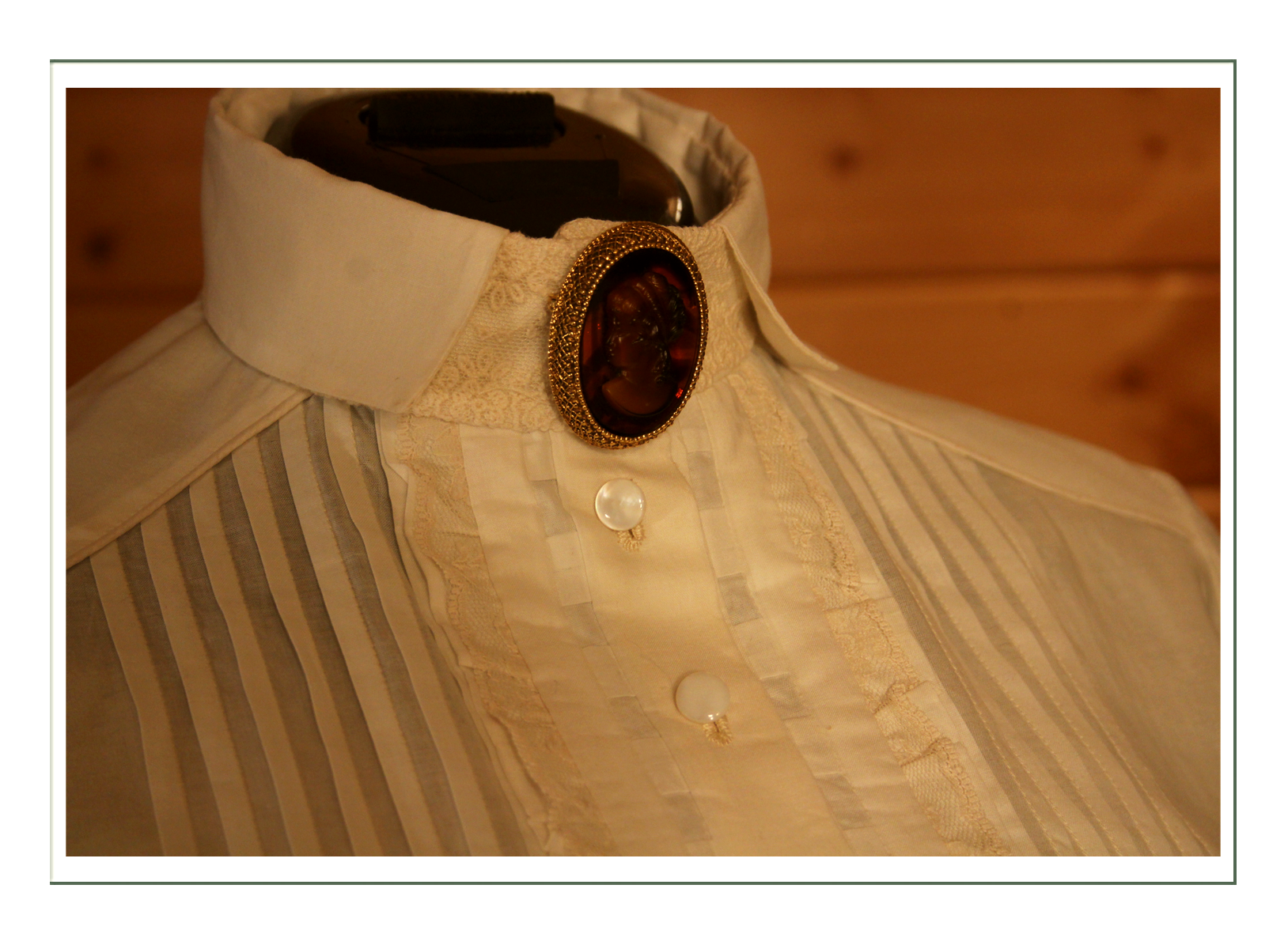
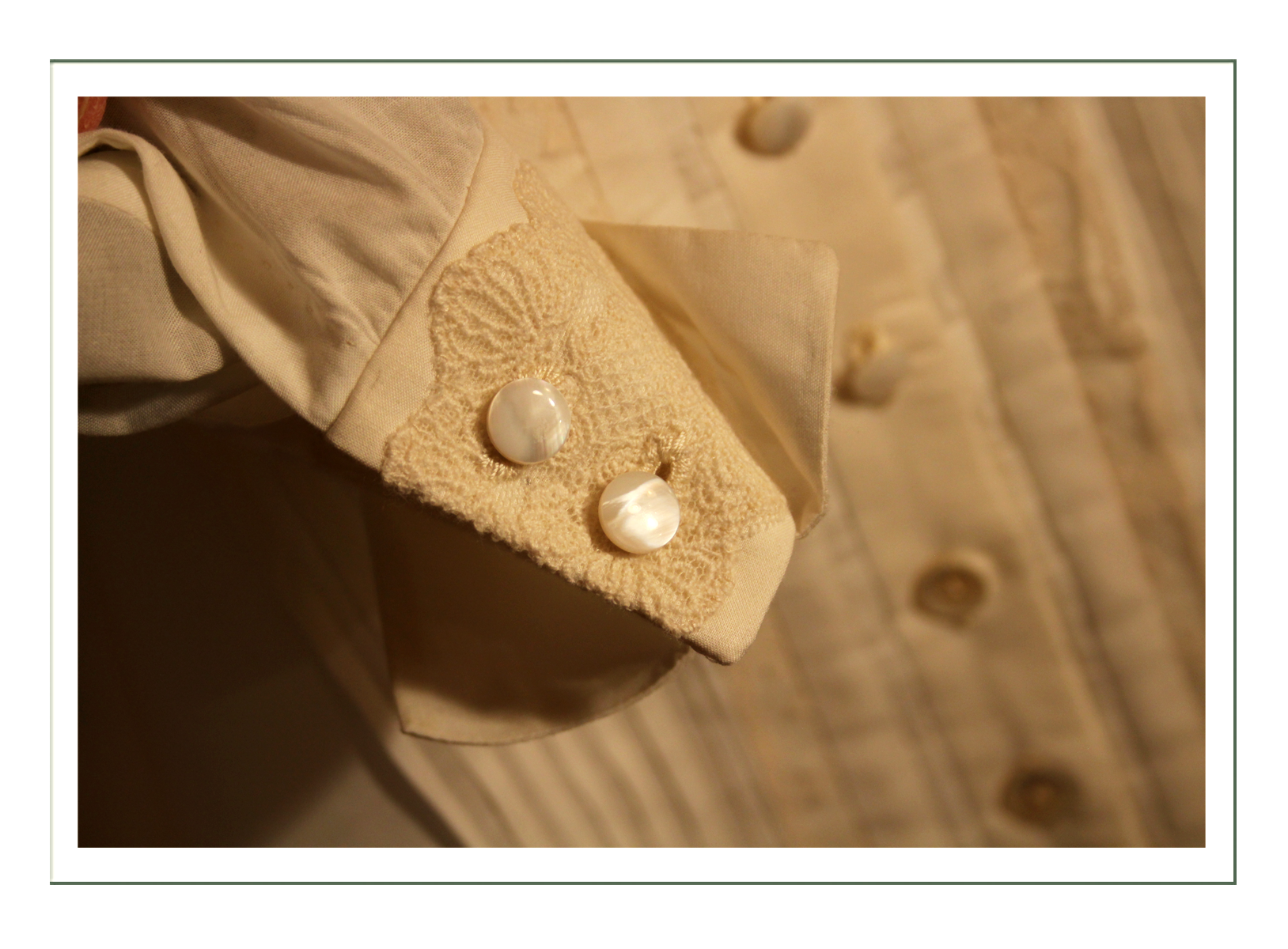
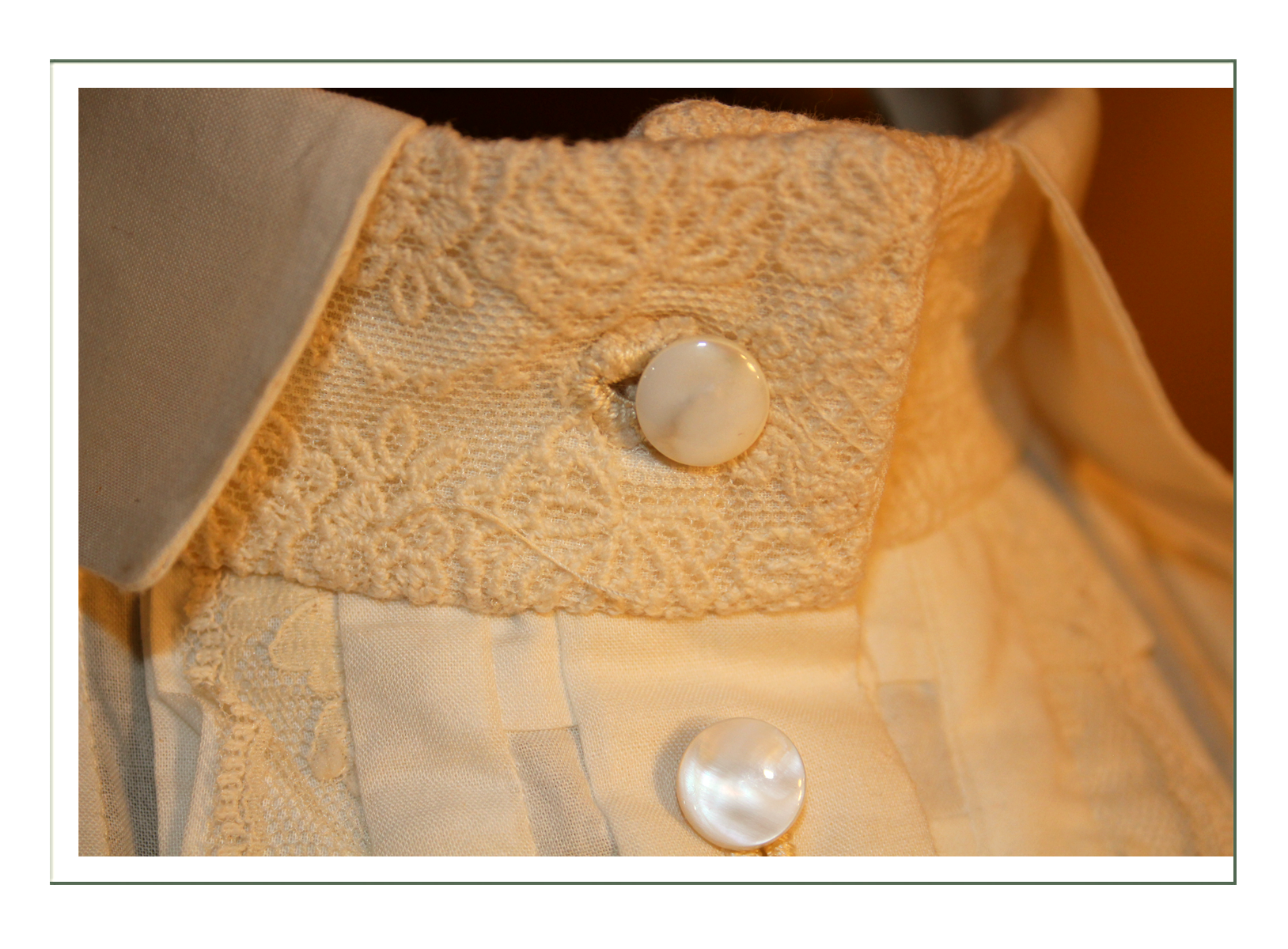
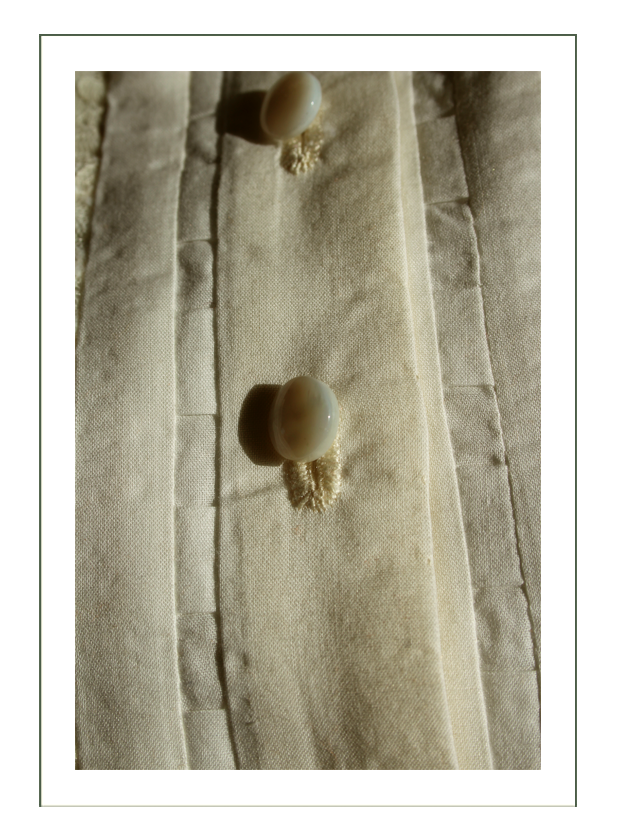
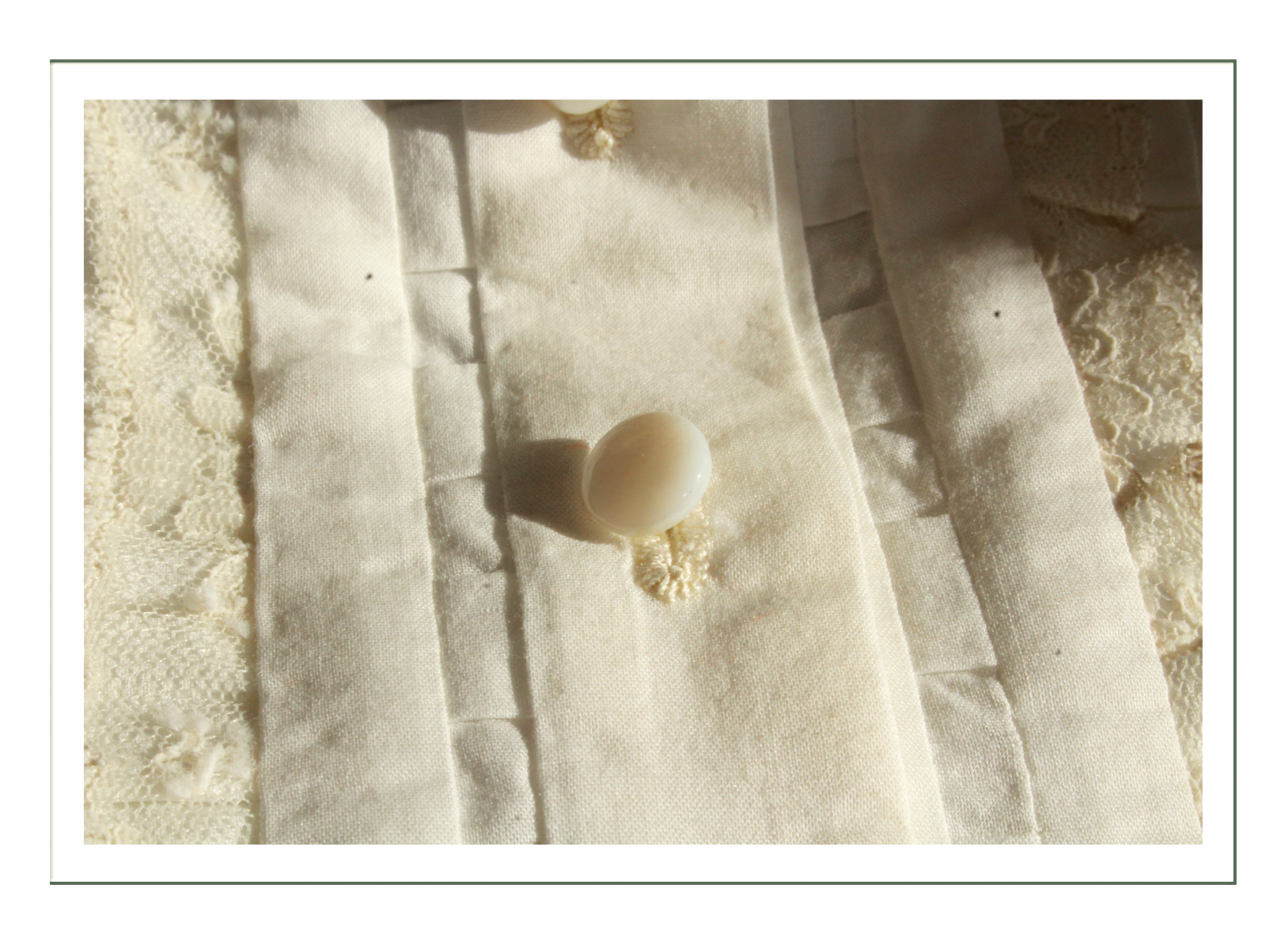
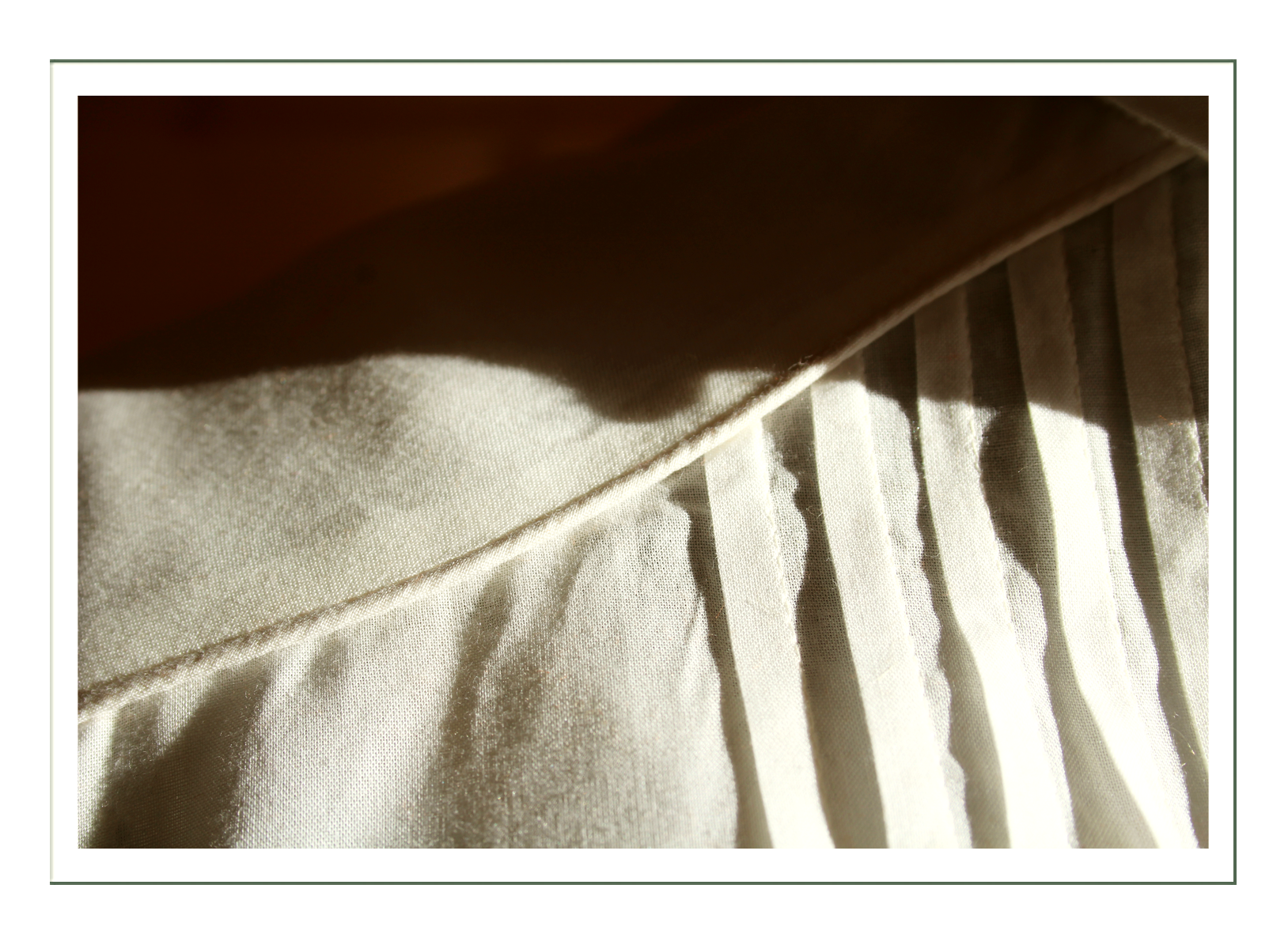
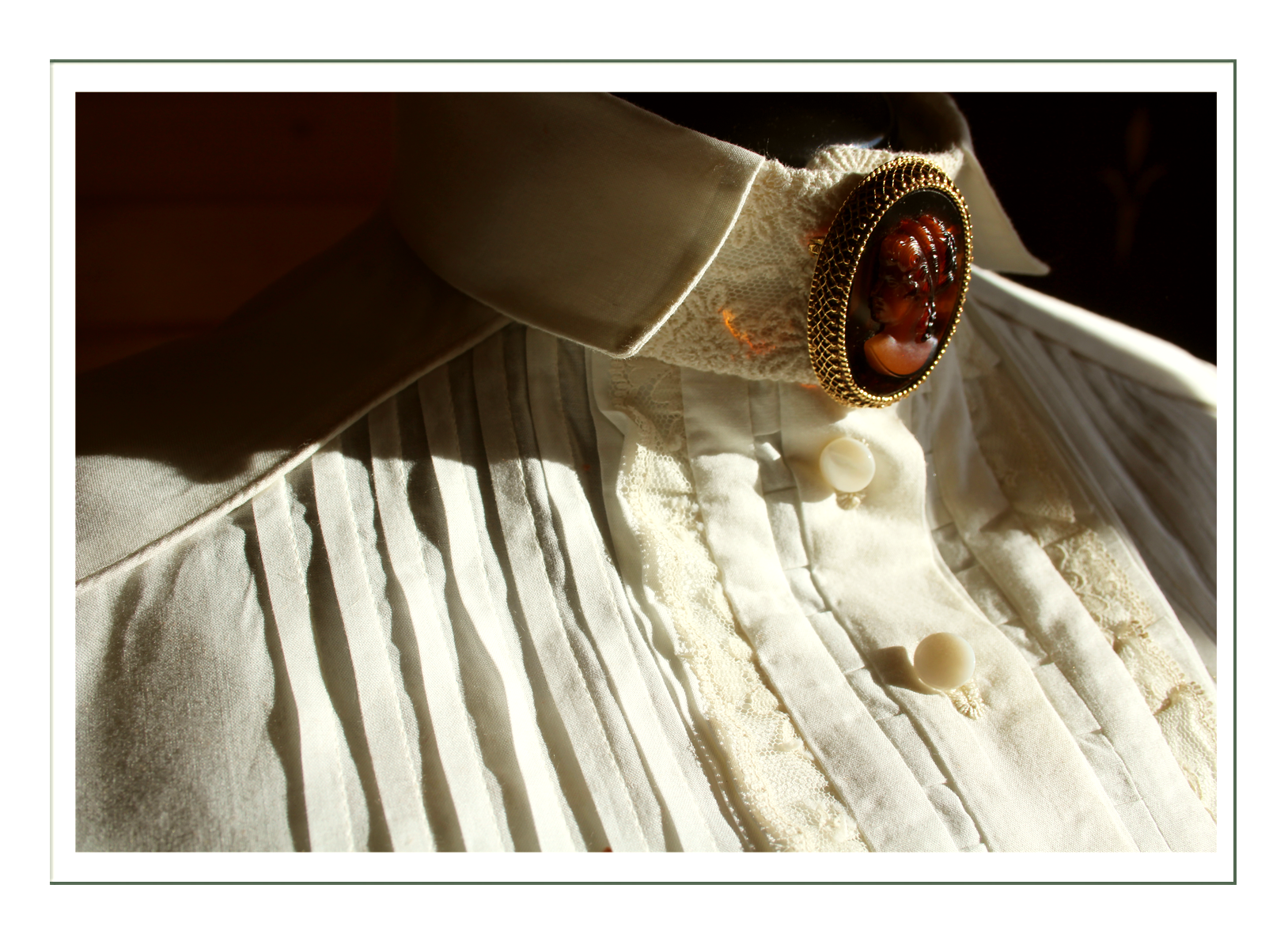
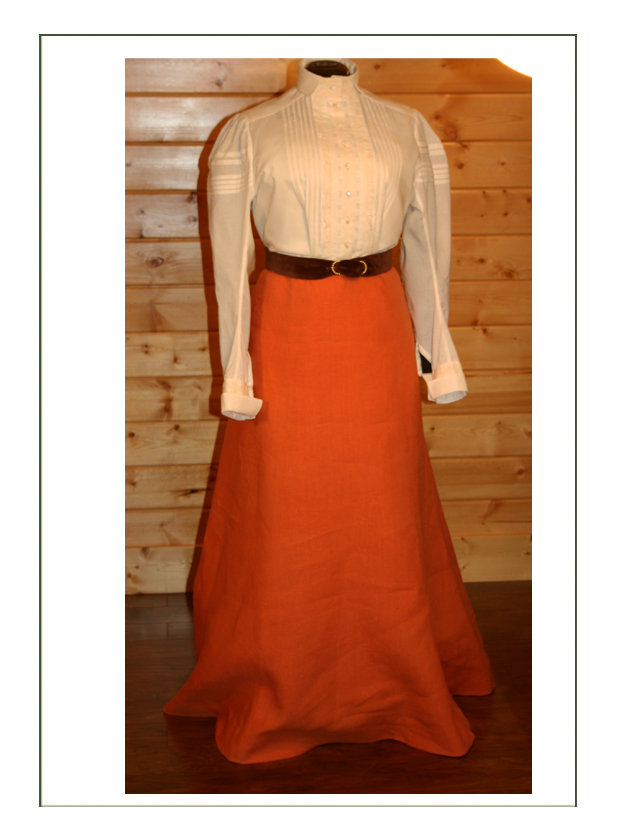

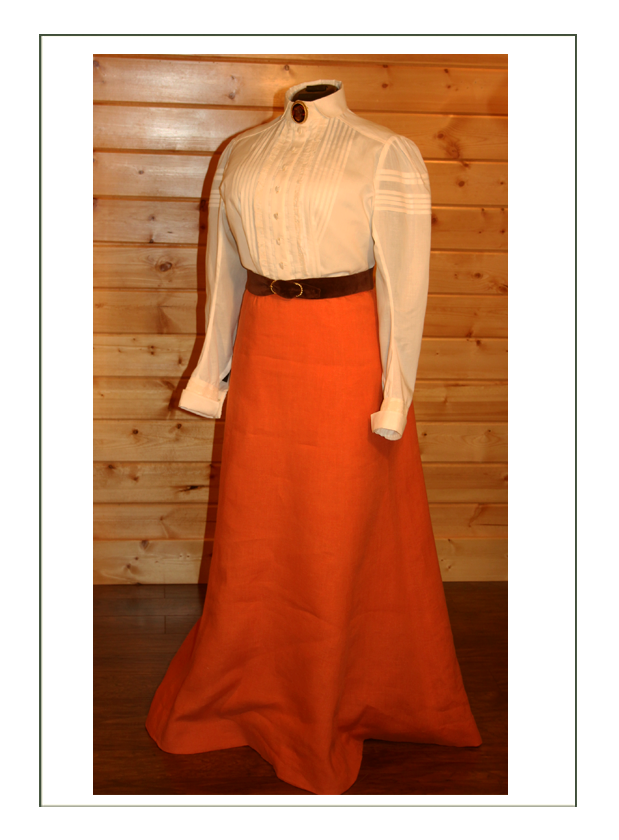
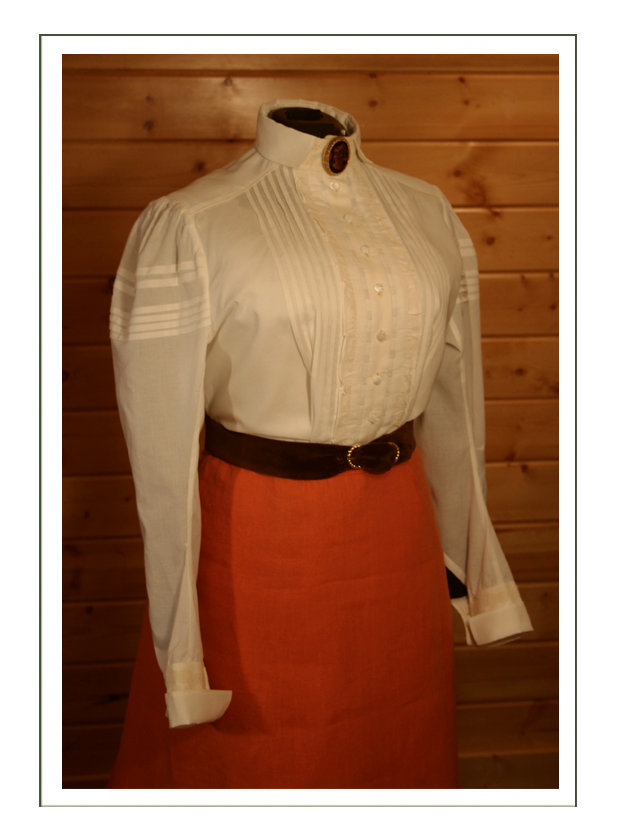
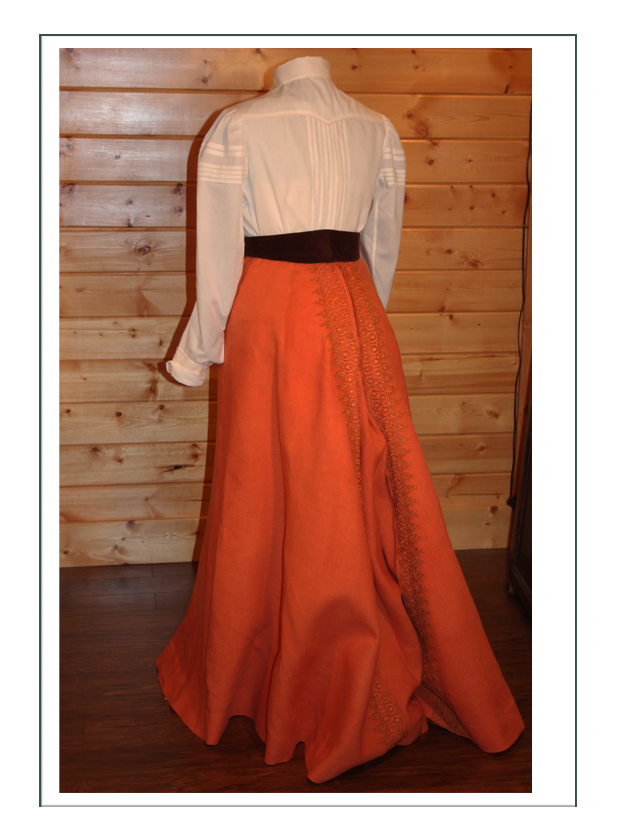
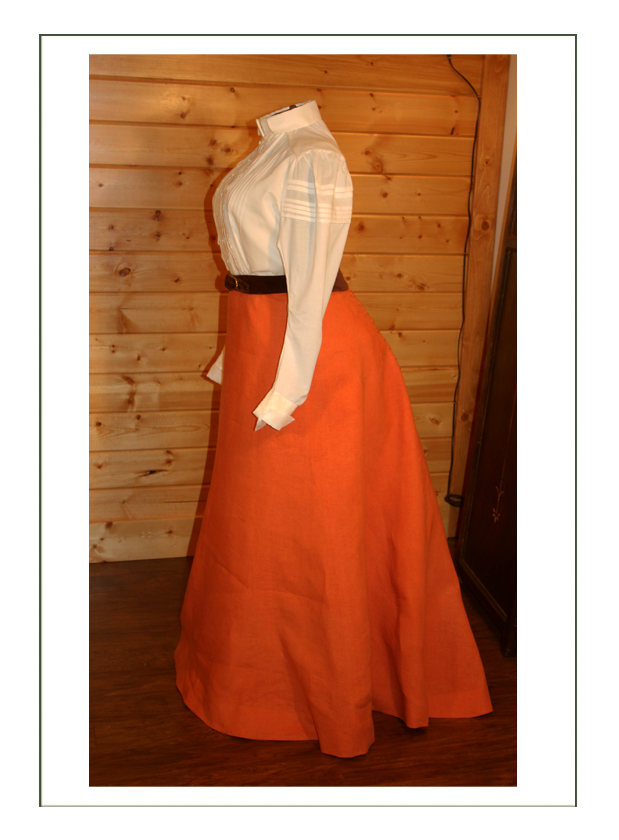
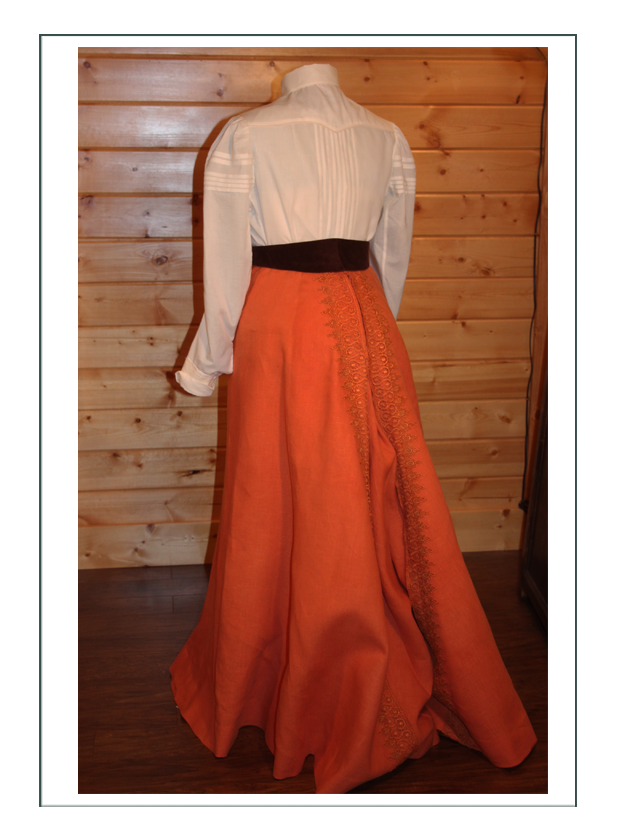
Jacket
Skirt
Skirt Mock up First
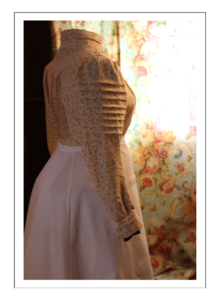
The skirt will be made of reproduction linen in a custom dye lot, so because of the distance and to be certain it fits and drapes correctly, we designed and constructed out of plain cotton which drapes similarly.
The objectives were: flat and neat front that shows no lines of the undergarments, pleated and very full back that fits over the petticoat and has similar draping so they move together, lovely back “sweeper” length that will swish back and forth as she walks (not too short and not too long, especially for easy movement at school), front just tipping over the toes or dragging a bit and to cover the petticoat in front; reveal the petticoat in back.
It also needs the gored lines of the era, with fullness starting just under the knees, as implemented by the petticoat fullness at the same spot. The silhouette should be long and straight in front without restricting movement, with a graceful sweep at the back and sides that will drag somewhat back with the back skirt.
Period correct hook and eye closures are implemented in a unique way to the day. It requires tension from exactly the correct fit through the upper hip and waist area, so this may need adjustment depending on how the corset is laced, but simple change of hooks and eyes should accommodate that (we hope).
The key is length in front; just brushing the shoes. We think we’ve got it!
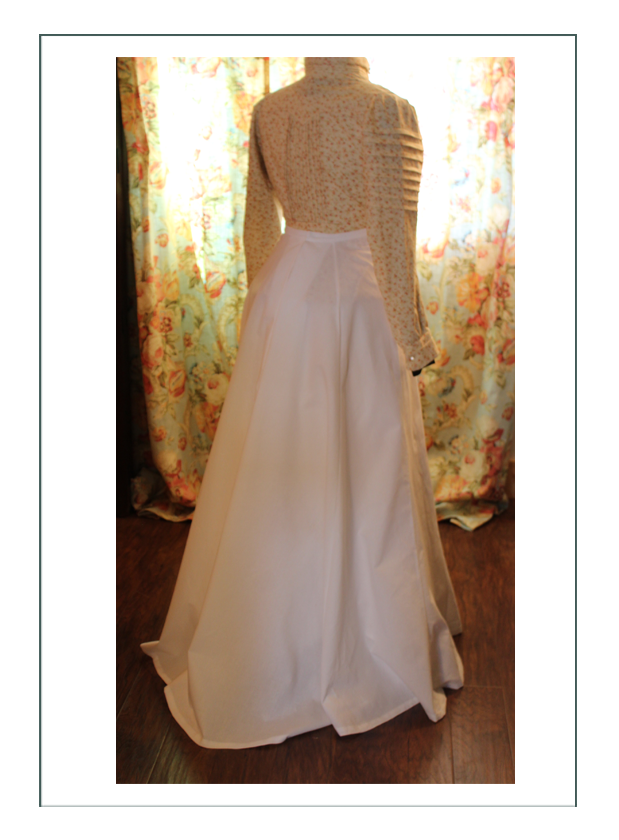
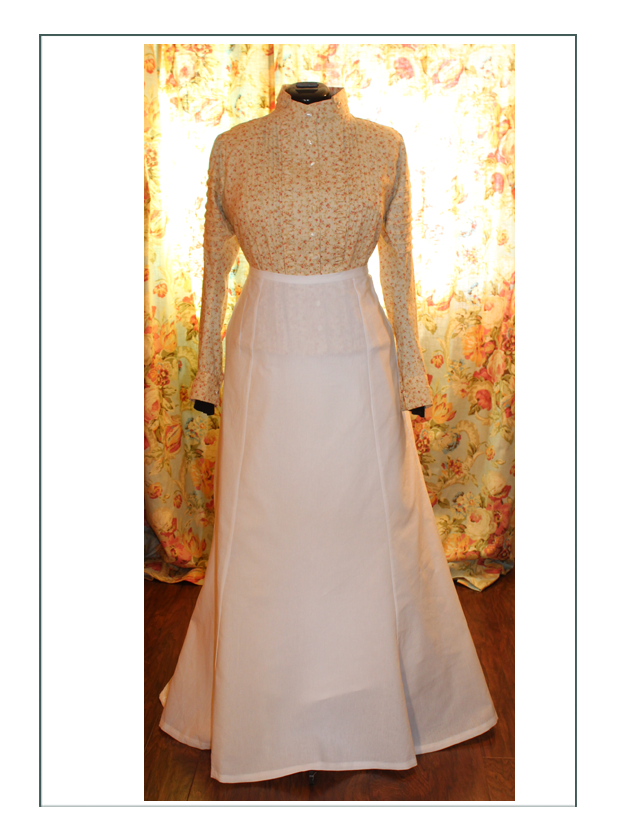
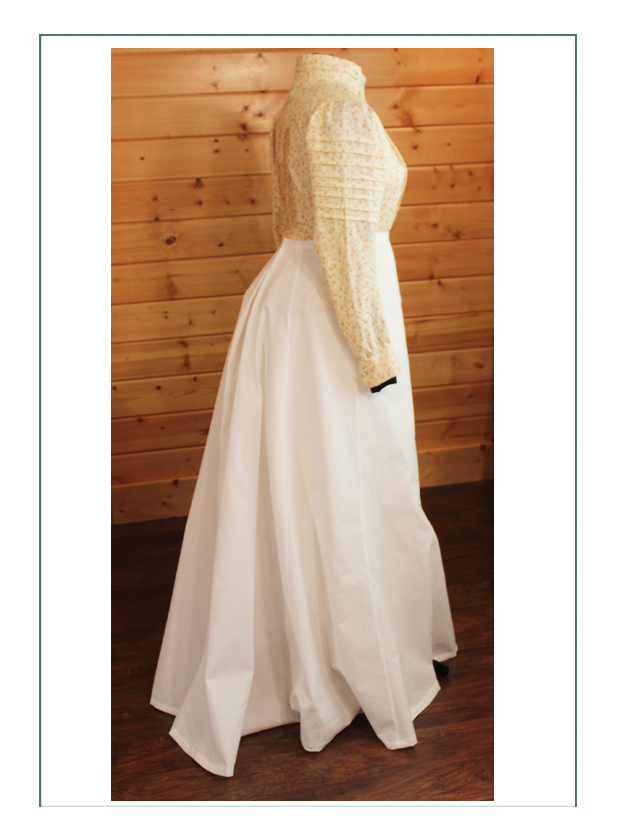
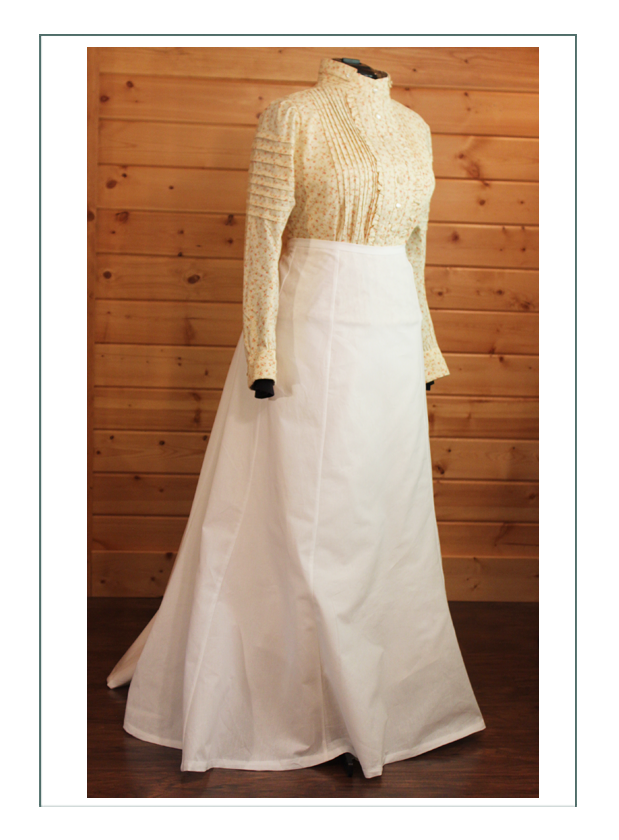
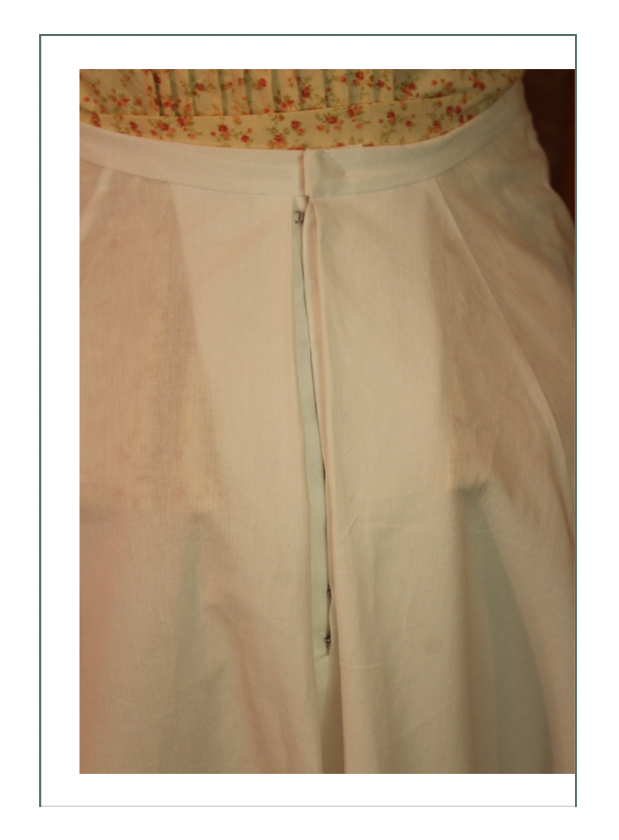
FITTING – November, 2018 in undergarment options with mockup skirt and blousewaist:
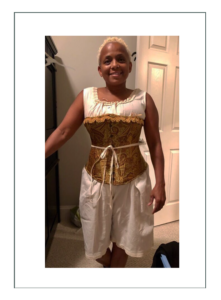
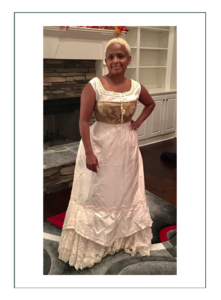
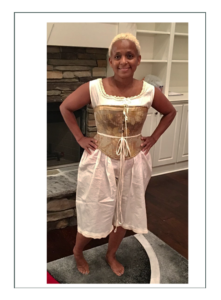

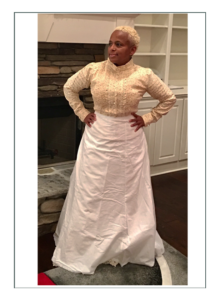
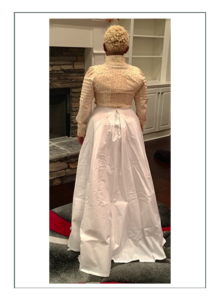
FINISHED SKIRT (with Belt/Sash) including Venetian Lace:
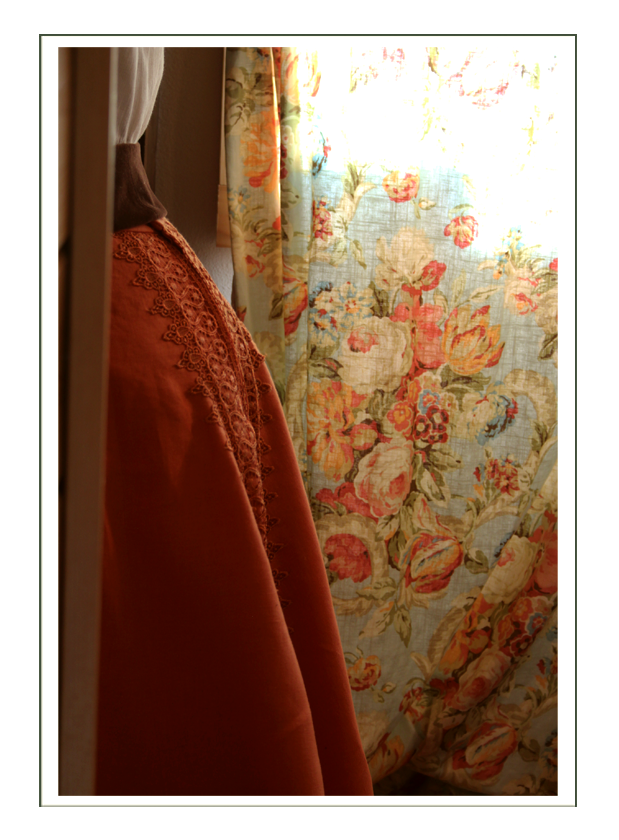
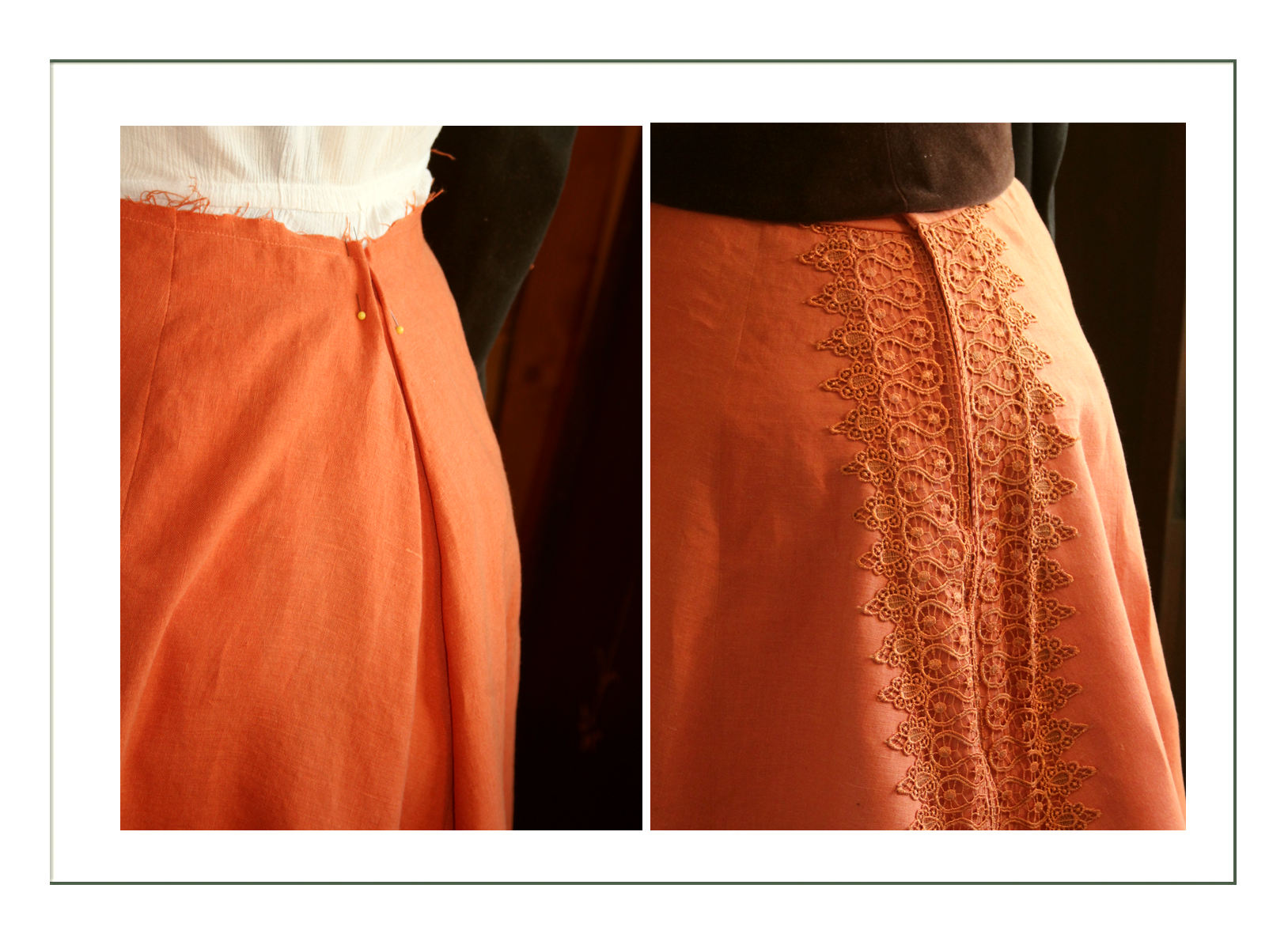
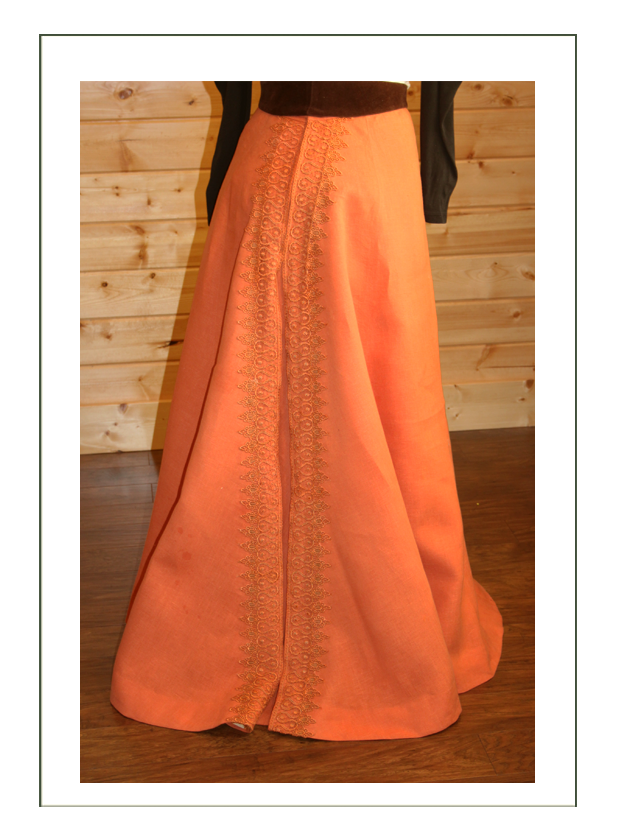
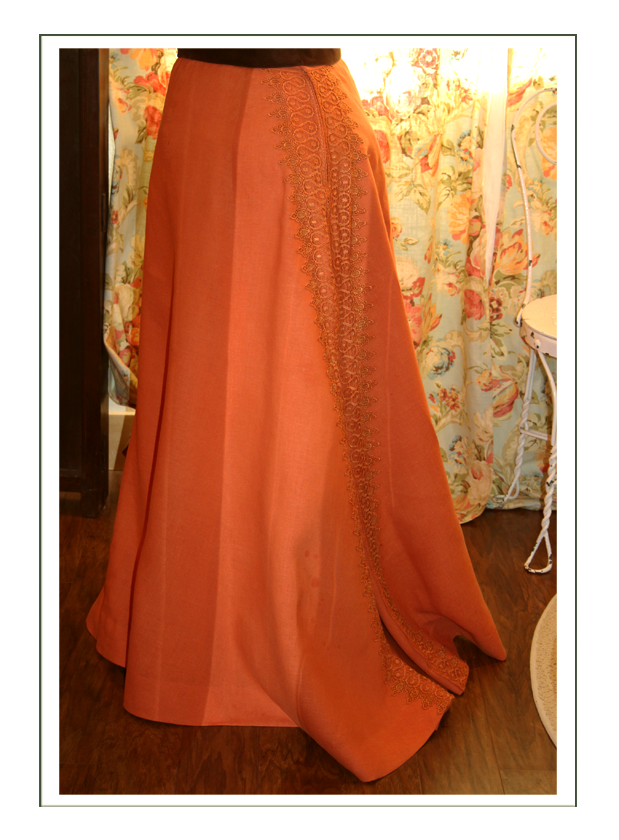
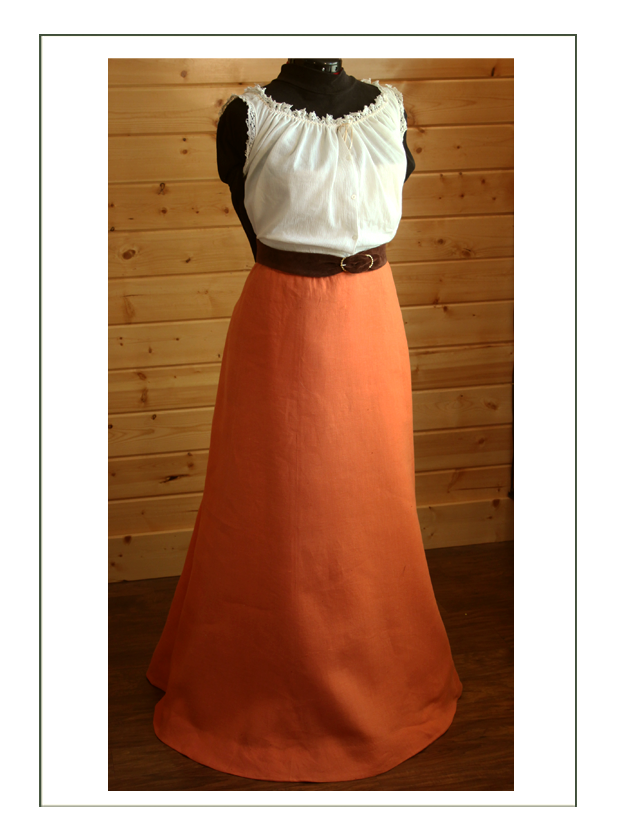
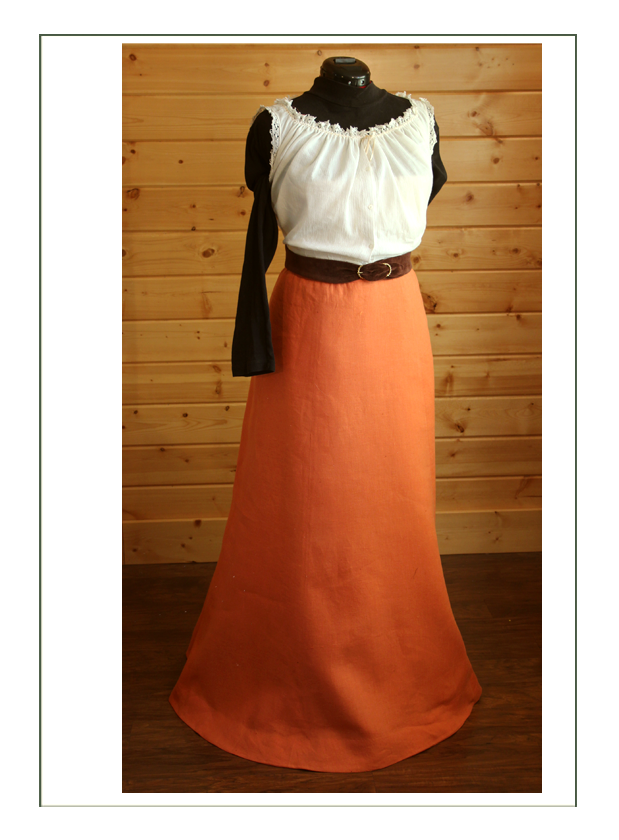
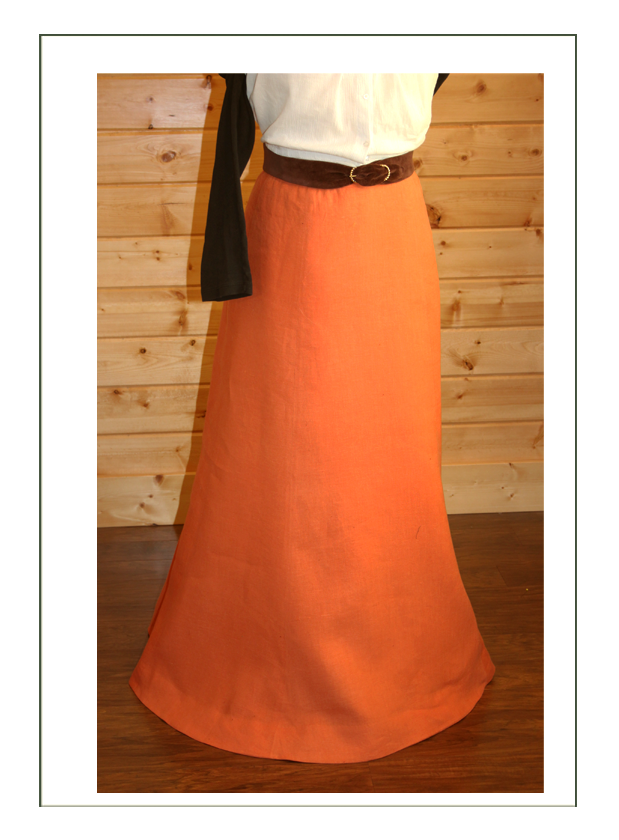
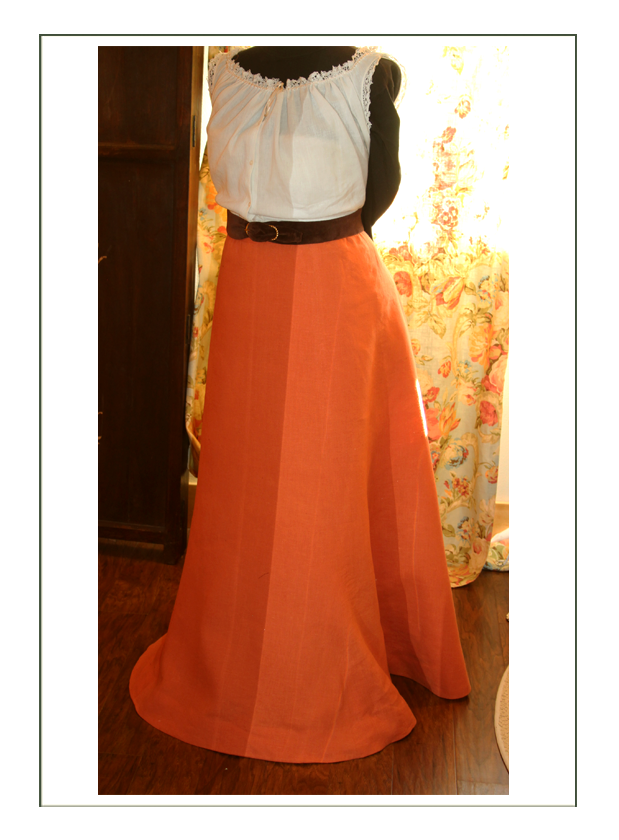
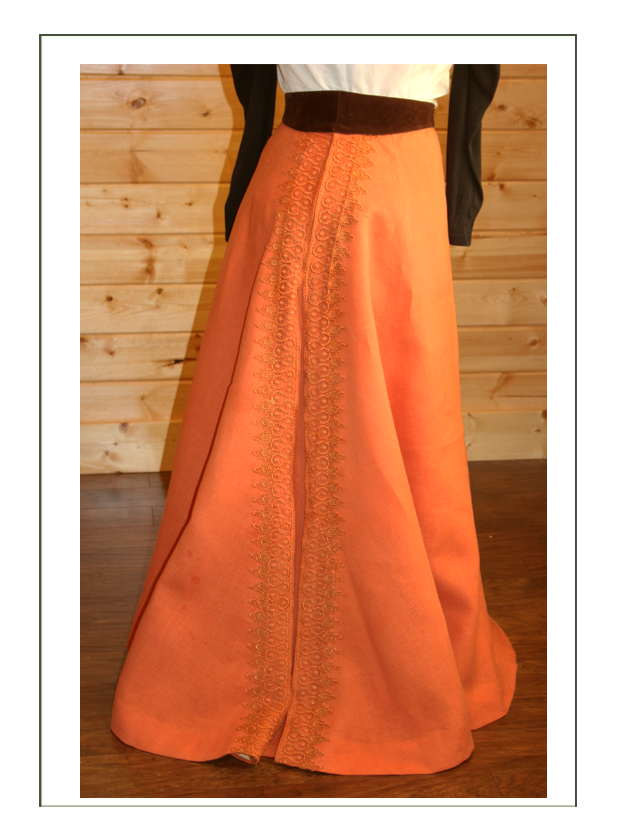
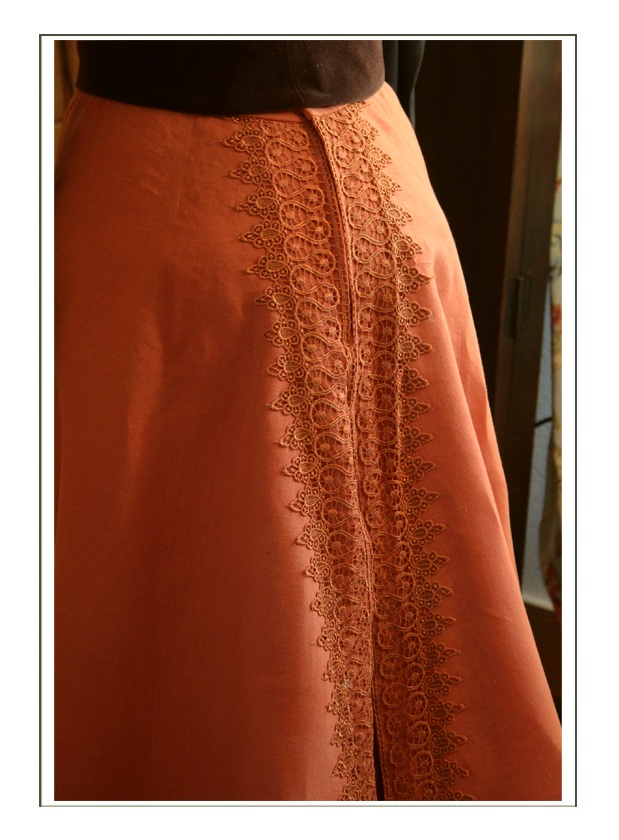
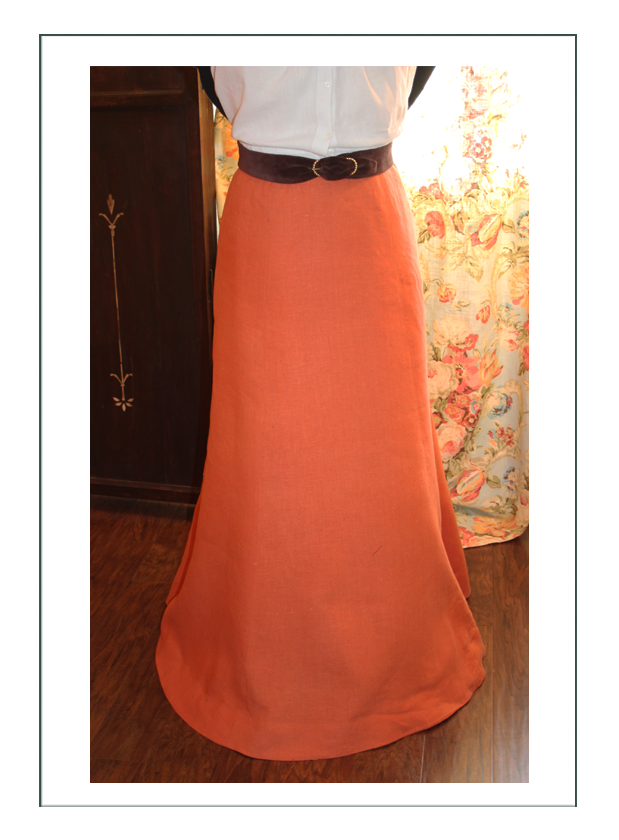 The skirt has a silk taffeta integrated “foundation skirt” which cannot be seen except at the closure at the waist:
The skirt has a silk taffeta integrated “foundation skirt” which cannot be seen except at the closure at the waist: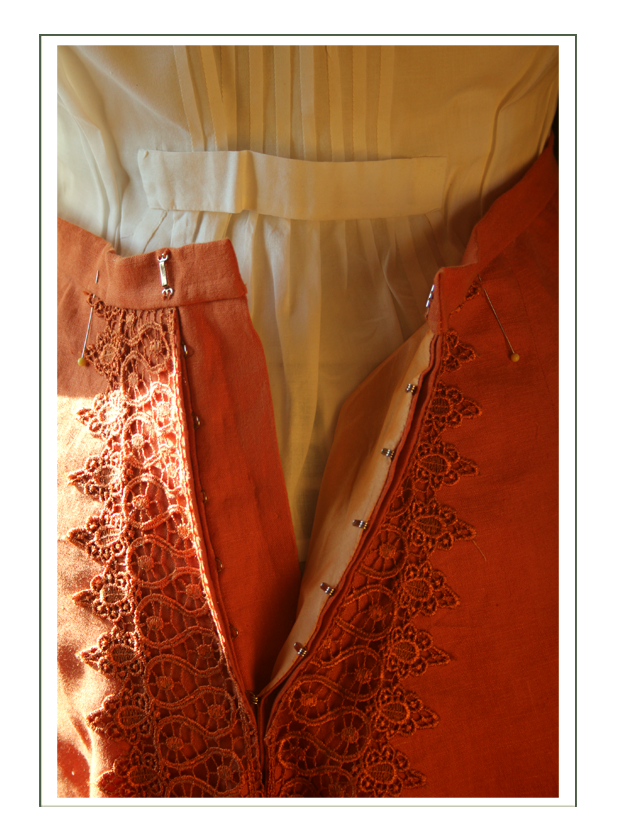
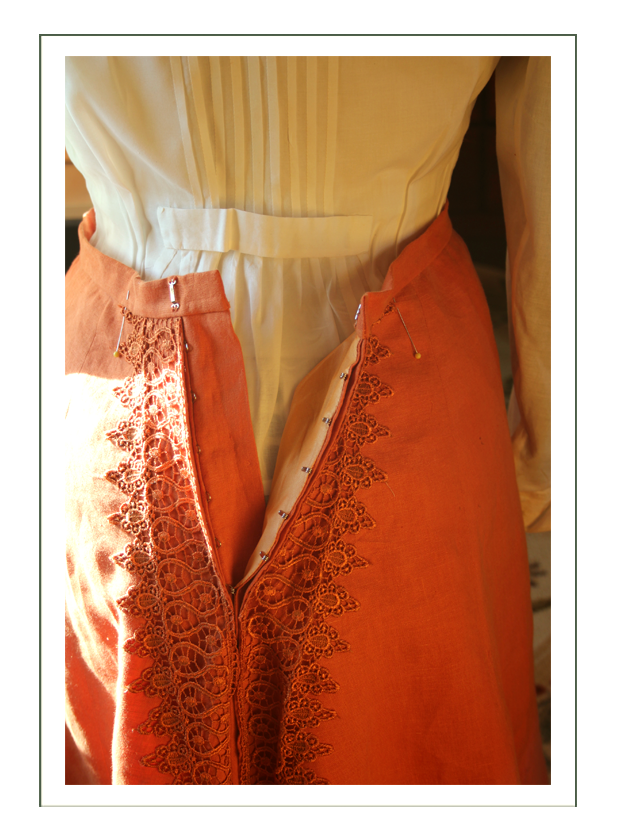
FINISHED Jacket & FULL ENSEMBLE
The last project completed was the final jacket. We are not showing the 3 mockups that were done to achieve the fit from a distance. This ended up being the most challenging of all. The combination of working with linen which would spot when used with water, but wouldn’t press unless used with steam, combined with a stiff silk taffeta lining that raveled, and a heavy cotton velveteen that shredded, and the synthetic Venetian braid was a very difficult use of fabrics.
It was entirely authentic, including the experience.
Each of the blousewaist, skirt, and jacket took about 70 hours in construction. Most of that was figuring things out. Patterns from this era do not give instructions nor marks on pattern pieces, IF they give pattern pieces at all. The few patterns we could base this on (it is entirely original, so it is only based on extant garments, photos, and patterns from the era), were built with revers – meaning the blousewaist was integrated into the jacket, boned at the back, and highly structured.
Our subjective decision to build an 1898 ensemble with the symmetrical corset, yet move into the Edwardian era meant we were in reality and in concept crossing over two eras – and apparently taking the most difficult of the two eras: the complex and yet tight fit of the Edwardian blousewaist (true Edwardian blousewaists “bloused” a whole lot and then just tucked in – ours had to be custom fit with minimal blousing), and the Victorian fitted bodice with elaborate trim and complex mix of fabrics and notions.
This design in restrospect carries many elements of the 1880’s – something we think Ida B would have done – in the orange and brown scheme, the use of elaborate trim on the jacket plus skirt (Edwardians would have done more lace and less trim for “Dame” of “Gibson”, an less ornament for “Working”).
We think the final product has the PERFECT turn of the century silhouette with the gored skirt, tailored yet somewhat fancy blousewaist that is somewhat tucked, and the jacket that crosses over late Victorian into Edwardian eras – with a personality twist with color, texture, and attitude.
When the hat is added, and especially the high crowned Gibson Girl wig based on African American natural hair – it is an ensemble quite tailored and subdued, but still with a LOT of attitude and confidence.
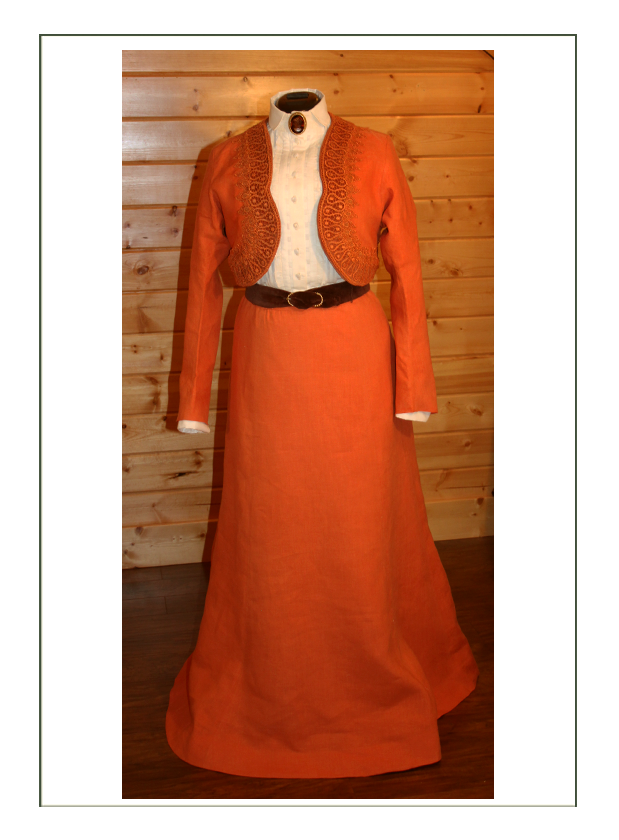
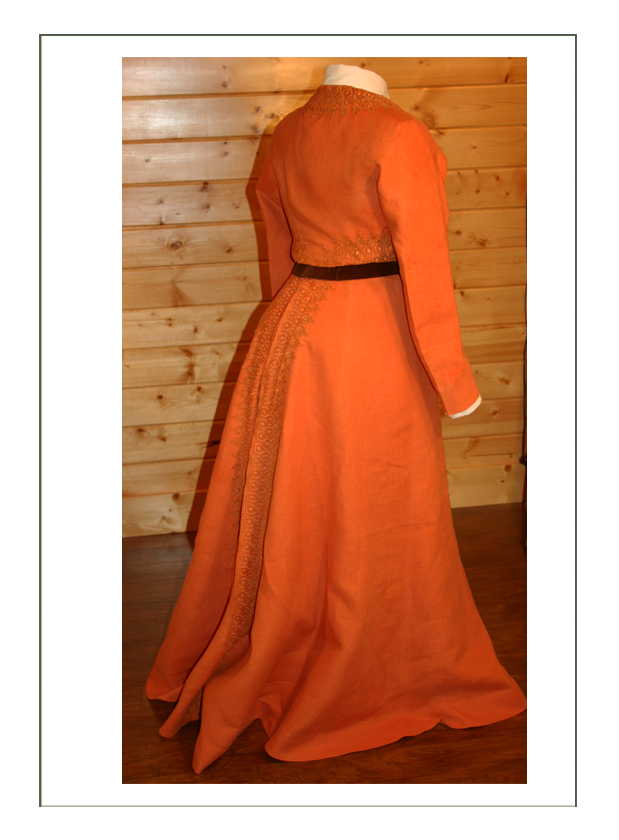
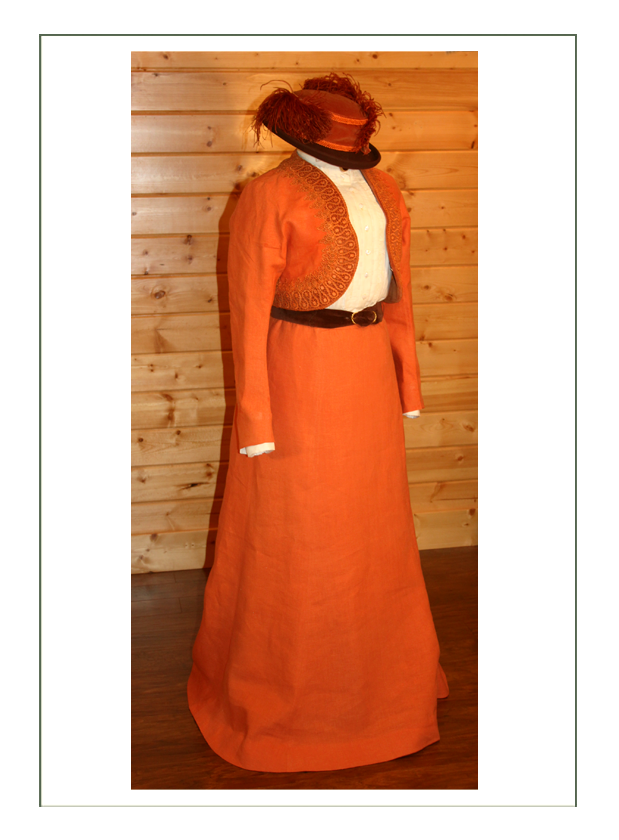
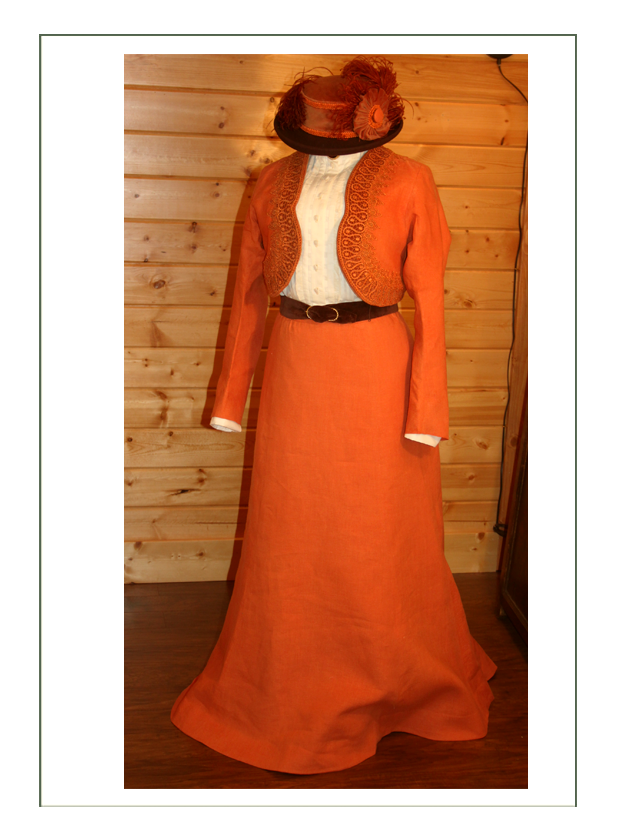
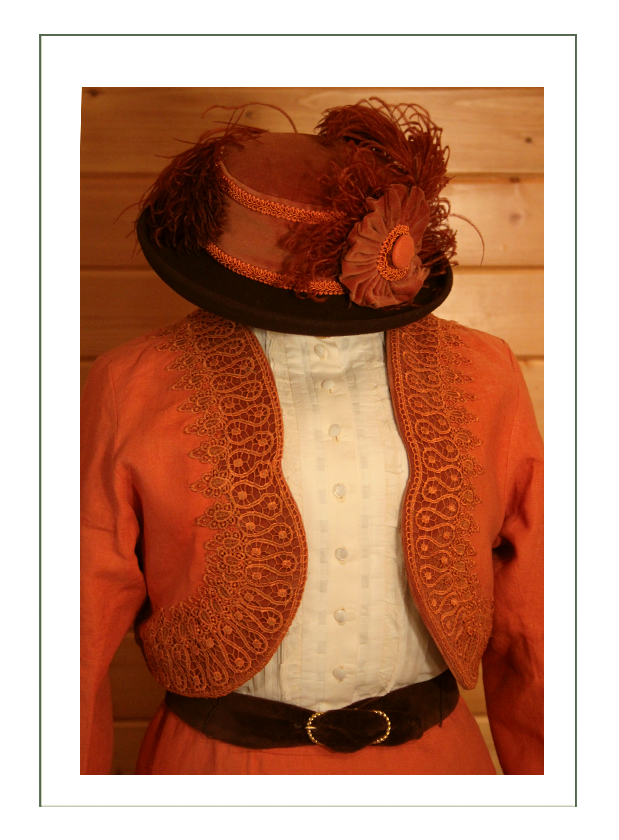
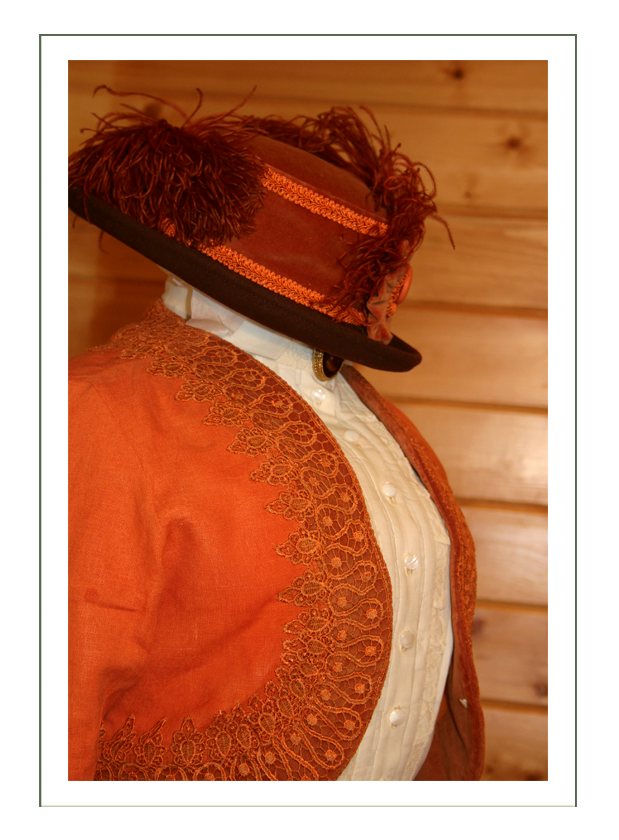
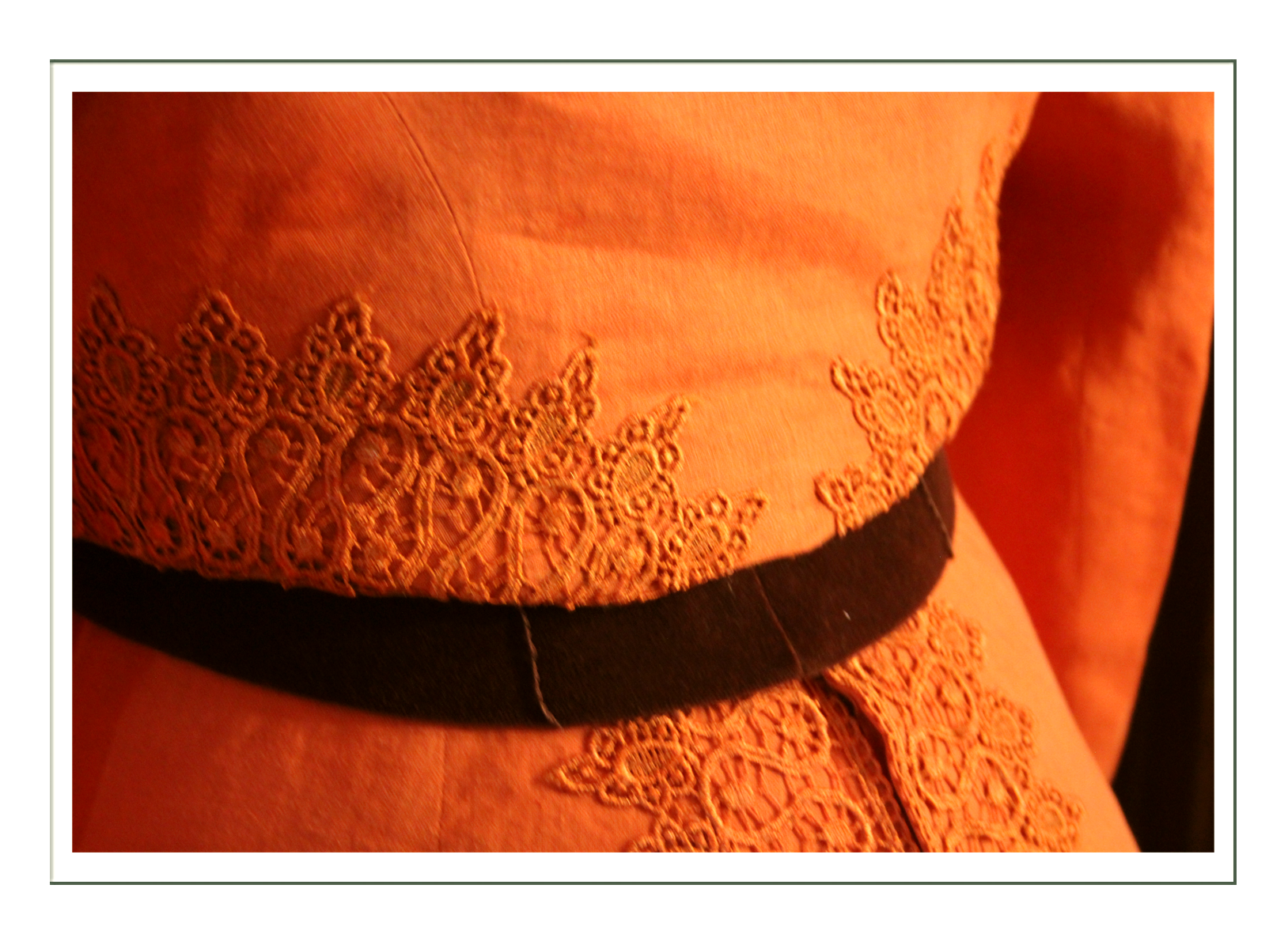
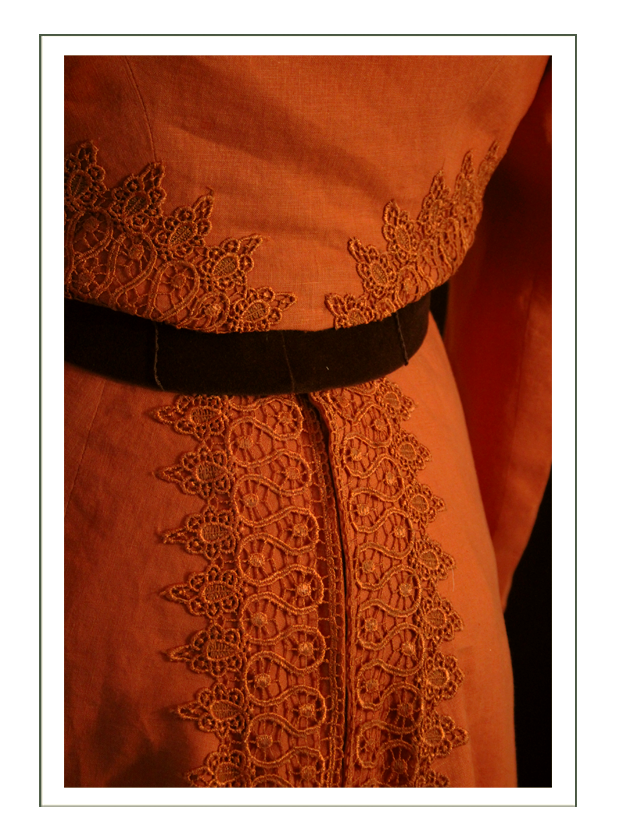
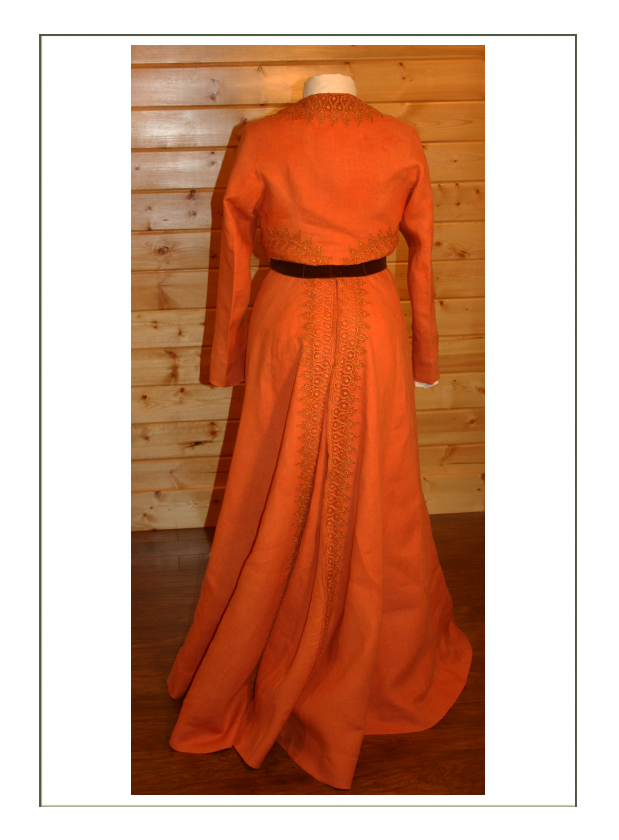
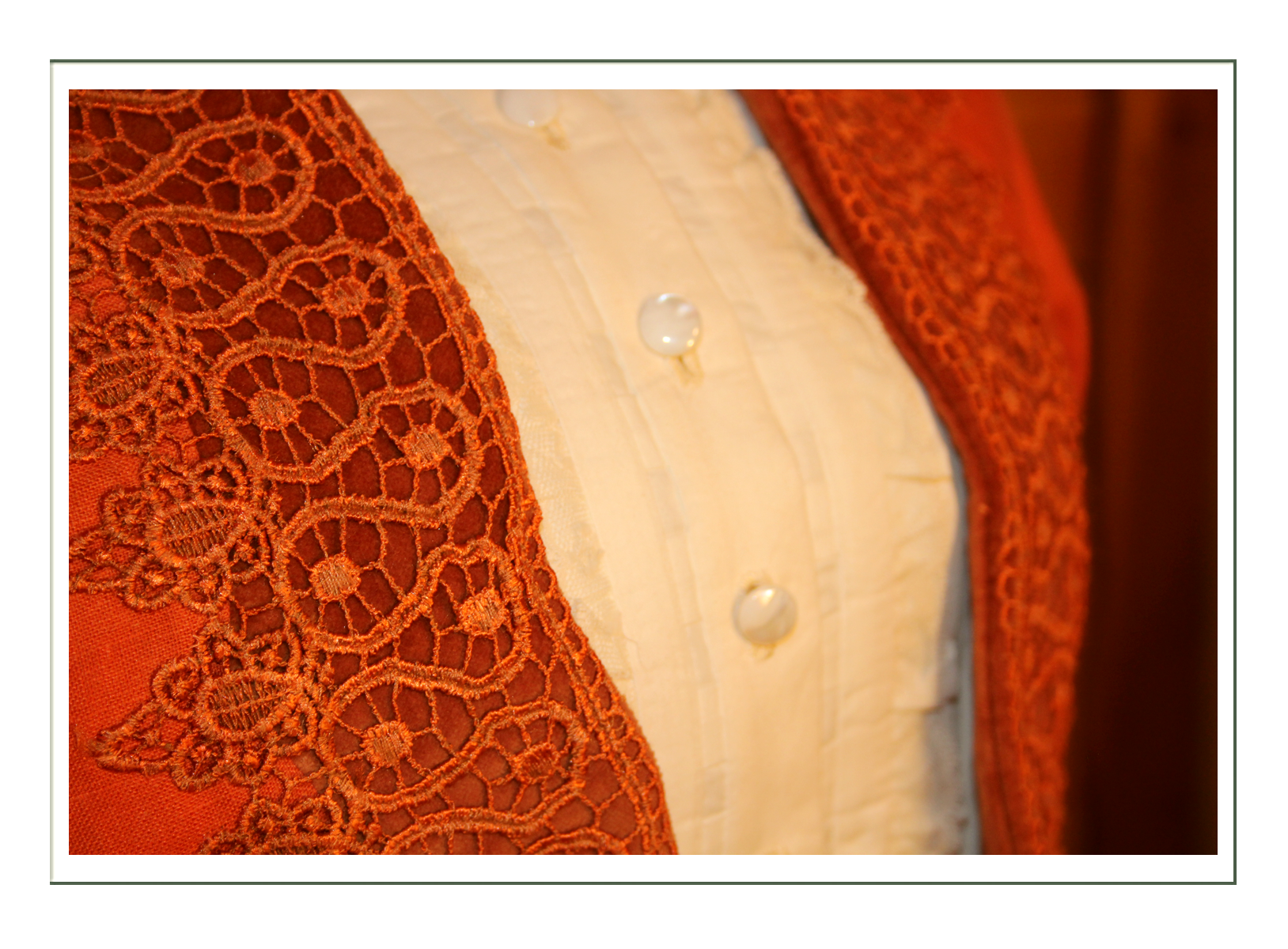
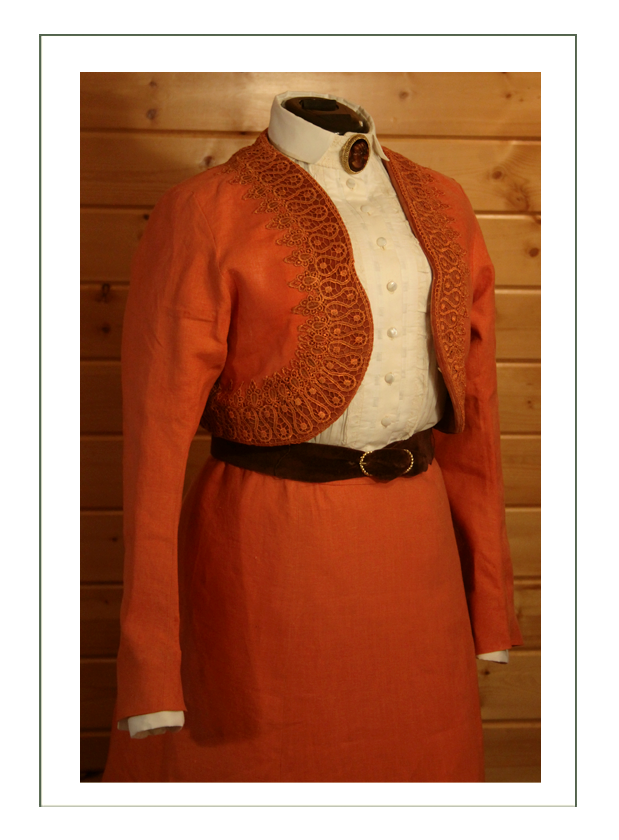
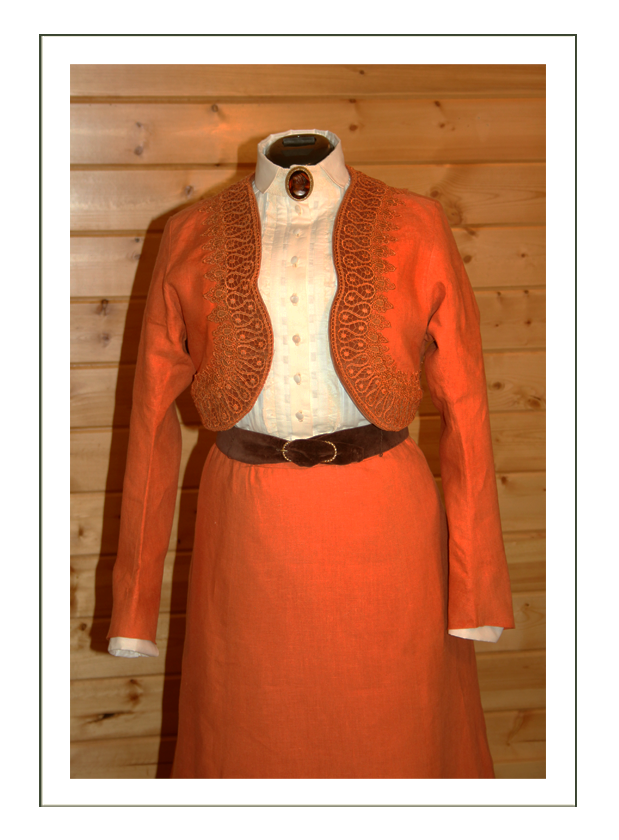

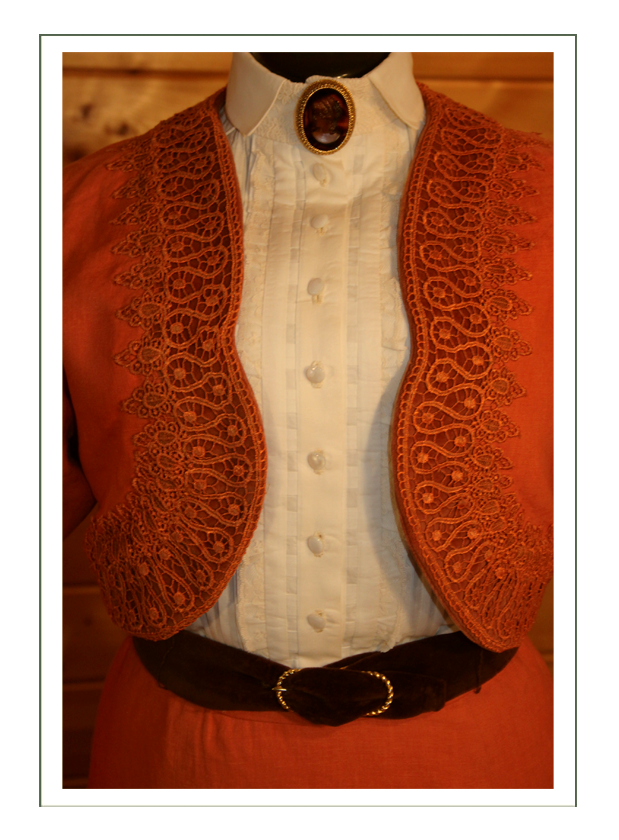
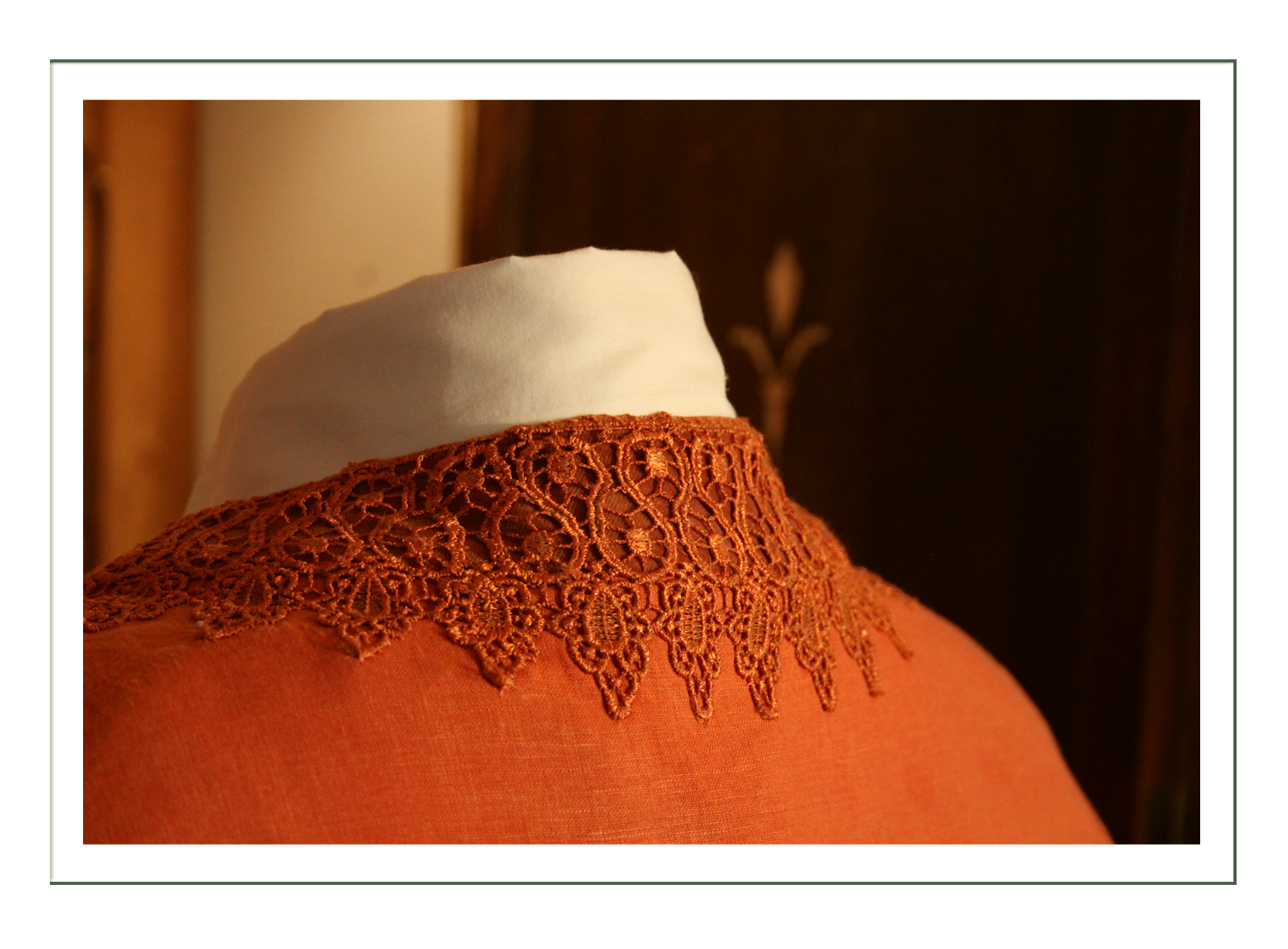
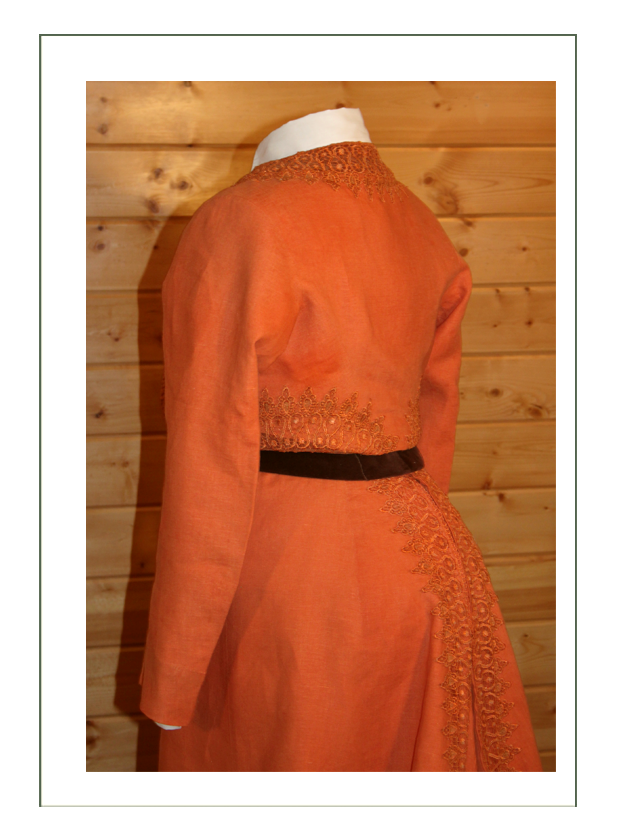
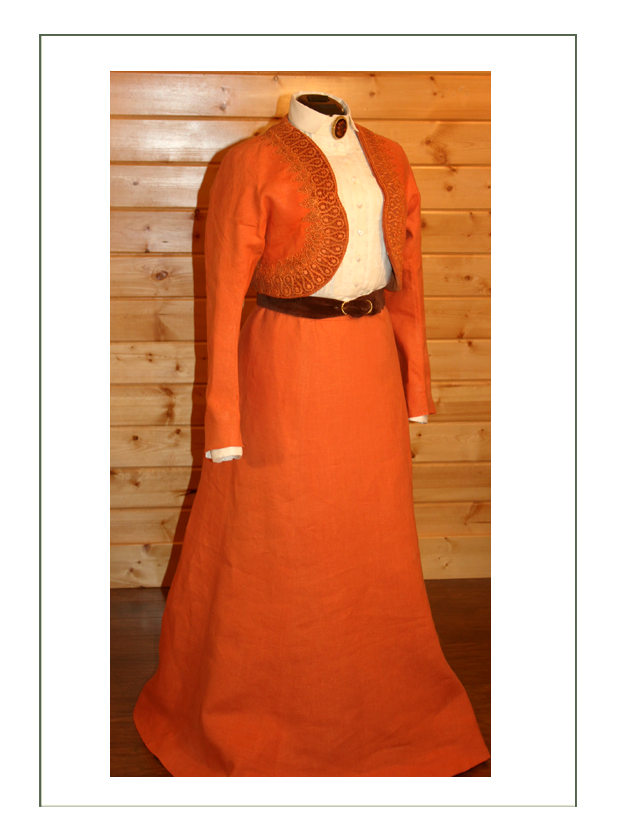
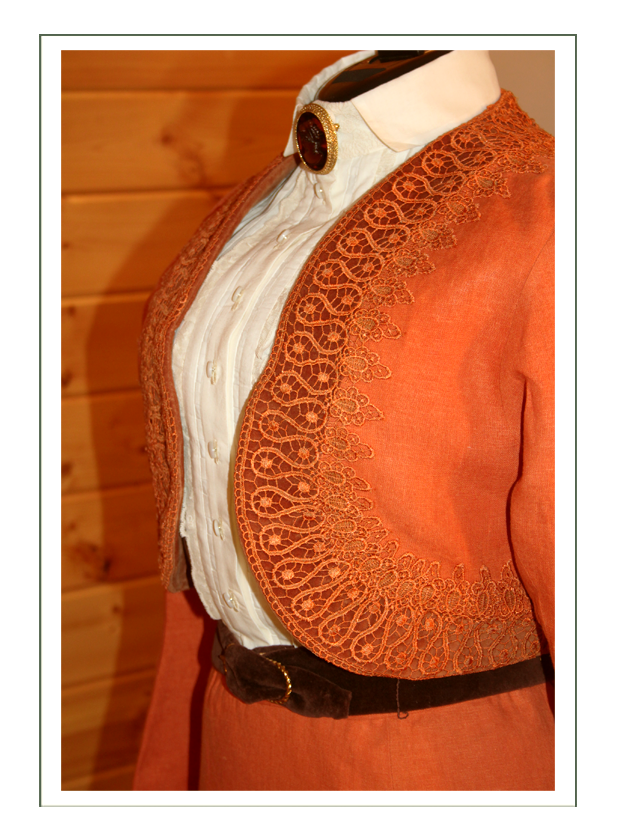

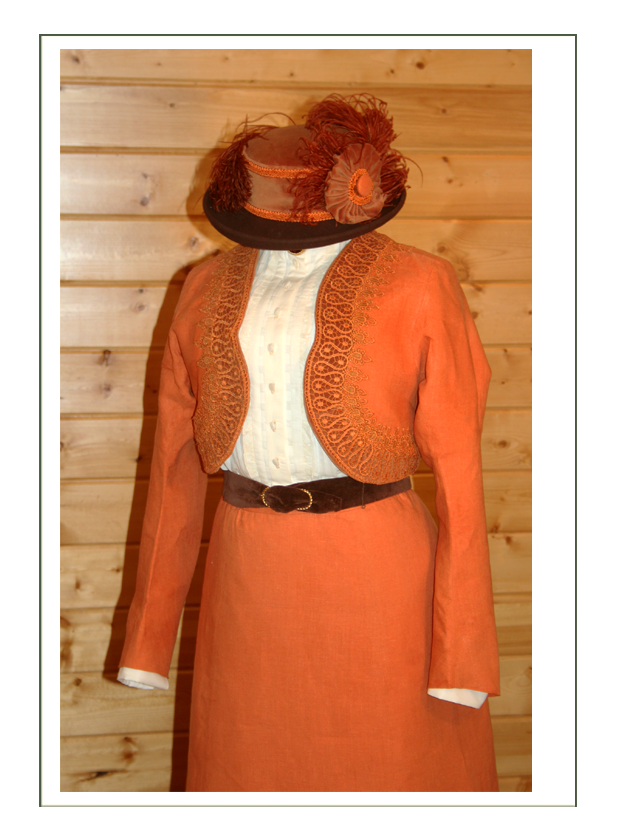
A Challenge at the Finish!
The Vest Chain
When we got to this point draping on the dressmaking dummy, we realized that unless Dr. Anderson is a lot flatter in the bust than our initial fitting or photos indicated, the bottom of the jacket would flap outwards and turn inside out. We looked to real women of the past to resolve this (after adjusting the back and side panel designs 4 times to pull the weight back).
Because we don’t really know her shape in her corset, we built in a little trick that royalty did to get that perfect fit on their end of the century short bolero jackets like ours. Eno, Queen of Spain (and Queen Victoria’s granddaughter), in 1900 hides a little chain, like a watch chain (and maybe she has a watch!) under her inner vest and below the bust to keep that bolero bottom exactly in space.
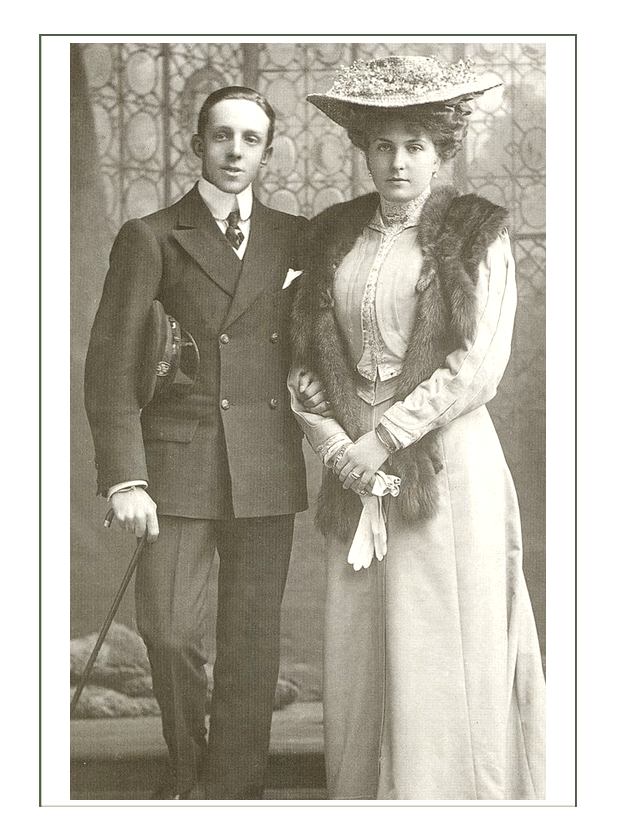
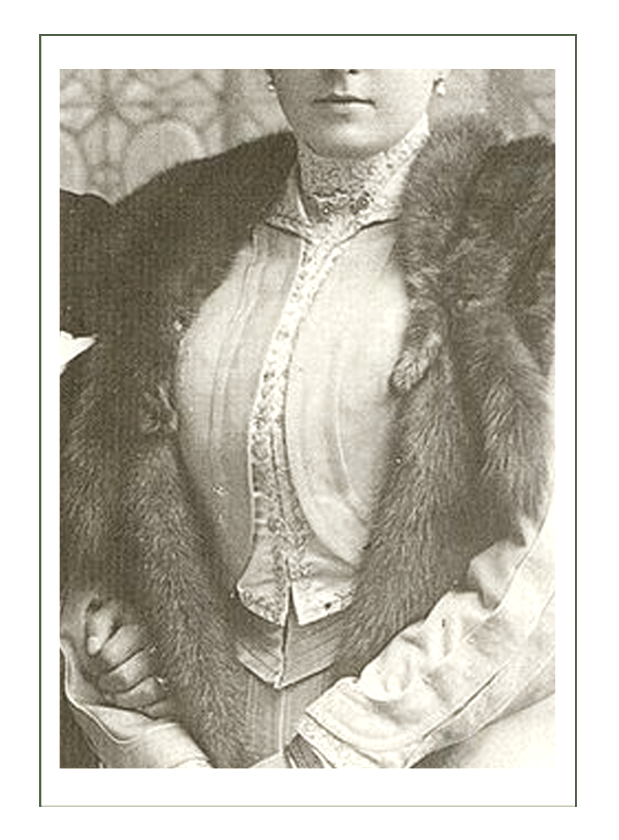
We designed the same from simple jeweler’s components, and used necklace hooks that went around two mother of pearl shank buttons on either side of the jacket – hidden away.
It ended up being the PERFECT item to complete the ensemble!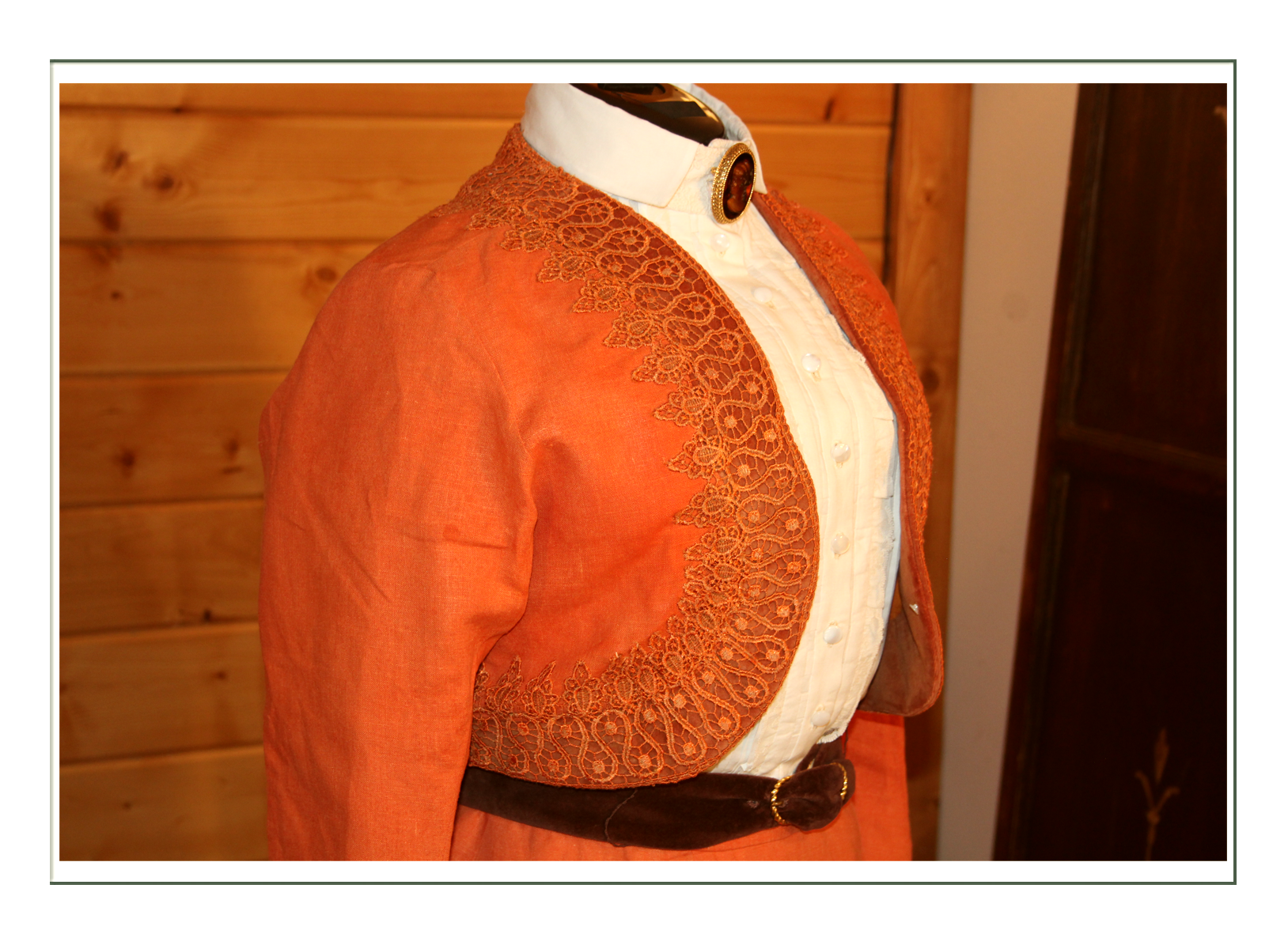
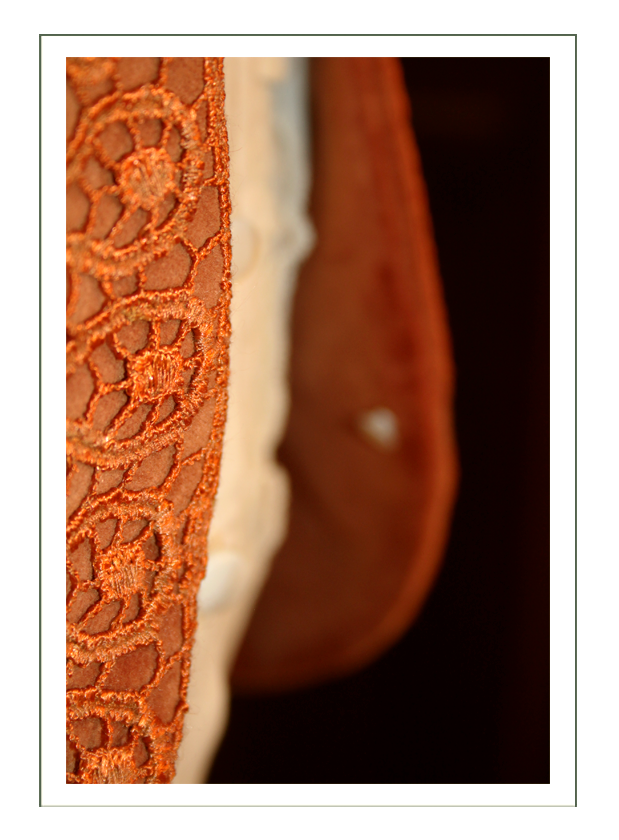

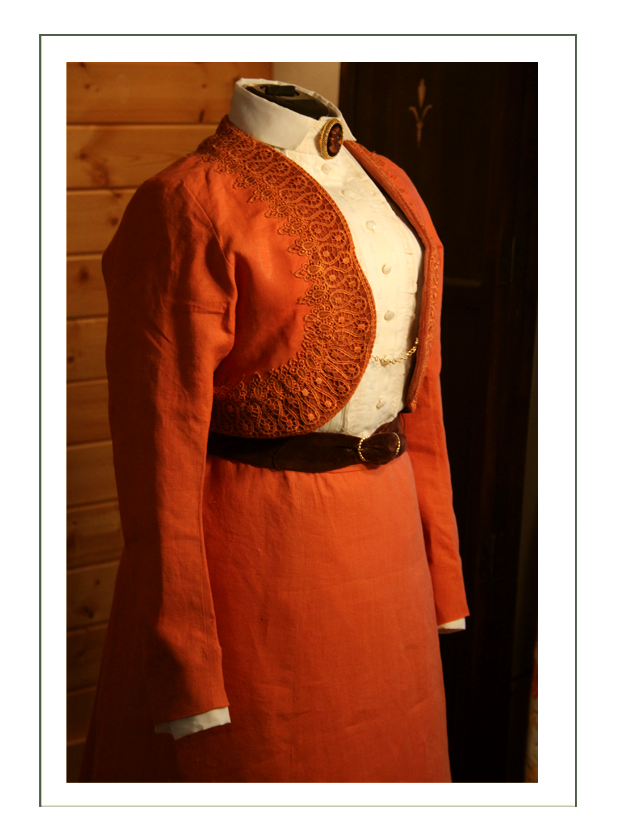
Special Details – Silk Taffeta Linings & Foundation (underskirt)
!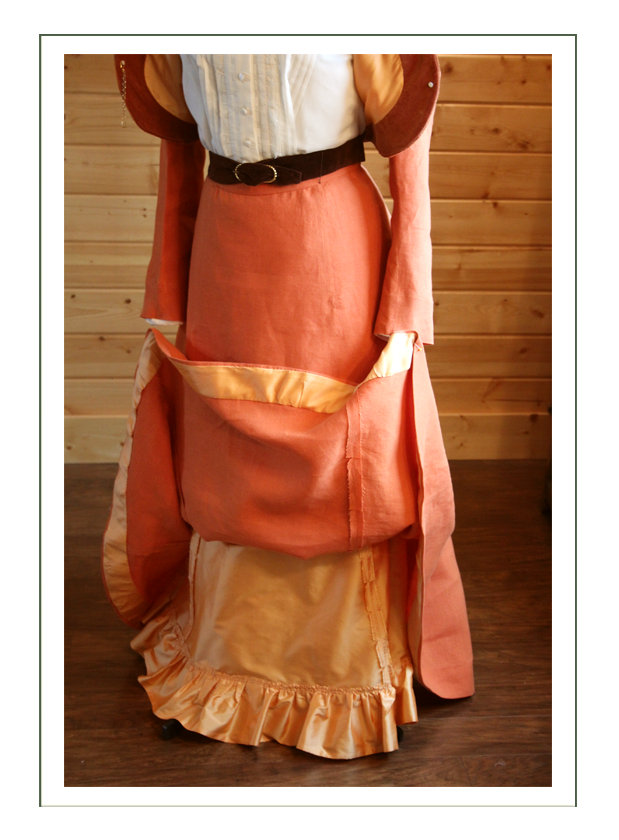
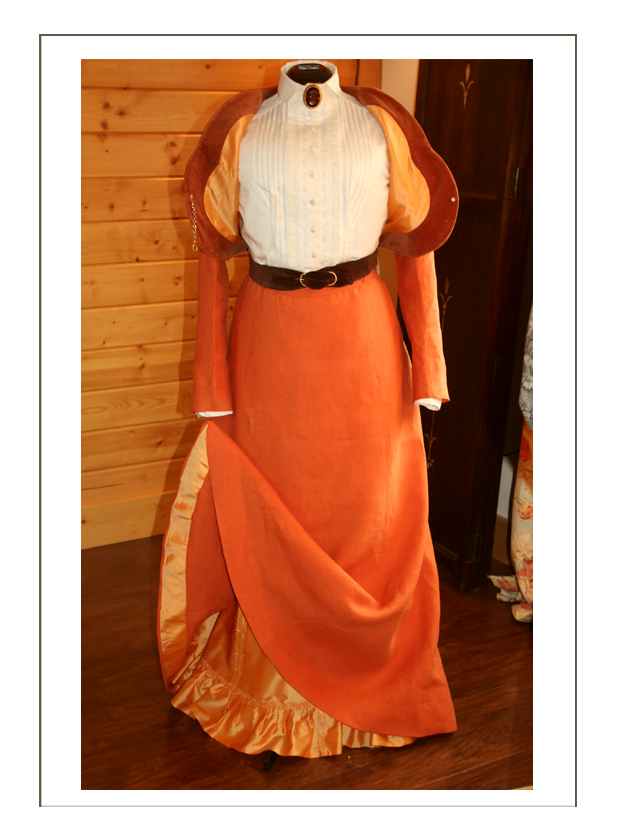
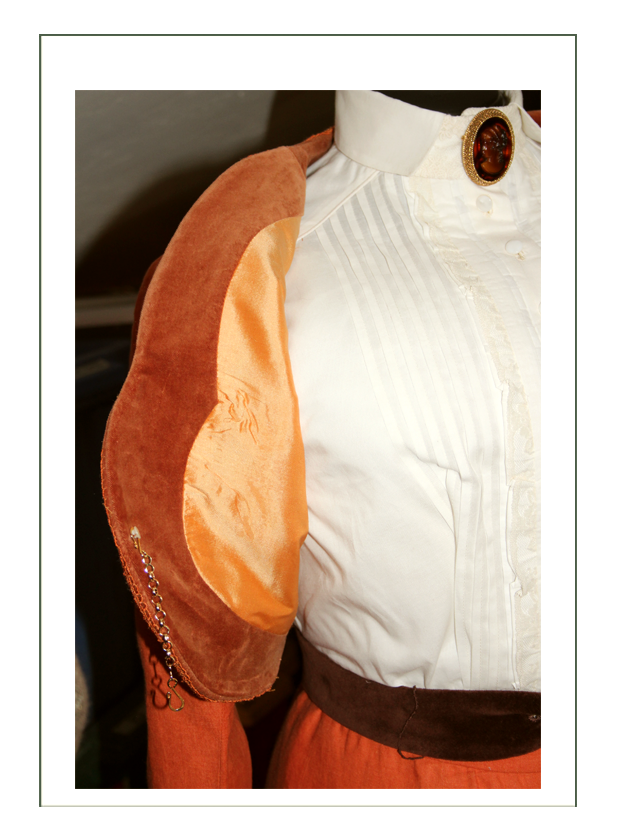
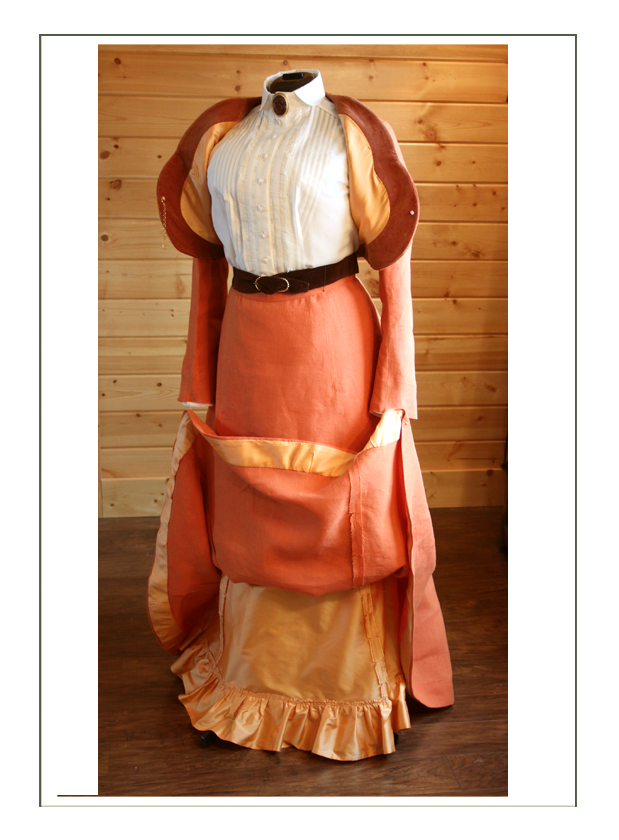
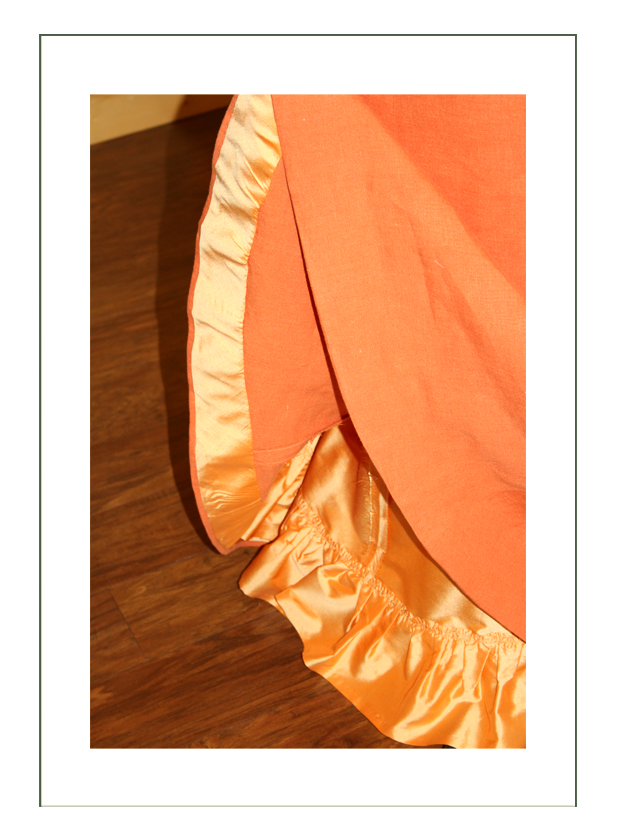
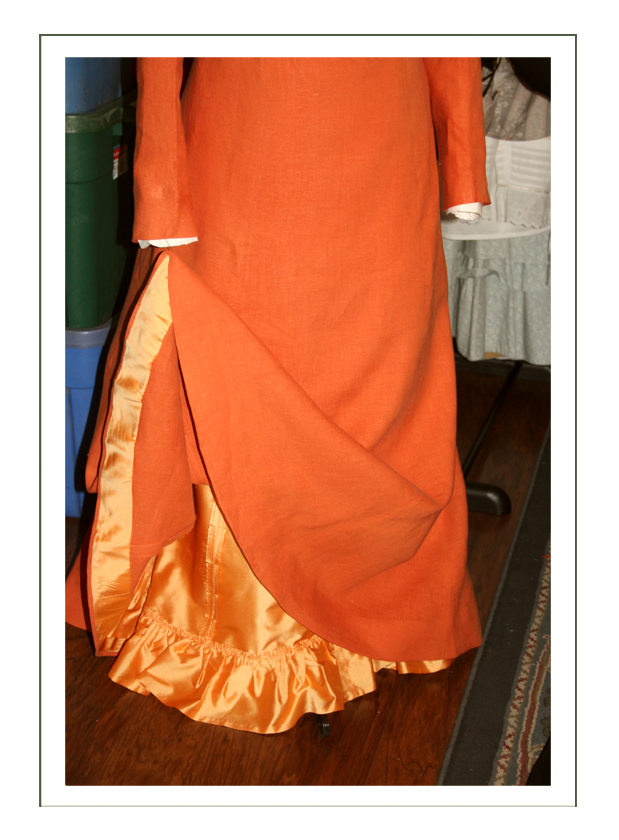
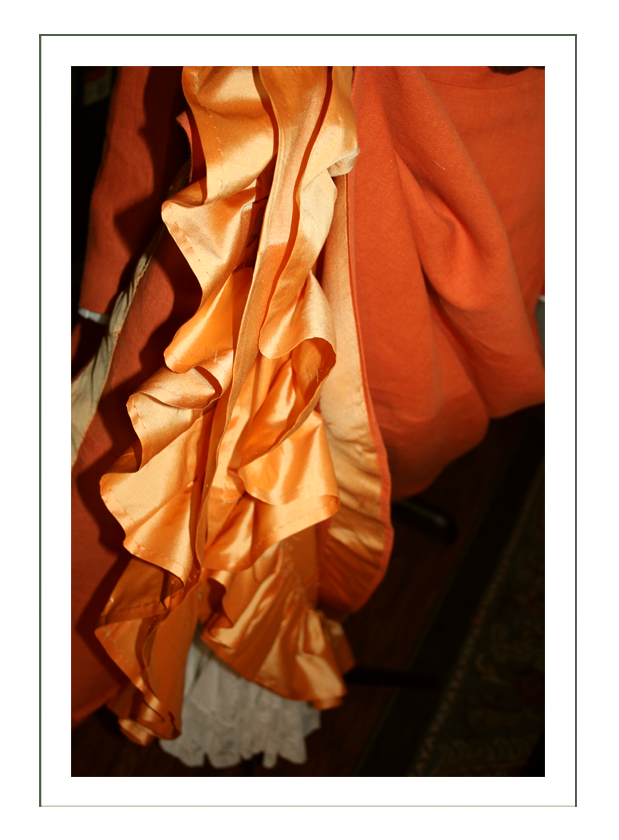

Corset 1
Paisley silk brocade with silk Shantung lining
This is built with an inner core of white couteil fabric with the decorative silk fabric overlaid. It has an inner lining of couteil also, and is covered by the shantung. All boning is metal; the back lacing has rigid 1/4″ bones, while the rest is spiral.
The challenge on this project was to get so many bones into such a small body. It took a lot of strong finger work, reminding us why corsetry used to be a “male only” business until machines could take over the tough stitching.
The boning and gussets (interchangeable term with “gore”, depending on the era and geographic location) were carefully draped to the body and designed to give VERY strong support and lift of the breasts. This should be a very comfortable and durable corset. It has a waist tape so that extremely tight cinching through the middle is possible if Dr. Anderson so desires. It is designed, however, to give a comfort fit and just smoothe the body and lift the breasts.
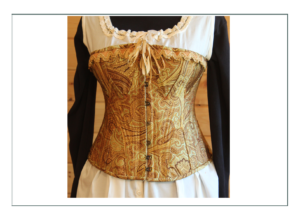
It is actually an 1880’s long corset cut shorter to accommodate the shorter body for modern comfort. Ida B. would have worn the long corset or the newer Edwardian monobosum. This is like Ida wearing her “comfy old corset” before jumping to the new styles. The silk is a little high end for a middle class woman, but by 1898 Ida was fairly well off with her attorney husband and world fame, so we figured she would have splurged on silk.. but then worn it a whole lot to get her money’s worth.
We are not particularly concerned with separating the breasts, as the fashion of the day was actually the low, monobosum (perfect for a mature woman). We figure Ida would have liked her high and perky breasts, but would not care so much if they were lifted and separated. The corset will do as much lift (and hold!) as the customer wishes, but will only somewhat separate. This is intentional.
The other challenge was to find a busk that fit the short body and was strong enough. Dr. Anderson’s length dictated an “in between” size, so as they did in history, we improvised by adding closure hooks at the bottom front. This allows her more comfort sitting if need be also. The hooks are necessary because we are aiming for a flat front and full back for 1898. Her corset covers and other undergarments will build on this “fluff in back; flat in front” concept.
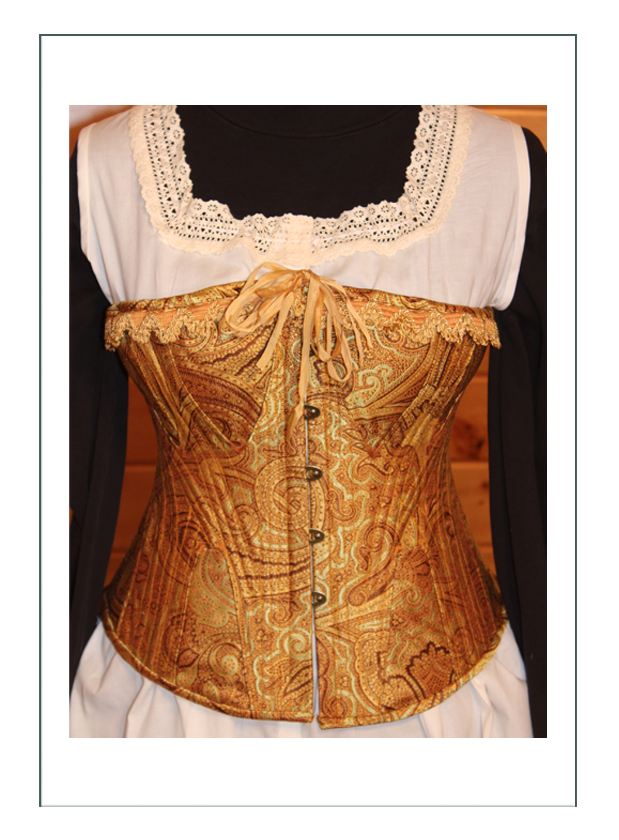
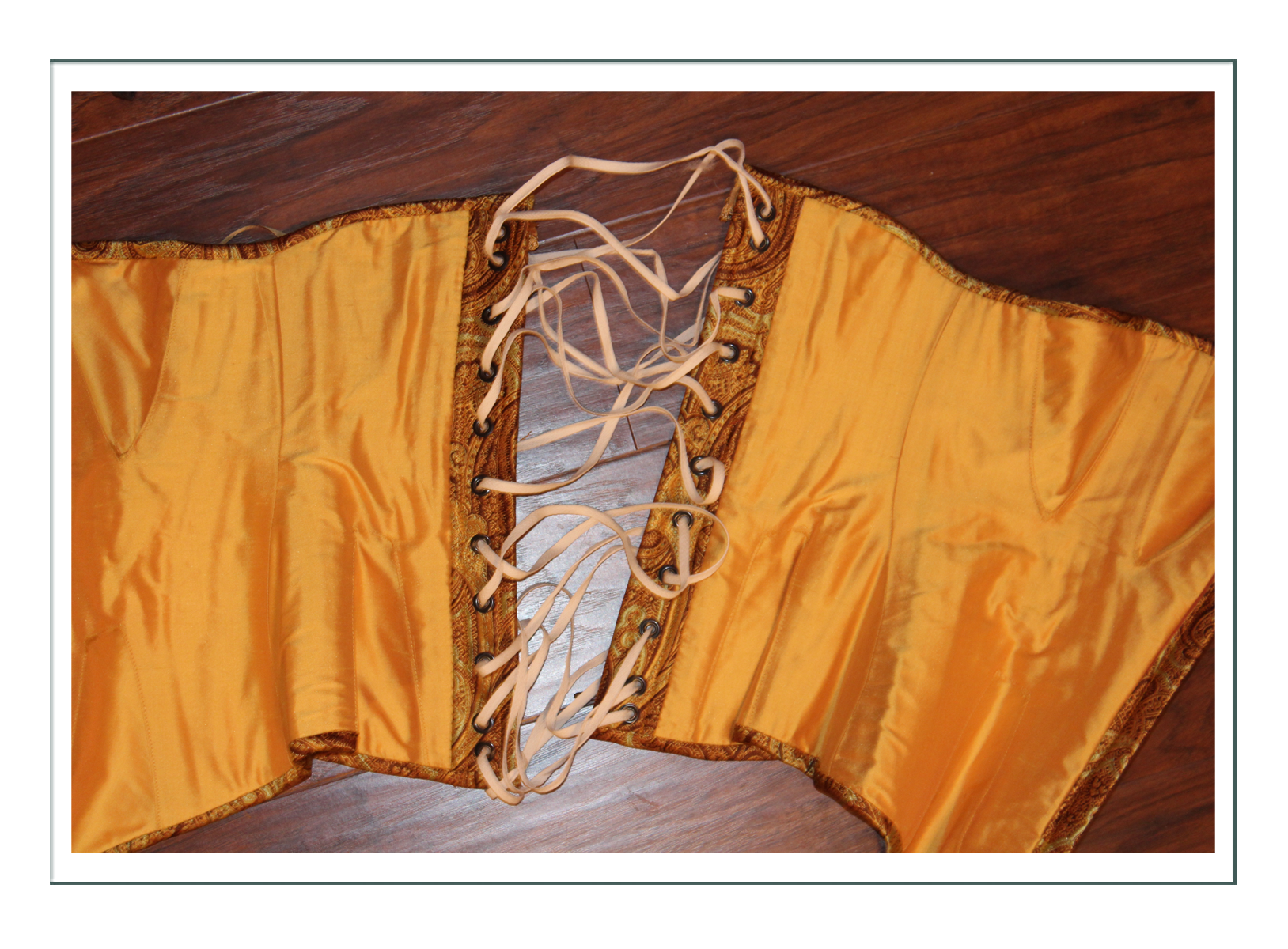

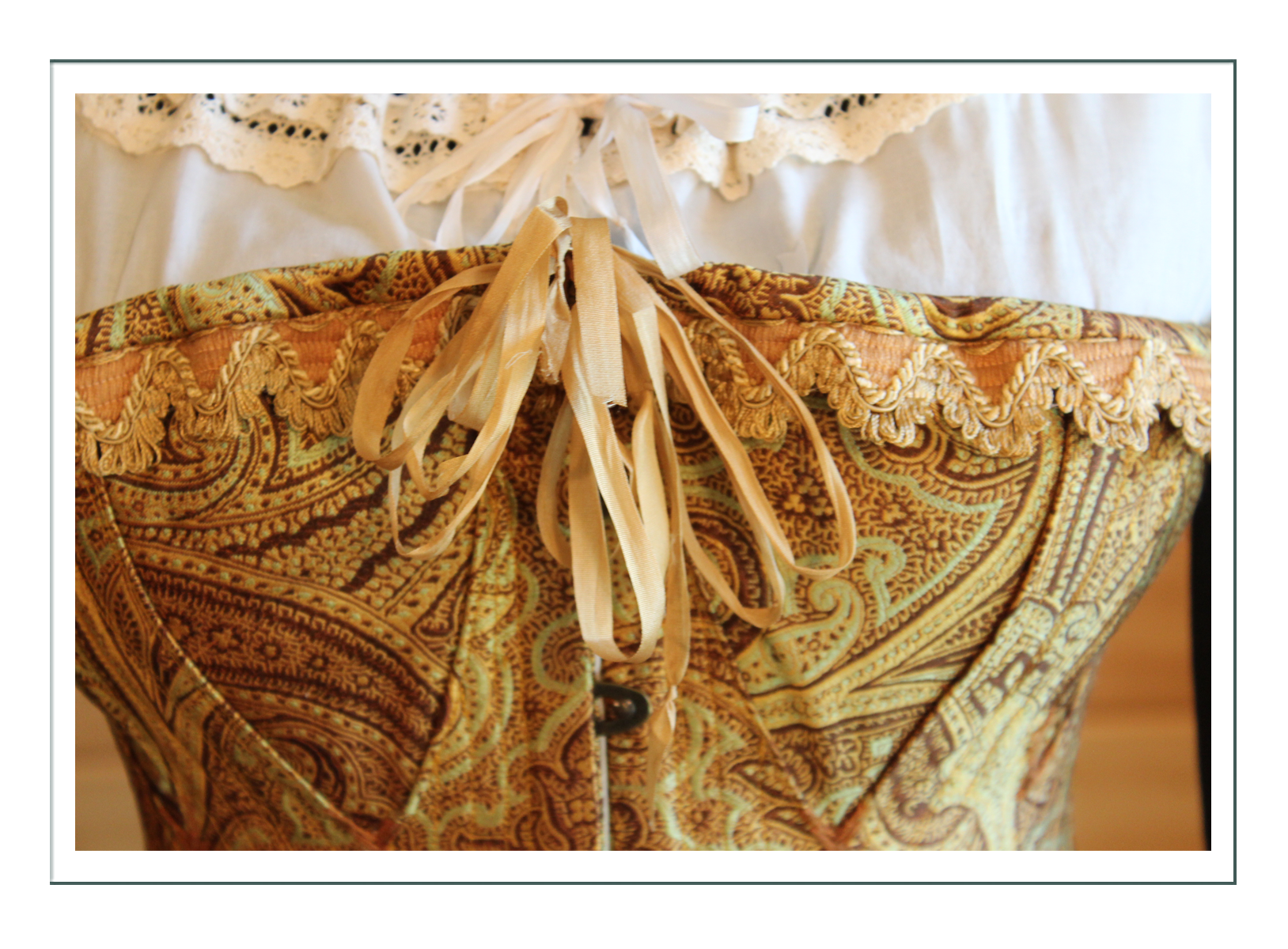
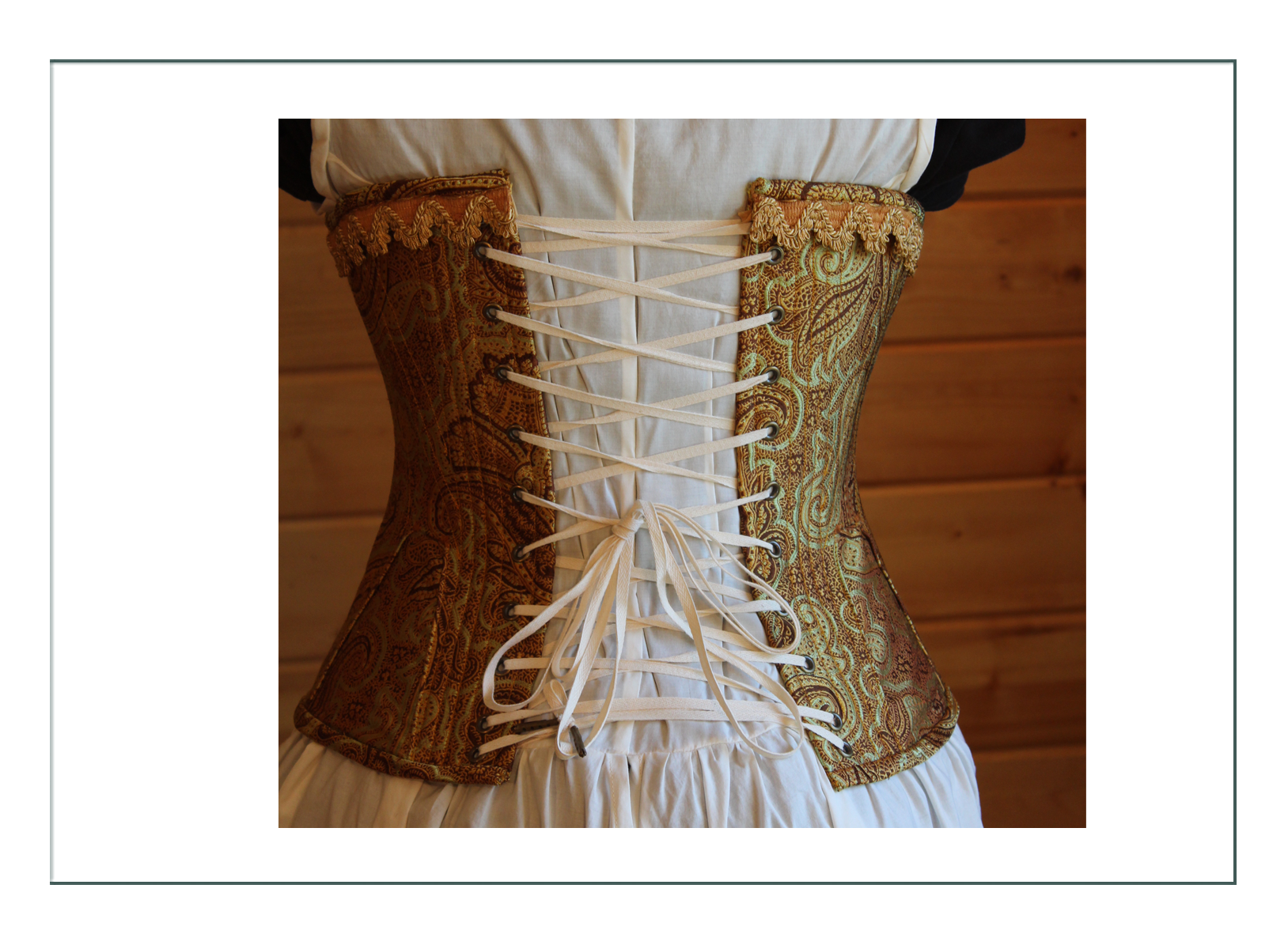
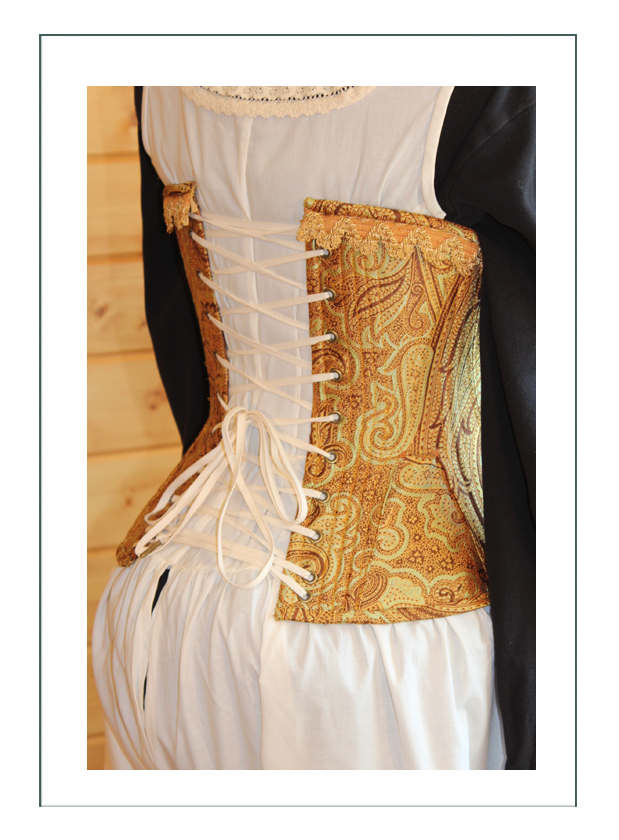
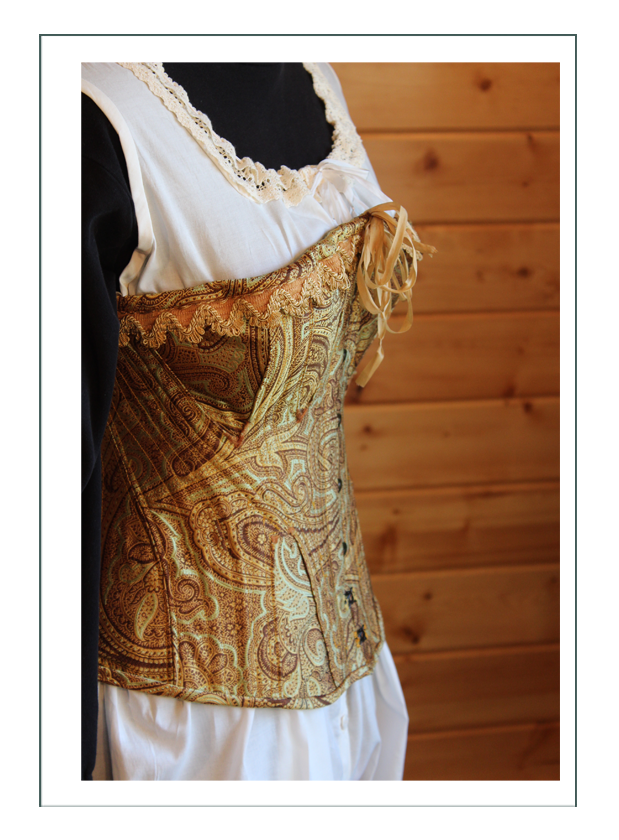
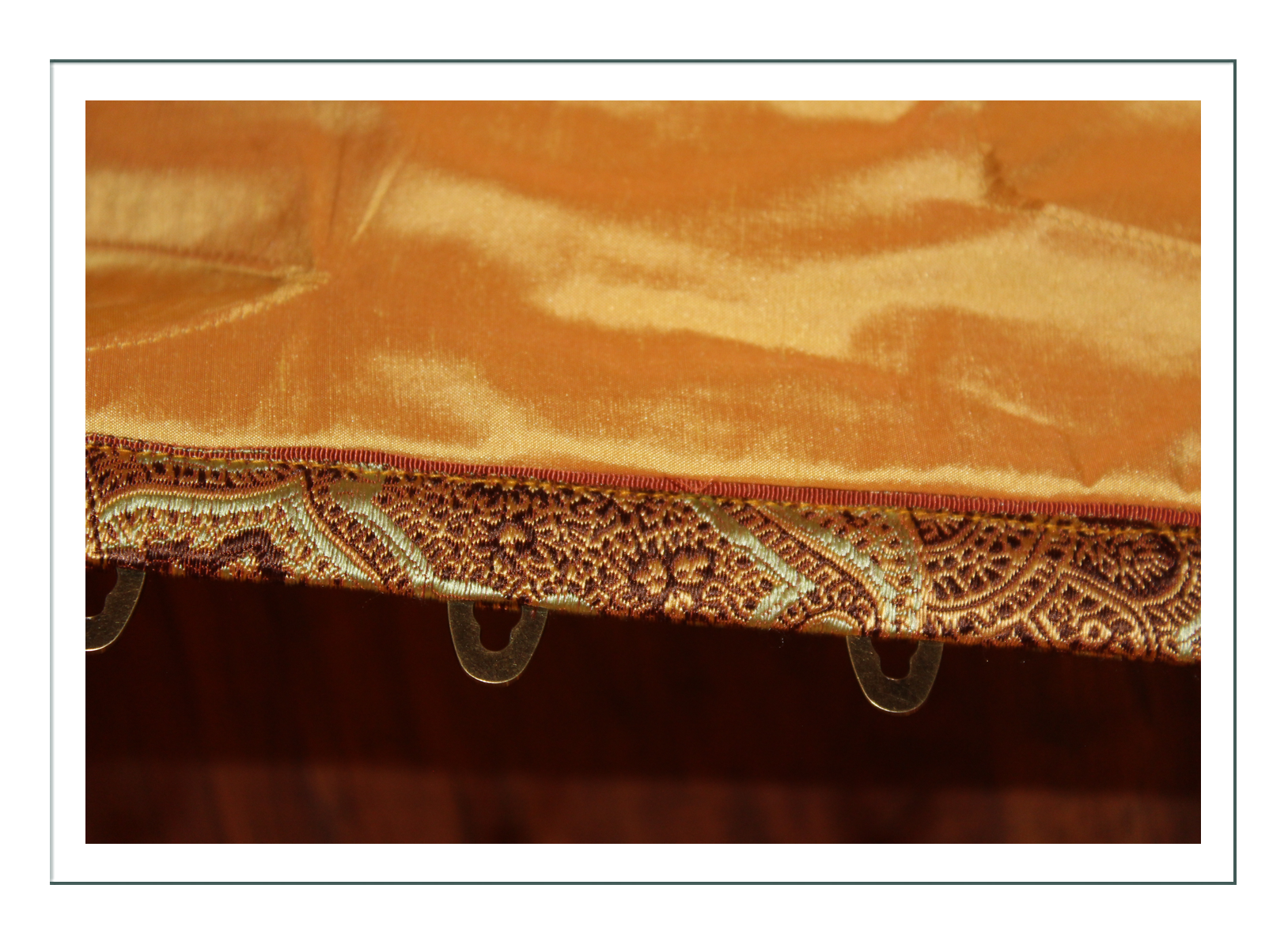
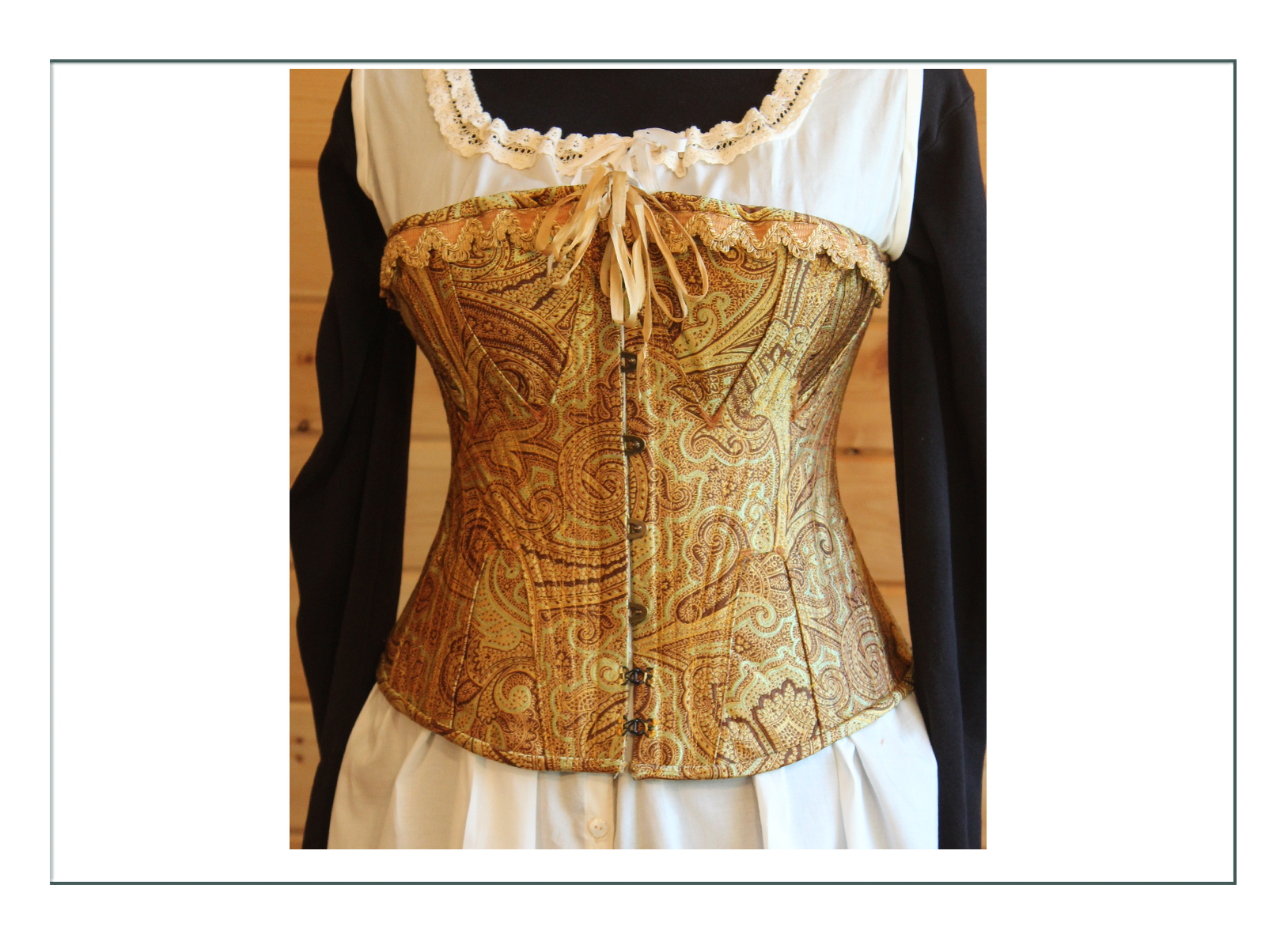
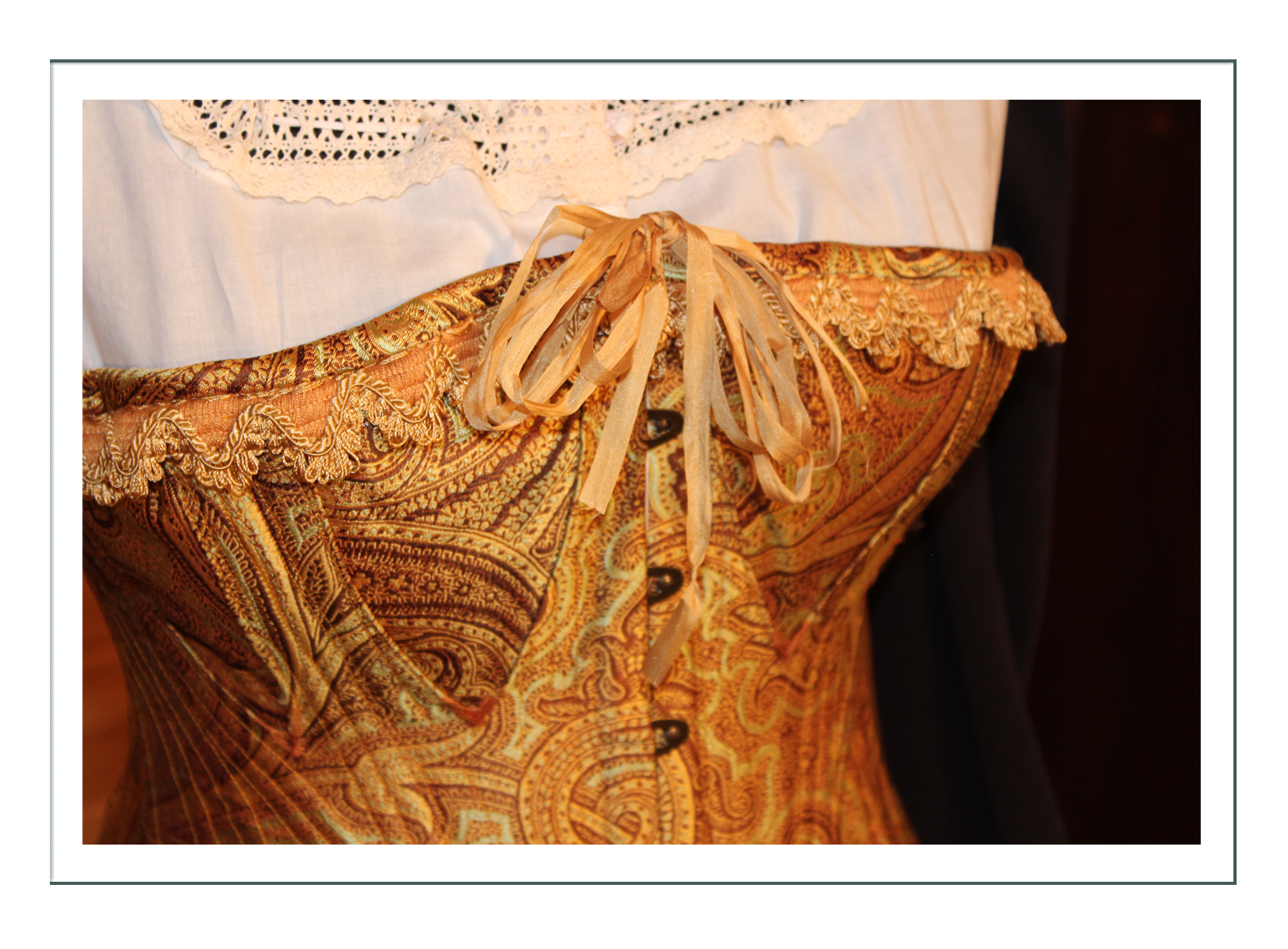
Corset 2
Floral Silk Brocade with Ivory Sateen Cotton Lining
We made this because our head corsetierre said “it’s easier to fit from a distance if you don’t have gores/gussets”, so this is a straight boned corset. It is still very heavily boned, and again as with the first one, the challenge was getting almost full bones (like 18th century reeded stays) into such tiny fabric. It should give spectacular support and comfort.
Also built in is the waist tape for tight cinching and an adjustable silk ribbon tied top. The main disadvantage to this over the other one is that the breasts won’t be “lifted and separated” quite as well, but rather quashed and held tight. It will become a subjective decision based on fit.

The silk brocade of this may also pull a bit on the busk edge. It is not corset fabric; a learning curve for us. The busk is the right size on this one though, as it is an earlier, shorter corset more akin to the late 1870’s. It is a beautiful silk with muslin (era appropriate) lining and very little ornament because the fabric and lines are so lovely.
Our favorite is the lovely curve on the waist and hip that will drive men crazy.
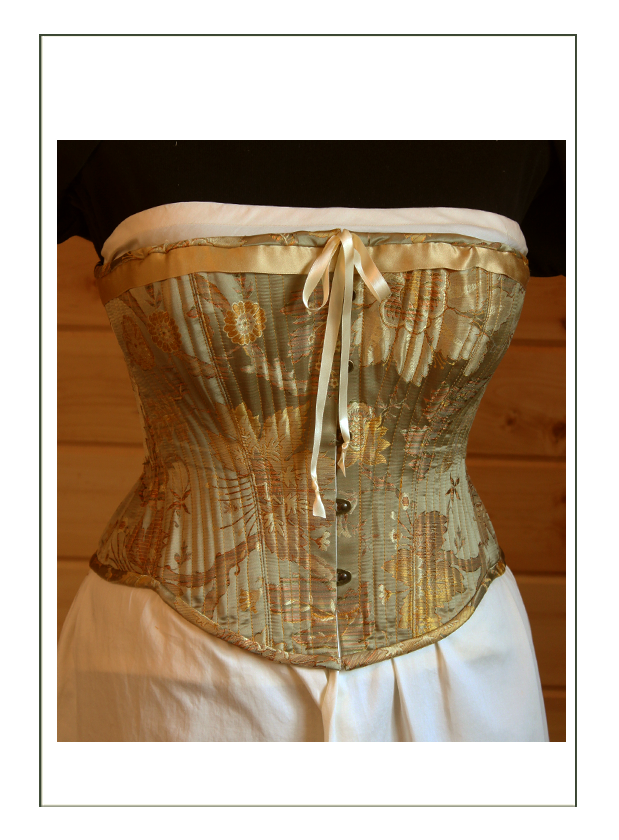
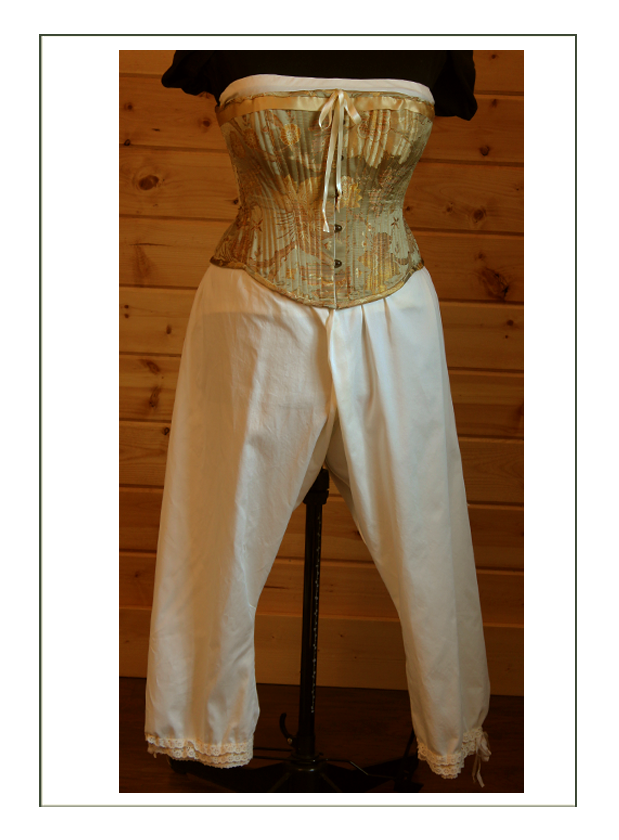
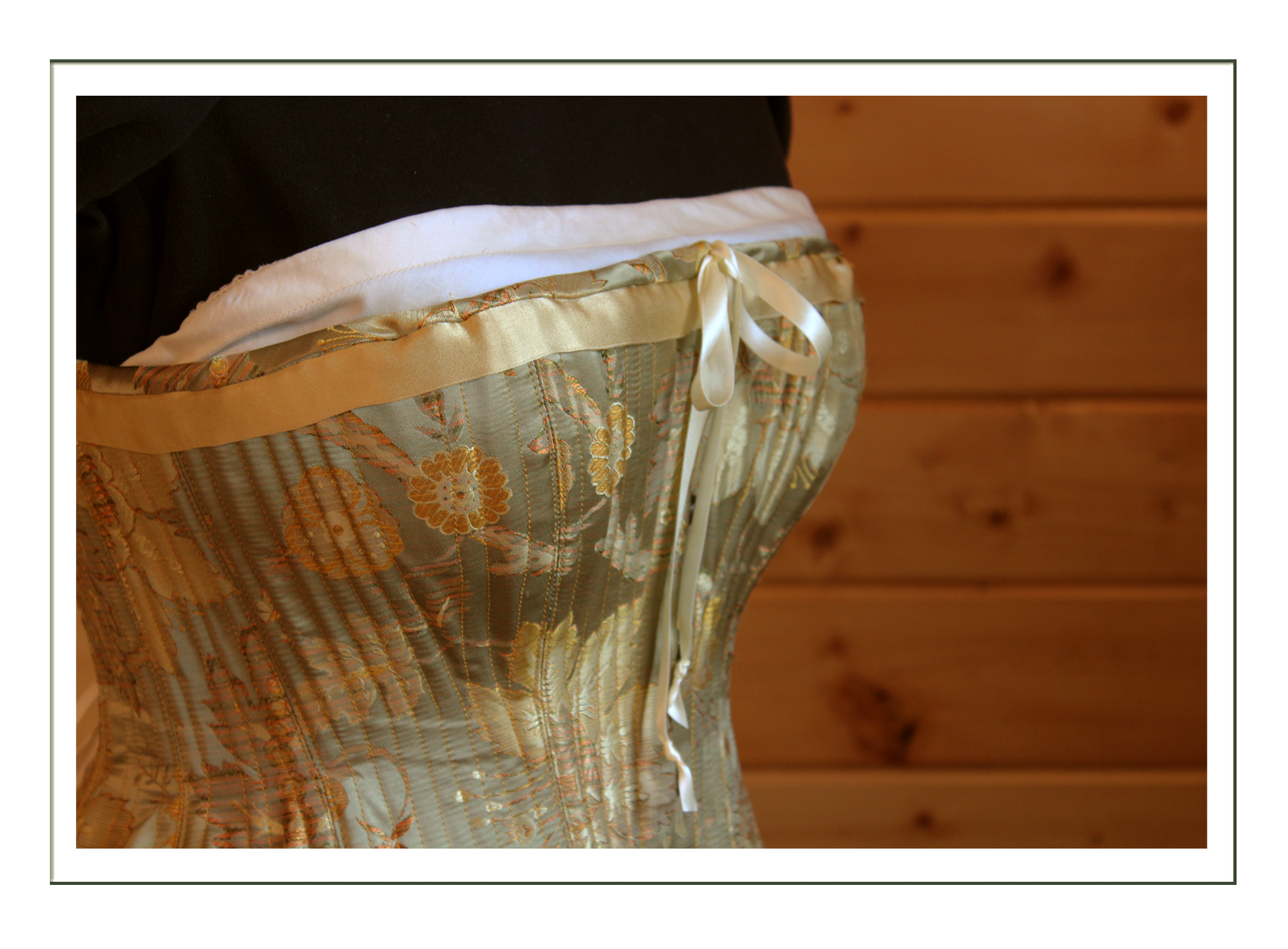
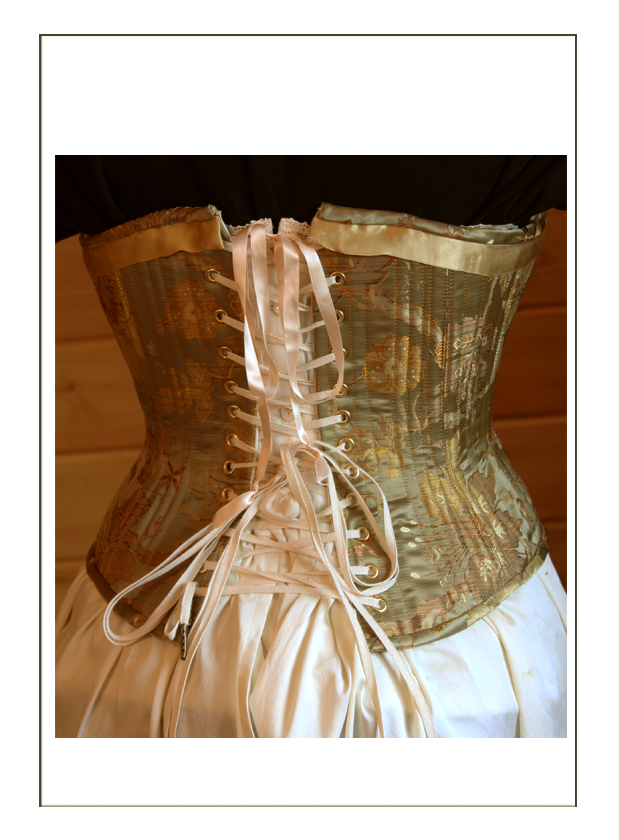
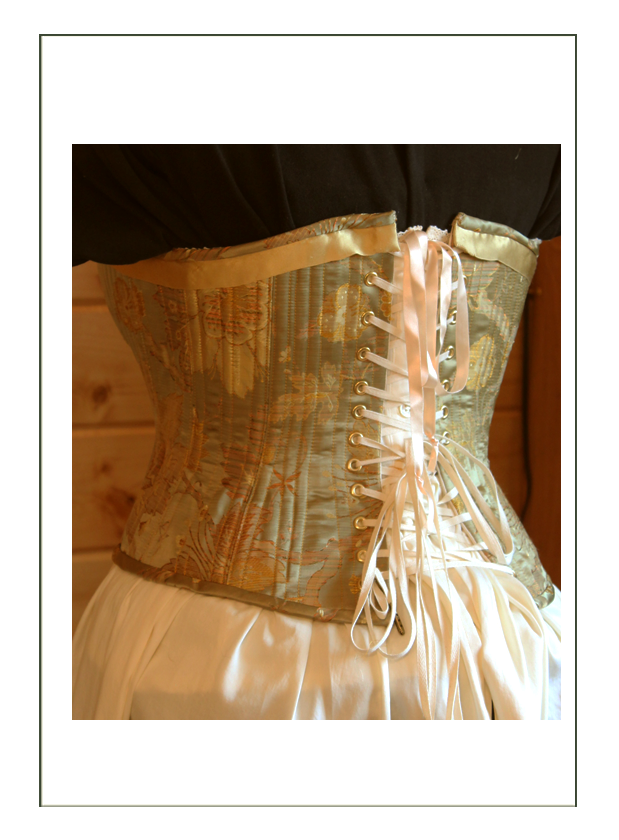
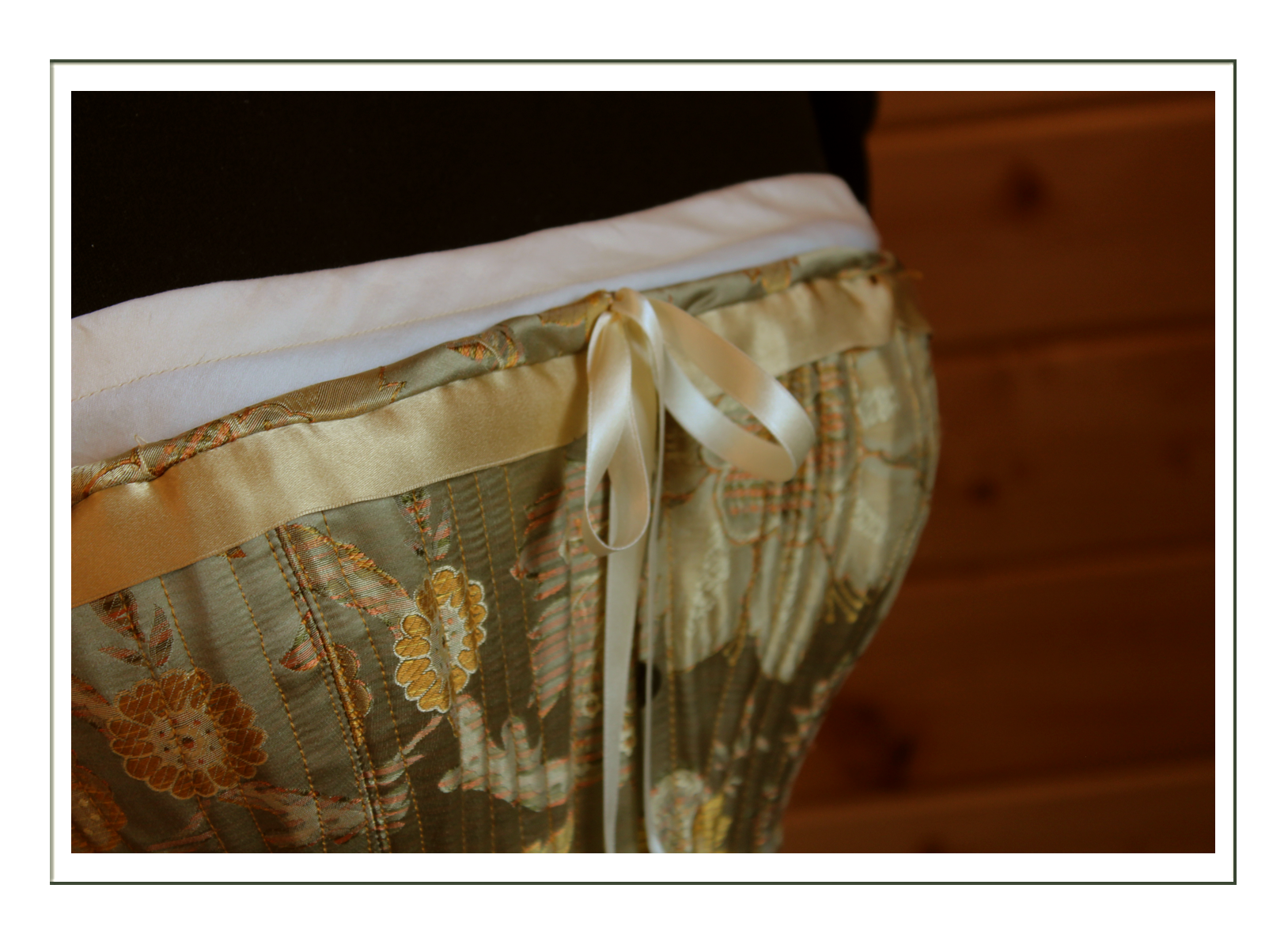
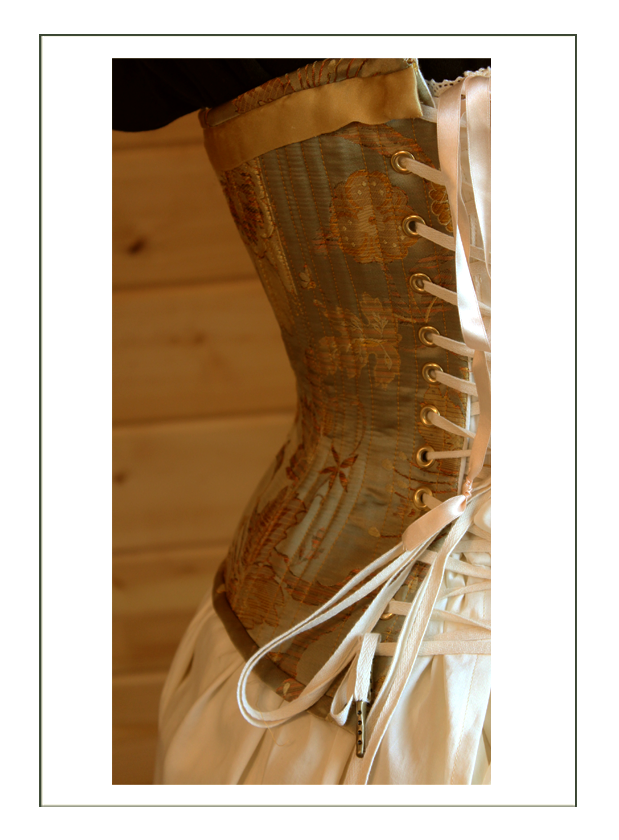
Petticoat
Combination
As the bottom most layer of the ensemble, the Combination must be very washable, durable, and comfortable. This one is made of extra fine and high quality ivory lawn fabric from a vintage source. It has mother of pearl Mississippi River buttons which can be ironed. Since this is the layer that will soak up sweat, it will need to be washed and ironed, including the ribbons.
Everything is either 100% cotton including the lace or 100% silk so it is very strong and lightweight and breathable to wear. Women of the 1890’s bought their combinations without darts from a catalog. They then got together with other women to fit the darts. The closer the fitting the better; especially with the goal of the smoothe front line of the silhouette. 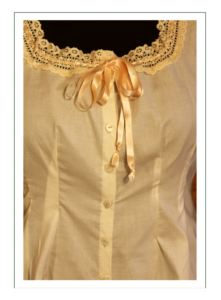
Because this is the only thing (unless drawers are added for warmth or modesty over them) under the corset, it must have minimal bumps or lumps that could mar the skin. For this reason it has all French seams and handmade button holes to be as smoothe and simple as possible.
The design itself is a “classic”; the same thing worn from the early 1880’s well until 1910 when the corsets dropped and the brassiere was invented. It’s a challenge for modern women to learn to use split drawers to go to the restroom, but if there is a wide enough split, and with practice, women find it is much, much easier than modern panties and pants with all their zippers and such.
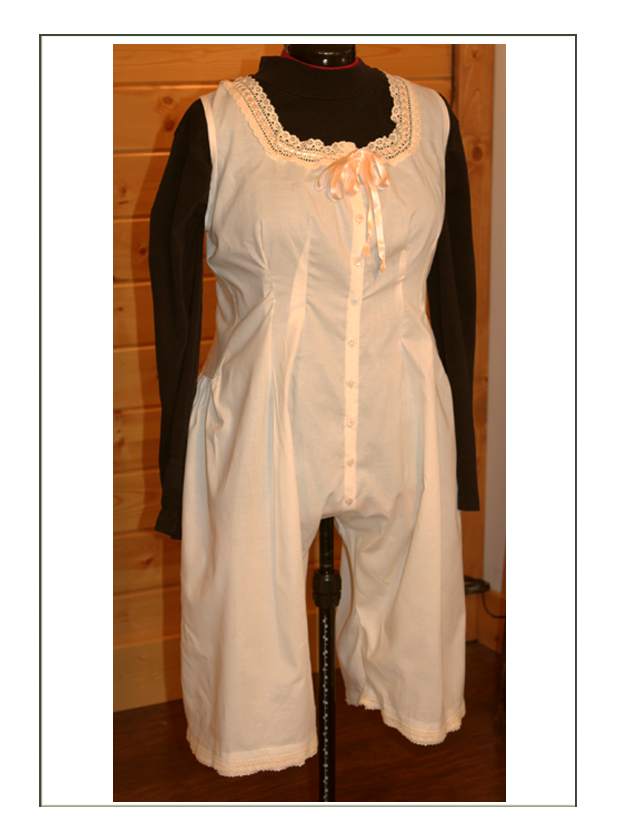
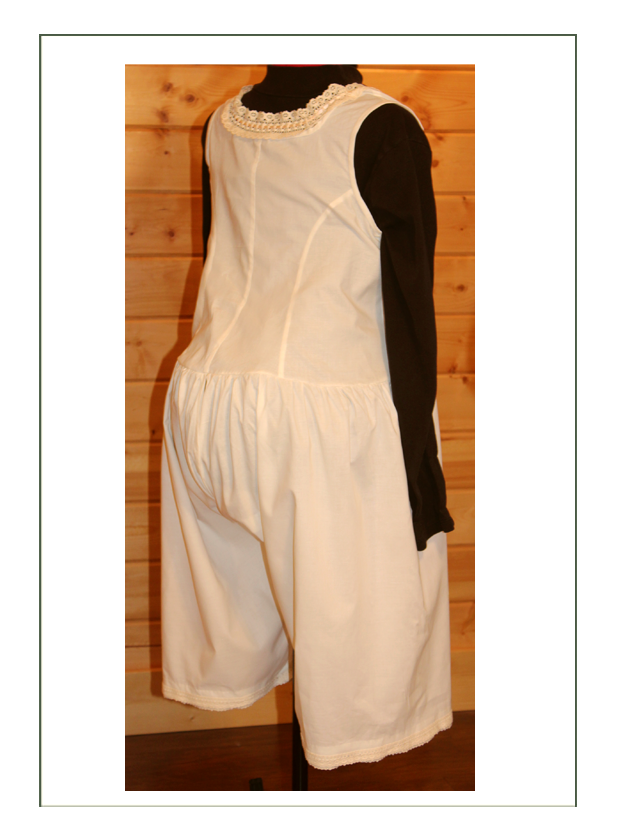
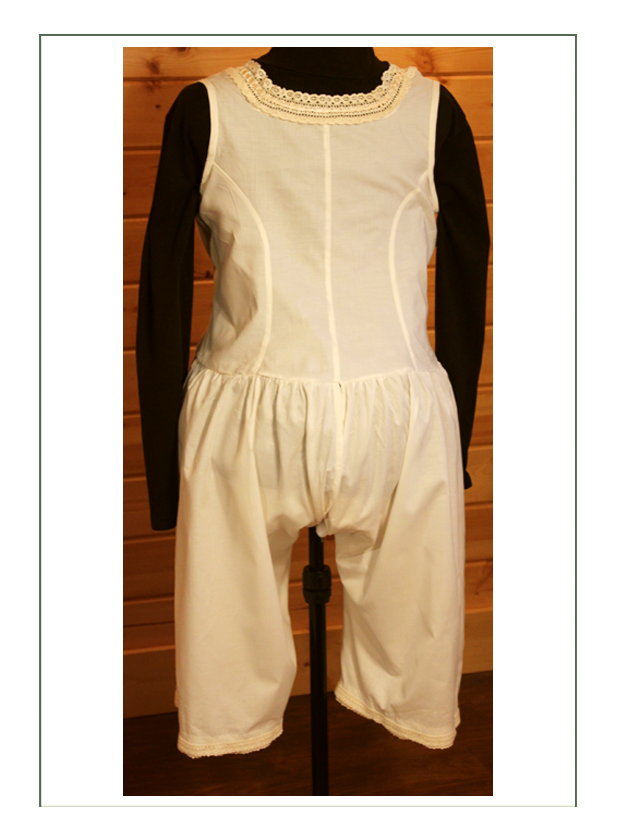
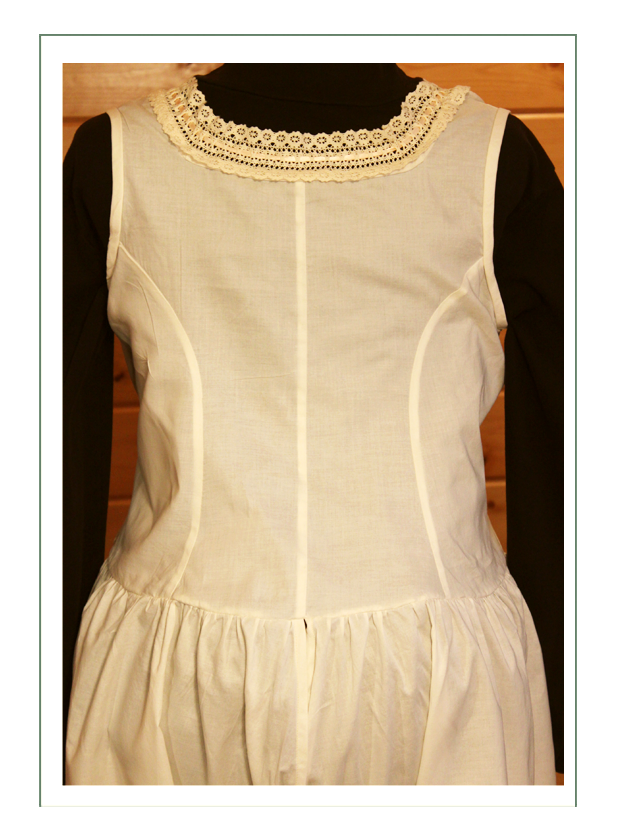
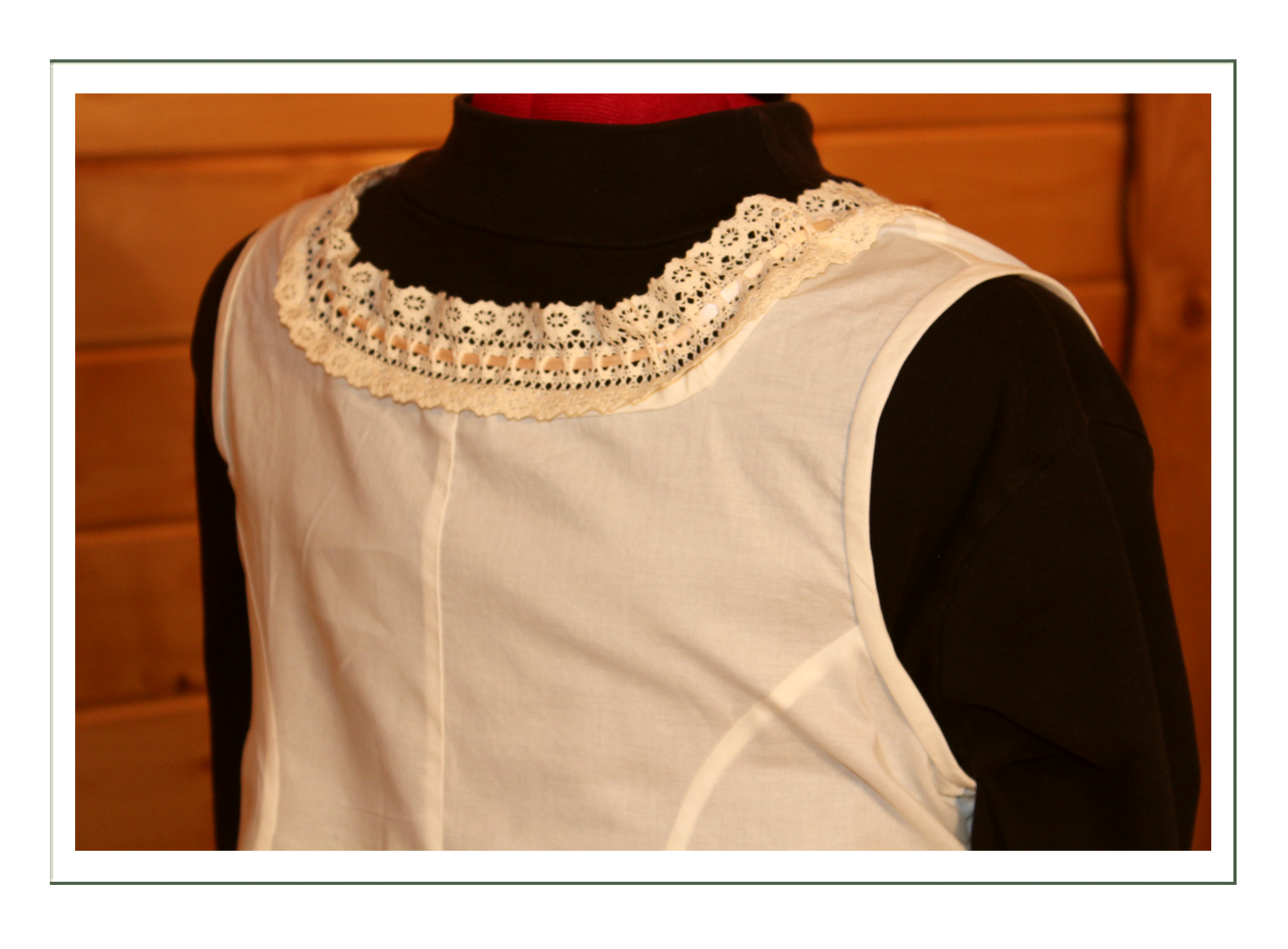
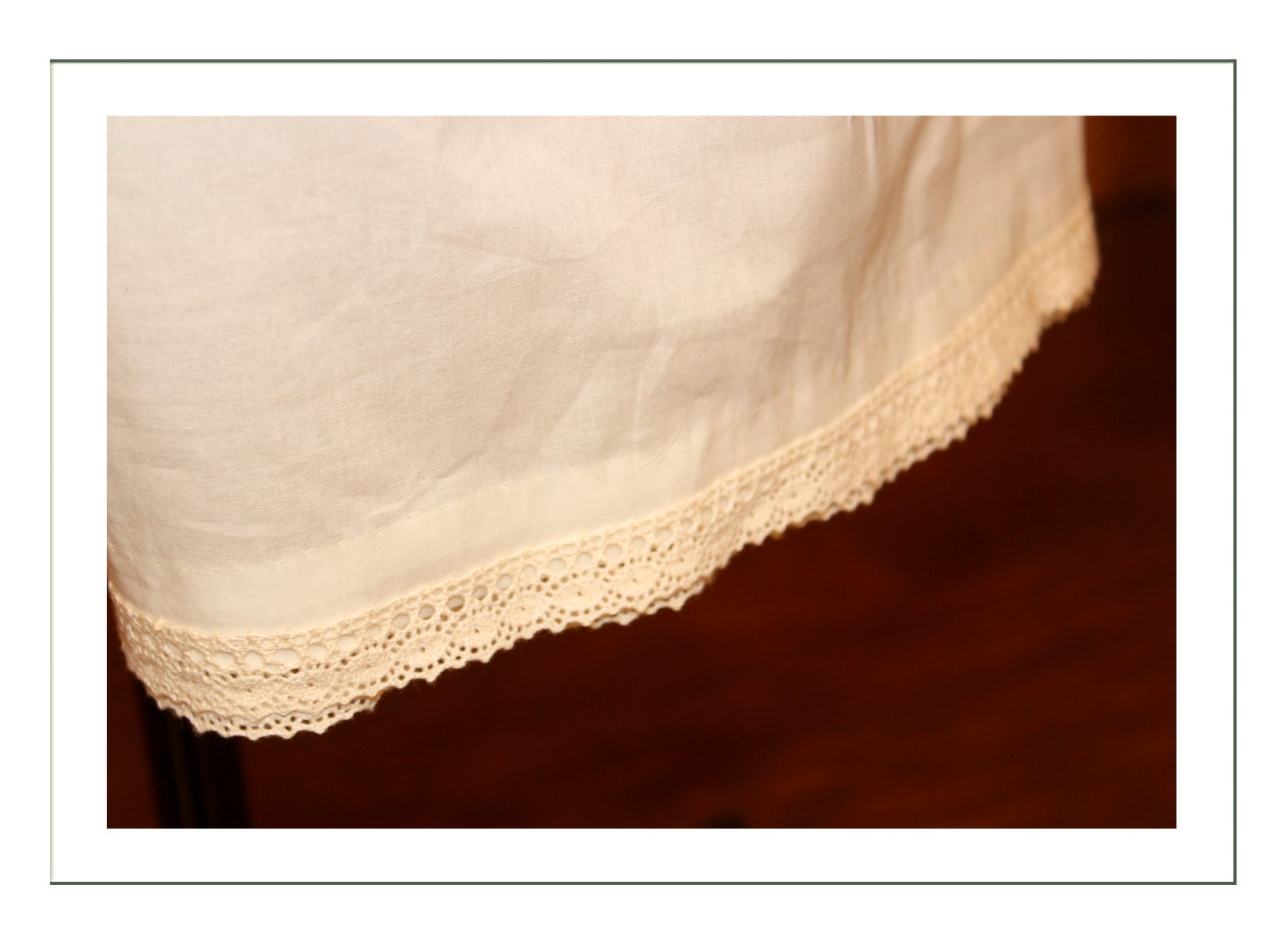
The preferred position for the laces on the combination are optional. Folding the lace down allows for it not to peak through a narrower outer garment. It’s nice to have the choices:
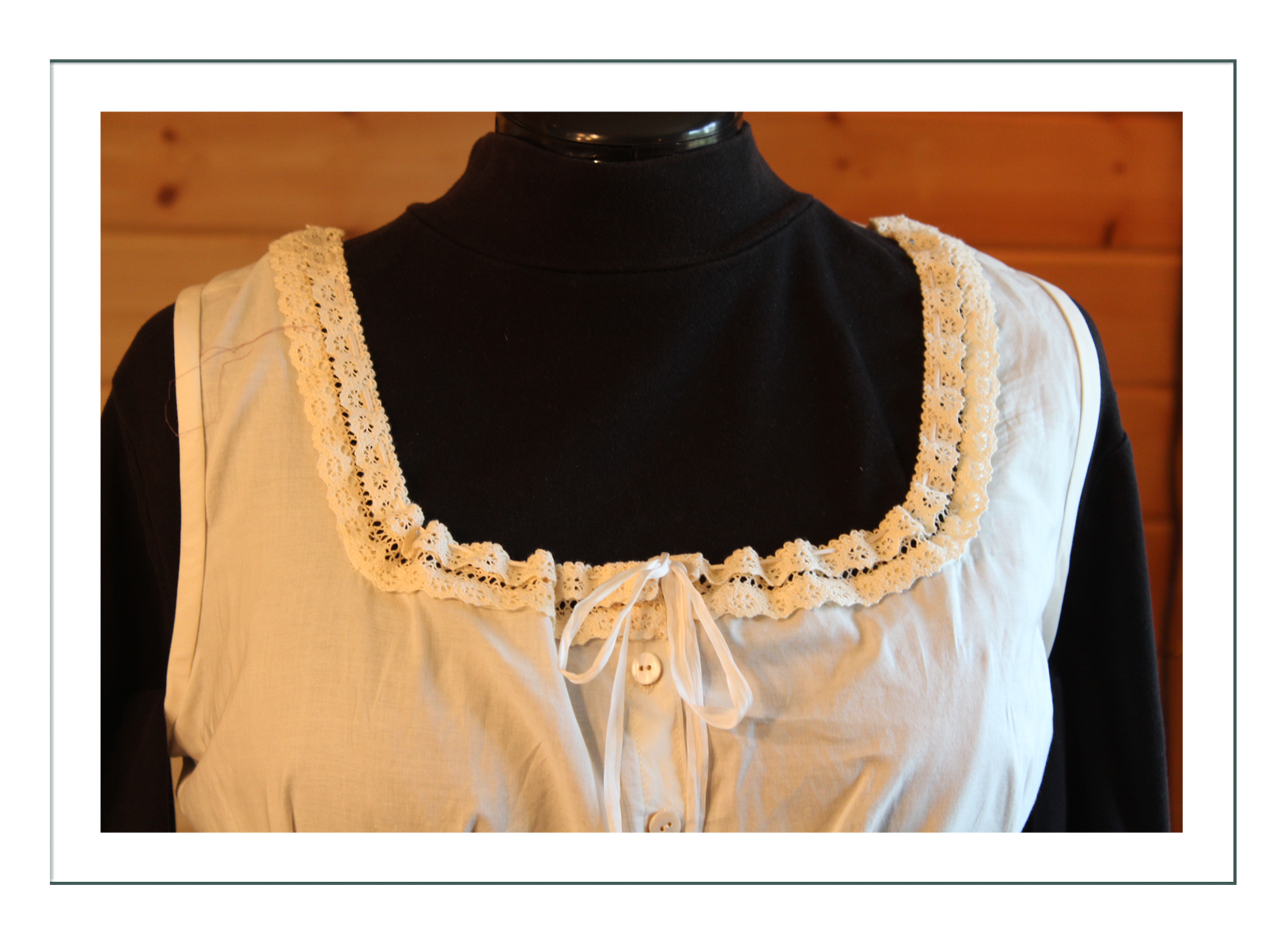
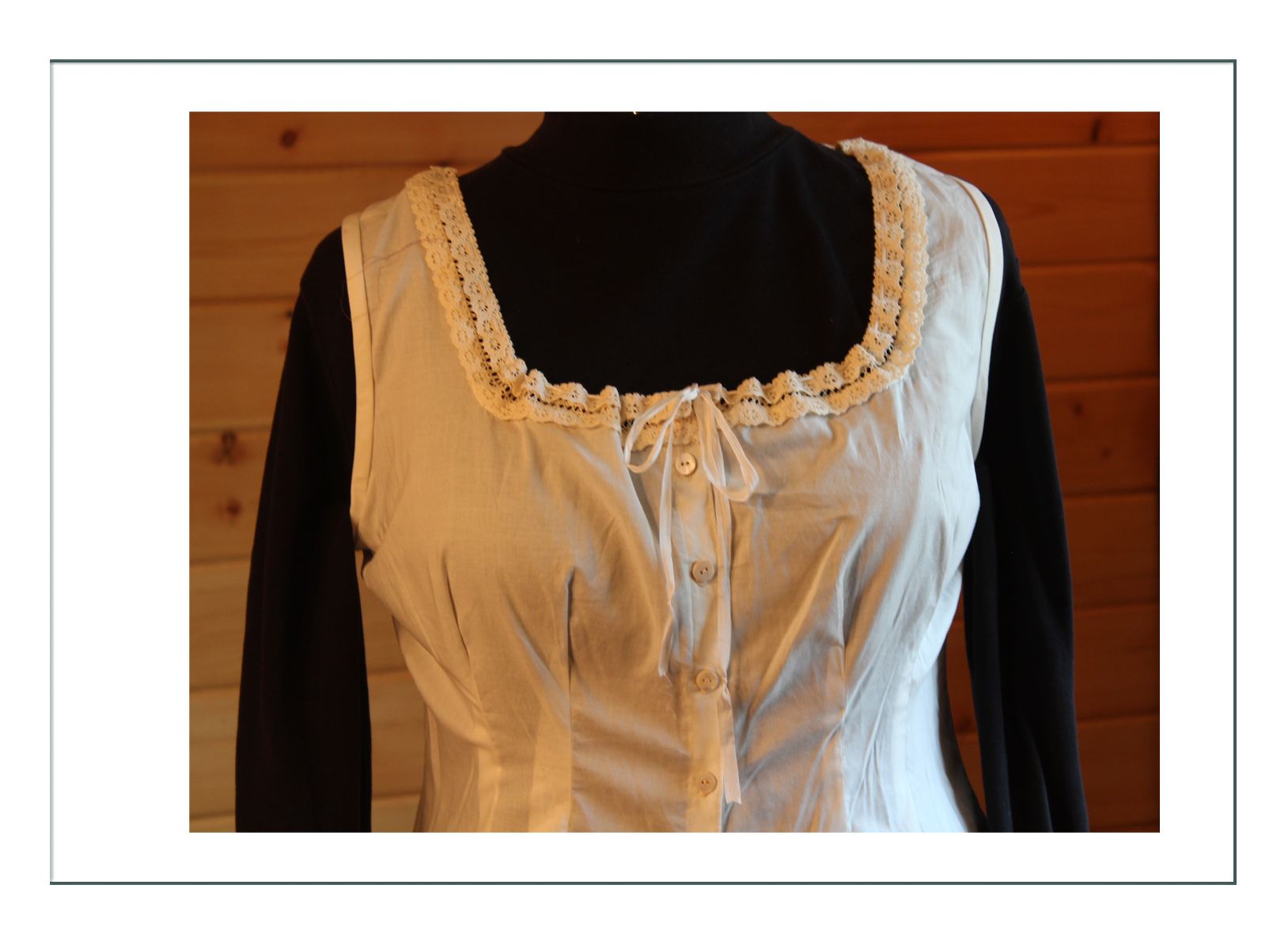
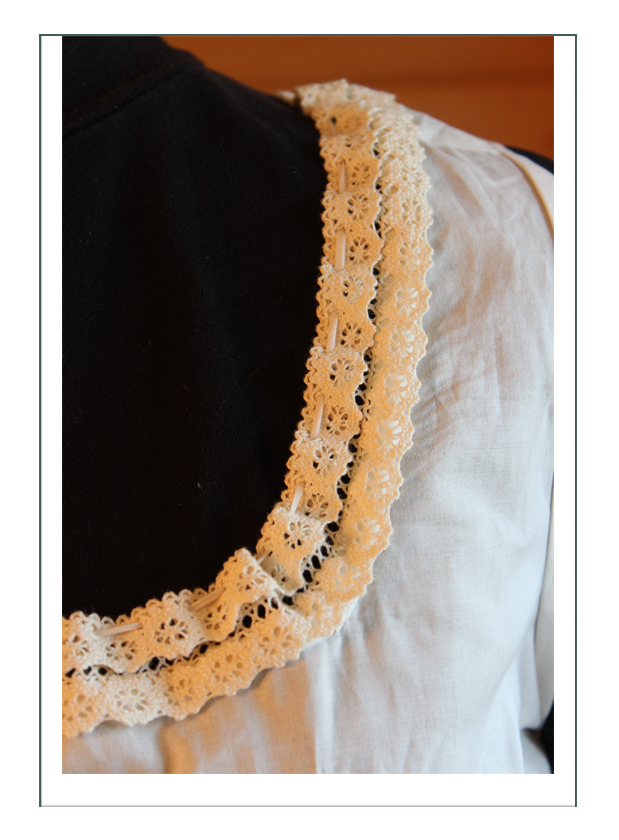
Drawers
Old women of the late 1890’s wanted a little more warmth and modesty than a lightweight combination made of sheer lawn could afford. They reached back to their closets and pulled out simple, plain, durable cotton split drawers. Worn alone or over the combination, the splits matched up so one could use the “necessary”, by then meaning indoor plumbing.
These drawers are optional for Dr. Anderson, who may choose to wear them INSTEAD of the combination or OVER it. They have matching lace to the combination and undervest, and need to be “cinched up” because they will be long for the era when drawers were worn just below the knee cap. The ribbons tie them up to that location.
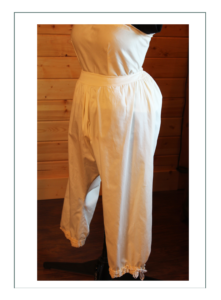
The fullness below the knee will help fill out the single petticoat so additional petticoats are not needed. The fashionable silhouette of smooth front and full back is also emphasized. They have string casing ties so they can vary in fit depending on the corset lacing.
These don’t look good in photos because they aren’t made to be seen – at all, ever. Respectable women never showed their drawers; not even the pretty lace and ribbons on the bottom. They are like today’s panties; the washable and durable inner layer.
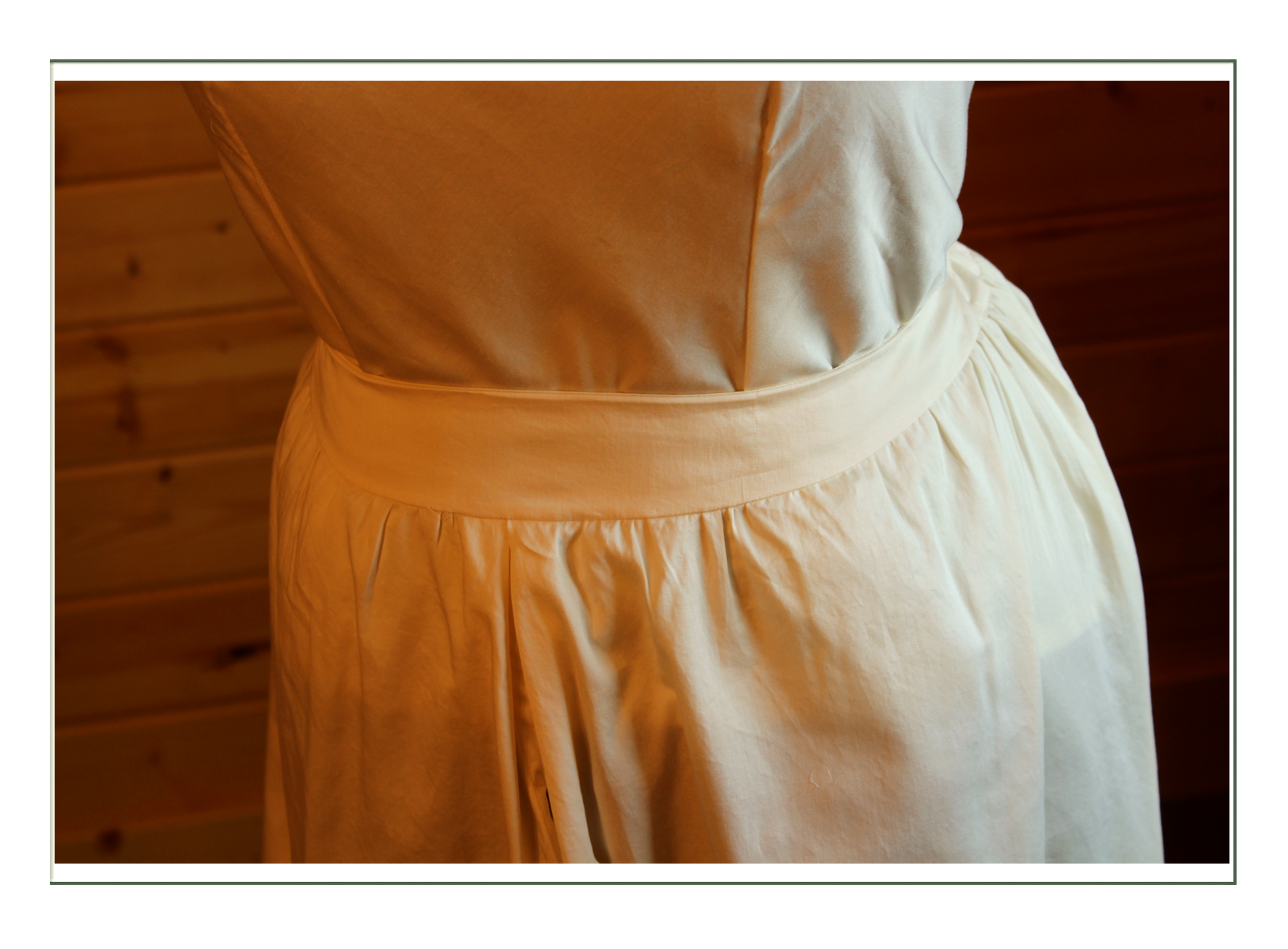
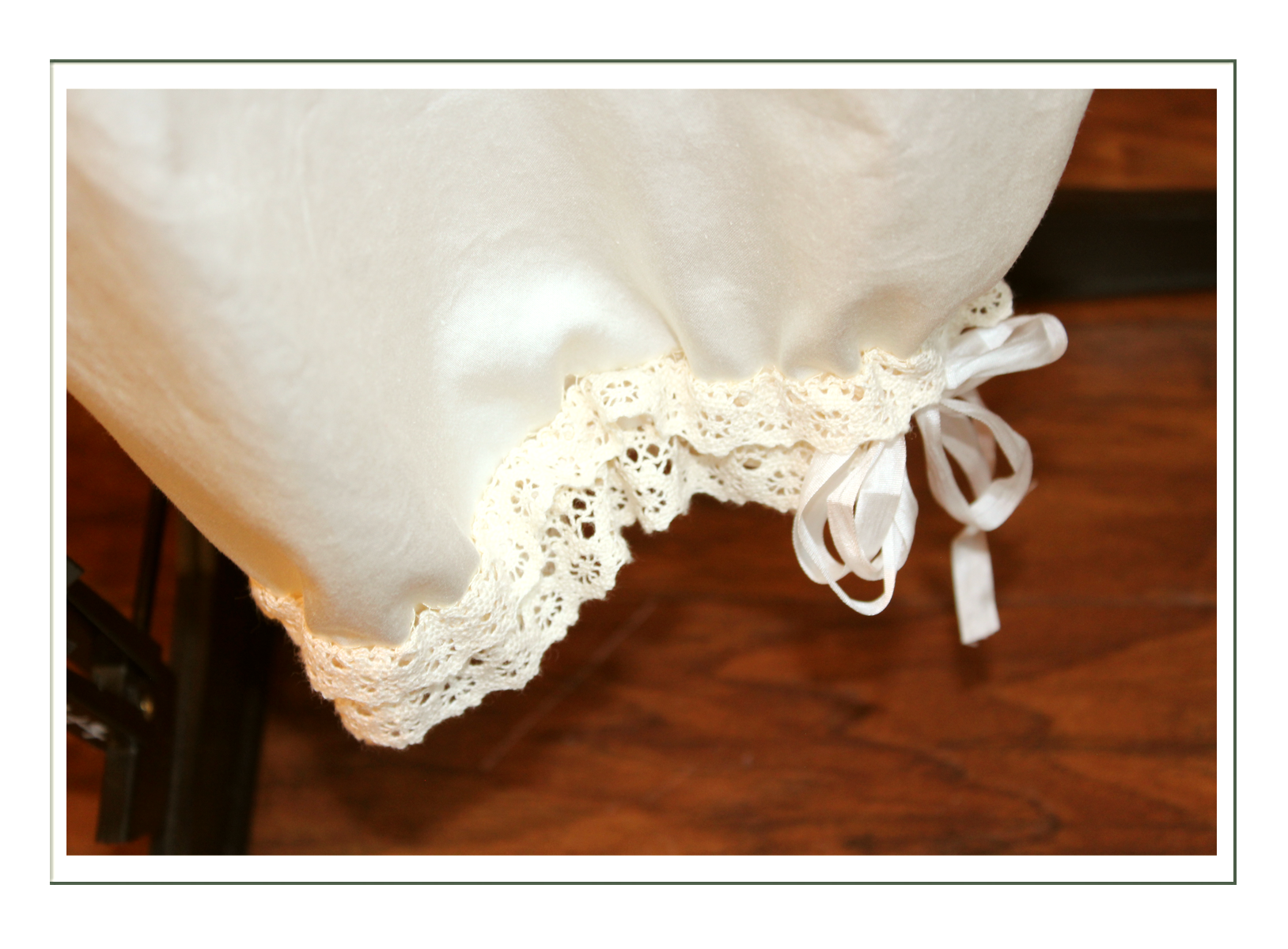
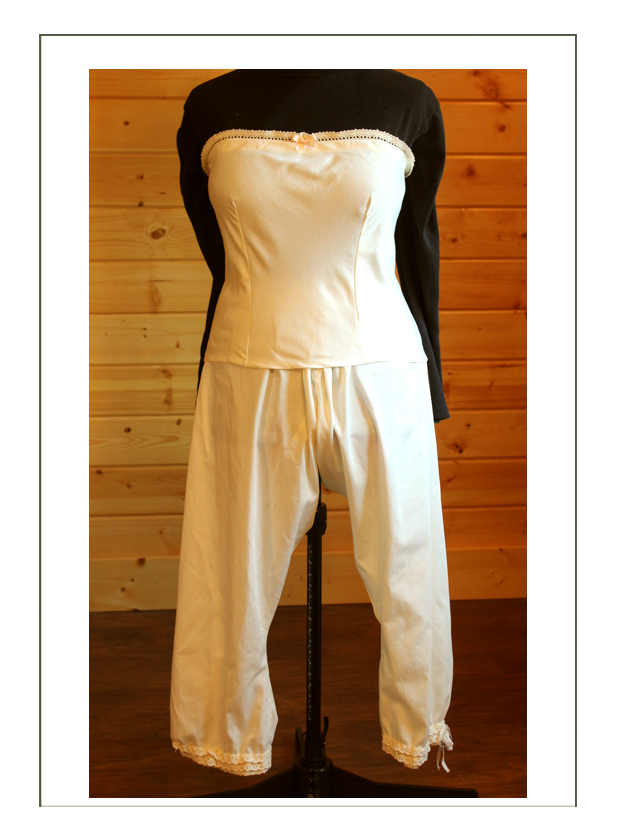
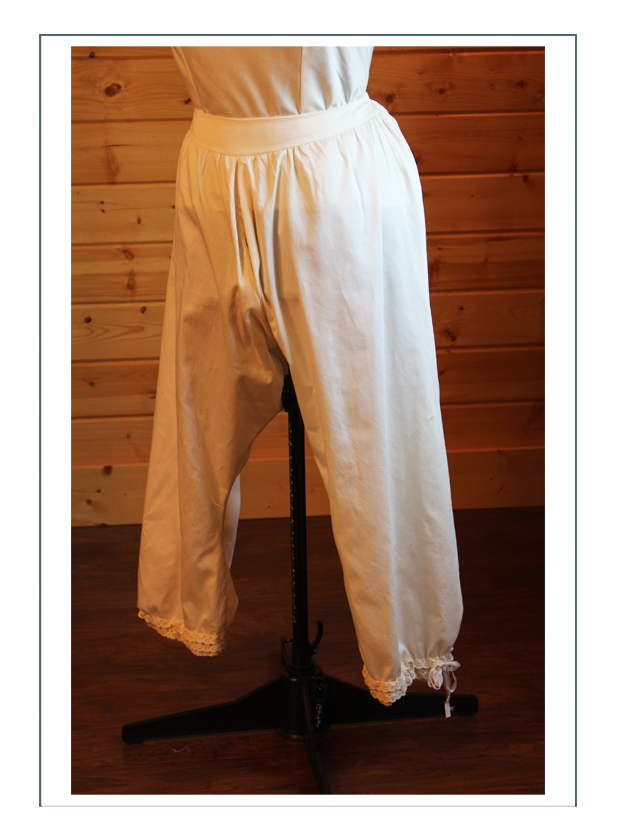
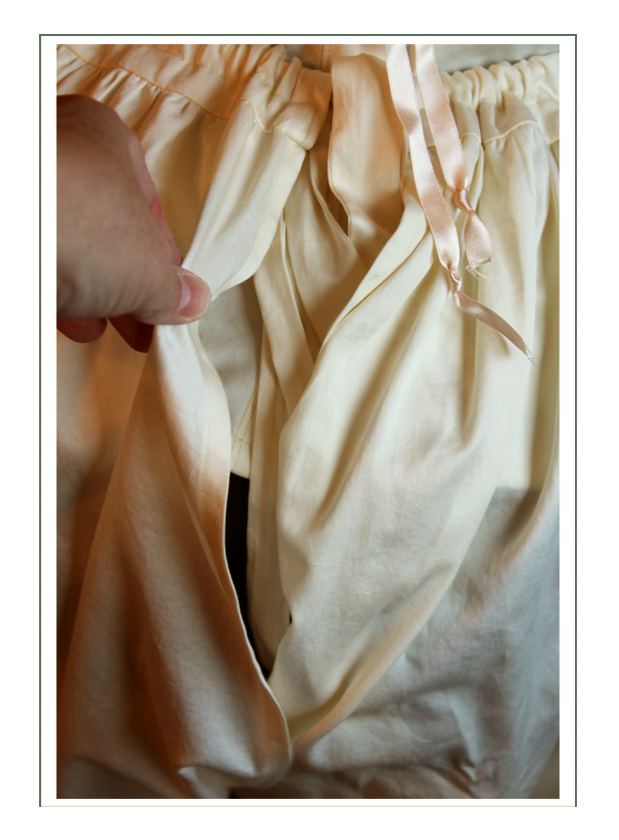
Undervest
If a woman is going to revert back to her old unders, she cannot just go around wearing drawers. She needs something under her corset to protect her from chafing, and to absorb sweat and dirt.
The under vest is an old and new idea for the woman of the late 1890’s. Old because it is the old “camisole” for the same purpose; new because it was leading to the development of an “underbust supporter” or a bra to lend extra privacy, modesty, and support in addition to a low or lightly boned corset.
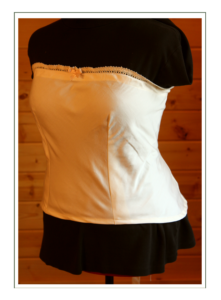
Physicians of the day recommended women wear “wool next to the skin” at all times – and they LOVED the under vest because it could be made of 100% wool. As the bottom most layer, it compliments split drawers and is highly washable.
Dr. Anderson’s is custom fit and cut on the bias to be form fitting and tight to the figure. It is of 100% (very soft!) cotton ivory sateen. Because actual need will vary with the outer garment, the lace is an absorptive cotton which can be flipped up or down as if to extend the surface.
The cute little bow in front is designed to be removed if a sheer or low cut gown is worn – so that it is a neutral color and a flat surface. This is definitely meant to be worn and NEVER seen.
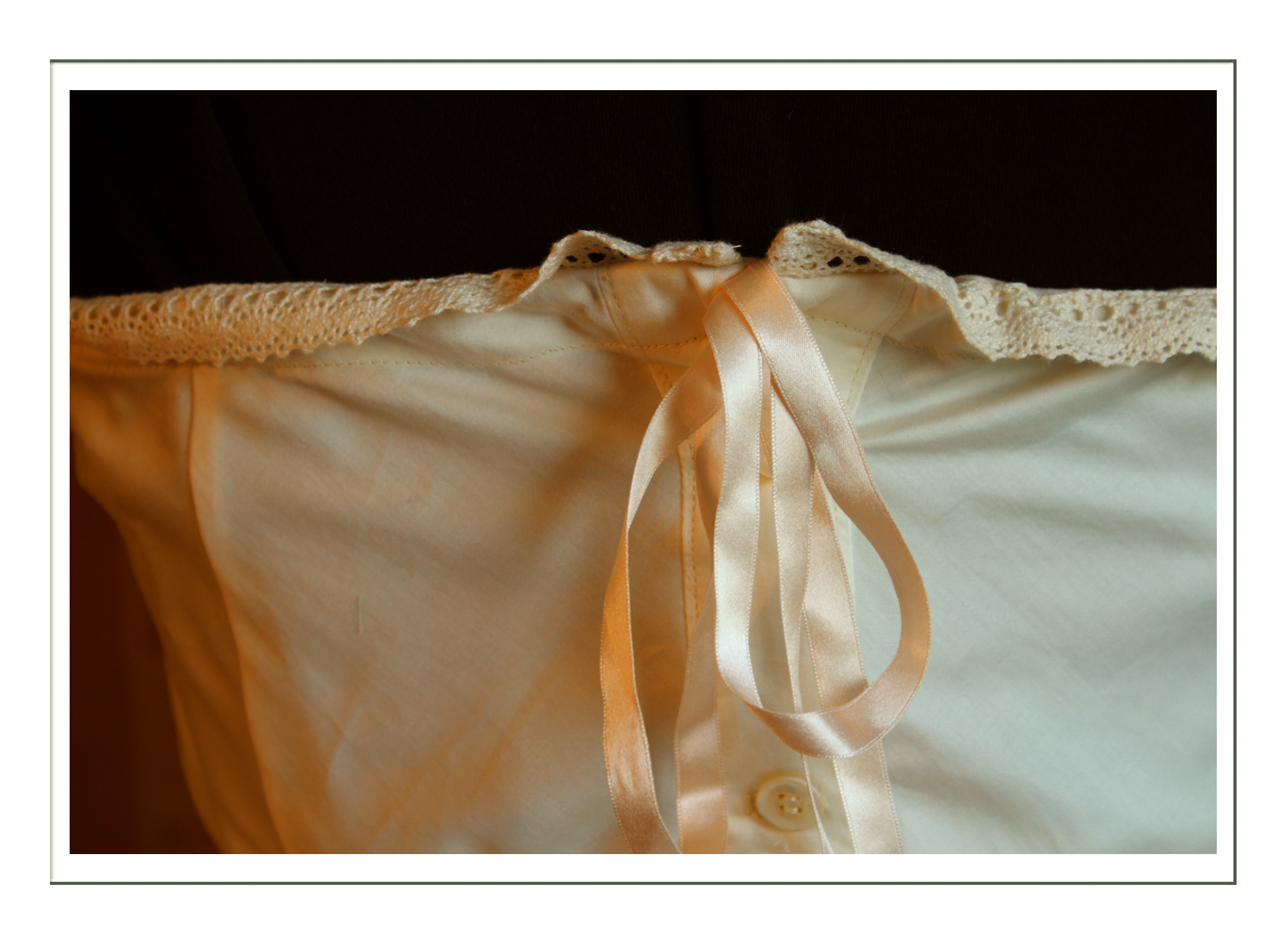

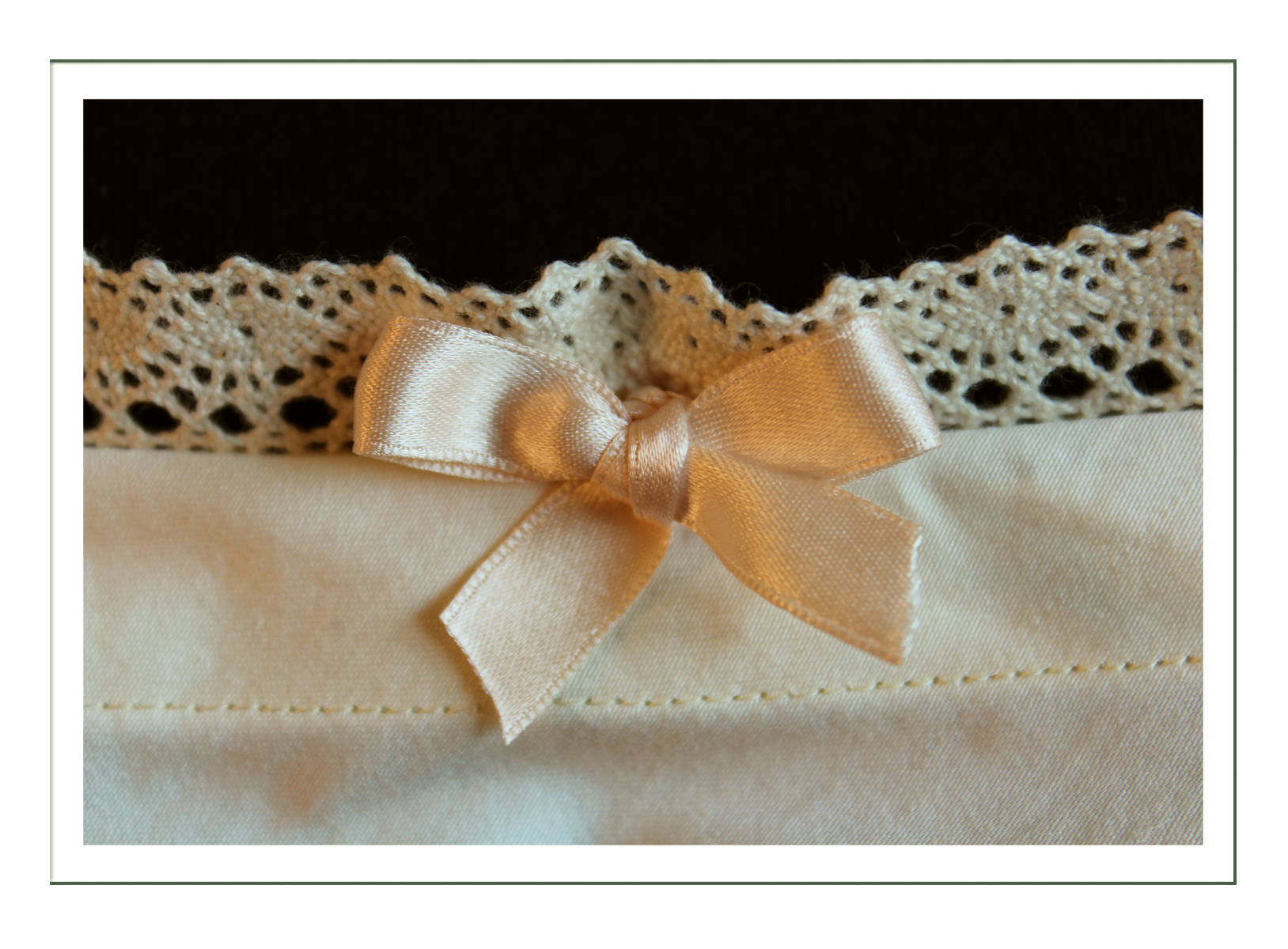
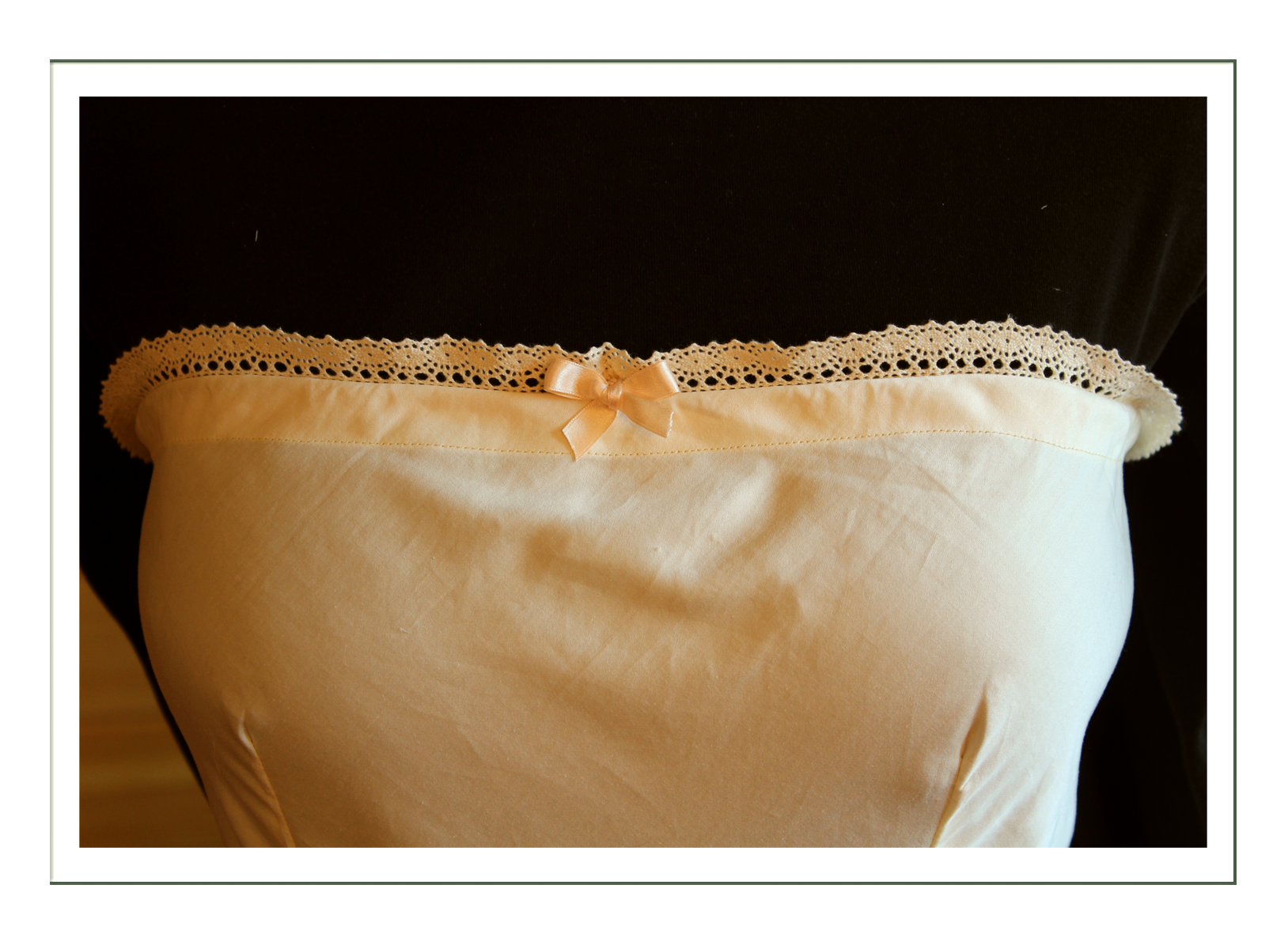
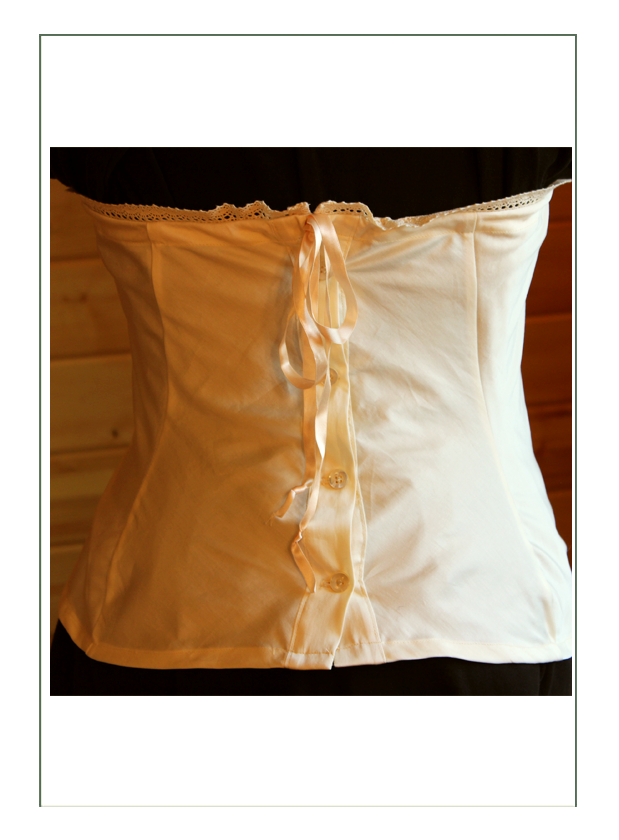
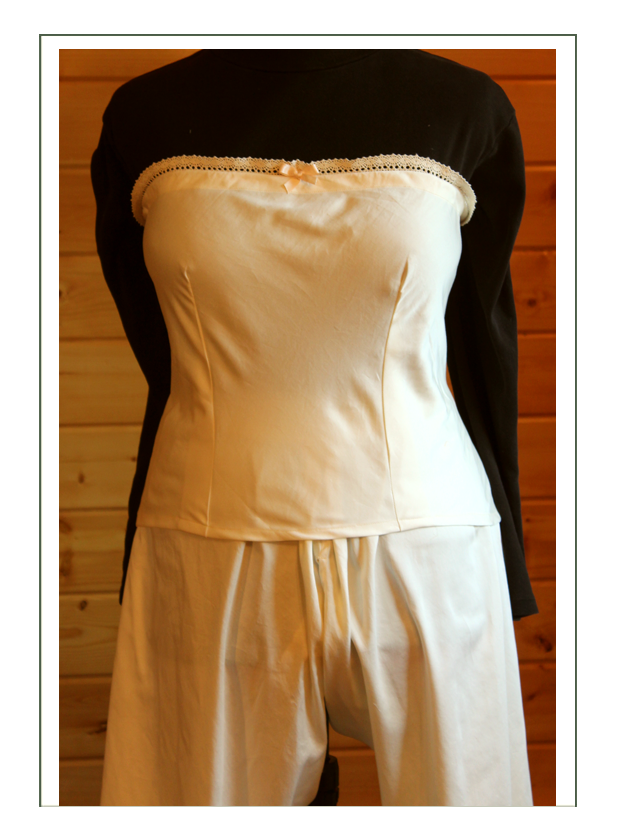
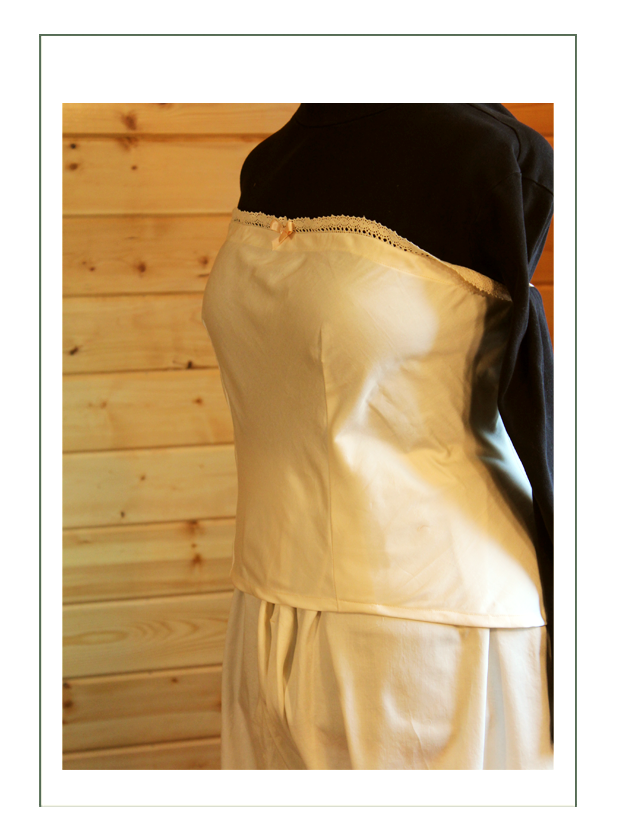
Corset Cover
This is made of 100% silk taffeta same as the petticoat, but it is very tailored, plain, and simple on purpose. It protects underarms and breasts from being rubbed, should there be a gap between the combination or undervest and corset (which can happen depending on lacing and as a woman’s shape changes despite the corset being well fitted now).
As a final sweat barrier, the undercorset has to have at least “under sleeves” and good structure and support. Dr. Anderson’s is fitted to the corsets, as it’s second purpose is to protect outer garments from the hardware of the corsets.
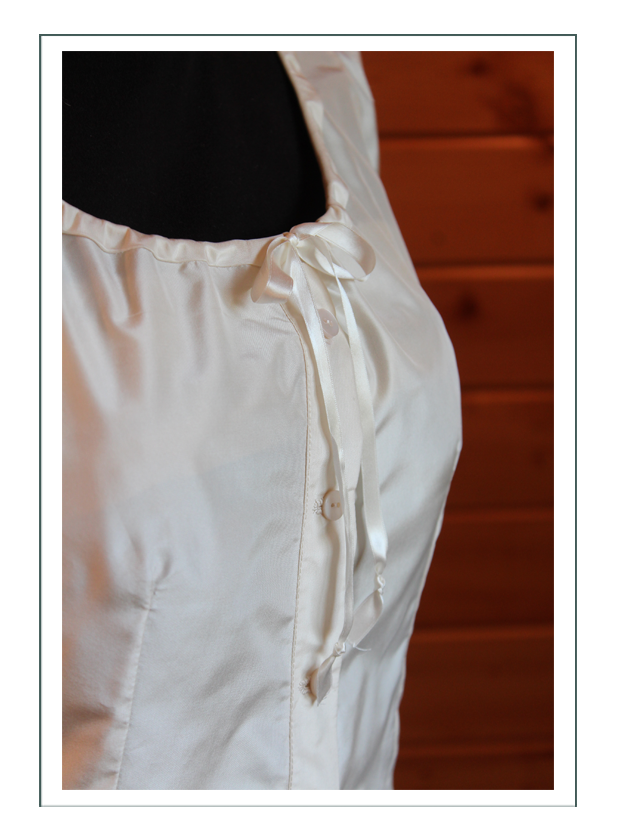
Its third purpose is to block the view of the undergarments from sheer bodices. For this reason, it is of a solid and plain ivory color to match the blousewaist, which will go under any additional gold or yellow blousewaists to come.
The neckline is adjustable using a silk ribbon which is tucked inside after it is adjusted. This is a nice adjustment to make the neckline high or low, and the shoulder strap wide or narrow to accommodate different bodices. It is not for evening use, where the shoulder strap would be tied on and thus able to drop. We are making a Promenade Suit for walking and working, not evening wear.
The sleeves would normally also have a ribbon that ties at the shoulder, but because this is custom fit for this bodice, it is not necessary, and the lumps it would create at the shoulder are not wanted. If we have to, we will add lace for this adjustability, but the objective is for this to be very plain, sleek, and smoothe.
The front is cut lower so the smoothe front line of 1898 will not interrupt the lines or the silhouette of the gored skirt, yet it will fully cover either of the two corsets. It is short in back, because this goes up or down depending on the neck adjustment. The little bit of fullness in the back is welcome to make the back pleat area of the skirt more dominant, and its being short has it miss the many ties and cinches of the lower undergarments – just covers that “mess”.
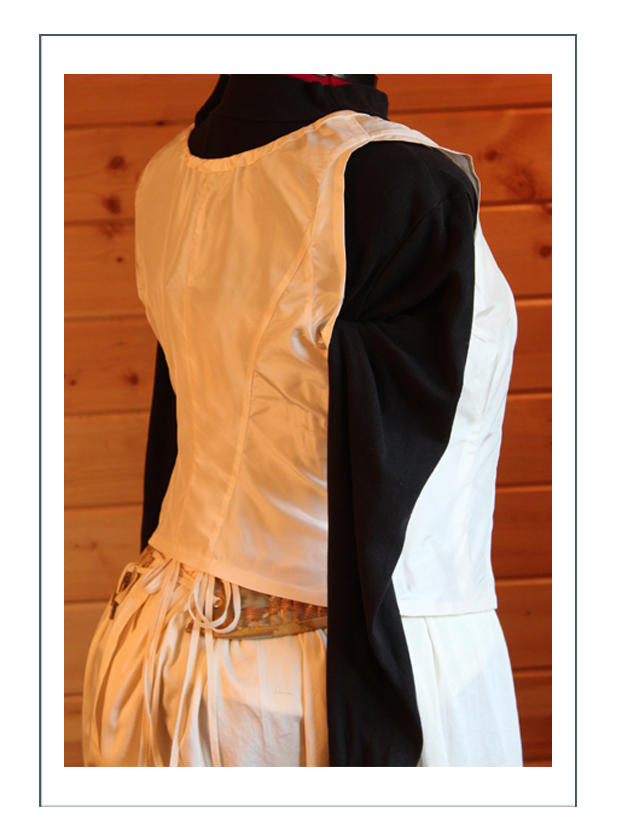
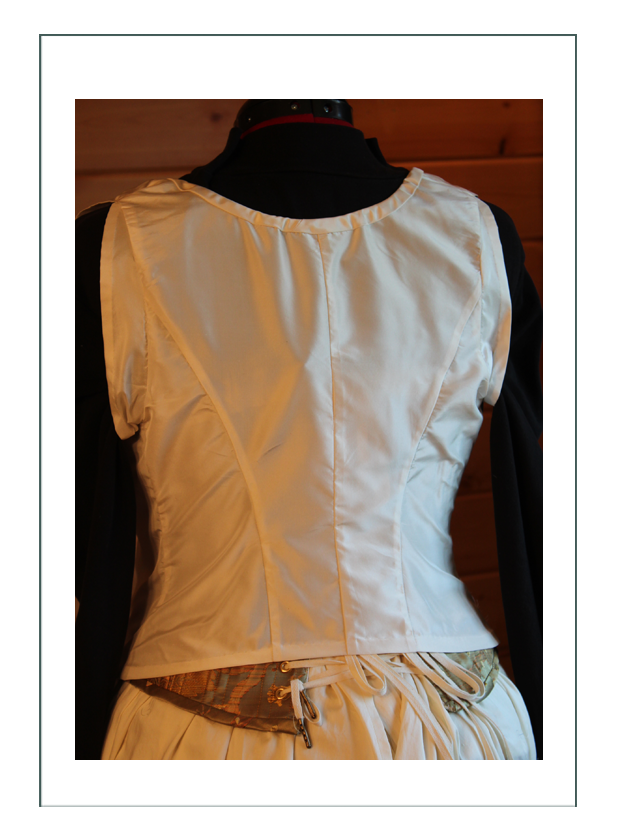
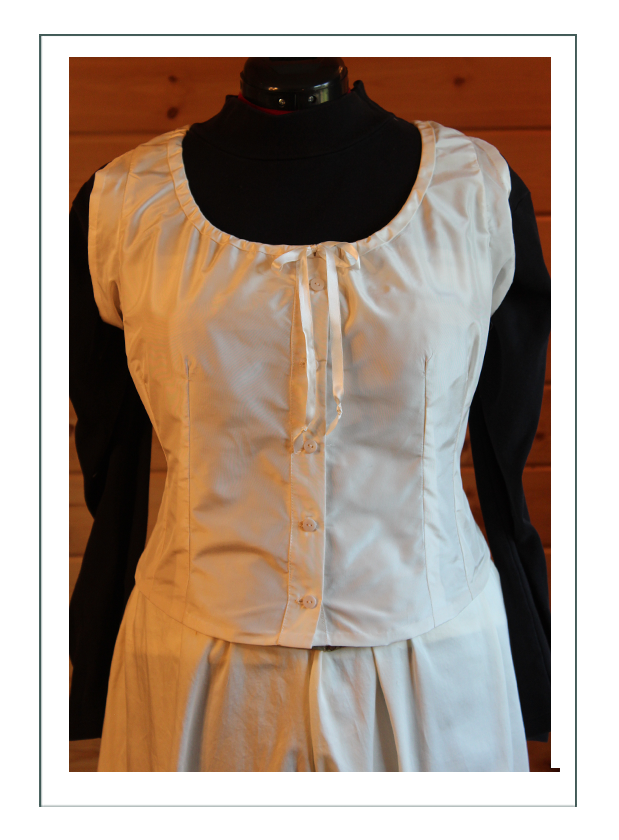
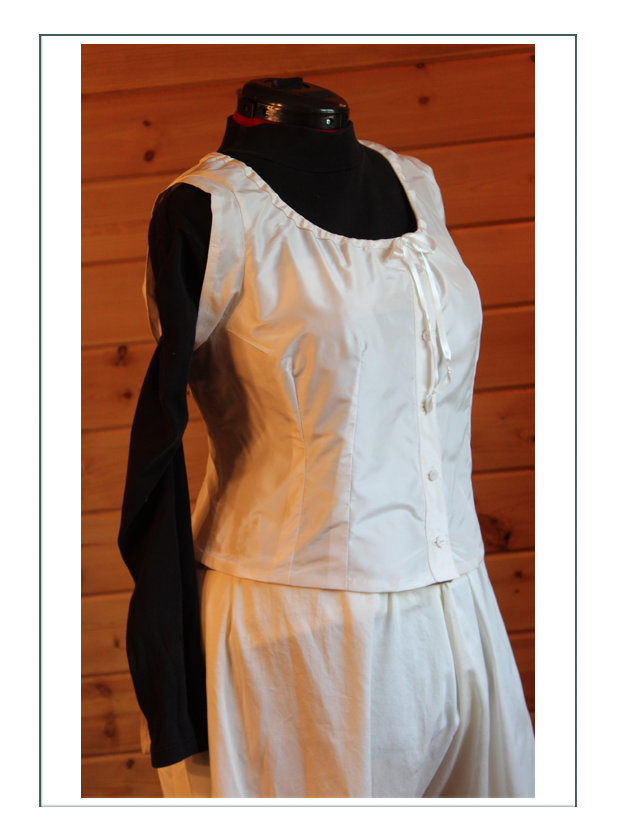
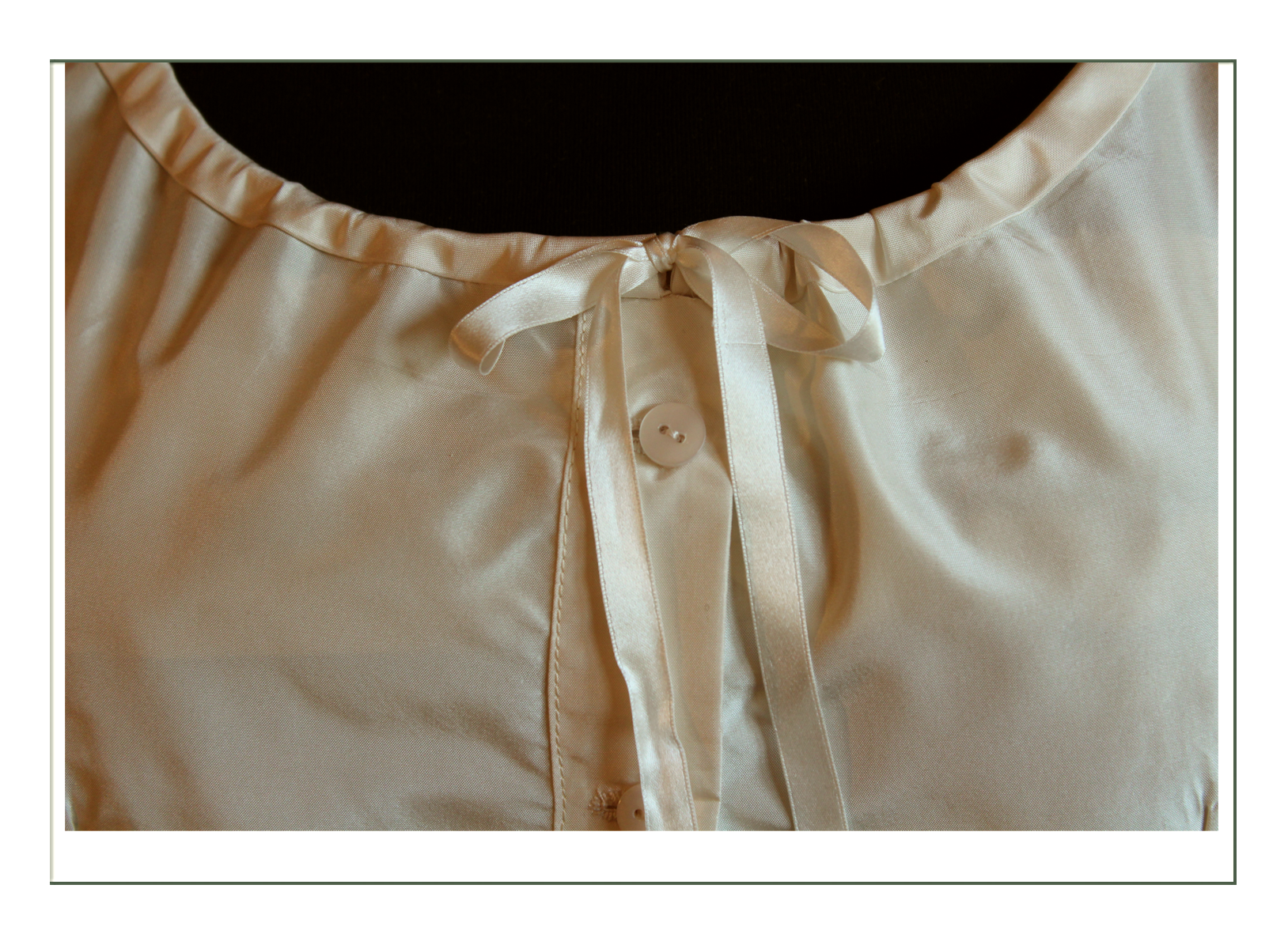
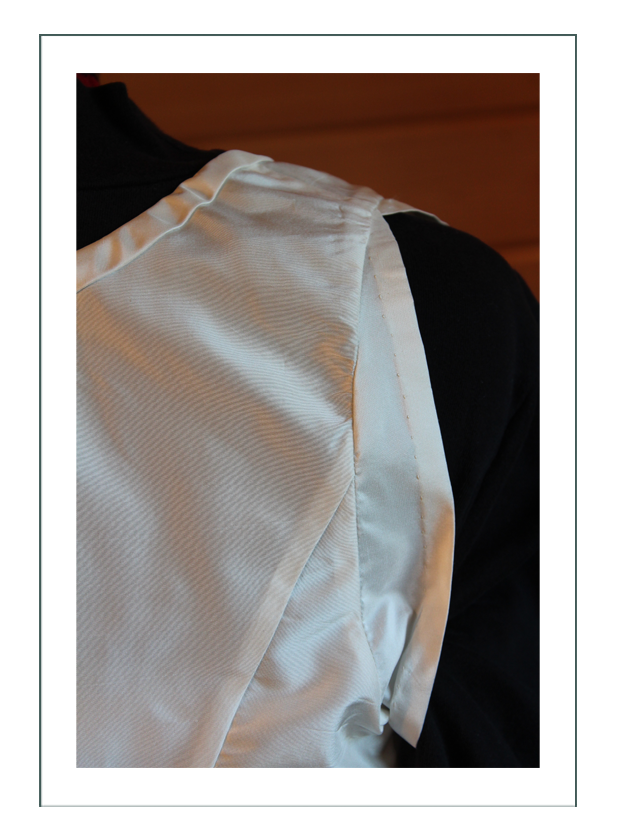
 Petticoat
Petticoat
Fully line of ivory silk taffeta, this is one very special, intricate, and detailed garment – just as it would be in the late 1890’s-1900. Dr. Anderson’s took over 60 hours to make – mostly due to the extensive amount of hand sewing, gathering, and custom design.
The purpose of the petticoat is: 1) designed so there only need be one petticoat; 2) create the long, smooth front silhouette without lumps or bumps so the outer skirt will look the same; 3) make the deep and pleated full back that the skirt will have; hold the skirt out en lieu of yesterday’s bustle pads; 4) give fullness at and below the knees to keep the flare of the skirt out (the skirt has no flounces or ruffles), and 5) make the “frou frou” noise rubbed against the skirt’s inner lining.
There are 3 layers to the flounce, which is the masterpiece of this ensemble. At the bottom is a straight silk flounce. Over that is an embroideried openwork cotton lace. This will drag on the floor, and “sweep the floor” in the back. In the front, it should just brush the tops of the shoes and allow for easy walking as long as the foot “flips” up and forward to do so.
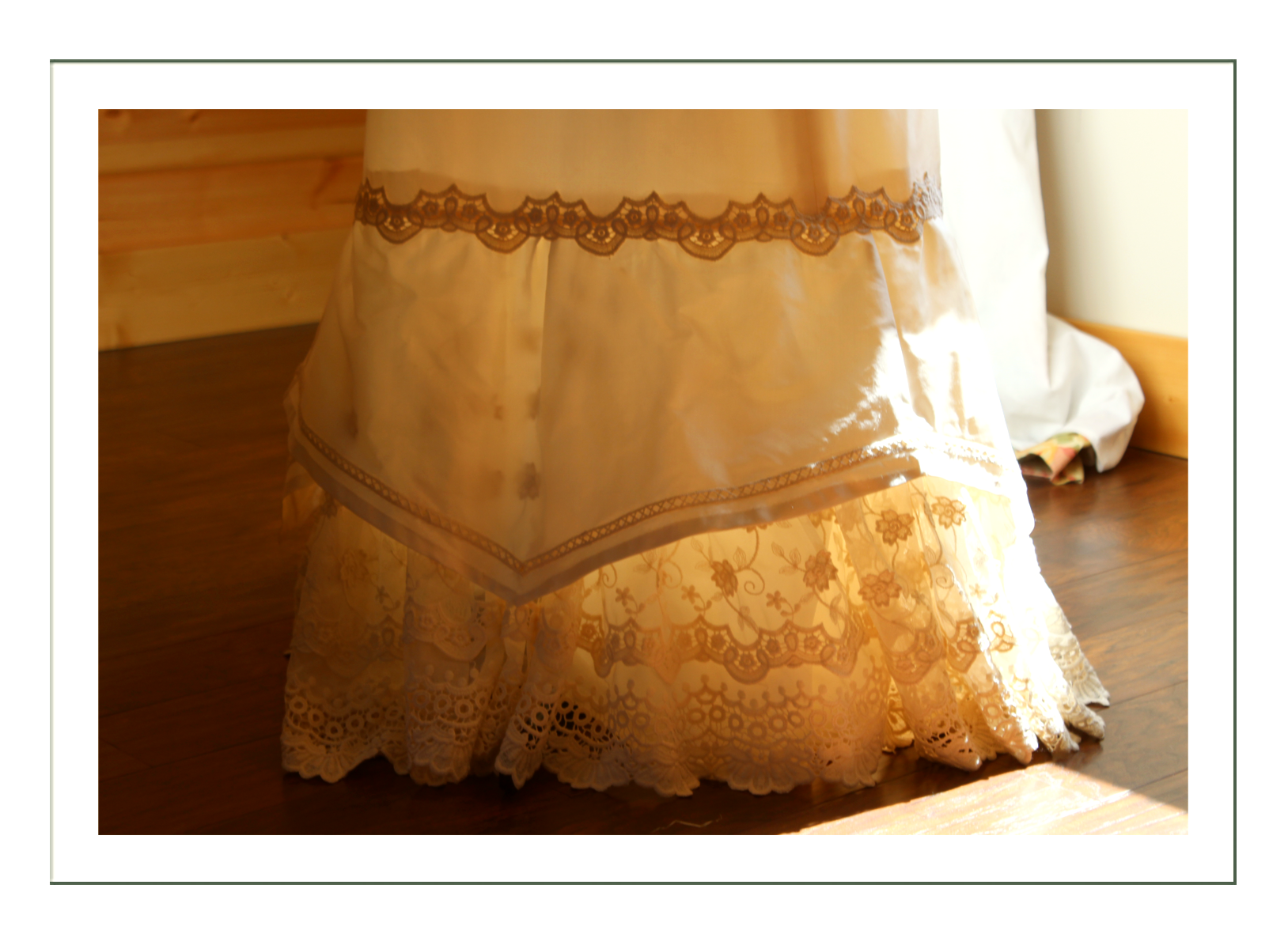
The outer layer is intentionally designed to “stick out”, so the skirt will be held full just below the knees. It is a design seen in extant garments, and has a bit of the 1900 “Art Nouveau” element in the trim.
As typical of the era, all seams are finished (french or otherwise), so that the inside is as good as the outside, and all the trim is specifically designed and placed to cover seams. This petticoat is much like today’s bridal gown skirt.
The buttons are handmade for durability, with handmade loops and mother of pearl buttons to hold the pleat closed. This requires an exact fit over the rear and front of the petticoat, so it is smoothe and creates the shape of teh skirt to come. Tension on the buttons keep them buttoned.
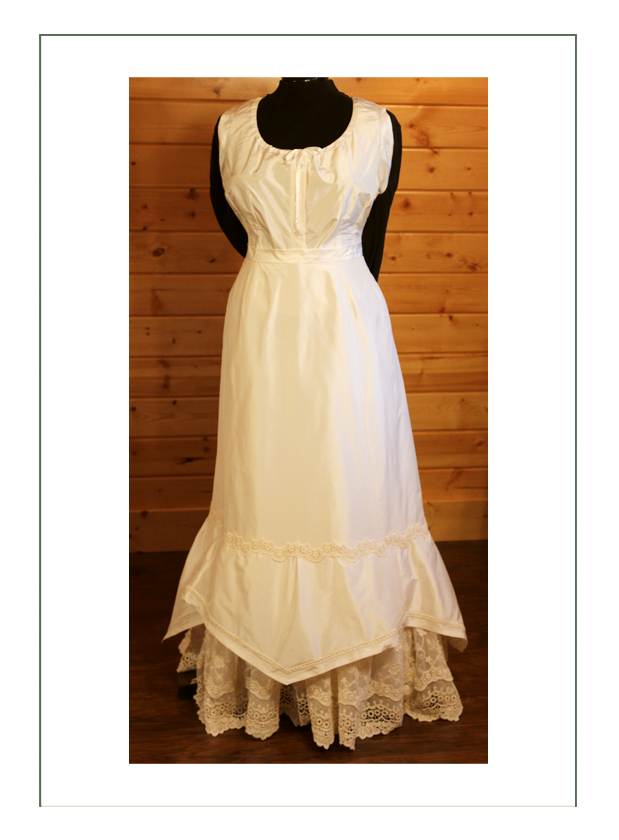
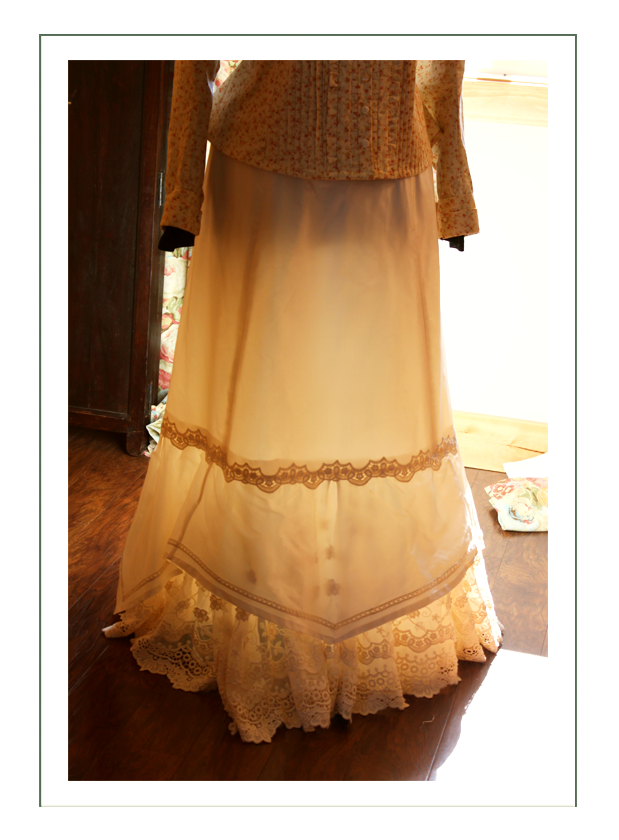
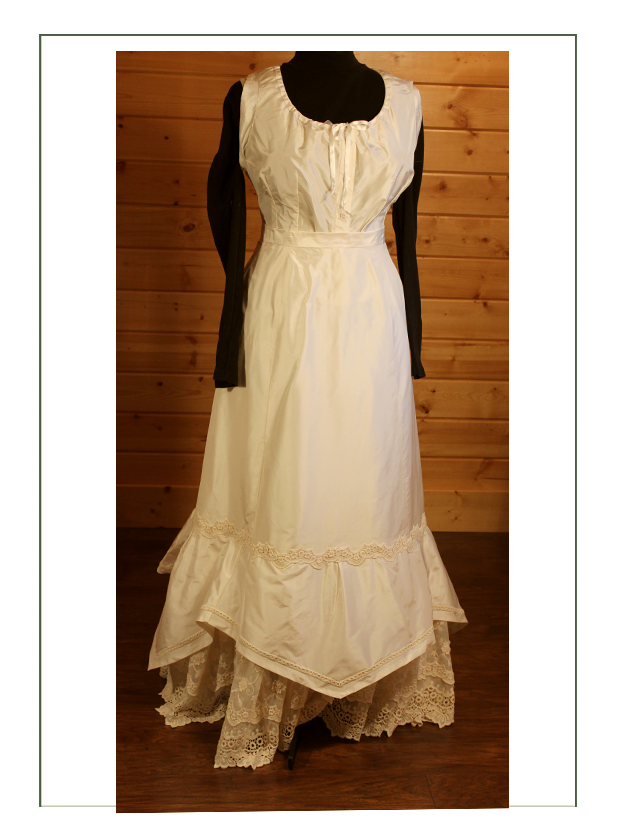
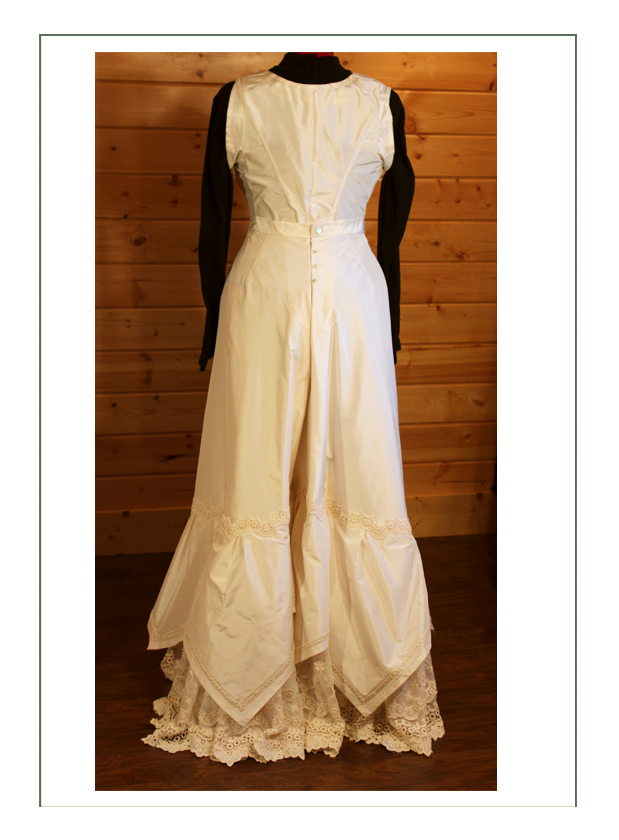
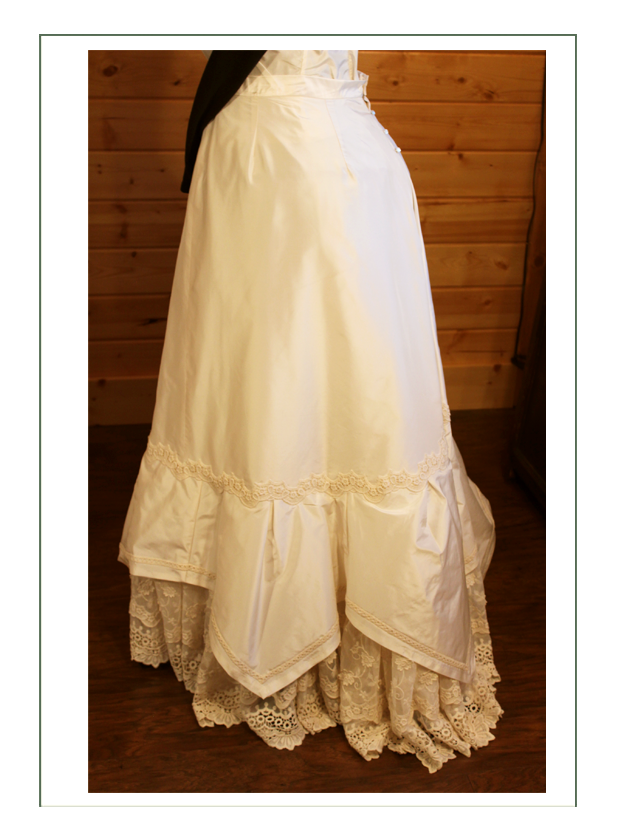
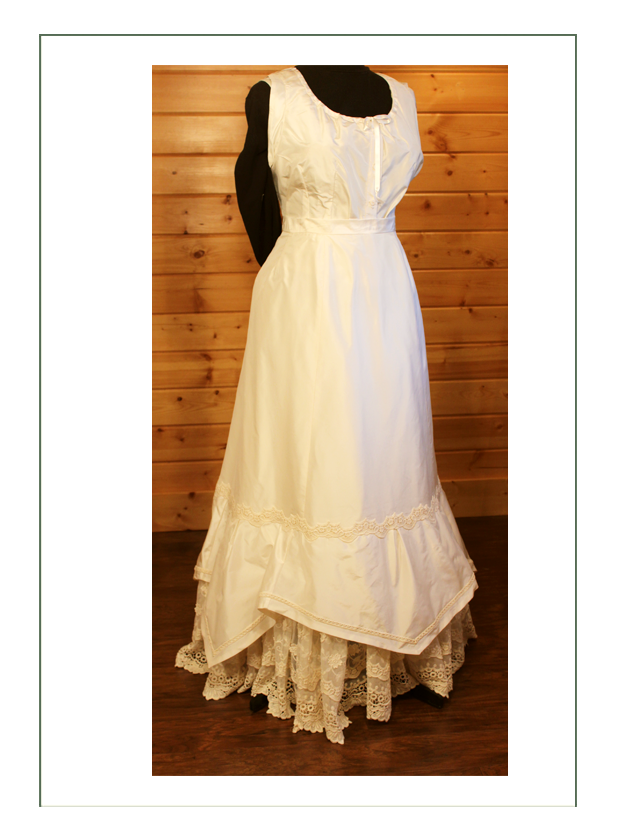
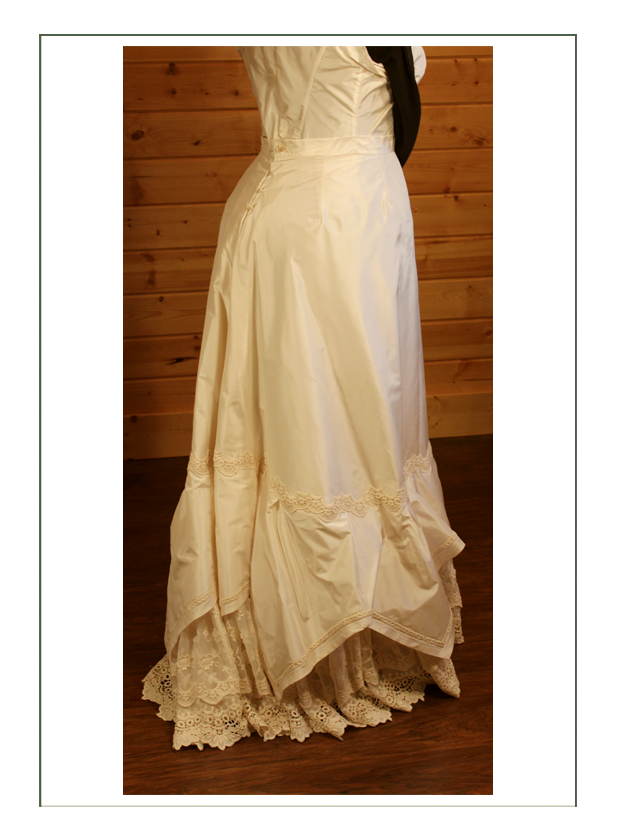
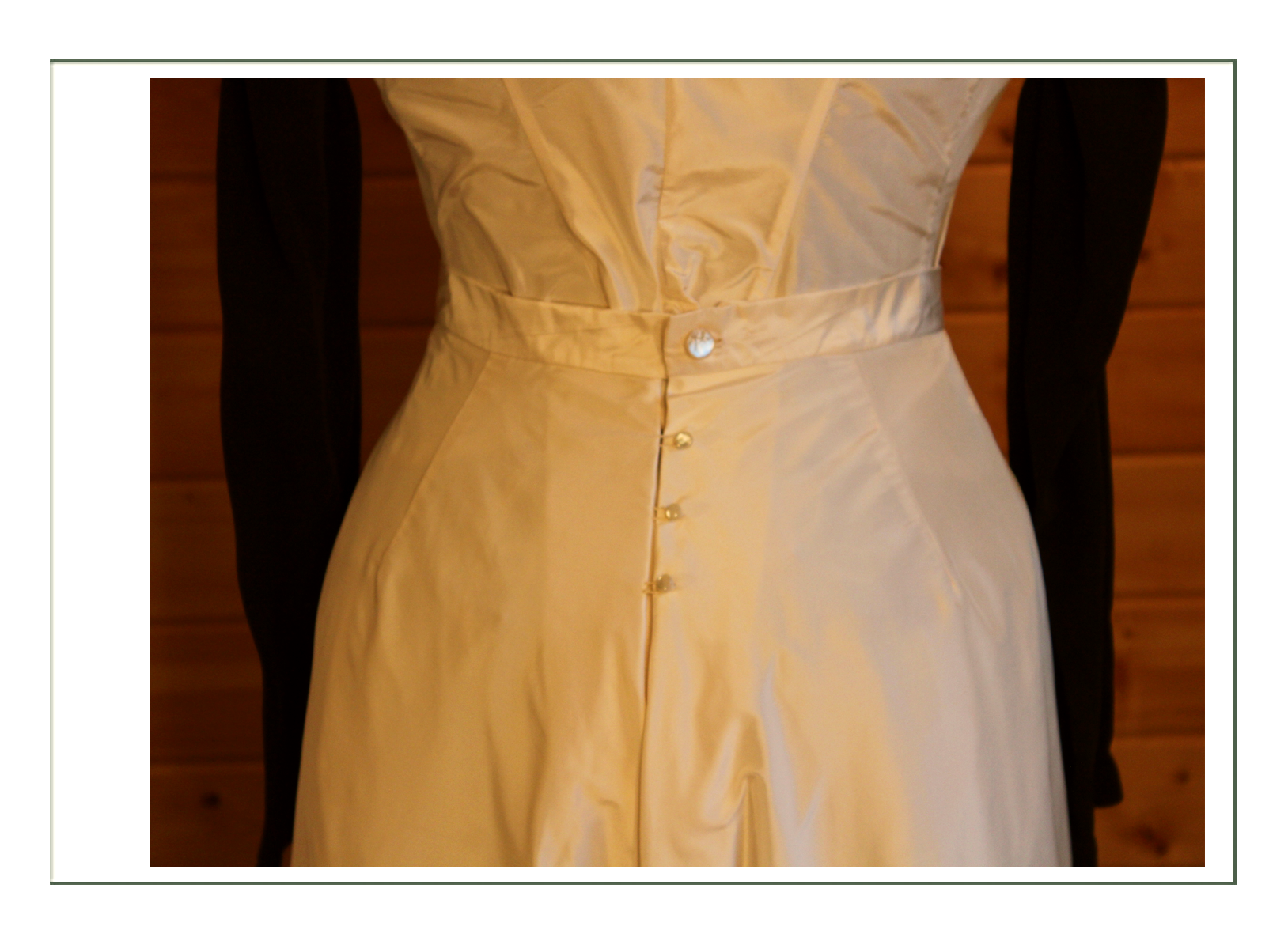
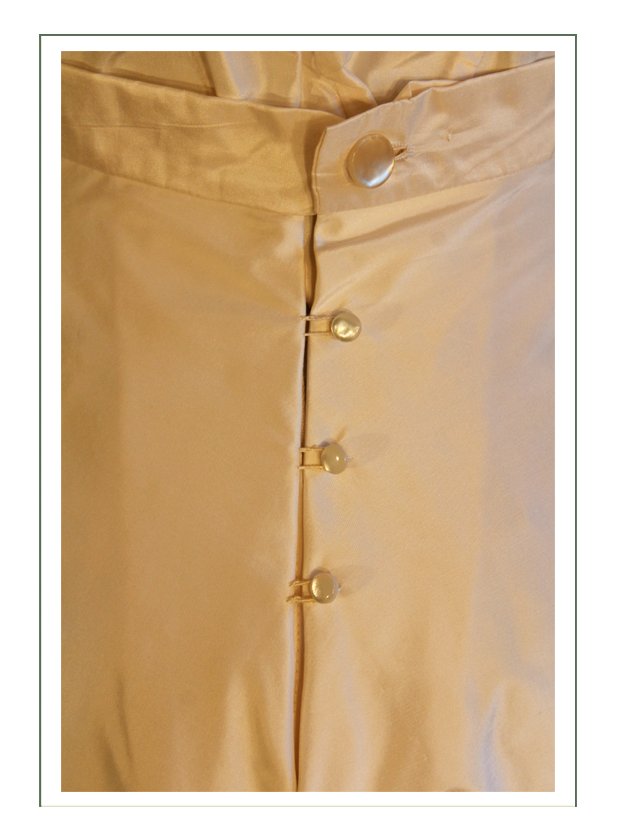
 Jewelry
Jewelry
Vest Chain
(see description and development above)

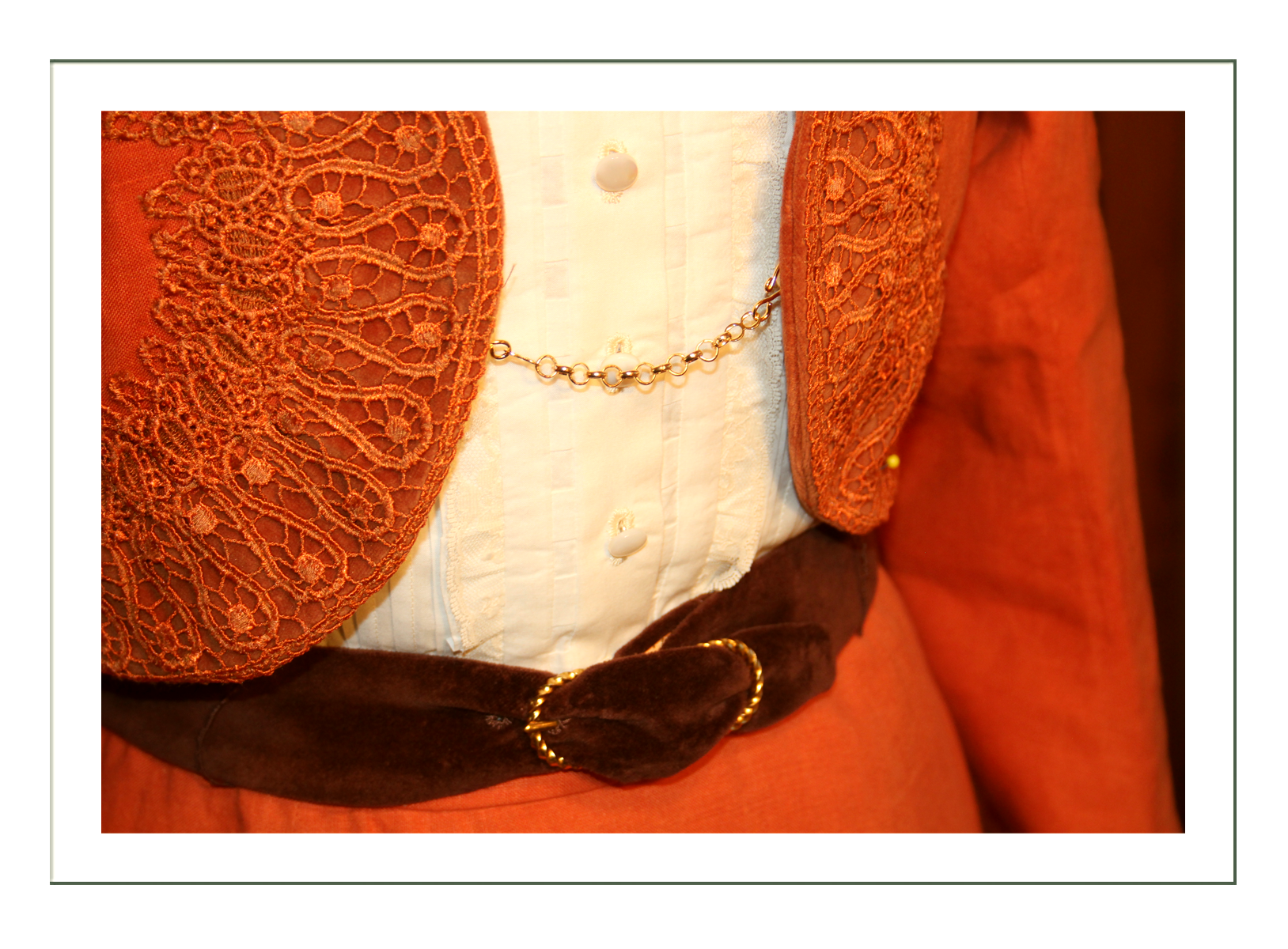
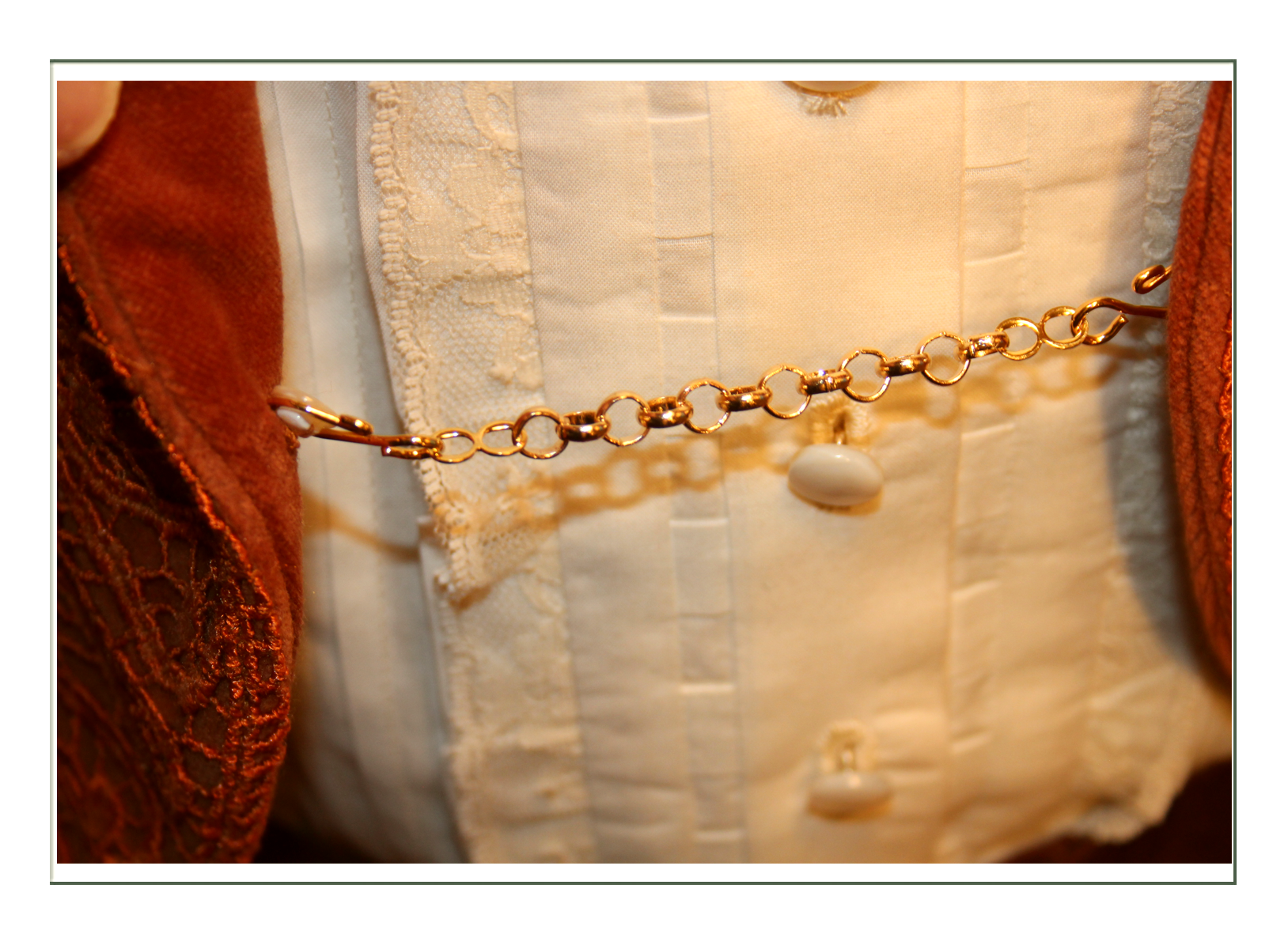
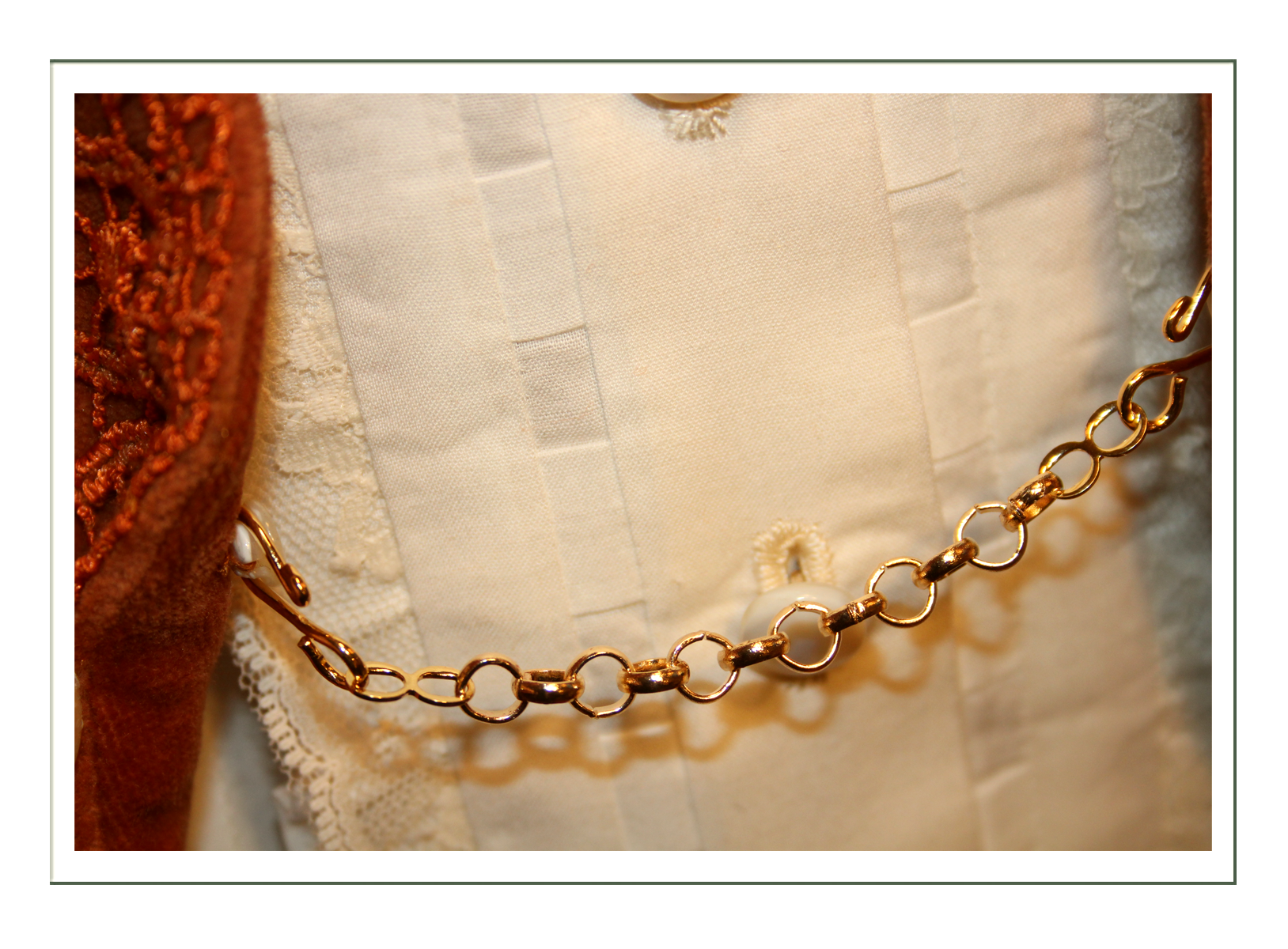
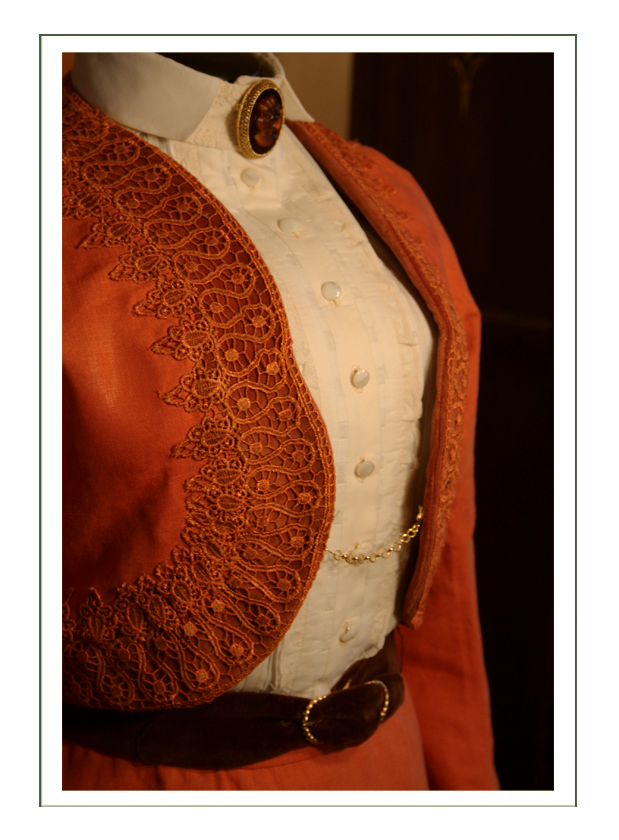
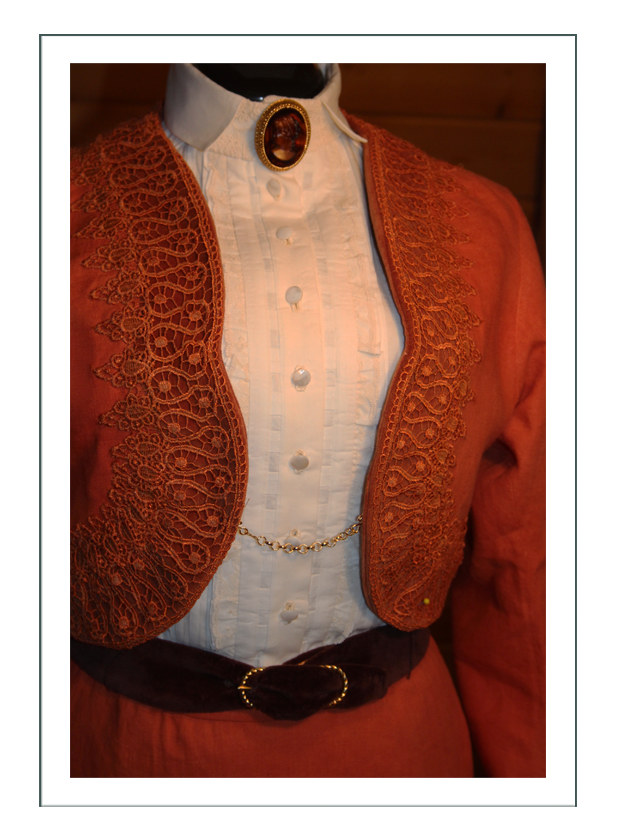
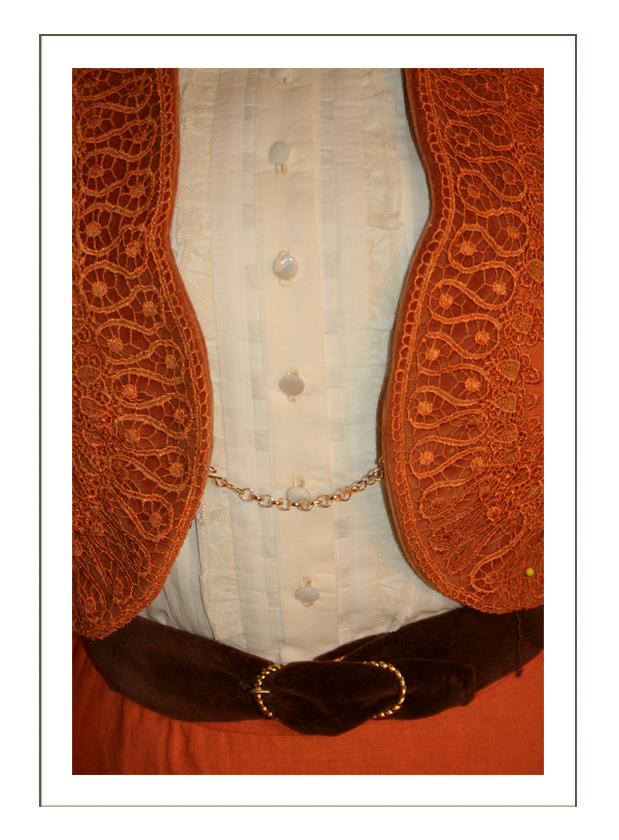
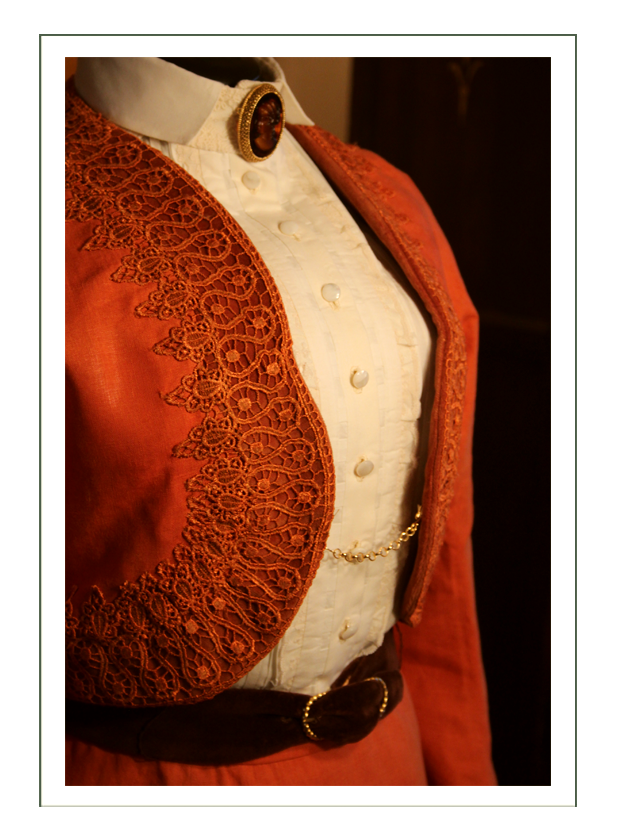
Authentic Resin Cameo Pin with matching earrings
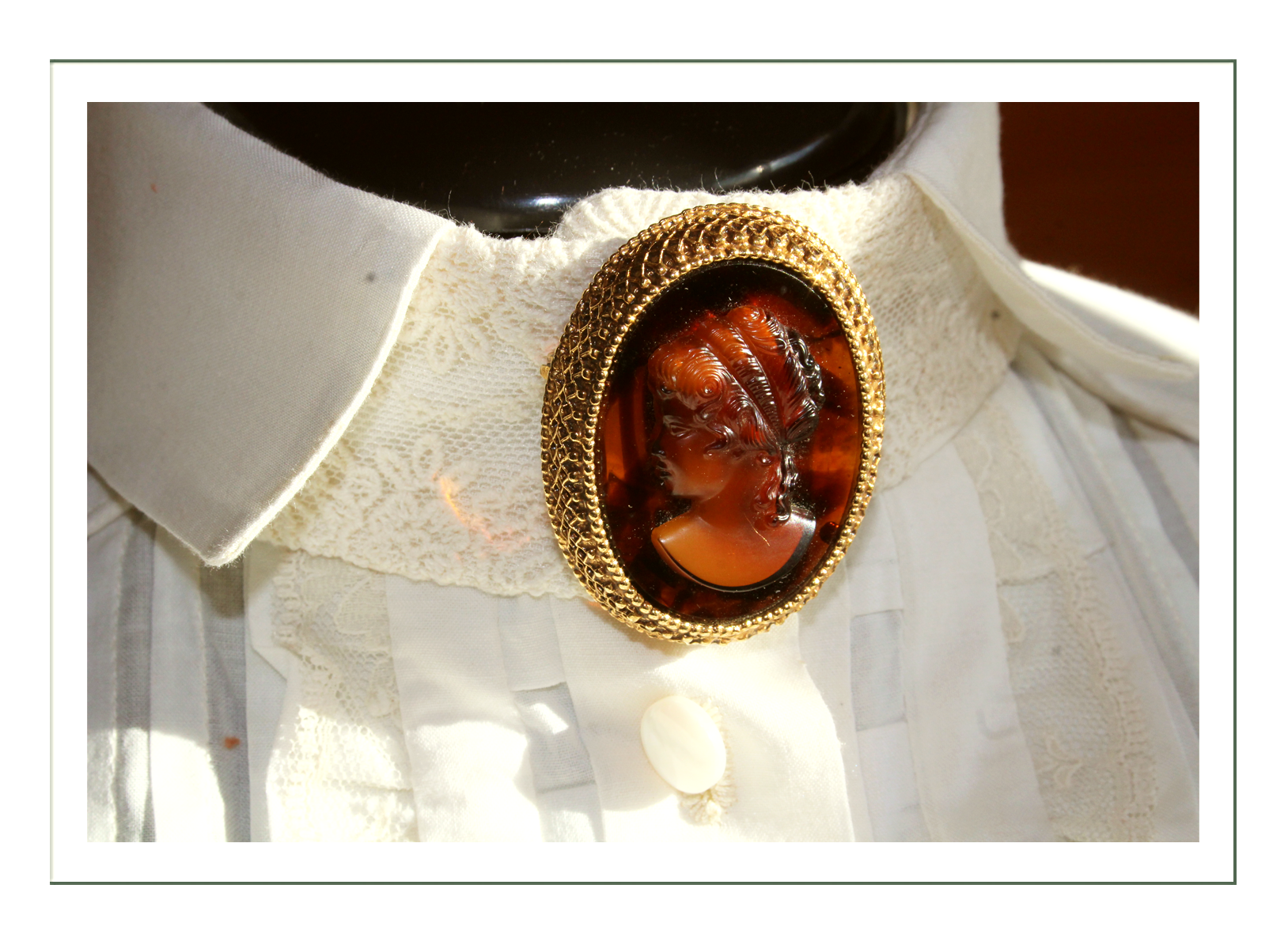 Custom Belt/Sash
Custom Belt/Sash
Of dark brown velveteen with silk taffeta lining and a vintage gold buckle, this is designed with the Edwardian sash shape, but is narrower at center front to allow the eye to see a long line with a graceful back.
This is completely custom designed to an EXACT fit for body shape and size in corset.
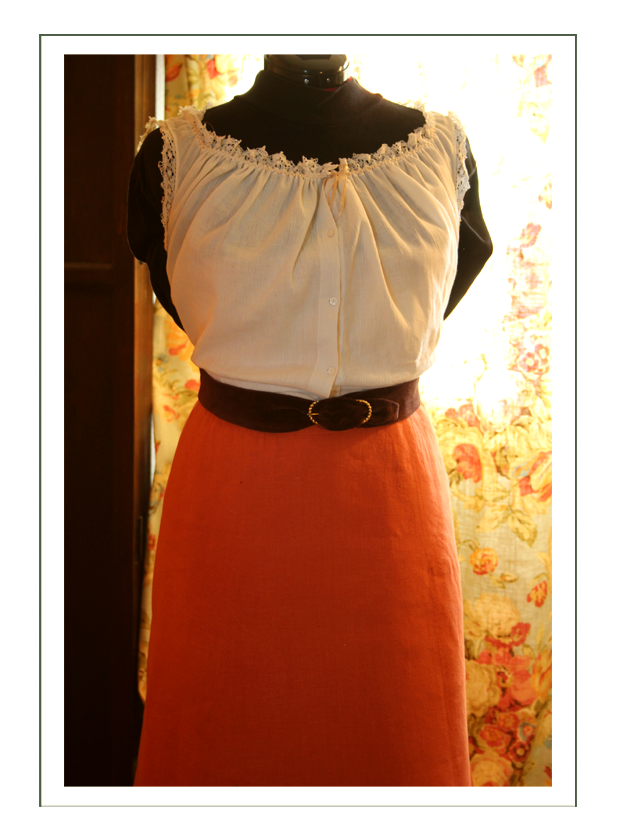
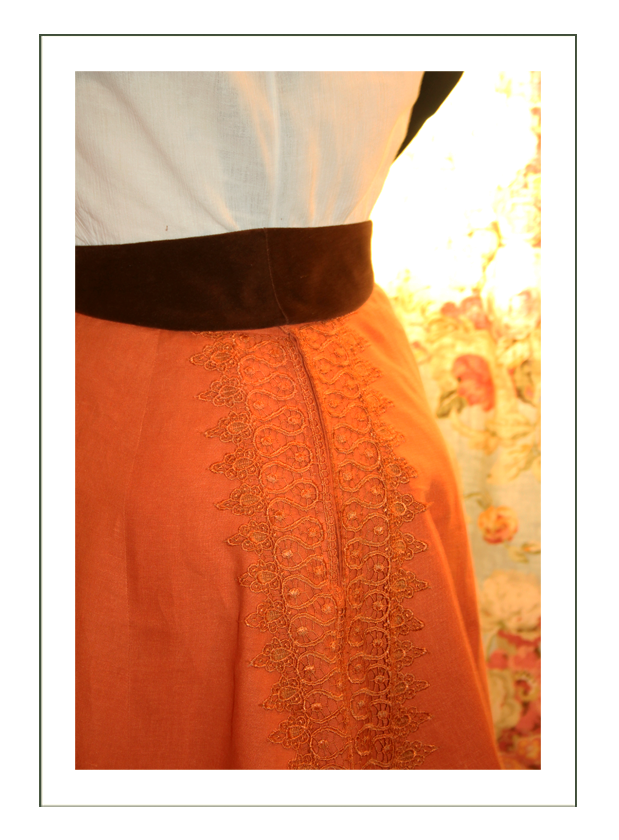
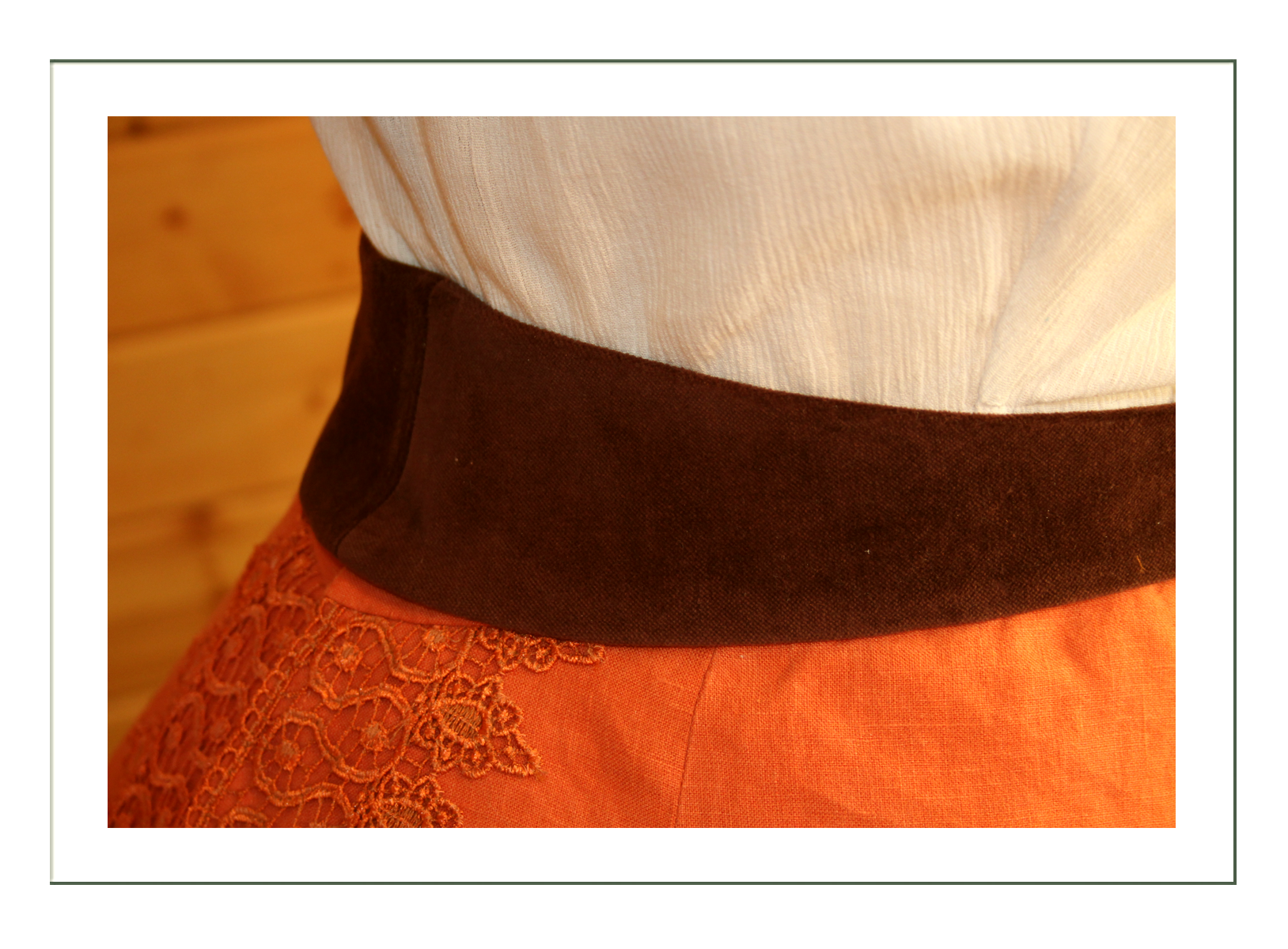
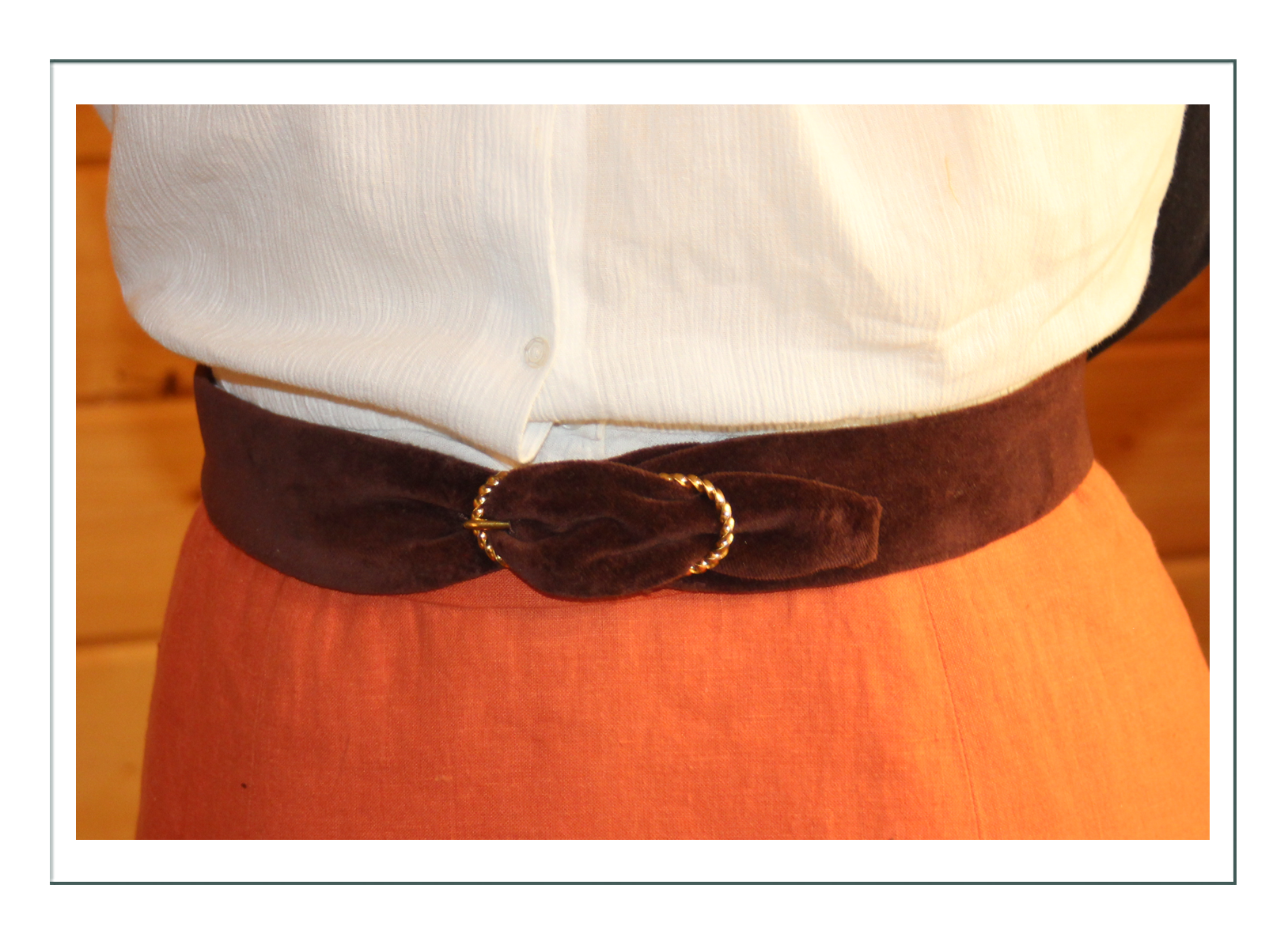
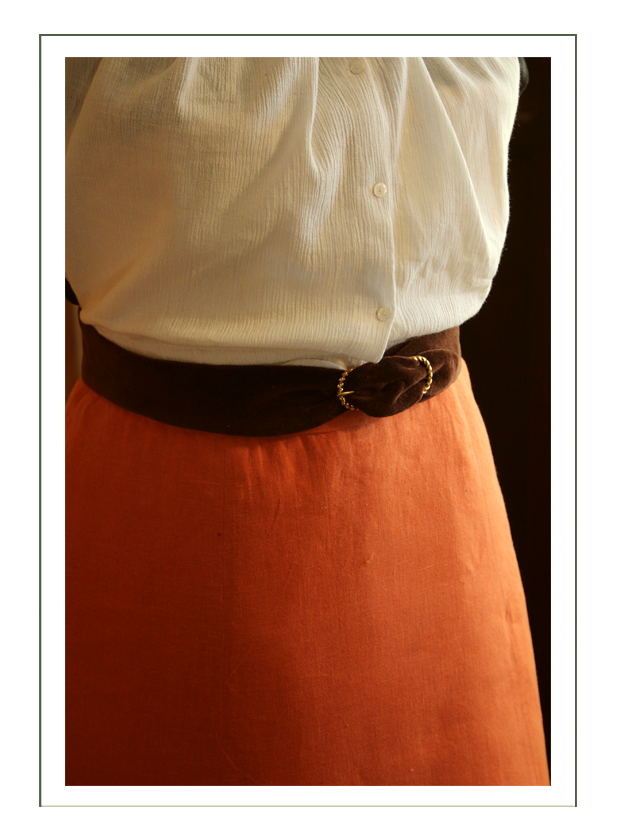
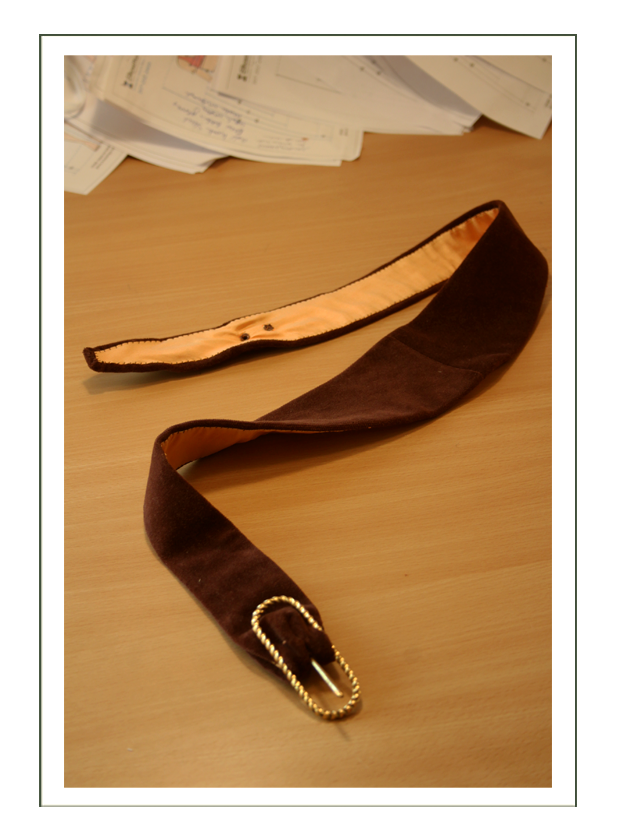
Belt Loops on Skirt
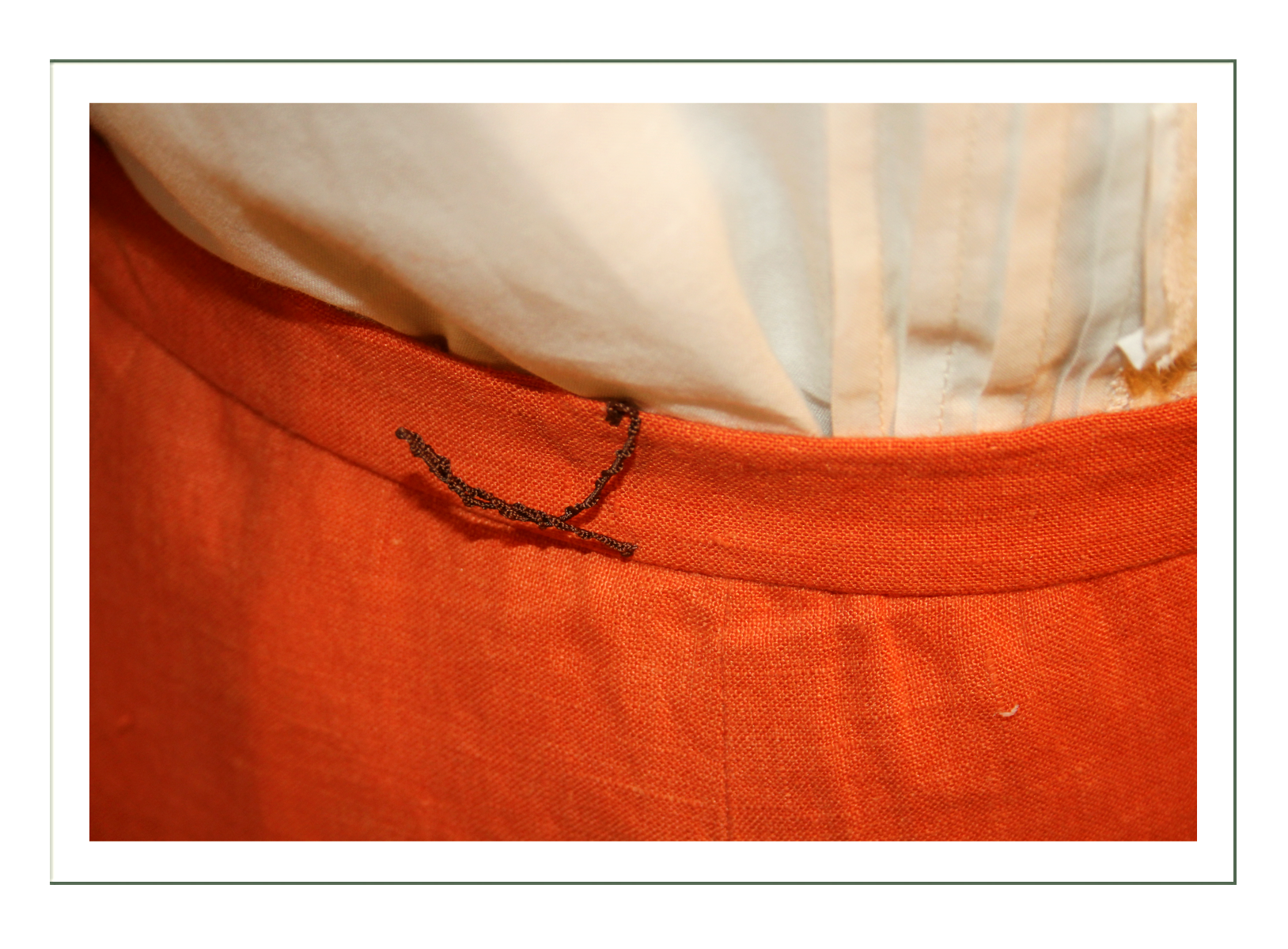

Hat & Wig
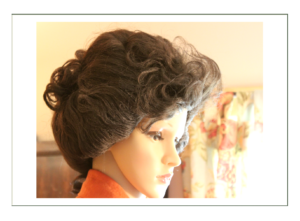
We took historical images of Ida B. and built a wig in the Gibson Style, but with the upsweep Ida wore all her life. The purpose was 1) to look like Ida; 2) have enough hair to hold the hat.
The special parts of this design are the curls in the bun, the single curl down her neck (as if one kept falling out), and the gray added at the temples. The upsweep of the bangs can be sprayed down, or worn loose. Early in her life, it appears Ida had gray at the temples – and quite high above the ears.
The overall shape of the hair is typical of the era too. Our mannequin’s head is smaller than a real head, so the photos do not really give justice to the overall design and scale.
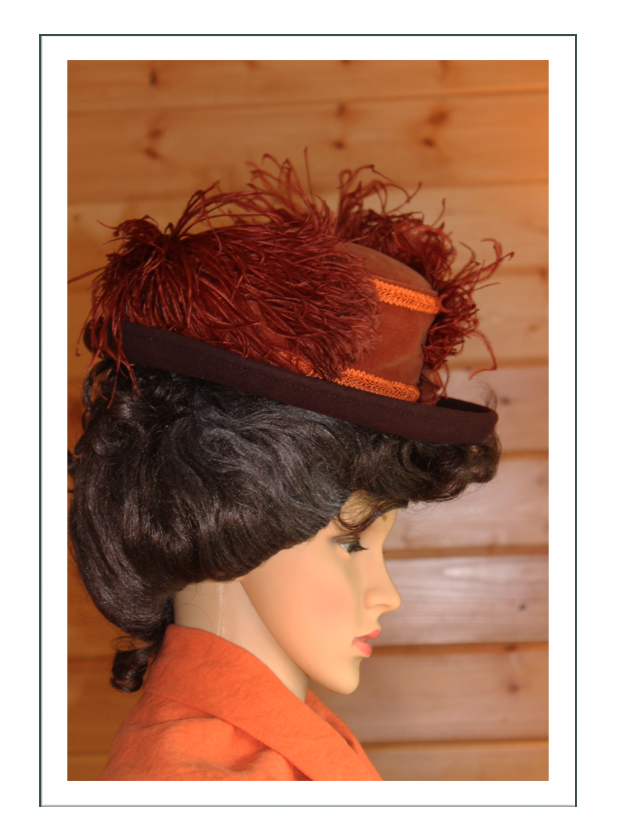
Hats of 1898 were thick brimmed and strong. Many women wore extensive ornaments, but with this tailored and sleek business ensemble, we have scaled it down in size, visual weight, and ornament. It is a small hat for the time, but what Ida would have worn to travel. She might also have had a straw boater.
This is a dark brown wool felt hat with a rolled brim and cotton overlaid velveteen which is the same fabric used in the lapels of the jacket. The gimp braid is the same as used on jacket and skirt.
The unique and custom design of medallion made of the main suiting linen fabric is special for her character and her causes – a “generic” symbol of strength and outspokenness. Overall, the hat is in scale with or without the wig – actually a bit smaller than hats of the time, it will be appropriate with Dr. Anderson’s own hair as well.
Again, our mannequin’s head is much smaller than a human head, so the scale is off in the photos.
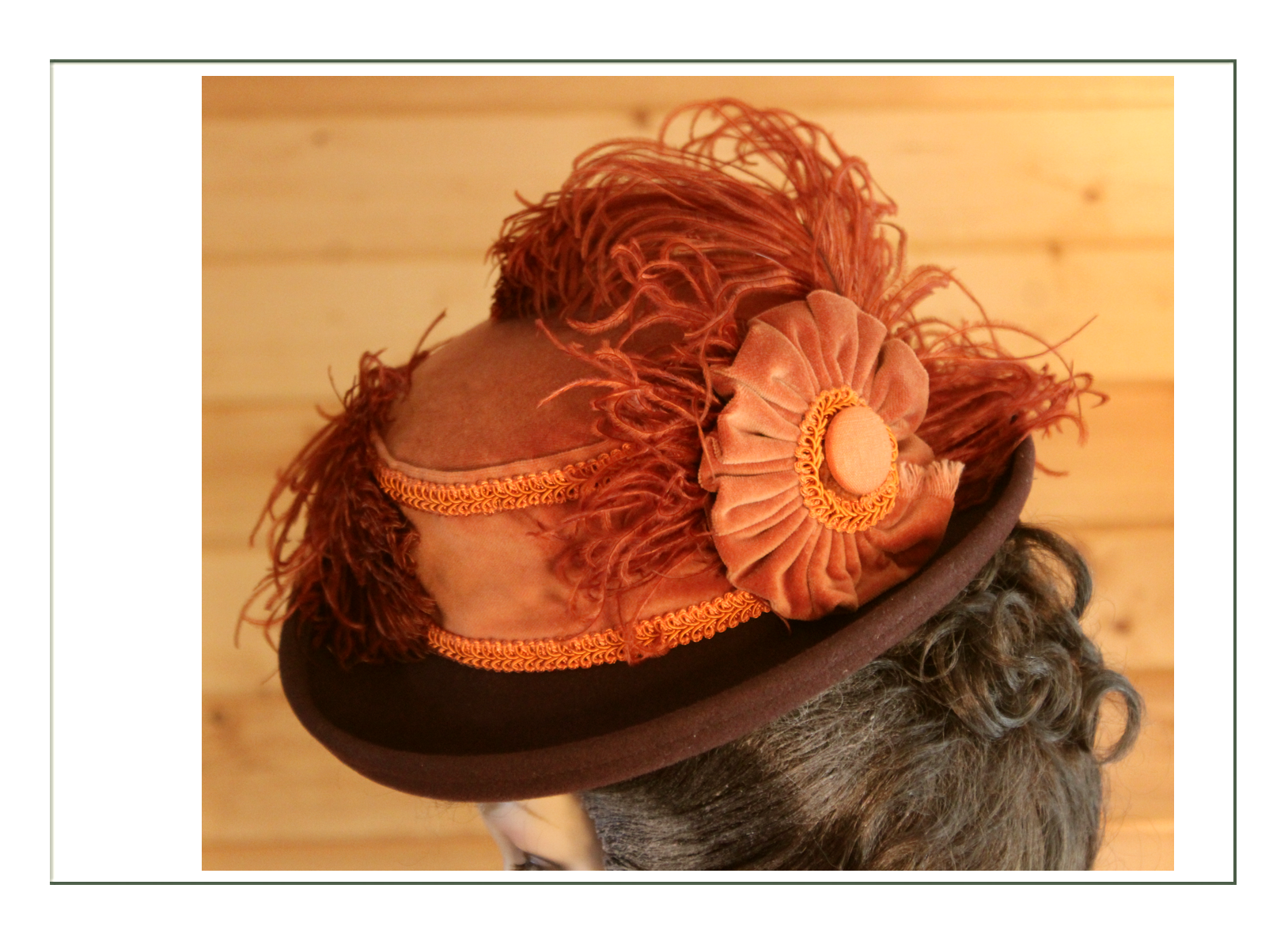
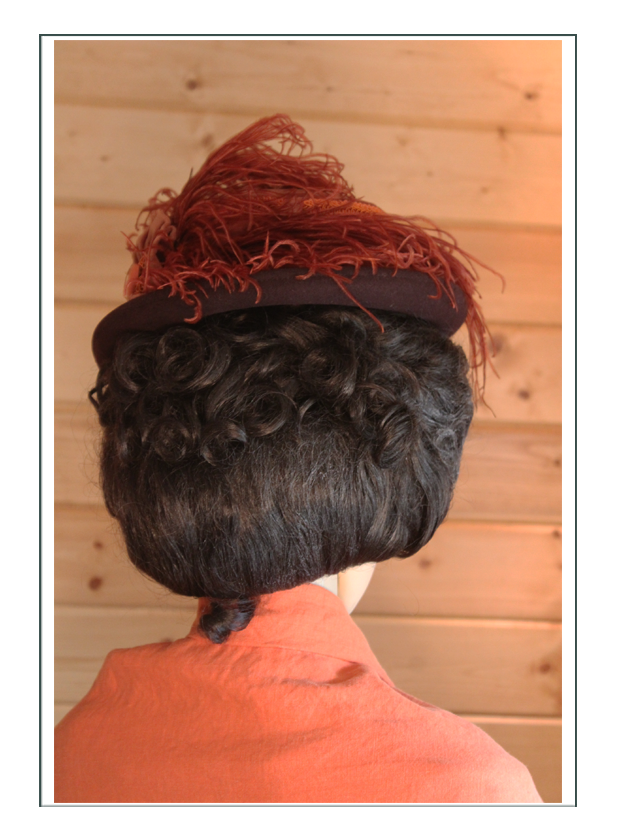
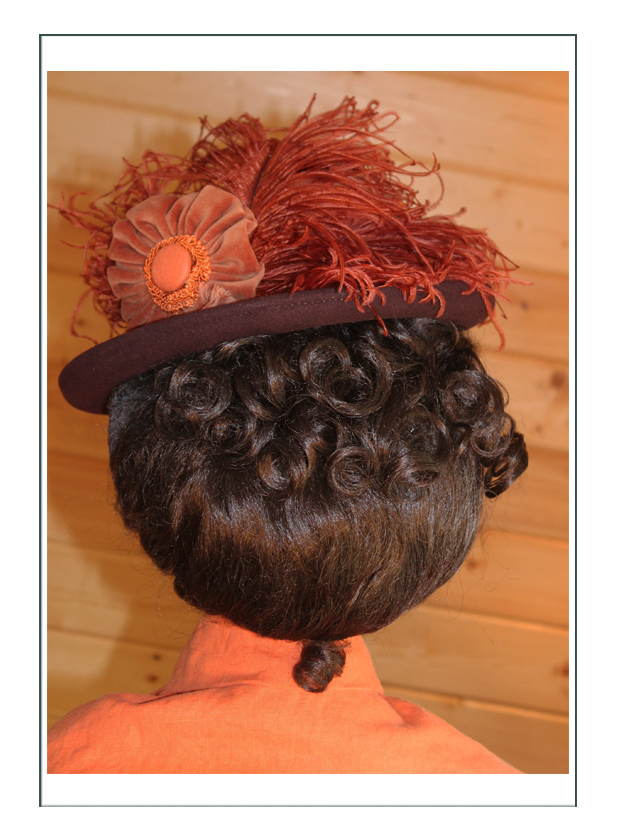
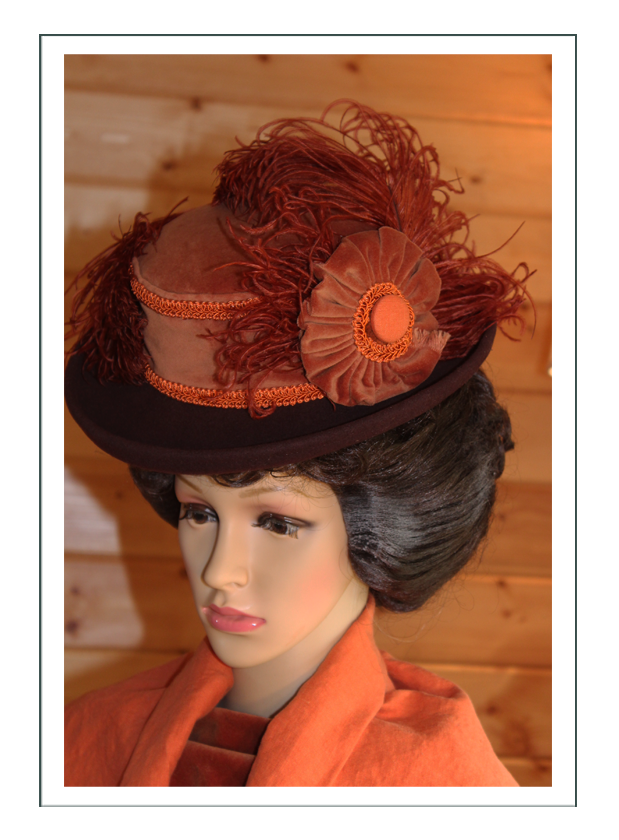
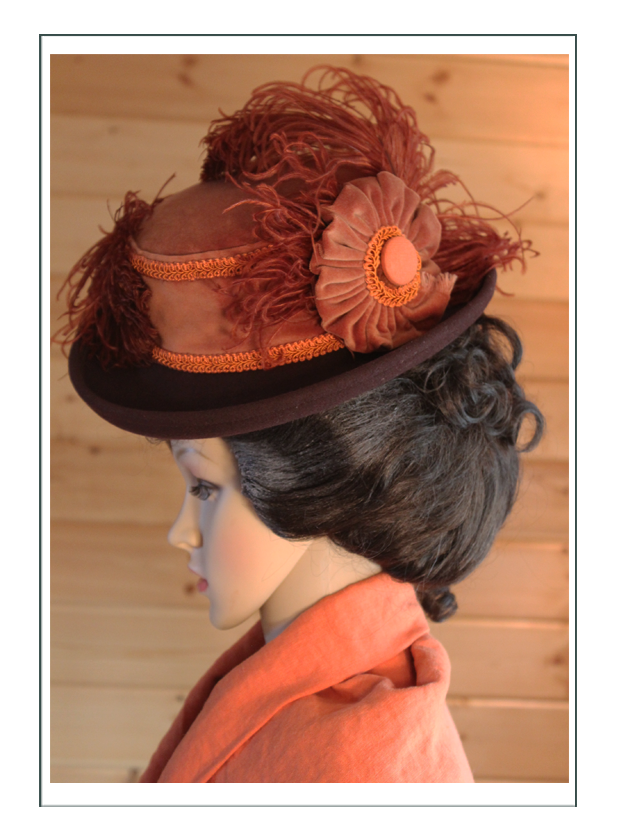
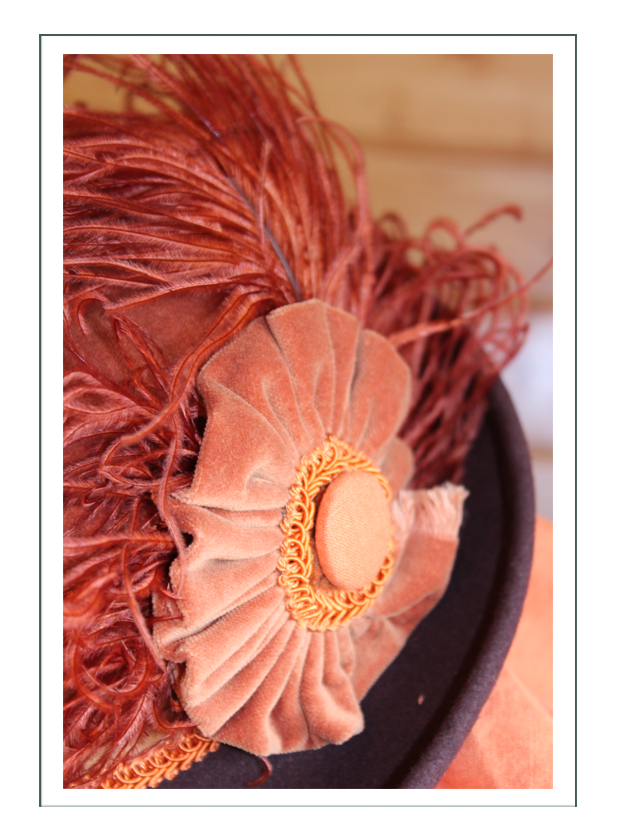
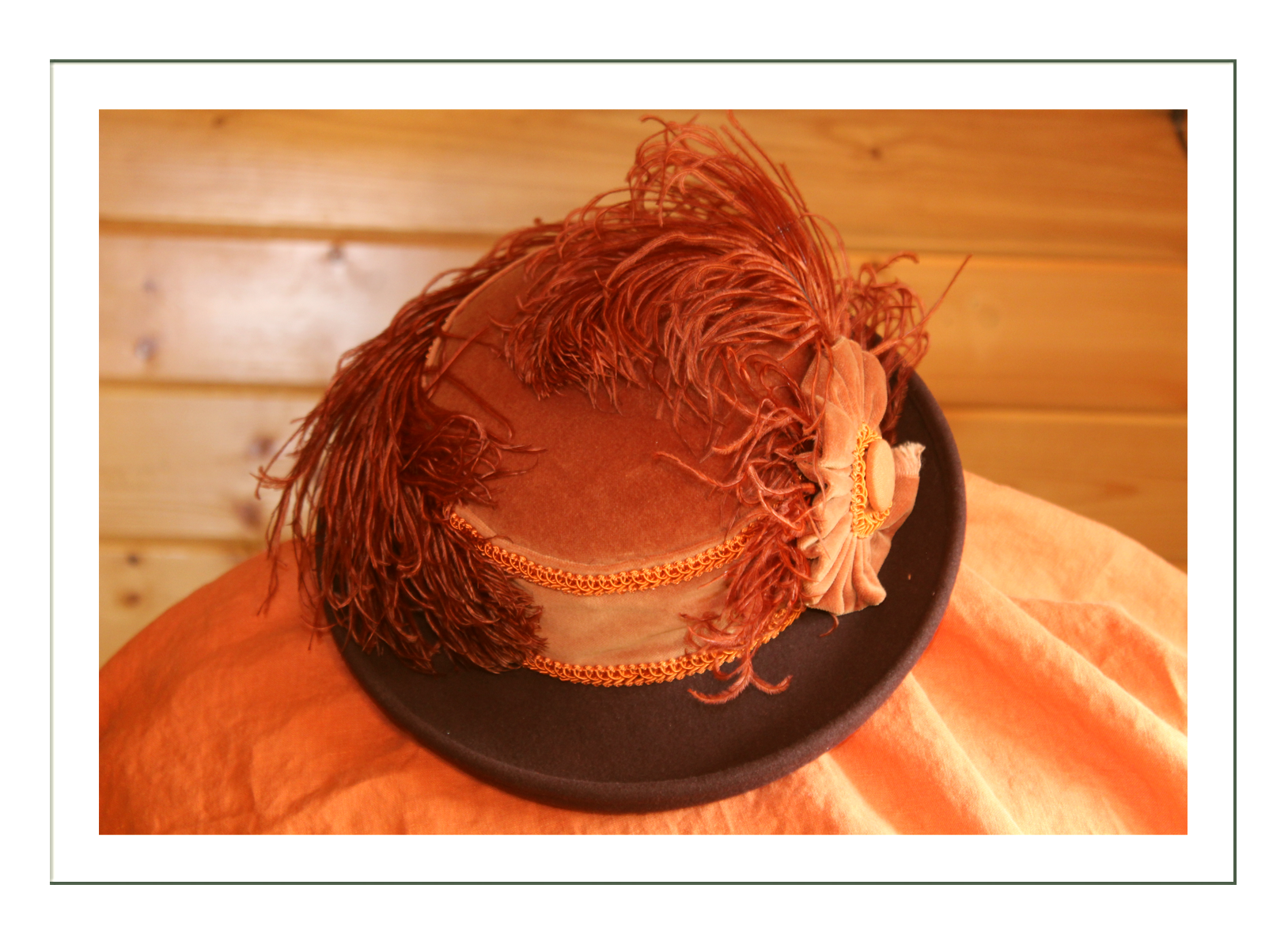
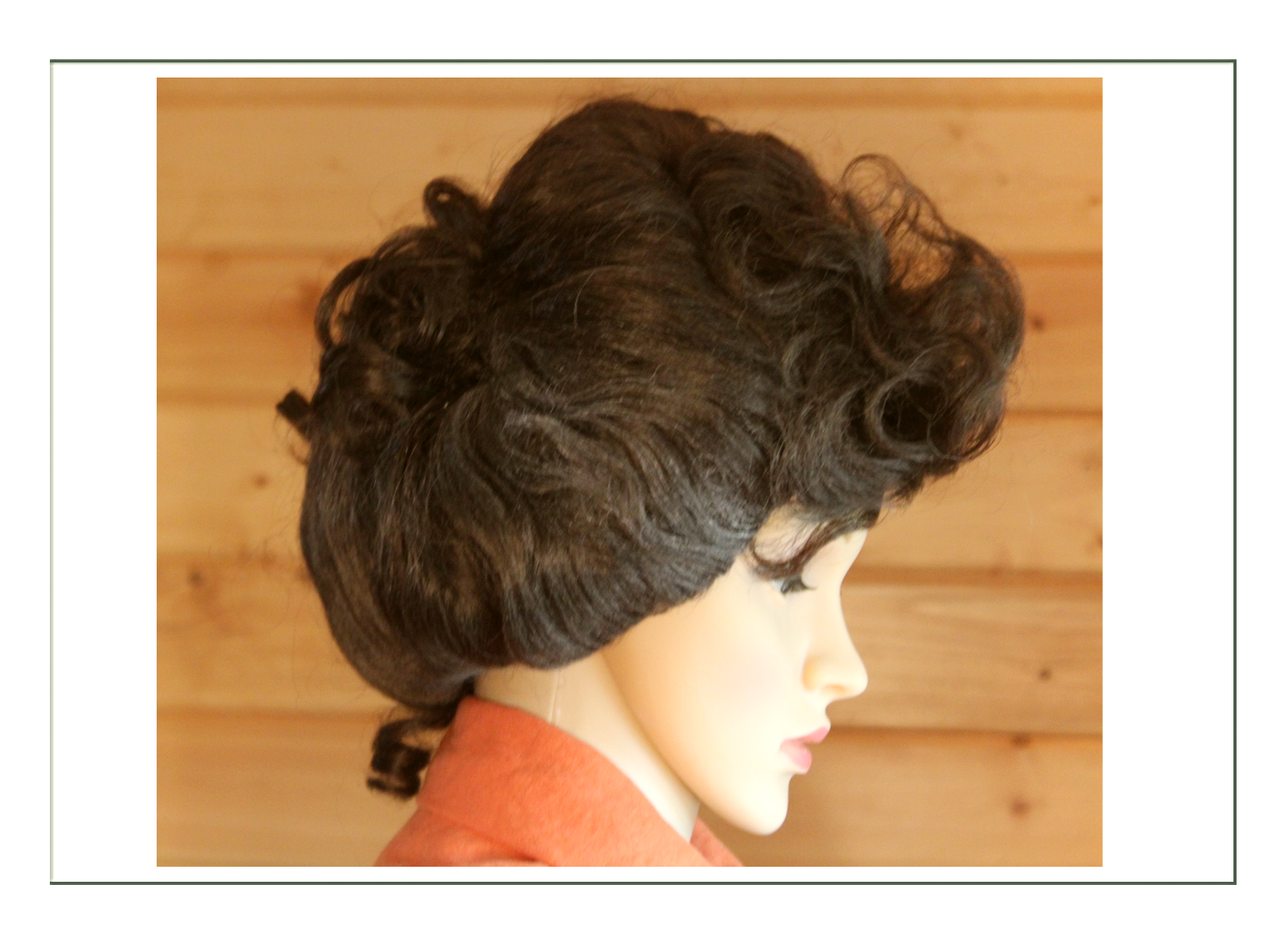


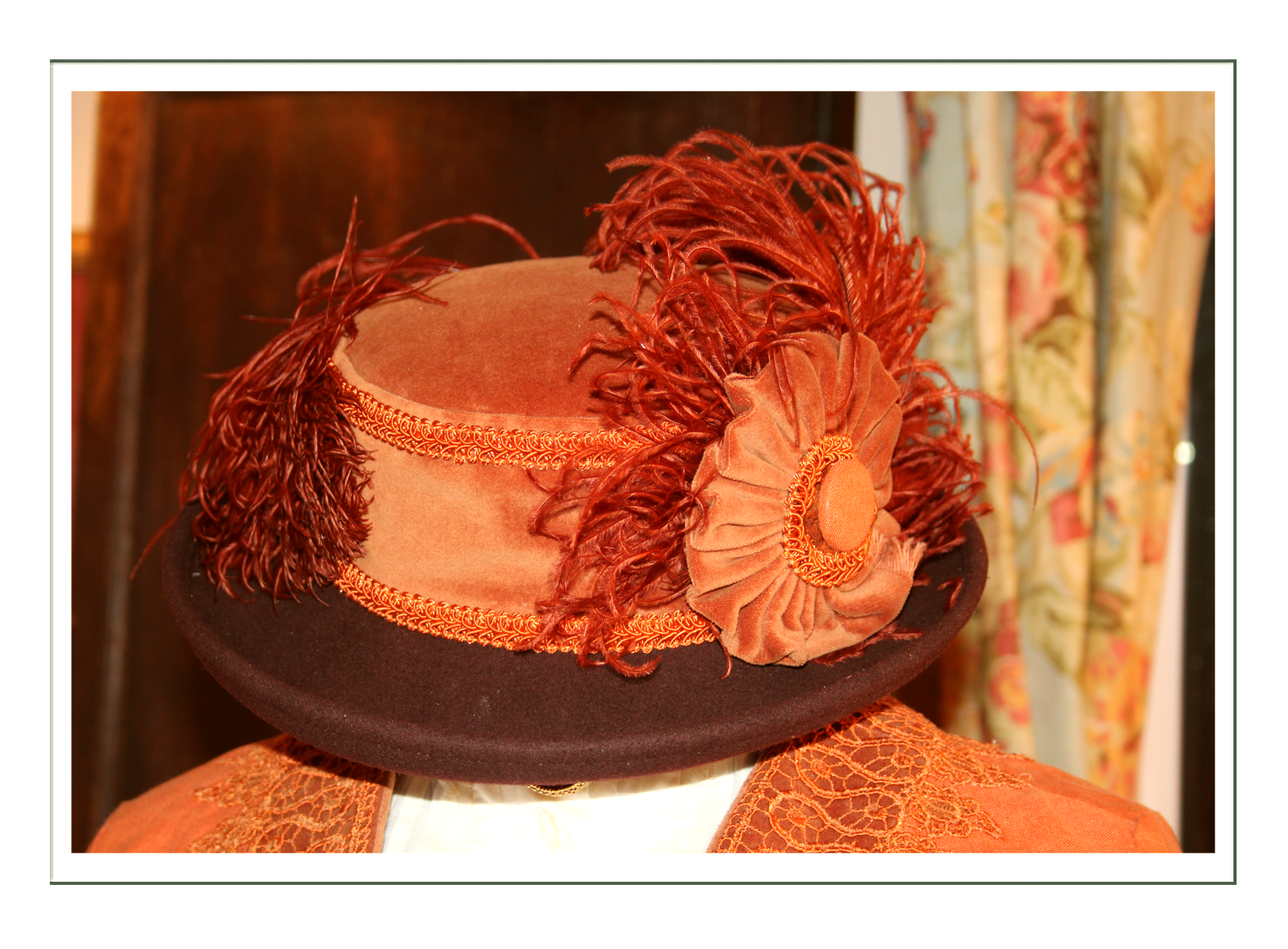

 As Designed; As Built
As Designed; As Built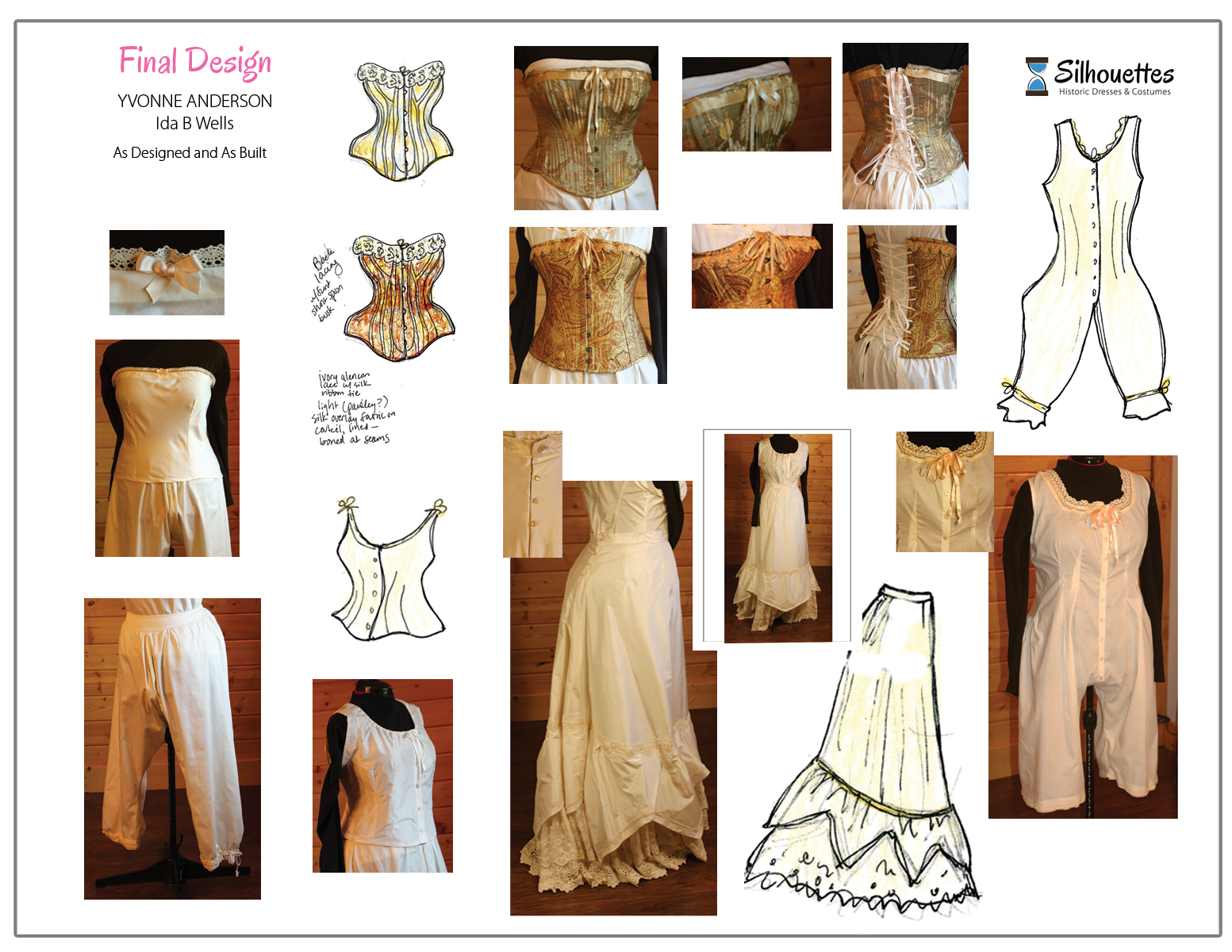
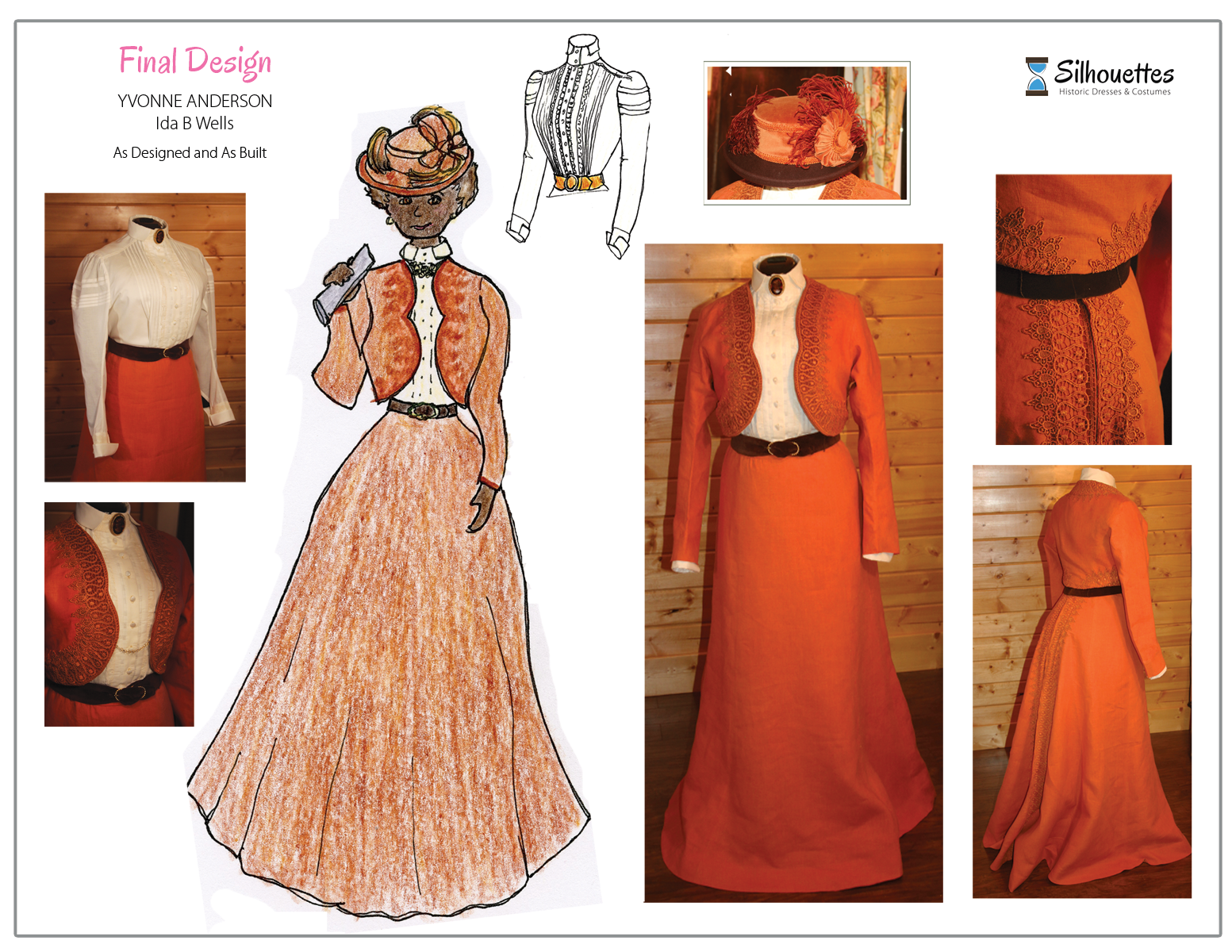
Click here to go to Dr. Anderson’s Historical Context page (next)
Click here to go to Dr. Anderson’s Fashion History page
